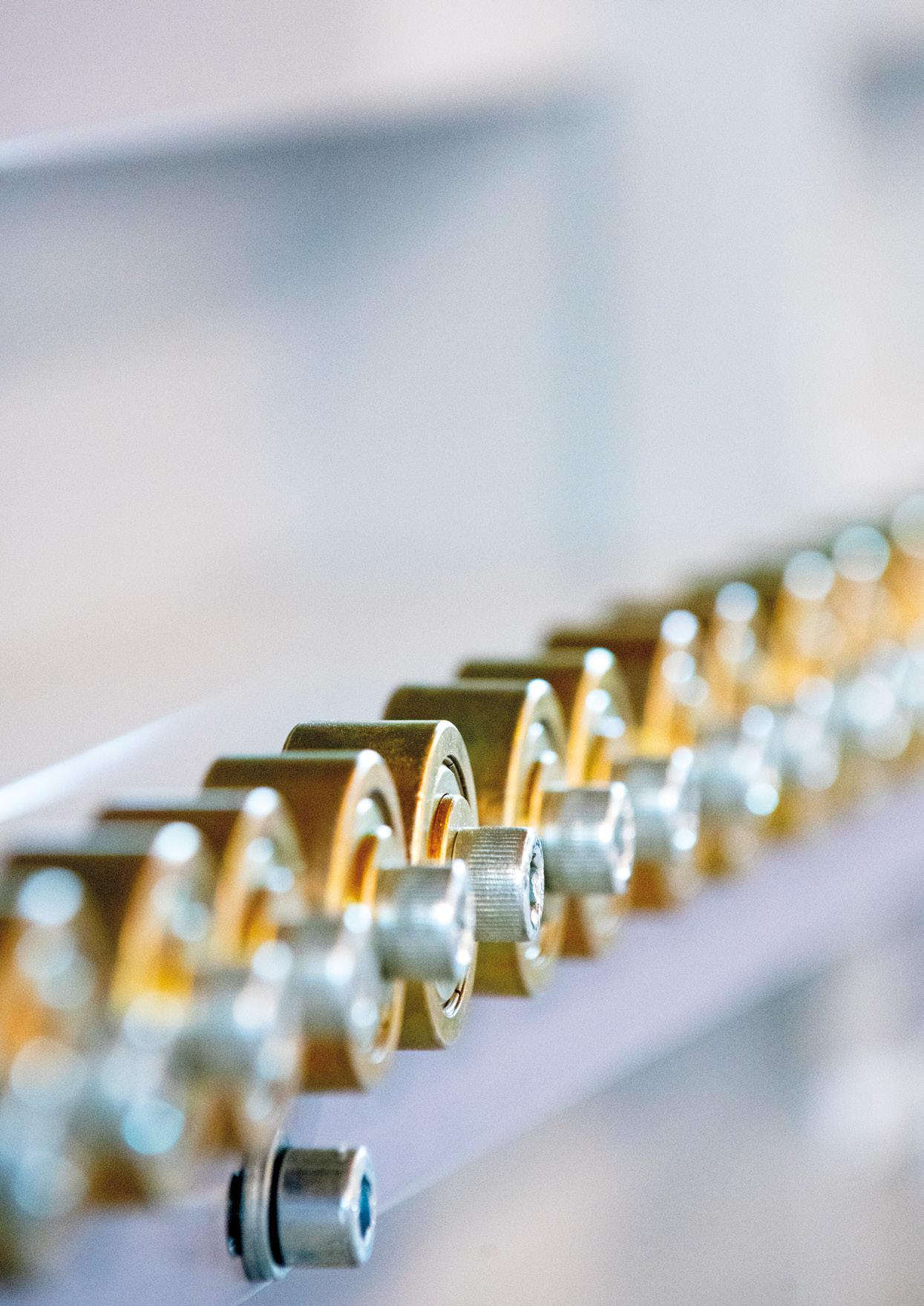




◗ Sanitaryware & Raw Materials ◗ Sanitari e Materie Prime
Villeroy & Boch: a new giant in the sanitaryware industry
Villeroy & Boch compra Ideal Standard e scala il settore
■
■

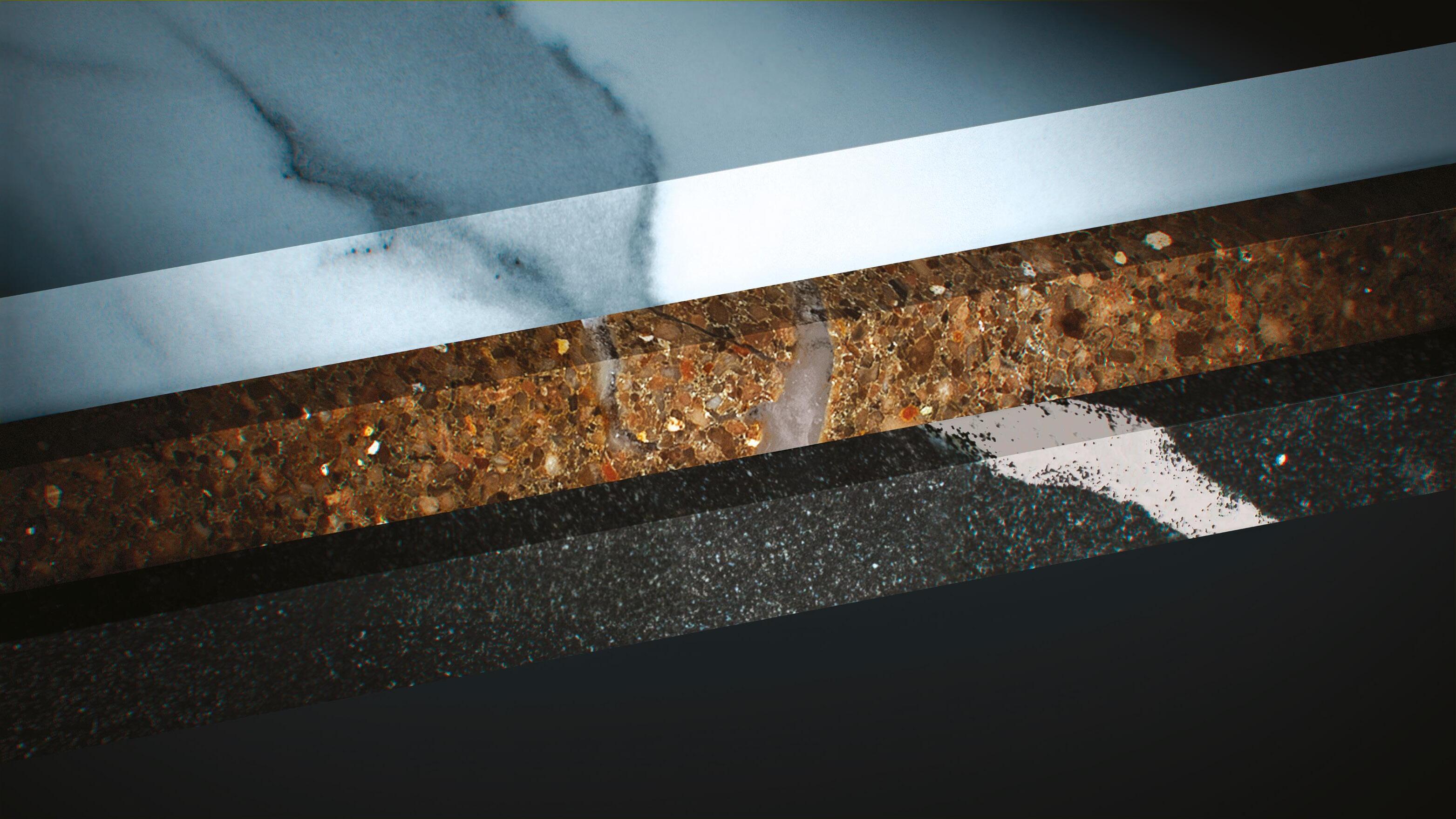

incredible A new technology is already changing the way of digital decoration. The reproduction of natural aesthetic effects will be essential for writing the future. A future reserved for the most forward thinking minds. Amazing? No, incredible. systemceramics.com.
Make it



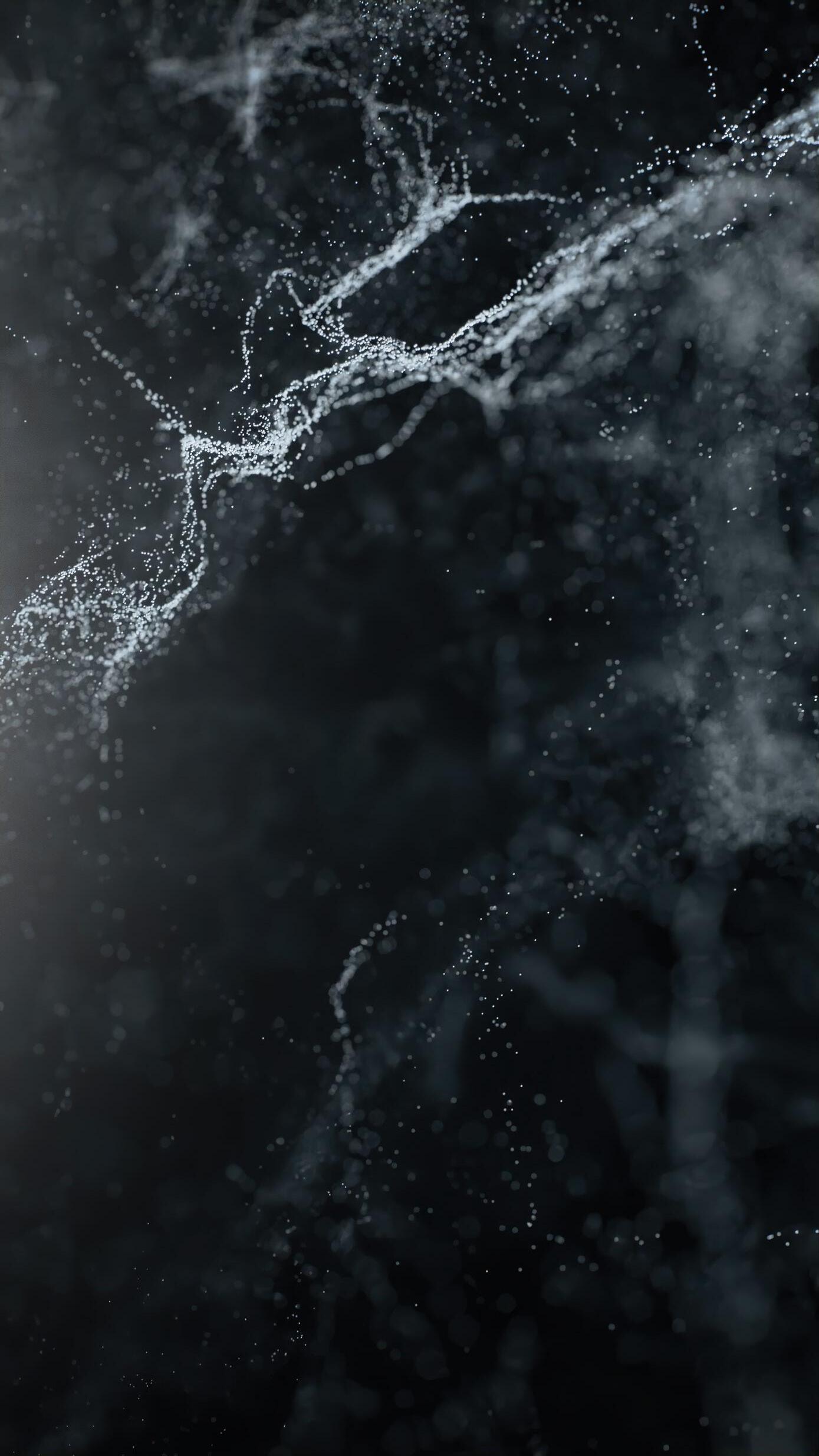

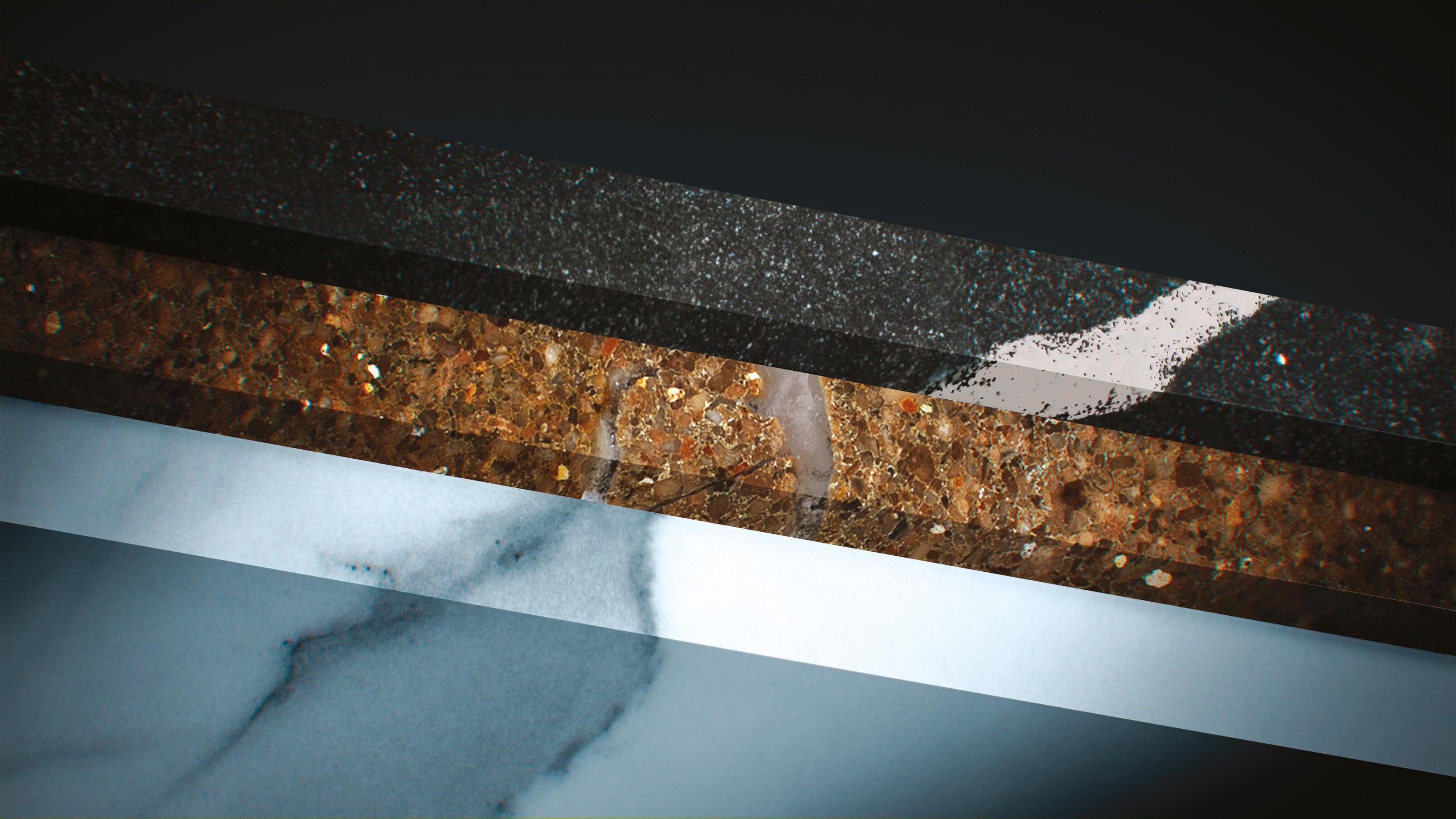

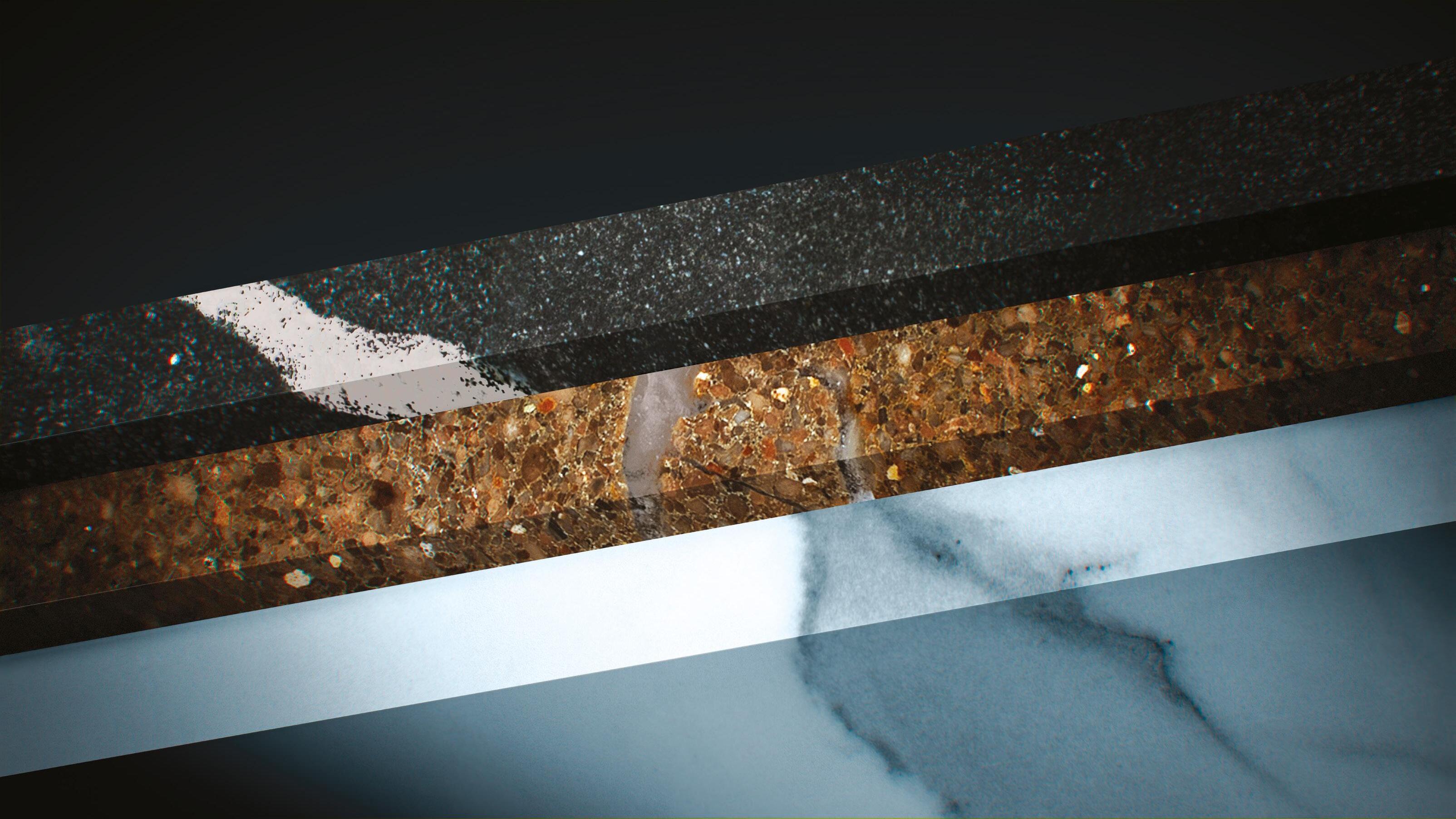


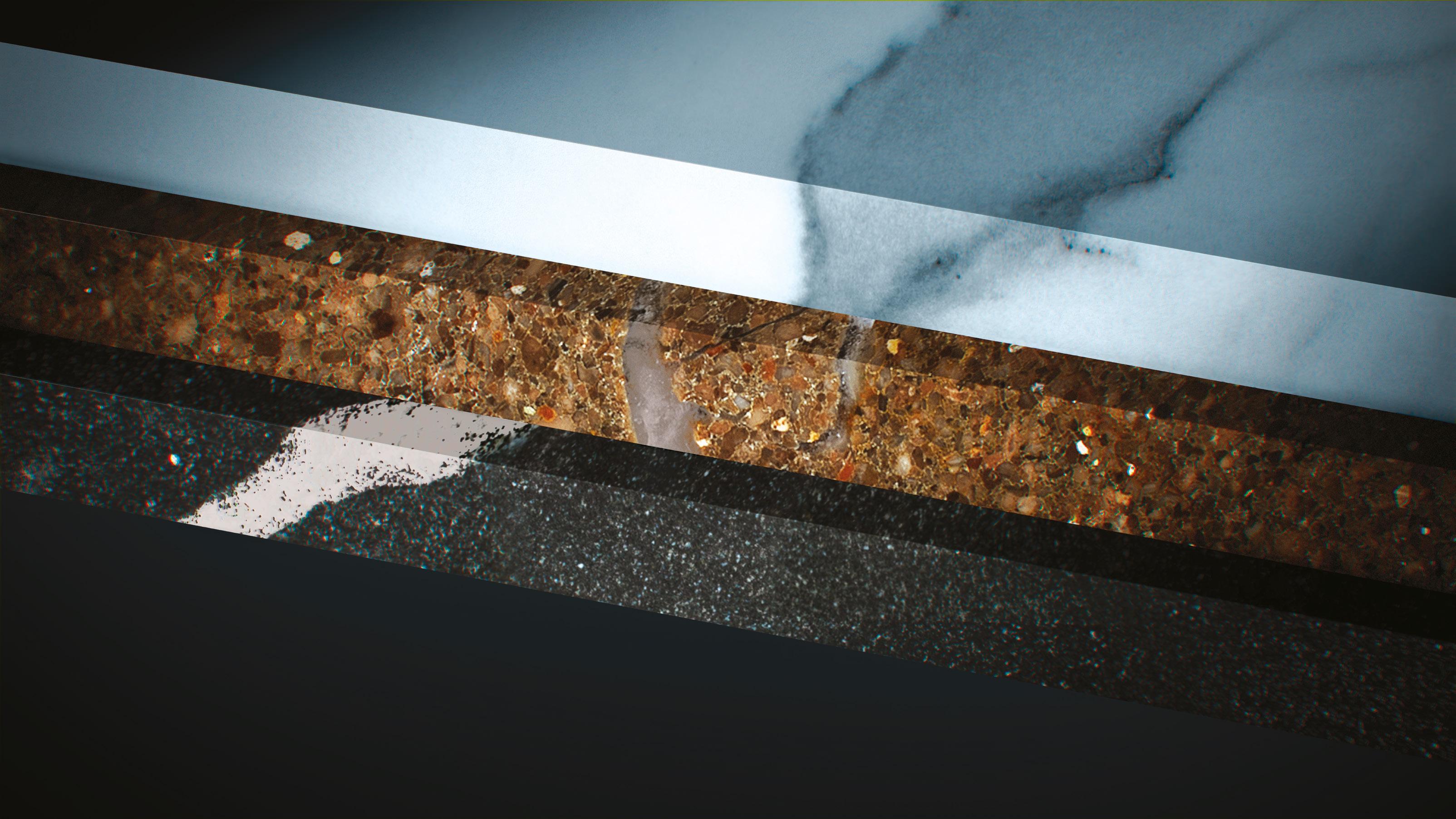
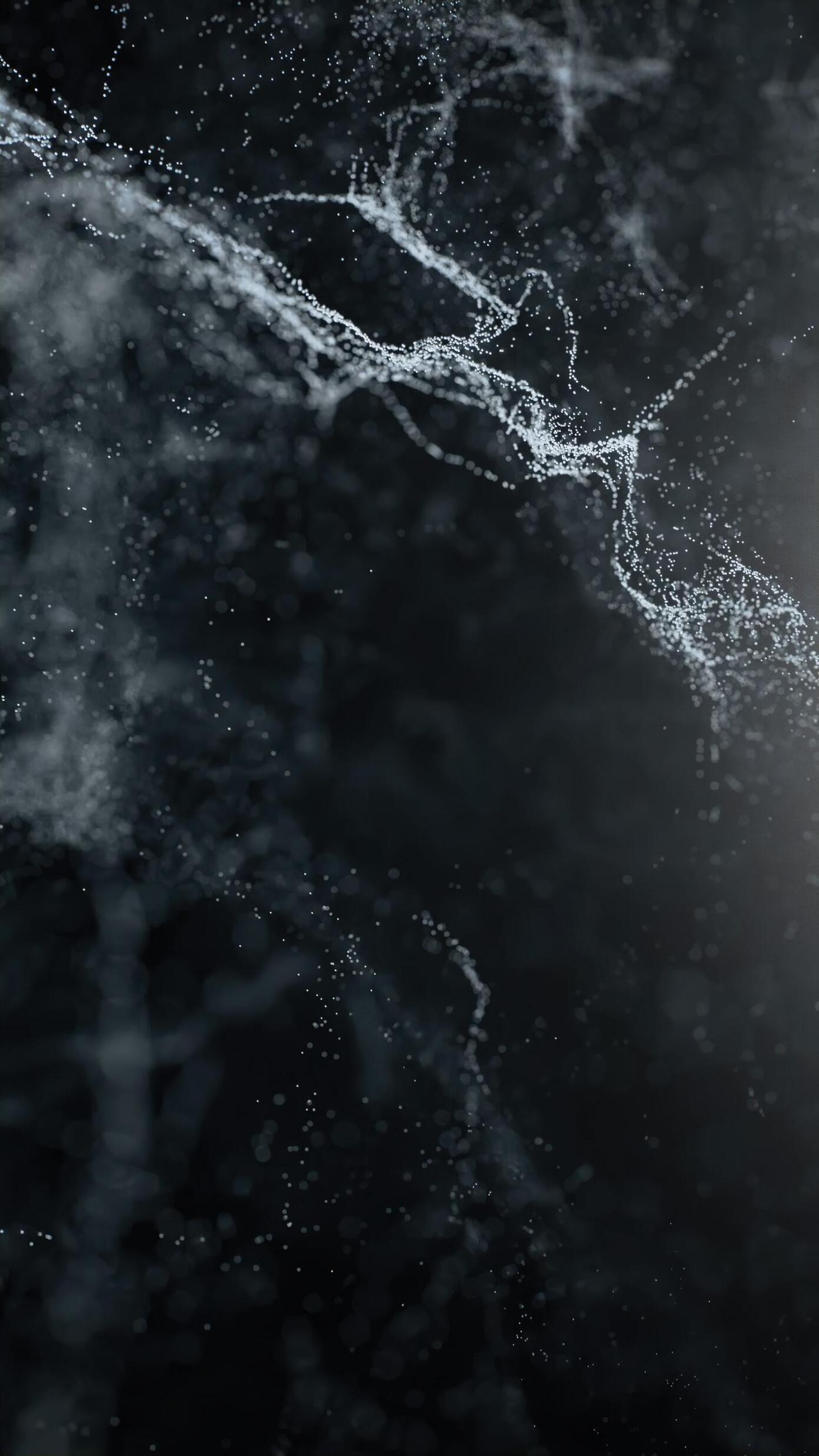
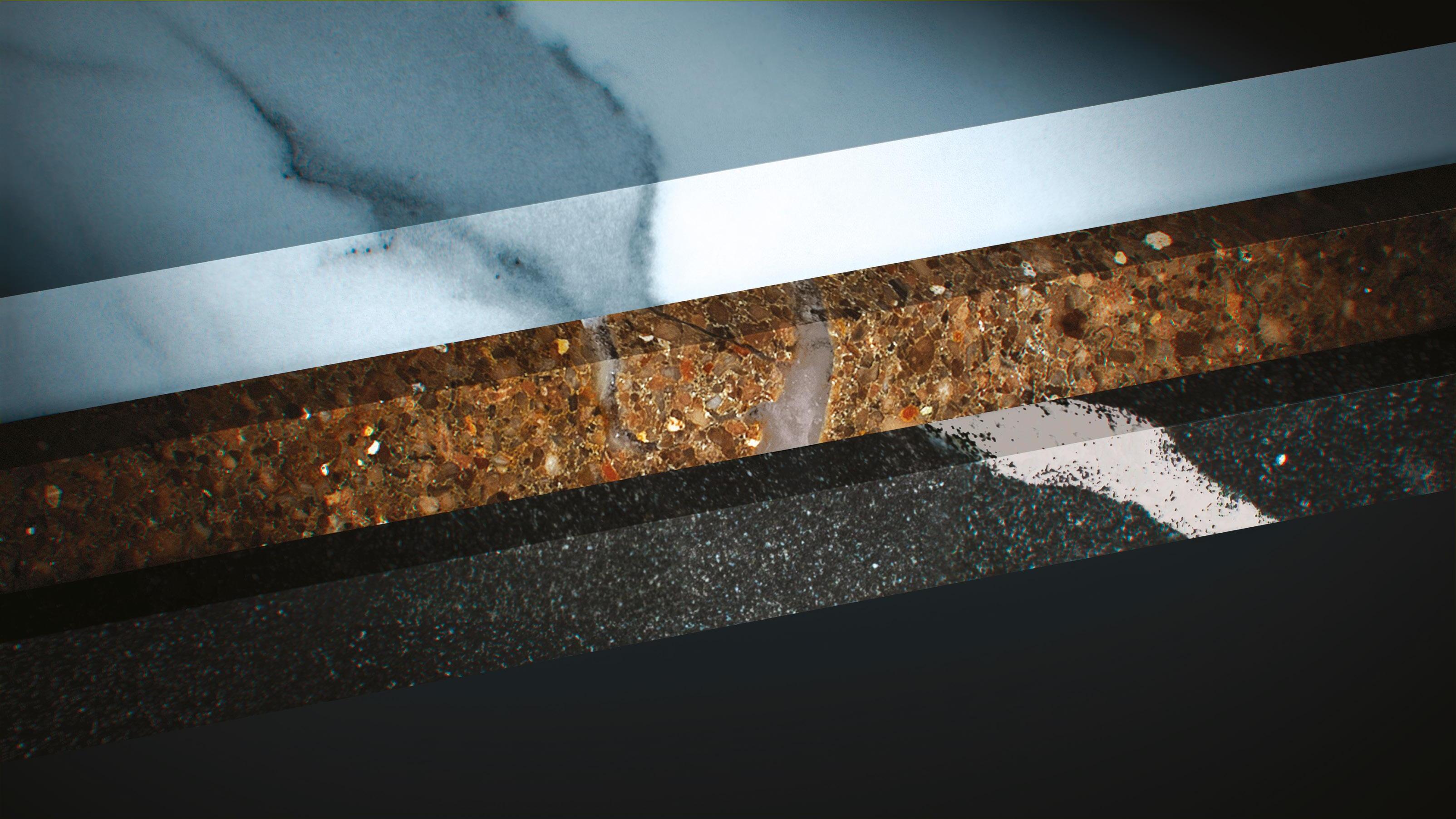




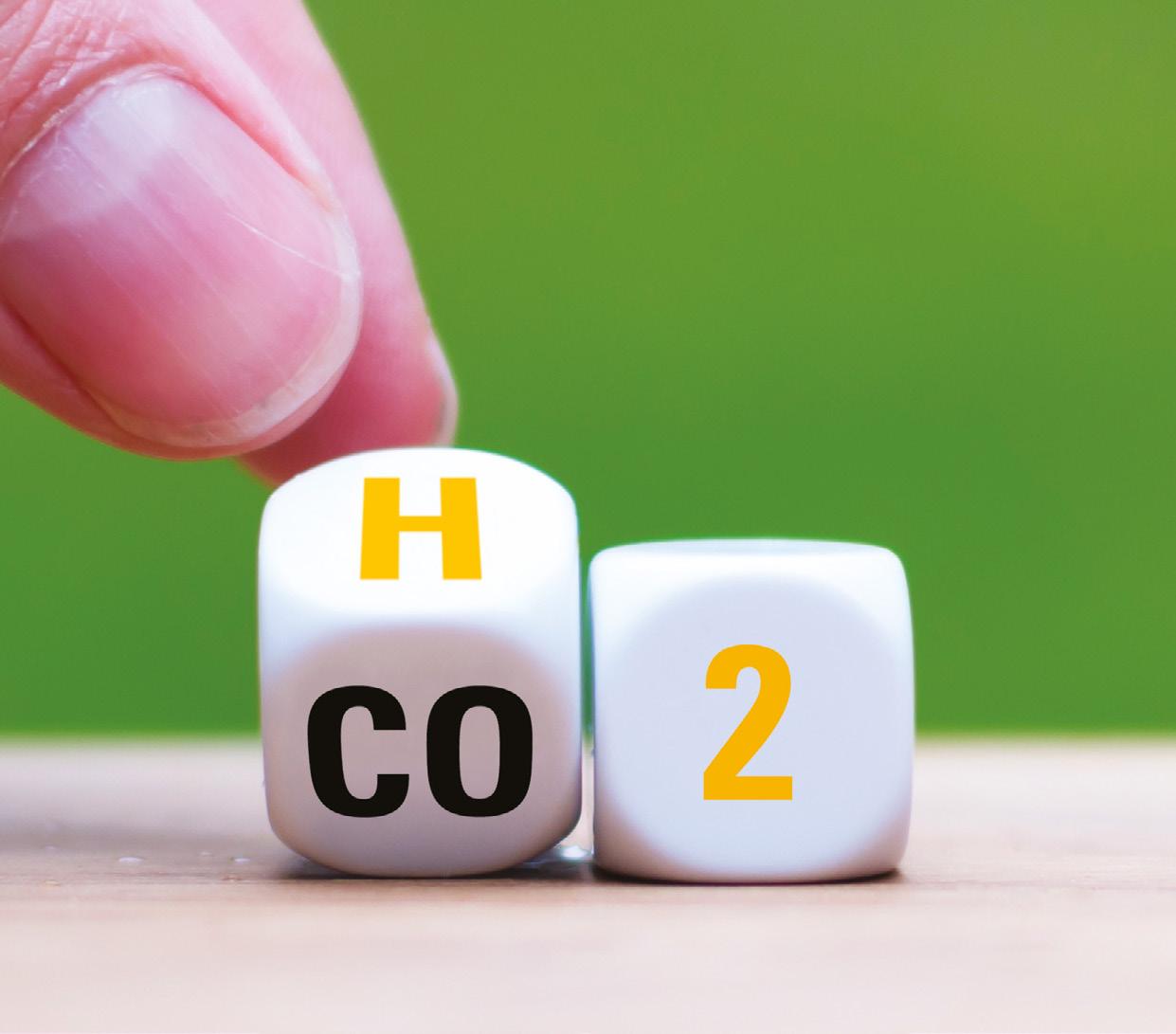


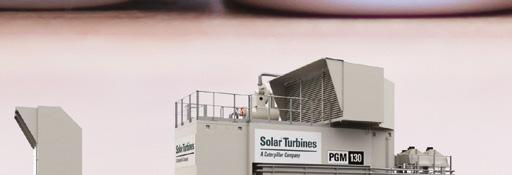



THE FUTURE IS TODAY Thanks to our technologies your company will benefit from H2 and flexible Power and Heat solutions that are ready for both today and tomorrow’s challenges. +2Million hours with high H2 fuel up to100% H2 +16000 Gas Turbines sold For more information and to locate the office nearest you: visit solarturbines.com; Call +41 91 851 1511 (Europe) or +1 619 544 5352 (US) email infocorp@solarturbines.com | www.solarturbines.com CHANGING the rules of the game
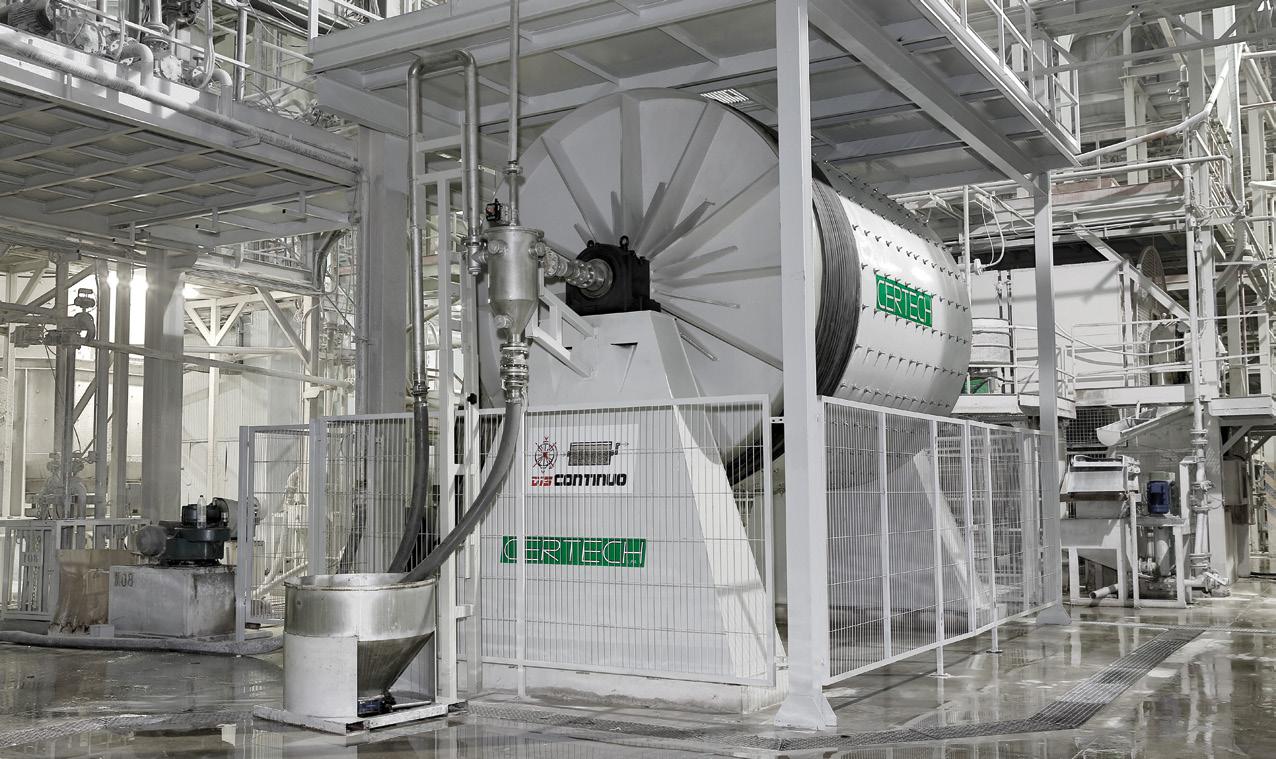

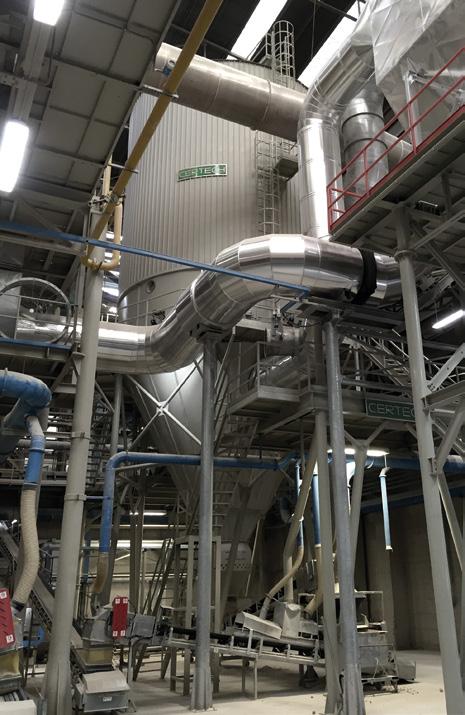








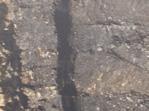






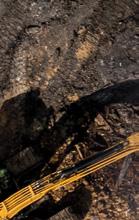










MCS®

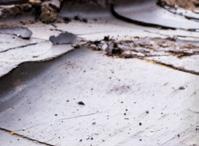





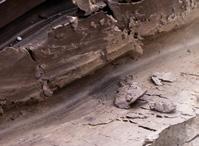

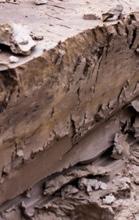



However it o
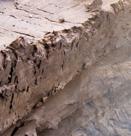



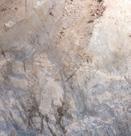







more than ceramic raw materials and ceramic bodies, it is commi ed to sustainable mining principles and providing “Minerals For Life”. Our success is built on innovation, R&D and collaborative partnerships to overcome industry challenges.
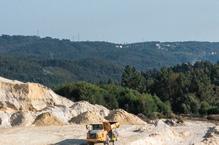







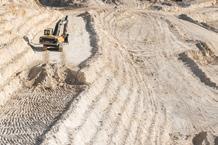




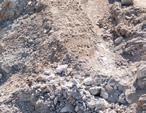









MOTA CERAMIC SOLUTIONS® Zona Industrial de Oiã | Lote 34 | Apartado 90 3770-908 Oiã (OBR) | Portugal | T +351 234 729 190 | F +351 234 729 199 | info@mota-sc.com
is a Portuguese-based multi-mineral, ceramic raw material mining and processing company.
www.mota-sc.com MINERALS FOR LIFE
ers
Saving energy to save the world
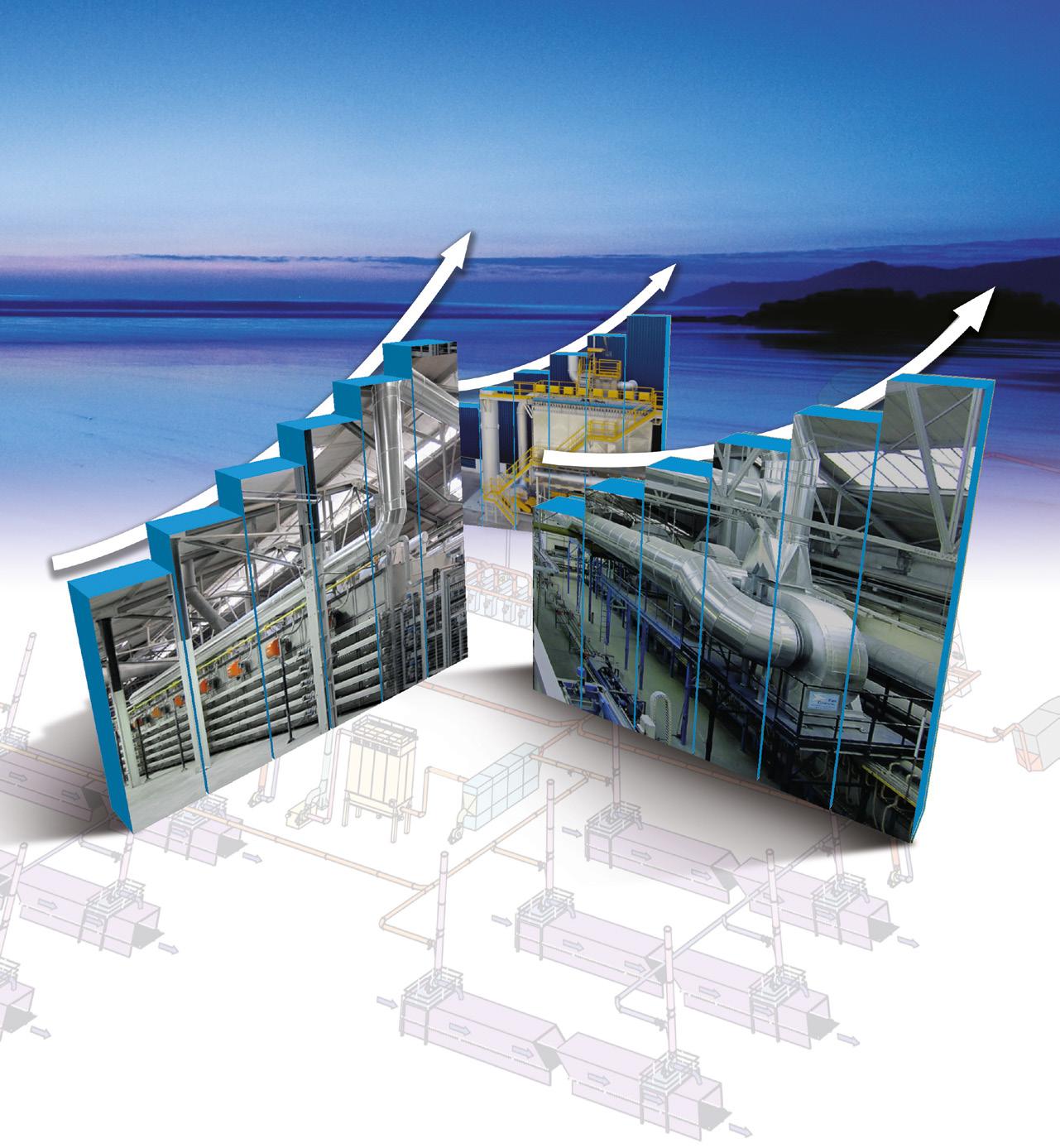
Thermal Energy Recovery System “Intelligente”
Sleeve and Box Filters for Dust and Fumes
Heat Exchangers
Control and Supervision Instruments
Water Purification Systems
Washing Towers and Scrubbers

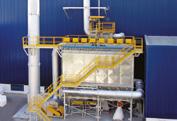
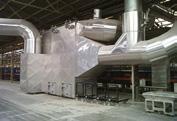
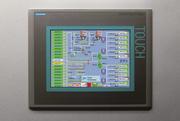
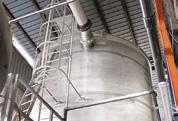

Energy Recovery Systems and Filtration www.poppi.it
TOGETHER
LET’S GROW
Year 33, N° 154
November/December 2023
Bimonthly review
Anno 33, n° 154
Novembre/Dicembre 2023
Periodico bimestrale
Cover picture by: Giancarlo Pradelli
9 E ditorial
Ceramic machinery industry stays resilient in 2023
Paola Giacomini Macchine per ceramica, nel 2023 il settore tiene 10 World NEWs
38
40
42
44
46
48
50
52
54
56
58
68
70

Design and sustainability were the key words at the conference “Ceramics of Value”
Design e sostenibilità al centro del convegno “Ceramica di valore”
Ceramic innovation: System Ceramics redefines surfaces Rita Cagnoli Innovazione ceramica: System Ceramics ridefinisce la superficie
Colored Luxury Surfaces Eros Giavelli Colored Luxury Surfaces
Rethinking thermal processes: the value of a zero-impact future Daniele Baldini Ripensare i processi termici: il valore di un futuro a impatto zero
Forma Plus: material and sustainability Paolo Monari, Antonella Baglio Forma Plus: materia e sostenibilità
Material textures: the role of chemicals Federico Piccinini
Trame materiche: il ruolo della chimica
Design technology: an integrated line for 3D products Cristian Venturelli, Luca Migliori La tecnologia del design: una linea integrata per prodotti 3D
Digital innovation in natural ceramic textures Alan Nappa, Riccardo Mazzi
Innovazione digitale nelle strutture ceramiche naturali
High-value ceramics according to BMR Marco Sichi
La ceramica di valore secondo BMR
A World of Finishes
Marco Scalari, Fabrizio Battaglia “World of Finishes”, un mondo di superfici
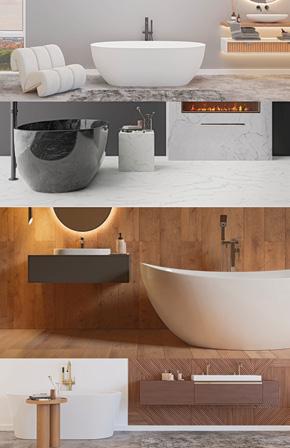
World sanitaryware exports and imports Luca Baraldi Export e import mondiale di sanitari
The big players in the sector I big del settore
Villeroy & Boch: a new giant in the sanitaryware industry Milena Bernardi Villeroy & Boch compra Ideal Standard e scala il settore 78
VitrA inaugurates fifth sanitaryware plant
Isvea: Making the difference through Italian design Silvia Lepore
Increasingly
VitrA
inaugura il quinto impianto per sanitari 86
Isvea,
il design italiano che fa la differenza 92
Soluzioni sempre più sostenibili nella produzione di sanitari 96
Deal actions in sanitaryware production Sacmi Sanitaryware Le Green Deal Action nella produzione di sanitari 100 Lixil invests in sanitaryware pre-drying Paolo Marcheluzzo Lixil investe nella pre-essiccazione dei sanitari 102 LATEST TECHNOLOGIES sanitaryware 104 r aW M at E rials Feldspars for glazed porcelain tile production Minerali Industriali Feldspati per grès porcellanato smaltato 108 LATEST TECHNOLOGIES raw materials 124 t opics Cybersecurity: are we ready to protect our data? Matteo Marconi Cybersecurity: siamo pronti a difendere i dati? 7 advErtisErs’ list contents 5 CWR 154/2023 FOCUS ON ceramics of value FOCUS ON sanitaryware
sustainable solutions for sanitaryware production Imerys
Green

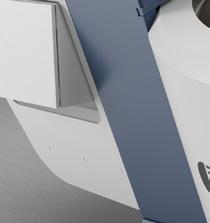


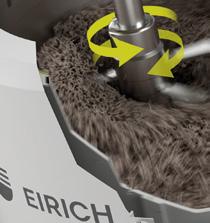

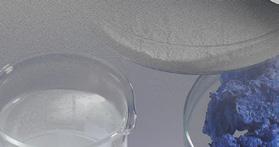

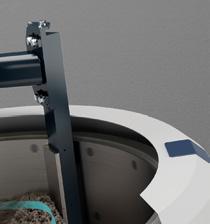


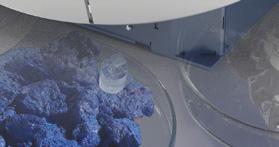



You call it eff iciency
We call it Eirich



Publisher / Editore:
Administration and Editorial Office Amministrazione e Redazione
KAIROS MEDIA GROUP Srl
Via Fossa Buracchione, 84 41126 Baggiovara (MO) - Italy
Tel. +39 059 512103
Fax +39 059 512157 info@kairosmediagroup.it
Iscritto al registro delle imprese di Modena C.F./P.IVA IT02778050365
Capitale Sociale: € 51.400,00
R.E.A. 329775. Iscrizione ROC n. 9673 Periodico bimestrale registrato presso il Tribunale di Modena al n. 21/17 in data 10/08/2017
• CEO: Gian Paolo Crasta g.crasta@kairosmediagroup.it
• Editor / Direttore responsabile: Paola Giacomini p.giacomini@kairosmediagroup.it
• Editorial Board / Comitato Editoriale: Luca Baraldi, Milena Bernardi, Gian Paolo Crasta, Stefano Lugli
• Advertising / Pubblicità:
KAIROS MEDIA GROUP SRL: Tel. +39 059 512103 Fax +39 059 512157
• Paola Giacomini mobile +39 335 1864257 p.giacomini@kairosmediagroup.it
• Silvia Lepore mobile +39 345 7218245 s.lepore@kairosmediagroup.it
• Elisa Verzelloni mobile +39 338 5361966 e.verzelloni@kairosmediagroup.it
• Translation / Traduzioni: John Freeman
Eirich is the worldwide standard in the ceramics industry since decades. The highly eff icient and resource-saving Eirich technology makes you and your product better and better.
• Subscriptions / Abbonamenti: www.kairosmediagroup.it/it/shop/ abbonamenti-riviste
• Each copy / una copia € 4
• Annual subscription (5 issues) Abbonamento annuale (5 numeri) Italy: € 35; International: €50; Special tariffs for group subscriptions are available on request. Tariffe speciali per abbonamenti collettivi sono disponibili su richiesta.
Spedizione in a.p. art. 1 comma 1 DL 353/2003 DCB MODENA
L’IVA sugli abbonamenti, nonché sulla vendita dei fascicoli separati, è assolta dall’Editore ai sensi dell’art. 74 primo comma lettera C del DPR 26.10.72 N. 633 e successive modificazioni e integrazioni.
• Printer / Stampa
Faenza Printing Industries SpA Via Vittime Civili di Guerra 35 48018 Faenza (RA)
• Graphic Layout, photolits, typesetting
Progetto grafico e prestampa
Vaccari Zincografica S.r.l.
Via E.Salgari, 61 - 41123 Modena
Entire
KAIROS MEDIA GROUP S.r.l., in conformità al “Testo unico sulla privacy”, garantisce la riservatezza dei dati usati per gli abbonamenti e per gli scopi tipici della stampa specializzata e la possibilità di modificarli o cancellarli (art. 7 del D.L. 196/2003) a mezzo richiesta scritta. ADVERTISING
promoted by contents copyright Kairos Media Group. All rights reserved. Opinions expressed by writers are not necessarly those held by the publisher who is not held responsible. Editorial material, manuscripts, photographs, transparencies and artwork will not be returned.
Tutti i diritti di riproduzione e traduzione degli articoli pubblicati sono riservati È vietata la riproduzione anche parziale senza l’autorizzazione dell’Editore. Manoscritti, disegni, fotografie e altro materiale inviato in redazione, anche se non pubblicati, non verranno restituiti. La Direzione non assume responsabilità per le opinioni espresse dagli autori dei testi redazionali e pubblicitari.
eirich.de
kairos media group also publishes:
date of going to press / chiuso in redazione il: 13/12/2023
advertisers’ list

 by STEPHAN SCHMIDT
by STEPHAN SCHMIDT
customised clay solutions
excellent deflocculation characteristics
minimal deformation high purity outstanding quality consistency
QUALITY Stephan Schmidt KG DE-65599 Langendernbach · Fon +49 6436 609-0 · www.schmidt-tone.de
Ancora 8 Bavelloni 31 Bmr III cop CAI 85 Ceramitec 123 Certech 2-27-111 Cevisama 91 Coverings 36 Donatoni 21 Durst 17 Efi Cretaprint 29 Eirich 6 Elle K Automazioni 107 Esan 113 Esmalglass-Itaca Group 81 Essepienne 67 Fritta 83 Geomix 119 Gmm 117 Imerys Talc Europe 95 Inco 11 Indian Ceramics Asia 121 Inter Ser 13-59-115 Isvea 89 Joseph Lundgren Consulting 41 Kajaria Ceramics 61 Lamberti 35 Marcheluzzo 73 Minerali Industriali 106 Mota 3 Novaref 23 Off. Smac 77 Paniker 16 Pologres 15 Poppi Clementino 4 Remas 25 Revestir 99 Sacmi IV cop SBS 127 Sigmadiamant 37 SITI B&T Group 19 Smaltochimica 47 Solar Turbines 1 Stephan Schmidt 7 Surfaces Group 128 System Ceramics II cop Tecna 2024 65 Torrecid 63 Tradeco 57 Vidres 75
ADVERTISING
MATRIX
THE ULTIMATE SOLUTION FOR LARGE GLOSSY SURFACE

THE
BEAUTY OF LEAVING A MARK
Unbeatable mirror effect
Beam-by-beam management
Head-by-head control
Very high and no-stop production: 4 beams
Slabs up to 200 cm
by Paola Giacomini, Editor - p.giacomini@tiledizioni.it
CERAMIC MACHINERY INDUSTRY STAYS RESILIENT IN 2023
MACCHINE PER CERAMICA, NEL 2023 IL SETTORE TIENE
Despite a second-half slowdown in orders, the Italian ceramic technology industry achieved good overall results in 2023. Preliminary figures compiled by the MECS - Acimac Research Centre indicate full-year revenues of €2.31 billion, 1.7% down on the record levels achieved in 2022. Exports, which have traditionally been the main driver behind the industry’s sales, fell by 4.1% year on year to €1.62 billion (70% of total sales), while domestic sales grew by 4.6% to €687 million.
The sector represented by Acimac therefore closed the year with a stable performance following a positive first half aligned with 2022 and a second half penalised by reduced investments within the ceramic industry. This slowdown was largely caused by a general decline in construction activity, a trend driven in part by rising interest rates. For the tile industry in particular, MECS predicts a global decline in production of 1 billion square metres in 2023.
“Achieving sales well above €2 billion for the third consecutive year is a cause for satisfaction,” said Acimac’s Chairman Paolo Lamberti. “However, the outlook for 2024 is not so positive due to a variety of factors including high interest rates, the ongoing war in Ukraine and the substantial investments made by our clients in recent years. Our forecasts suggest that global ceramic tile production will fall by 5.6% next year and will generally remain at modest levels until 2027, with an average annual growth rate of 0.6%. Consequently, 2024 will be a challenging year for our industry with a decline in sales all but certain After overcoming the emergency triggered by soaring energy prices, the ceramic industry as a whole will continue to face significant challenges, similar to others we have experienced in the past. But unlike the crises caused by the pandemic and raw materials shortages, this phase appears to be more cyclical in nature, so we will pull through this time too. We must also bear in mind that the real revolution occurring in the ceramic technology sector concerns the ever higher levels of innovation. In the last three years, the Sassuolo ceramic technology cluster has seen the emergence of a series of groundbreaking inventions that will inevitably set the Italian ceramic industry on a new course towards an even higher level of excellence. This constant innovation is what sets us apart from other technologies produced outside Italy and would not be possible without the presence of so many outstanding companies concentrated in the space of just a few square kilometres.” ◼
Nonostante il secondo semestre abbia evidenziato il rallentamento degli ordini, il settore italiano delle tecnologie per l’industria ceramica chiude il 2023 con un buon risultato. I preconsuntivi elaborati da MECSCentro Studi Acimac, indicano un giro d’affari complessivo pari a 2,31 miliardi di euro, ossia -1,7% rispetto ai livelli record raggiunti nel 2022. L’export, tradizionale traino del comparto, si attesta a 1,62 miliardi di euro (il 70% del fatturato totale), in flessione del 4,1% sul 2022, mentre le vendite sul mercato domestico sono cresciute del 4,6% a 687 milioni di euro. Il comparto rappresentato da Acimac chiude quindi l’esercizio all’insegna della stabilità, saldo tra un primo semestre positivo, in linea con il 2022, e un secondo semestre penalizzato dalla frenata degli investimenti nell’industria ceramica che, a sua volta, sta affrontando un diffuso rallentamento dell’attività edilizia, causato in parte dall’aumento dei tassi di interesse. Nello specifico del settore piastrelle, MECS prevede per il 2023 una perdita di produzione a livello globale pari a 1 miliardo di metri quadrati.
“Restare ampiamente sopra quota 2 miliardi di euro per il terzo anno consecutivo è motivo di soddisfazione – ha dichiarato Paolo Lamberti, Presidente di Acimac -, ma stia-

mo già pensando al 2024, visto che i segnali non sembrano dei migliori tra i tassi d’interesse, il perdurare del conflitto in Ucraina e i grossi investimenti fatti negli ultimi anni dai nostri clienti. Le nostre previsioni stimano per il prossimo anno che la produzione mondiale di ceramica calerà del 5,6% restando modesta fino al 2027, con una crescita media annua dello 0,6%. Di riflesso, il 2024 sarà per il nostro settore un vero banco di prova, in cui ci attendiamo una riduzione del giro d’affari. L’intero settore della ceramica, superata l’emergenza del rincaro energetico, sta affrontando una congiuntura complicata, come altre viste in passato. Rispetto agli shock della pandemia e dello shortage, però, questa fase sembra di carattere più ciclico, quindi ne usciremo anche stavolta. Anche perché la vera svolta che si sta verificando nel settore delle tecnologie ceramiche è caratterizzata da un’innovazione sempre più marcata. Negli ultimi tre anni, il comparto delle tecnologie per ceramica del comprensorio di Sassuolo ha visto il concretizzarsi d’invenzioni all’avanguardia, tracciando di fatto una nuova strada che inevitabilmente porterà il settore ceramico italiano a un livello ancora superiore. Un’innovazione costante che ci distingue dalle proposte tecnologiche prodotte fuori dall’Italia e che non sarebbe possibile senza questa convergenza di eccellenze in pochi chilometri quadrati”. ◼



www.CeramicWorldWeb.com Follow us also on Social. Daily updates! Search “Ceramic World Web” editorial 9 CWR 154/2023
PANARIAGROUP ACQUIRES KEY ASSETS OF STEULER FLIESENGRUPPE
Negotiations for the rescue of Steuler Fliesengruppe, a historic German ceramic tile manufacturer with three factories in Leisnig, Bremerhaven and Mühlacker and 2022 revenues of €136 million from sales in Germany, Austria, Holland and Switzerland, were concluded during the week of Cersaie.
On 28 September, Panariagroup announced the agreement for the purchase of the group’s key assets, namely the Leisnig factory, the four ceramic surface brands (Steuler, Grohn, Kerateam and Nordceram), the sales network and the associated product inventories.
The acquisition agreement includes the incorporation of the administrative personnel and staff responsible for the various services into Panariagroup.
Emilio Mussini, Chairman of Panariagroup, commented: “The acquisition of the assets of Steuler Fliesengruppe, with which we’ve been collaborating for an extended period, is a strategic decision that significantly bolsters our presence in the German market. We have the privilege of a longstanding partnership with this Group and intend not only to ensure the utmost continuity for the Steuler, Grohn, Kerateam and Nordceram brands but also to further enhance their value on the international stage. This move perfectly aligns with our growth and internationalization objectives and is founded upon a robust economic and strategic plan geared towards enhancing our business. Our approach involves developing the Leisnig facility, optimizing the resources we’ve acquired and actively engaging with local suppliers and partners.”
“Thanks to the close proximity to raw material suppliers and an
already established commercial network in the region, we are confident in our ability to transform the Leisnig site and other acquired assets into a pivotal hub for our business expansion across Europe,” Mussini added. “As a result of this strategic move, in conjunction with expanding distribution channels within the acquired group and the expected synergies with our other European Business Units, Panariagroup solidifies its prominent position in the German-speaking markets.”
Already one of the world’s leading manufacturers of high-end ceramic floor and wall tiles, Panariagroup has now taken a further major step forward in its process of international expansion and has further consolidated its global leadership in the production and distribution of ceramic surfaces.
The Italian group operates its own facilities in Italy, Portugal and the United States and sells its products in more than 130 countries worldwide.
This latest acquisition comes just a few months after that of Gresart in Portugal (finalised last April) and concludes a year that also saw the complete reorganisation of the American Business Unit with the appointment of a new CEO and the opening of a showroom in New Delhi.
At the same time as the agreement signed with Panariagroup, Steuler Fliesengruppe announced that the Bremerhaven facility will be acquired by Norddeutsche Solar Ceramics as of 1 April 2024, while the Mühlacker factory will be closed.
A PANARIAGROUP GLI ASSET PIÙ IMPORTANTI DI STEULER FLIESENGRUPPE
Si sono concluse durante la settimana di Cersaie le trattative per il salvataggio di Steuler Fliesengruppe, storico produttore tedesco di piastrelle ceramiche, con
tre stabilimenti a Leisnig, Bremerhaven e Mühlacker e un fatturato 2022 pari a 136 milioni di euro, realizzato con vendite in Germania, Austria, Olanda e Svizzera.
Il 28 settembre, Panariagroup ha annunciato l’accordo per l’acquisto degli asset più importanti del gruppo, ossia lo stabilimento di Leisnig, i quattro brand di superfici ceramiche (Steuler, Grohn, Kerateam, Nordceram), inclusa la rete vendite e i relativi stock di prodotto finito.
L’accordo di acquisizione comprende il trasferimento a Panariagroup dello staff amministrativo e del personale addetto ai vari servizi.
Commentando l’operazione, Emilio Mussini, Presidente di Panariagroup, ha dichiarato: “L’acquisizione degli asset di Steuler Fliesengruppe è una scelta strategica che rafforza la nostra penetrazione sul mercato tedesco. Abbiamo il privilegio di collaborare da lungo tempo con lo storico Gruppo e intendiamo assicurare non solo la massima continuità ai marchi Steuler, Grohn, Kerateam, Nordceram ma anche valorizzarli ulteriormente nel panorama internazionale. Perfettamente in linea con i nostri obiettivi di crescita, questa operazione si basa su un solido piano economico e industriale, finalizzato al potenziamento del nostro business, che intendiamo attuare attraverso lo sviluppo dello stabilimento di Leisnig, la valorizzazione delle risorse acquisite e un coinvolgimento diretto dei fornitori e dei partner locali.”
“Grazie ad una posizione vicina
ai produttori di materie prime e una rete commerciale già attiva sul territorio, – continua Mussini – riteniamo di poter rendere il sito di Leisnig e gli altri asset acquisiti un hub strategico per lo sviluppo del nostro business in Europa. Con questa operazione e la diversificazione dei canali distributivi del gruppo acquisito, nonché le sinergie produttive delle altre nostre Business Unit europee, Panariagroup diviene uno dei primi player nei mercati di lingua tedesca.”
Tra i maggiori produttori mondiali di superfici ceramiche per pavimenti e rivestimenti di alta gamma, Panariagroup aggiunge così un nuovo importante tassello alla sua espansione internazionale e consolida ulteriormente la propria leadership nella produzione e distribuzione a livello globale.
Il gruppo italiano è presente con propri stabilimenti in Italia, Portogallo e Stati Uniti e commercializza i suoi prodotti in oltre 130 Paesi in tutto il mondo.
Quest’ultima acquisizione giunge ad appena a pochi mesi da quella di Gresart in Portogallo (lo scorso aprile) e chiude un anno che ha visto anche la completa riorganizzazione della Business Unit americana con la nomina di un nuovo CEO e l’apertura di uno showroom a New Delhi. Contestualmente all’accordo siglato con Panariagroup, Steuler Fliesengruppe ha comunicato che lo stabilimento di Bremerhaven sarà rilevato dal 1° aprile 2024 dalla Norddeutsche Solar Ceramics, mentre lo stabilimento di Mühlacker verrà chiuso.

10 CWR 154/2023 world news

Your ambition, our colours
www.incolours.it COLOUR INNOVATION INDUSTRY
PORTOBELLO OPENS FACTORY IN TENNESSEE
The official opening of the Portobello America plant, the Brazilian ceramic group’s first overseas production site, was held on 14 October in Baxter, Tennessee. The event was attended by more than 300 guests, including local dignitaries and major strategic partners. They were welcomed by Portobello Group’s President Cesar Gomez Jr. together with four generations of his family, including his father Cesar Gomez who founded the company in Tijucas back in 1979.
The state-of-the-art factory in Baxter, which started production on 20 July, is already fully operational and will produce medium to large sized tiles and special pieces for the US market. In this initial phase, it will have an output of around 3.6
million square metres per year.
The factory “combines cutting-edge technology and logistics to create a unique tailor-made solution for the US market”, said Portobello America. One of the main technology partners was Sacmi, which supplied key plant technologies including state-ofthe-art mills, spray dryers, presses and kilns, as well as BMR’s advanced finishing lines and the HERE factory supervisor. The facility features cutting-edge environmental technology including flue gas filtration and dust suppression systems designed and supplied by Sacmi.
This project strengthens the partnership between Portobello and Sacmi following the investments made at the Brazilian headquarters, including the line for largesize decorated slabs launched in 2020
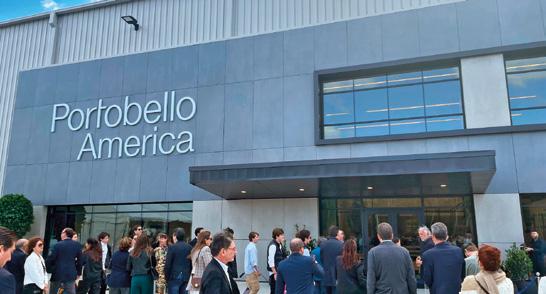
FRITTA CELEBRATES ITS 50th ANNIVERSARY WITH A NEW IMAGE
The Spanish ceramic glaze and colour producer Fritta, part of the Altadia Group, has marked its 50th anniversary with a fresh corporate image while reaffirming its commitment to the pursuit of growth and international expansion that has characterised half a century of activity. The new logo provides a more modern and dynamic interpretation of the principles on which Fritta has based its evolution: reliability, safety, quality and
PORTOBELLO INAUGURA LA FABBRICA IN TENNESSEE
Grande festa lo scorso 14 ottobre a Baxter, Tennessee, per l’inaugurazione ufficiale dello stabilimento di Portobello America, primo polo produttivo all’estero del gruppo ceramico brasiliano, entrato in funzione il 20 luglio. Oltre 300 gli ospiti intervenuti all’evento, tra autorità locali e principali partner strategici. Ad accoglierli, il Presidente di Gruppo Portobello Cesar Gomez Jr., insieme a tutta la famiglia, rappresentata da ben quattro generazioni, tra cui il padre, Cesar Gomez, che nel 1979 fondò l’azienda a Tijucas.
La modernissima fabbrica di Baxter, già pienamente operativa, produrrà piastrelle in formati medio-grandi e pezzi speciali destinati al mercato statunitense e in que-
sta prima fase potrà raggiungere una produzione di circa 3,6 milioni di metri quadrati l’anno. Lo stabilimento “combina tecnologia e logistica avanzate per creare un’offerta unica di soluzioni su misura per il mercato americano”, ha dichiarato Portobello America. Tra i partner tecnologici spicca Sacmi, che ha fornito le tecnologie chiave dell’impianto: mulini, atomizzatori, presse e forni di ultima generazione, oltre alle linee di finitura evolute di BMR e il supervisore di fabbrica HERE. Il sito produttivo è all’avanguardia anche dal punto di vista ambientale, grazie ai sistemi di filtrazione fumi e abbattimento polveri progettati e forniti sempre da Sacmi.
Questo progetto rafforza la partnership tra Portobello e Sacmi dopo gli investimenti realizzati in Brasile, tra cui la linea dedicata alle grandi lastre decorate avviata nel 2020.

service.
These values are consistently upheld through the company’s research and development of innovative projects, its commitment to environmental sustainability, and its responsiveness and adaptability to the demands of an ever-changing market.
By presenting the new corporate image and celebratory video, Fritta has reaffirmed its determination to take on new challenges in international markets while continuing to innovate in the field of frits, glazes, inks and digital ceramic colours.
FRITTA FESTEGGIA I 50 ANNI CON UNA NUOVA IMMAGINE
In occasione del 50° anniversario, Fritta, colorificio ceramico spagnolo parte di Altadia Group, ha rinnovato la sua immagine aziendale sottolineando così l’impegno a proseguire il percorso di crescita ed espansione internazionale che ha caratterizzato mezzo secolo di attività.
Il nuovo logo interpreta in maniera più moderna e dinamica i pilastri su cui Fritta ha basato la sua evoluzione: affidabilità, sicurezza, qualità e servizio. Valori confermati quotidia-
namente attraverso la ricerca e sviluppo di progetti innovativi, l’impegno verso la sostenibilità ambientale e l’ascolto e la capacità di adattamento alle esigenze di un mercato in continua trasformazione.
Presentando la nuova immagine e il video celebrativo, Fritta ha confermato la determinazione ad affrontare nuove sfide sui mercati internazionali, continuando ad apportare innovazione nel settore delle fritte, smalti, inchiostri e colori ceramici digitali.

12 CWR 154/2023 world news



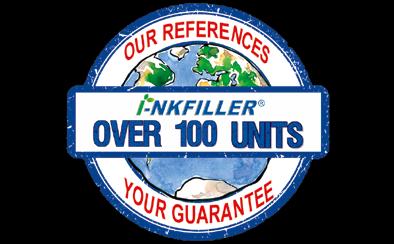
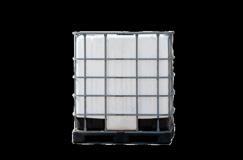
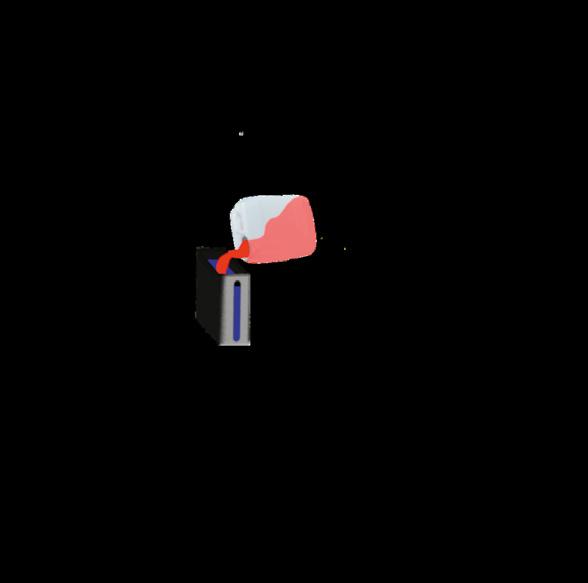



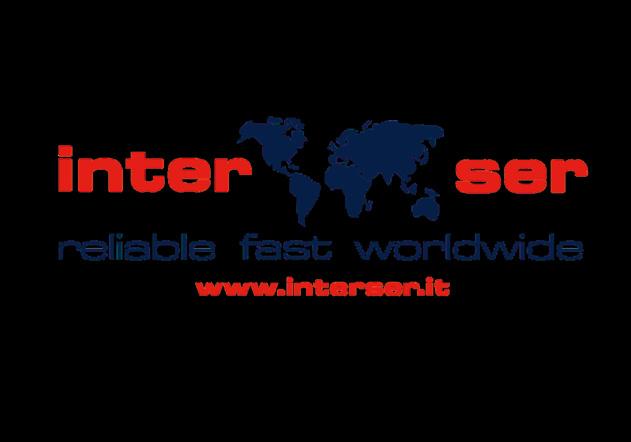
SUSTAINABLE DIGITALISATION ACCORDING TO SYSTEM CERAMICS
From sensors and IoT to Big data, from automation to artificial intelligence, digital technologies are revolutionising factories and giving companies a real competitive advantage. However, to ensure that these benefits are long-lasting, it is essential to focus at the same time on the sustainability of processes.
In keeping with Coesia’s green strategy, since 2022 System Ceramics has been accelerating the adoption of smart factory solutions and has made a significant contribution to the ceramic sector by researching and developing technologies capable of making it not only increasingly digitalised, but also more sustainable throughout the entire production process, from pressing through to decoration, inspection and packaging.
Examples include the Superfast ceramic press, which offers energy savings of 70%; Creadigit Infinity, the digital decoration technology that uses water-based inks to improve the working environment and reduce emissions; Digiglaze, the digital glazing machine that reduces consumption and waste by up to 30% and eliminates 90% of the water needed for its maintenance. Other new technologies are the Genesis project for sustainably reproducing marble and natural stone, and Hypermate, the Industry 4.0 manage-
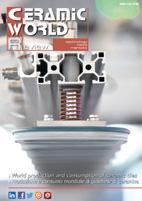
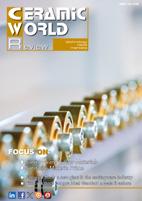
ment software that optimises the production flow and improves the company’s overall efficiency. Thanks to this approach, the company has been able to strengthen longstanding partnerships with key players in the global ceramic industry, including ABK, Porcelanosa, Portobello, and Kale Group.
In 2023, System Ceramics also achieved excellent results in terms of the environmental impact of its operations. Today, 30% of the energy used in its factories is self-generated by means of photovoltaic systems (the goal is to reach 80%) and the conversion to LED lighting has saved as much as 500 MWh per year. In addition, the water-saving programme has resulted in a 75% reduction in water consumption compared to 2022, with more than 7,520 kg recycled and returned to the plants. Suppliers are also chosen according to the same criteria. System Ceramics predominantly chooses local and certified companies, thereby giving customers the opportunity to improve their own sustainability profile.
LA DIGITALIZZAZIONE SOSTENIBILE SECONDO SYSTEM CERAMICS
Dai sensori e IoT ai Big data, dall’automazione all’intelligenza artificiale, le tecnologie digitali stanno rivoluzionando le fabbriche creando, per le imprese, un vero e proprio vantaggio competitivo che, per essere duraturo, non
deve tralasciare un percorso parallelo volto alla sostenibilità dei processi.
In linea con la strategia green di Coesia, dal 2022 System Ceramics ha puntato su un’accelerazione delle proprie soluzioni di smart factoring apportando un notevole contributo al settore ceramico attraverso la ricerca e lo sviluppo di tecnologie che puntano a renderlo non solo sempre più digitalizzato, ma anche più sostenibile lungo tutto il processo di produzione, dalla pressatura alla decorazione, dal controllo all’imballaggio. Ne sono un esempio la pressa ceramica Superfast, che offre un risparmio energetico del 70%; Creadigit Infinity, la tecnologia di decorazione digitale che utilizza inchiostri a base acqua che migliorano l’ambiente di lavoro e riducono le emissioni; Digiglaze, la smaltatrice digitale che riduce fino al 30% i consumi e lo scarto, insieme al 90% dell’acqua necessaria alla sua manutenzione. E ancora, il progetto Genesis con cui si riproducono in maniera sostenibile marmi e pietre naturali, per ar-
gestione 4.0 che ottimizza il flusso produttivo e migliora l’efficienza complessiva dell’azienda. Grazie a questo approccio l’azienda è riuscita a rafforzare partnership storiche con attori di riferimento sul panorama ceramico globale, tra cui ABK, Porcelanosa, Portobello, Kale Group.
Nel 2023 System Ceramics ha ottenuto ottimi risultati anche per quanto riguarda l’impatto ambientale delle sue attività: oggi il 30% dell’energia utilizzata nei suoi stabilimenti è auto prodotta attraverso impianti fotovoltaici (l’obiettivo è arrivare all’80%) e grazie al passaggio alle luci a led sono stati risparmiati ben 500MWh all’anno; inoltre, il programma di risparmio idrico ha permesso la riduzione del 75% dei consumi d’acqua rispetto al 2022, con oltre 7.520 kg riciclati e reimmessi negli impianti.
Nella stessa direzione va anche la scelta dei fornitori: System Ceramics privilegia aziende prevalentemente locali e certificate, dando così ai clienti la possibilità di migliorare a loro volta il proprio profilo sostenibile.

FOR 30 YEARS THE MOST INFLUENTIAL INTERNATIONAL MAGAZINES FOR THE CERAMIC INDUSTRY & DESIGN PROFESSIONAL



 rivare ad Hypermate, il software di
rivare ad Hypermate, il software di
14 CWR 154/2023 world news




COLOROBBIA SUPPLIES MATERIALS TO ANATOLIA FOR LARGE-SIZE SLAB PRODUCTION
After years of collaboration and knowledge sharing, Anatolia has chosen Colorobbia as its main partner for the development of technical and decorative ceramic materials for its new factory in Izmir, Turkey.
The scope of supply includes technically and aesthetically cutting-edge materials such as vitrified engobes, soft-touch glazes, anti-metal marks, textured finishes and grits for both matt and super-gloss polishing, all of which are already being successfully used in the first line put into operation.
Moreover, the close collaboration between the two companies, which share the same vision of innovation, quality and problem solving, allowed the materials to be rapidly customised. Within just one month of starting up the kiln at the end of July 2023, Anatolia and Colorobbia were able to begin production of extremely high-quality surfaces that meet the most stringent international technical and quality standards. The first collections were exhib-

ited at Cersaie in Bologna and attracted strong interest among visitors. Anatolia aims to establish its state-of-the-art plant in Izmir as one of the world’s largest facilities for the production of high-quality ceramic slabs for use as surface coverings and kitchen countertops. With this goal of quality excellence, the synergistic collaboration with Colorobbia continues today, four months after the plant startup, aimed at developing innovative products capable of anticipating market demand trends.
MATERIALI COLOROBBIA PER LE GRANDI LASTRE DI ANATOLIA
Dopo anni di collaborazione e condivisione di know how, Colorobbia è stata scelta da Anatolia come partner principale per gestire la messa a punto dei materiali tecnici e per decoro ceramico in occasione dell’avviamento della nuova fabbrica di Izmir, in Turchia.
La fornitura Colorobbia ha compreso materiali di ultima generazione dal punto di vista tecnico ed estetico, quali smaltobbi, smalti soft tou-
ch, anti metal mark, finiture materiche e graniglie per levigatura sia matt che super lucida, tutti già impiegati con successo nella prima linea messa in funzione.
Non solo. La sintonia tra le due aziende, accomunate dalla medesima visione in tema di innovazione, qualità e problem solving, ha permesso una rapidissima customizzazione dei materiali: in un solo mese, dall’accensione del forno a fine luglio 2023, Anatolia e Colorobbia sono riuscite a mettere in produzione superfici di altissima finitura che rispondono ai più stringenti parametri tecnico-qualitativi internazionali. Le prime collezioni hanno potuto essere mostrate anche al Cersaie di Bologna suscitando un grande interesse da parte del pubblico.
L’impianto di Izmir, modernissimo, punta a diventare uno dei più grandi al mondo per la produzione di lastre ceramiche di alta qualità per rivestimenti e kitchen top. Con questo obiettivo di eccellenza qualitativa, prosegue, a quattro mesi dall’avviamento, la sinergica collaborazione con Colorobbia, orientata allo sviluppo di prodotti innovativi capaci di anticipare le tendenze della domanda del mercato.
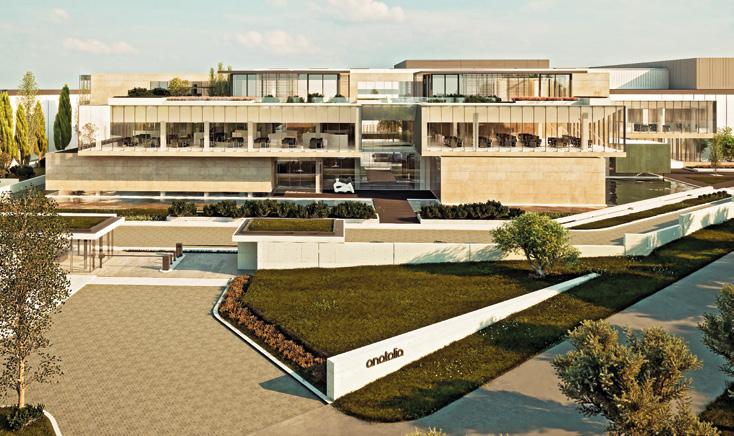
ADVERTISING world news
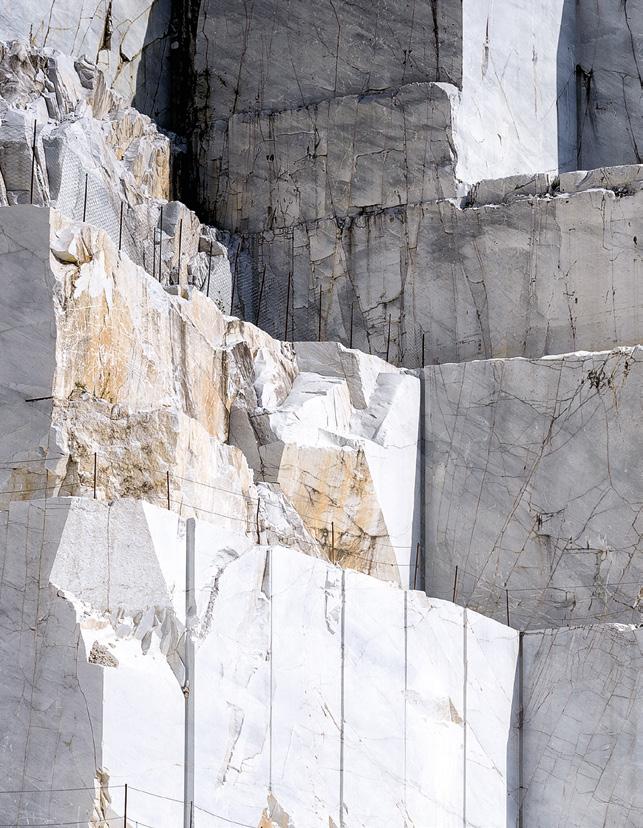
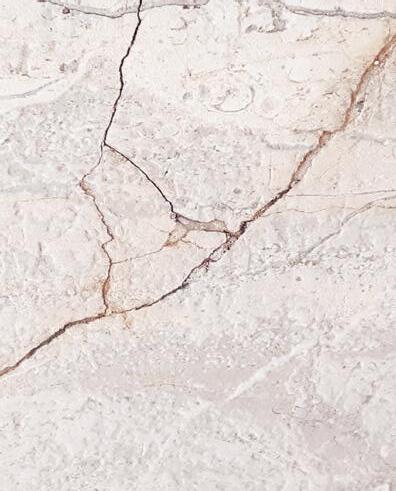

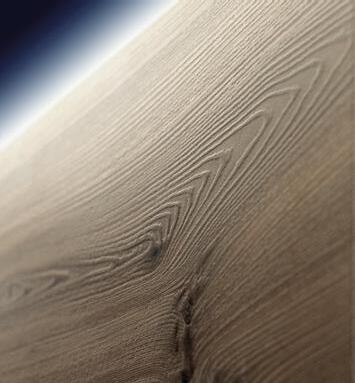

NATURALMENTE UNICA
Durst Gamma DG per la stampa digitale delle strutture ad incastro riscrive i tradizionali processi produttivi.
DURST THE INNOVATION LEADER IN CERAMICS
durst-group.com/it/ceramics
> Irripetibilità
> Unicità
> Sostenibilità
> Naturalezza delle texture
> Tridemensionalità
> Matericità
CLEON CAPITAL ACQUIRES STAKE IN ABK GROUP
On 17 October, ABK Group of Finale Emilia (Modena) announced that Cleon Capital Advisors has joined the company’s ownership group with a minority shareholding of €45 million, most of it in the form of a capital increase.
This partnership with Cleon, an independent investment and consulting company based in Spain, will allow the Italian ceramic group to capitalise on the investments it has made in recent years by accelerating and expanding growth opportunities with speed and flexibility
“Together with Cleon, we share the goals of a new and challenging growth phase that will be overseen by the second generation of leaders who have acquired valuable experience within the company and will be supported by a skilled management team,” commented ABK Group’s founding partners Roberto Fabbri, Michelangelo Fortuna and Andrea Guidorzi “Cleon has a unique and truly flexible business model that is different from private equity funds and which we consider to be well suited to the business environment typical of many medium-sized companies like ours. In addition to financial resources, Cleon will provide a valuable network of skills and relationships. These assets are crucial for capitalising on the opportunities that the group
has been preparing for over the past few years by making significant industrial investments.”
Since 2016, ABK Group has invested more than €100 million in developing cutting-edge production technologies and in strengthening its international presence through the acquisition of French company Desvres and commercial agreements in the United States.
Further developments include the exclusive licensing agreement with Versace, the acquisition in 2023 of Target Ceramics and the development of innovative materials including the patented Cooking Surface Prime invisible induction cooktop system, the Auto-Leveling™ system, the large format WIDE slabs and the three-dimensional effect products made using Genesis technology from System Ceramics.
The Group, which generated consolidated revenues of €233 million in 2022, includes the companies and brands ABK, ABKStone, Flaviker, Materia, Gardenia Orchidea, Gardenia Slabs, 14oraitaliana, fuoriformato, Desvres Ariana and Hardkoll.
CLEON CAPITAL ENTRA IN ABK GROUP
Si delinea una nuova fase di sviluppo per ABK Group di Finale Emilia (Modena) che il 17 ottobre ha annunciato l’ingresso di Cleon Capital Advisors nel capitale della società con una partecipazione

di minoranza pari a 45 milioni di euro, per la maggior parte in aumento di capitale.
La partnership con Cleon - società indipendente d’investimento e consulenza con sede in Spagna - consentirà al gruppo ceramico italiano di capitalizzare gli investimenti effettuati negli ultimi anni accelerando e ampliando le opportunità di crescita con velocità e flessibilità.
“Insieme a Cleon, abbiamo condiviso gli obiettivi di una nuova e sfidante fase di crescita che sarà guidata dalla seconda generazione, da tempo in azienda, con il supporto di un management team qualificato”, hanno commentato i soci fondatori di ABK Group, Roberto Fabbri, Michelangelo Fortuna e Andrea Guidorzi “Cleon ha un modello di business veramente flessibile e unico, diverso dai fondi di private equity e, a nostro avviso, adatto ad un contesto imprenditoriale che caratterizza molte aziende di medie dimensioni come la nostra. Oltre alle risorse finanziarie, Cleon apporterà un network di competenze e relazioni fondamentali per
cogliere le opportunità alle quali il gruppo si è preparato negli ultimi anni con significativi investimenti industriali”. Dal 2016 ad oggi, infatti, ABK Group ha investito oltre 100 milioni di euro nello sviluppo di tecnologie produttive all’avanguardia e nel rafforzamento della presenza internazionale con l’acquisizione della francese Desvres e con accordi commerciali negli Stati Uniti. A questo si aggiungono l’accordo di licenza in esclusiva con Versace, l’acquisizione nel 2023 di Target Ceramics e lo sviluppo di materiali innovativi tra cui il sistema brevettato per i piani cucina a induzione invisibile Cooking Surface Prime, il sistema Auto-Leveling™, le lastre WIDE di grande formato e i prodotti con effetto tridimensionale realizzate con la tecnologia Genesis di System Ceramics. Al Gruppo, che nel 2022 ha raggiunto un fatturato consolidato di 233 milioni di Euro, fanno capo le aziende e i marchi ABK, ABKStone, Flaviker, Materia, Gardenia Orchidea, Gardenia Slabs, 14oraitaliana, fuoriformato, Desvres Ariana e Hardkoll.
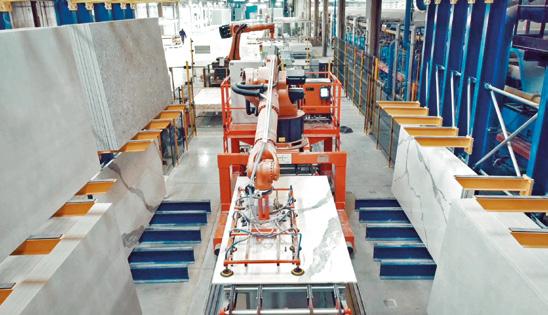

18 CWR 154/2023
world news
THE MAGIC OF EVOLUTION
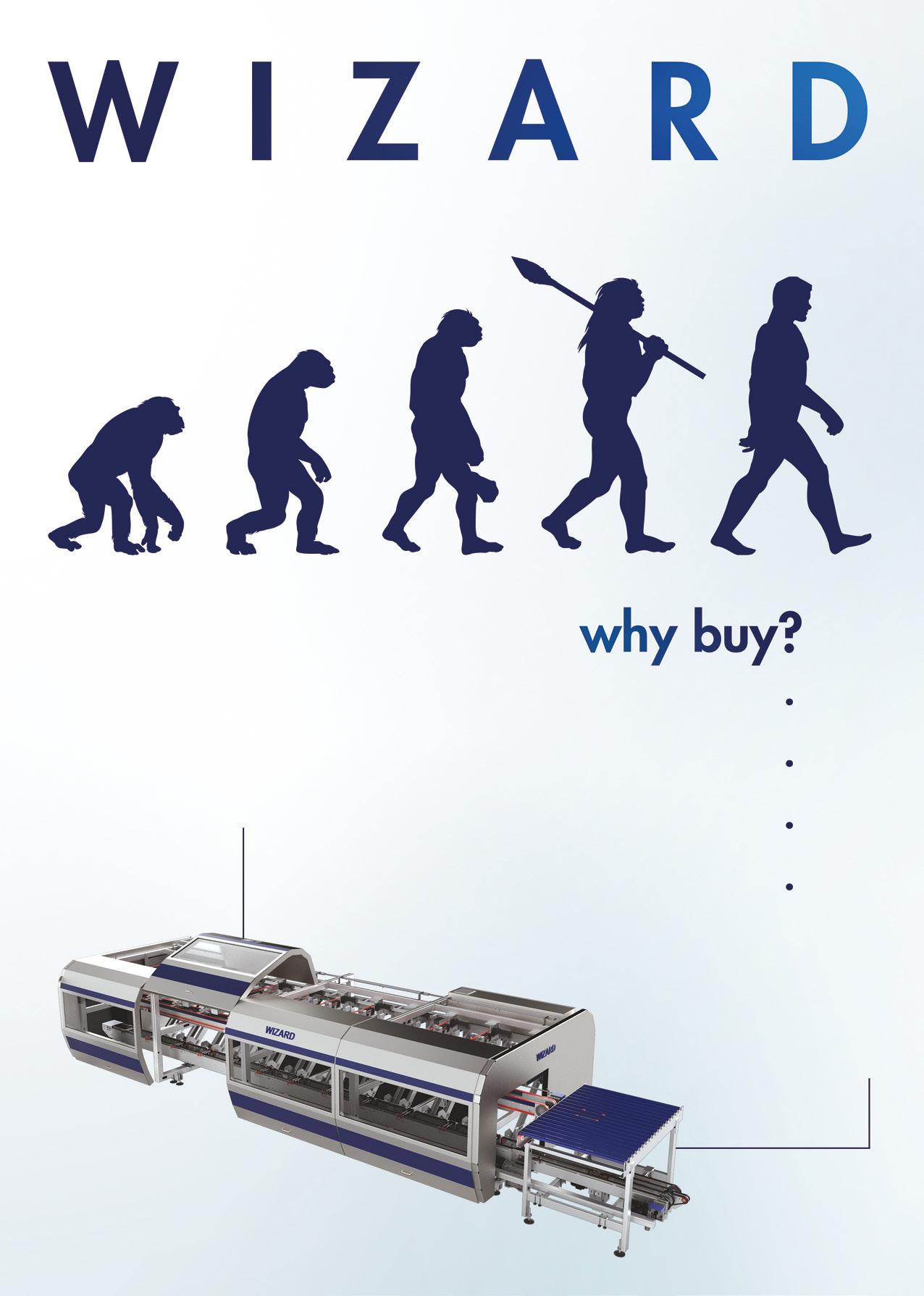
the innovative stacking machine for traditional and big size ceramic tiles
SINGLE SIDE ARCHITECTURE: LESS SPACE
LESS MOVEMENTS: HIGH PRODUCTIVITY
GREAT ACCESSIBILITY FOR THE OPERATOR SMOOTH PLACEMENT OVER THE CHAIN
complete the line with MAGISTER Packaging Unit
FLORIM LAUNCHES THE “CARBONZERO-” PROJECT
In keeping with its strategy to reduce the impact of its business activities, Florim, a B Corp certified company since 2020, is presenting “CarbonZero-”, a project for Climate Positive surfaces that neutralise the CO2 emissions generated by their production process and life cycle. “CarbonZero-” products go beyond zero environmental impact because Florim adds a further 10% in terms of emissions reduction by purchasing certified carbon credits deriving from renewable energy projects in developing countries.
The decision to voluntarily offset product emissions concerns all new collections launched by the Italian ceramic group from 2023 onwards. These include products displayed in the Florim Gallery during the September event “The Beauty of Regeneration”, i.e. Essential Mood, Eccentric Luxe, Biotech, Coretech and Stone Life, which derive from cutting-edge technology and constant innovation and research into the aesthetic qualities and technical performance of products.
The “CarbonZero-” initiative is a tangible effort to combat overexploitation of natural resources and to make the production process 100% sustainable in terms of water, electricity and waste recovery. Florim has backed up its dedication to these issues by making significant investments, as documented in its Sustaina-
GMM CELEBRATES 50 YEARS
Gmm Group, a longstanding Fiorano Modenese-based company specialising in the distribution of mechanical components and the provision of industrial services for the ceramic sector, celebrated its 50th anniversary on 15 September in the prestigious setting of
bility Report since 2008. In addition, the company celebrated 12 years of clean energy on 11 October this year. It installed its first photovoltaic system at the site in Fiorano Modenese back in 2011, then gradually expanded its photovoltaic capacity over the years to reach a total of 64,000 square metres of panels (12.3 MWp) at the sites in Fiorano and Mordano, thereby avoiding the emission of almost 20,000 tonnes of CO2.
The company has also made other significant environmental investments that have resulted in total emission savings of almost 130,000 tonnes of CO2. Florim’s green credentials are recognised by numerous awards, including the recent Sustainability Award promoted by Kon Group together with Elite and Azimut Area 4. Evaluated on the basis of ESG rating, Florim achieved the highest score in the Top 100 Environmental category among all candidate companies with revenues in excess of €250 million.
FLORIM LANCIA IL PROGETTO “CARBONZERO-”
In linea con la strategia tesa a ridurre l’impatto generato dalla propria attività, Florim, certificata B Corp dal 2020, presenta “CarbonZero-”, il progetto di superfici “Climate Positive” che neutralizzano le emissioni di CO2 generate dalla loro produzione e dal loro ciclo di vita andando oltre l’impatto zero. I prodotti “CarbonZero-”, infatti,
Villa Coccapani, welcoming more than 200 people including suppliers, customers and employees. Gmm’s history dates back to 1973 and stands as a testament to successful entrepreneurship, determination and long-term vision.
Founded by the barely 20-yearold Attilio Milani, over the years the entire family has contributed to the company’s strategic
creano un impatto positivo sull’ambiente poiché l’azienda aggiunge il 10% attraverso l’acquisto di crediti di carbonio certificati derivanti da progetti di energia rinnovabile in paesi in via di sviluppo.
La decisione di compensare volontariamente le emissioni dei prodotti riguarda tutte le nuove collezioni lanciate dal 2023 dal gruppo ceramico italiano. Tra queste, anche i materiali presentati alla Florim Gallery durante l’evento di settembre “The Beauty of Regeneration”, ossia Essential Mood, Eccentric Luxe, Biotech, Coretech e Stone Life, frutto del più avanzato know-how tecnologico e della costante attività di ricerca e innovazione in termini di resa estetica e performance tecniche.
Il progetto “CarbonZero-” rappresenta un ulteriore sforzo per contrastare l’eccessivo sfruttamento delle risorse naturali e rendere il processo produttivo sostenibile al 100% sul fronte idrico, di energia elettrica e recupero degli scarti. Una sensibilità che è nel DNA di Florim e che trova riscontro negli

growth based on the development of new areas of expertise and a constantly expanding portfolio of services. The group has made a number of acquisitions, including BBM Industrial Maintenance, specialising in tailor-made maintenance services and predictive maintenance activities, and Elettromeccanica Malaguti, focusing on industrial revamping.
importanti investimenti riportati nel Bilancio di Sostenibilità pubblicato ormai dal 2008.
Lo scorso 11 ottobre, peraltro, l’azienda ha festeggiato i 12 anni di energia pulita: il primo impianto fotovoltaico fu infatti installato nel 2011 nella sede di Fiorano Modenese, implementato poi negli anni fino a raggiungere i 64.000 mq di pannelli (12,3 MWp complessivi) tra le sedi di Fiorano e Mordano, che hanno evitato l’emissione di quasi 20.000 tonnellate di CO2. A questi si aggiungono altri importanti investimenti in ambito ambientale che hanno portato complessivamente ad una mancata emissione di quasi 130.000 tonnellate di CO2. Un percorso virtuoso, riconosciuto anche da numerosi premi assegnati a Florim, tra cui il recente Sustainability Award promosso da Kon Group insieme a Elite e Azimut Area
4. Valutate le perfomance in base al rating ESG, Florim ha ottenuto il punteggio più alto nella categoria “Top 100 Environmental” tra le imprese candidate con fatturato superiore a 250 milioni di euro.

Another important step was the opening of Gmm USA, the US subsidiary located in Clarksville, Tennessee.
Today, the group has a young workforce (the 50 employees have an average age of 35) with a high degree of specialisation in the ceramic sector. One of its top priorities is to continue to innovate industrial processes through
20 CWR 154/2023
digital and sustainable solutions, with a portfolio that includes the supply of high quality components and systems designed for energy efficiency, condition monitoring services and energy audits, as well as remanufacturing of electromechanical components based on the principles of the circular economy.
During the evening, founder Attilio Milani (pictured with his son Luca) expressed his pride and gratitude for everything the group has achieved while looking to the future with confidence and enthusiasm. “Fifty years of innovation and growth are just the beginning. The Gmm Group will continue to lead the industry towards new horizons of sustainability and success,” he said.
I 50 ANNI DI GMM
Gmm Group, storica azienda di Fiorano Modenese, leader nella distribuzione di componenti mecca-
nici e fornitura di servizi industriali per il settore ceramico, lo scorso 15 settembre ha festeggiato il suo 50° compleanno presso la prestigiosa cornice di Villa Coccapani, accogliendo oltre 200 persone, tra fornitori, clienti e collaboratori. La storia di Gmm, iniziata nel lontano 1973, è una testimonianza di imprenditoria di successo, determinazione e lungimiranza. Fondata dall’appena vent’enne Attilio Milani, negli anni l’intera famiglia ha contribuito ad una importante crescita strategica, resa possibile dallo sviluppo di nuove competenze e da un portafoglio di servizi cresciuto grazie a varie acquisizioni, tra cui BBM Industrial Maintenance, specializzata nei servizi manutentivi taylor-made e nelle attività di manutenzione predittiva, ed Elettromeccanica Malaguti, focalizzata sul revamping industriale. Importante anche l’apertura di Gmm USA, la filiale statunitense situata a Clarksville, nel Tennessee. Oggi il gruppo può contare
su una squadra giovane (i 50 addetti hanno un’età media di 35 anni) con una particolare specializzazione nel settore ceramico. Tra le sue priorità, continuare ad innovare i processi industriali attraverso soluzioni digitali e sostenibili con un’offerta che spazia dalla fornitura di componenti di alta qualità e impianti progettati per l’efficientamento energetico, ai servizi di condition monitoring ed audit energetici, fino alla rigenerazione di com-
ponenti elettromeccanici secondo i principi dell’economia circolare. Durante la serata, il fondatore Attilio Milani (nella foto con il figlio Luca) ha espresso orgoglio e riconoscenza per il cammino percorso, guardando già al futuro con fiducia ed entusiasmo: “Cinquant’anni di innovazione e crescita sono solo l’inizio. Il Gruppo Gmm continuerà a guidare il settore verso nuovi orizzonti di sostenibilità e successo”, ha dichiarato.
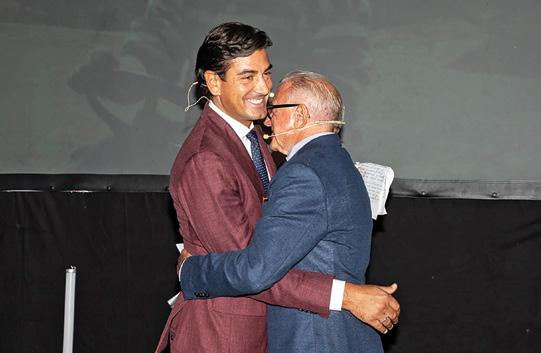



world news
ADVERTISING
GRUPPO B&T LOOKS TO A GREENER FUTURE
Gruppo B&T of Formigine is looking ahead to a more sustainable future with zero emissions from fossil fuels. Over the years, the group has adopted a policy of continuous investment and launched new solutions onto the market, enabling it to establish its credibility and gain a strong position in international markets. In particular, it has focused on energy saving and the efficiency of machines and plants and now intends to step up the pace of development of its green technologies, with special emphasis on kilns and dryers.
In this new research phase, the group led by Fabio Tarozzi will have access to a €10 million loan provided by BNL BNP Paribas and backed by SACE’s 80% Green Guarantee, a 7-year credit line which will contribute to the development of new engineering solutions for reducing greenhouse gas emissions through the use of hydrogen.
Fabio Tarozzi, the group’s Chairman and CEO, commented:
“This important funding confirms the financial sector’s confidence in our Group’s strategy of promoting sustainable production systems. We will increasingly place the environment at the heart of our development process.”
To emphasise its commitment to sustainability, Gruppo B&T organised a thought-provoking event entitled “bt-GREENThe Voice of the District” on 20 October at bt-Space. The event brought together representatives of institutions, businesses and associations to discuss the topic of the ecological transition in the light of European legislation mandating emissions reductions by 2030. The following took part in the two panel discussions: Stefano Bonaccini (Emilia-Romagna regional governor), Elisabetta
Gualmini (Chair of the European Parliament Ceramics Forum), Michele Barcaiuolo (Senator), Giovanni Savorani (Chairman of Confindustria Ceramica), Paolo Lamberti (Chairman of Acimac), Alessandro Bianchini (Technical Director of Gruppo B&T), Franco Manfredini (Chairman of Casalgrande Padana), Andrea Ronchi (CEO CO2 Advisor of Principal Aramix-Datrix Group), Armando Meletti (Country Manager Italia at Altadia Group) and Marcello Romagnoli (Professor at the University of Modena and Reggio Emilia and Director of the MO.RE. H2 Research Centre).
A number of key issues emerged during the debate, including the need to create adequate infrastructures, to train specialised personnel to support the green industrial revolution and to prevent the race towards sustainability from becoming a cause of inequality by penalising companies like the Italian tile producers – particularly those located in the Sassuolo ceramic district – who have been adopting virtuous environmental practices for years.
“The machinery manufacturers are ready for this huge leap forward. The technologies already exist, what is lacking is the time and infrastructure for their implementation. At Gruppo B&T, we believe in hydrogen technology for thermal processes and are investing in this fuel because we are firmly convinced that it represents the future direction for the industry,” concluded Fabio Tarozzi
GRUPPO B&T SEMPRE PIÙ “GREEN”
Il Gruppo B&T di Formigine punta con sempre maggior decisione verso un futuro più sostenibile e a zero emissioni da combustibili fossili. Attraverso una politica di investimenti continui e lancio sul mercato di nuove soluzioni, l’azienda ha costruito ne-
gli anni la sua credibilità e forza nei mercati internazionali lavorando proprio sui temi dell’energy saving e dell’efficienza delle macchine e degli impianti. Ora l’intento è di accelerare lo sviluppo delle proprie tecnologie green concentrandosi in particolare sulle macchine termiche.
In questa nuova fase di ricerche, il gruppo guidato da Fabio Tarozzi potrà contare su un finanziamento di 10 milioni di euro erogato da BNL BNP Paribas e assistito dalla Garanzia Green di SACE all’80%: una linea di credito della durata di 7 anni, che contribuirà al raggiungimento di obiettivi di sviluppo di nuove soluzioni ingegneristiche per la riduzione dei gas serra mediante l’utilizzo dell’idrogeno. Per Tarozzi, Presidente e Amministratore delegato del gruppo, “questo importante finanziamento conferma la fiducia del sistema finanziario nella strategia del nostro Gruppo, finalizzata a promuovere un’offerta di sistemi produttivi sostenibili. Intendiamo mettere le tematiche ambientali sempre di più al centro del nostro sviluppo”. A sottolineare il proprio impegno e l’attenzione verso la sostenibilità, il Gruppo B&T si è fatto promotore di un interessante evento – “bt-GREEN - La voce del Distretto” – organizzato lo scorso 20 ottobre presso il bt-Space, dove ha riunito il mondo istituzionale, imprenditoriale e associativo per approfondire il tema della transizione ecologica alla luce della normativa europea che impone di ridurre le emissioni entro il
2030. Ad intervenire nelle due tavole rotonde: il Presidente della Regione Emilia-Romagna Stefano Bonaccini, la Presidente del Forum Europeo della Ceramica Elisabetta Gualmini, il Senatore Michele Barcaiuolo, Giovanni Savorani (Presidente di Confindustria Ceramica) e Paolo Lamberti (Presidente Acimac), Alessandro Bianchini (Direttore Tecnico di Gruppo B&T), Franco Manfredini (Presidente di Casalgrande Padana); Andrea Ronchi (CEO CO2 Advisor di Principal Aramix-Datrix Group), Armando Meletti (Country Manager Italia di Altadia Group) e Marcello Romagnoli (Professore dell’Università di Modena e Reggio Emilia e Direttore del Centro Ricerca H2 MO.RE.
Tra i punti emersi dal dibattito, la necessità di creare infrastrutture adeguate, formare il personale specializzato per sostenere la “rivoluzione industriale green” ed evitare che la corsa verso la sostenibilità si trasformi in una forbice generatrice di disuguaglianza, penalizzando chi, come l’Italia e in particolare il Distretto Ceramico, adotta da anni comportamenti virtuosi in questo senso. “I costruttori di macchine sono pronti per questo grande cambiamento, le tecnologie esistono già, mancano però tempo e infrastrutture. Come Gruppo B&T crediamo nella tecnologia ad idrogeno per i processi termici e stiamo investendo in questo senso perché siamo convinti che questa sia la strada”, ha concluso Fabio Tarozzi
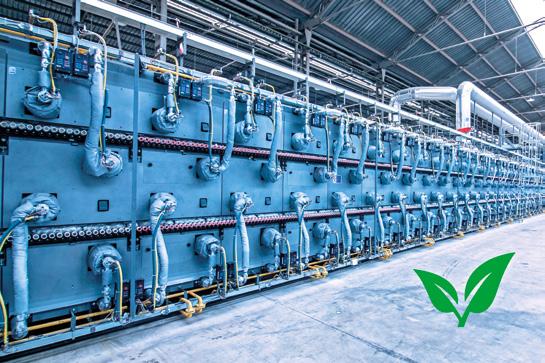
22 CWR 154/2023 world news






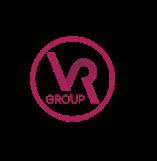
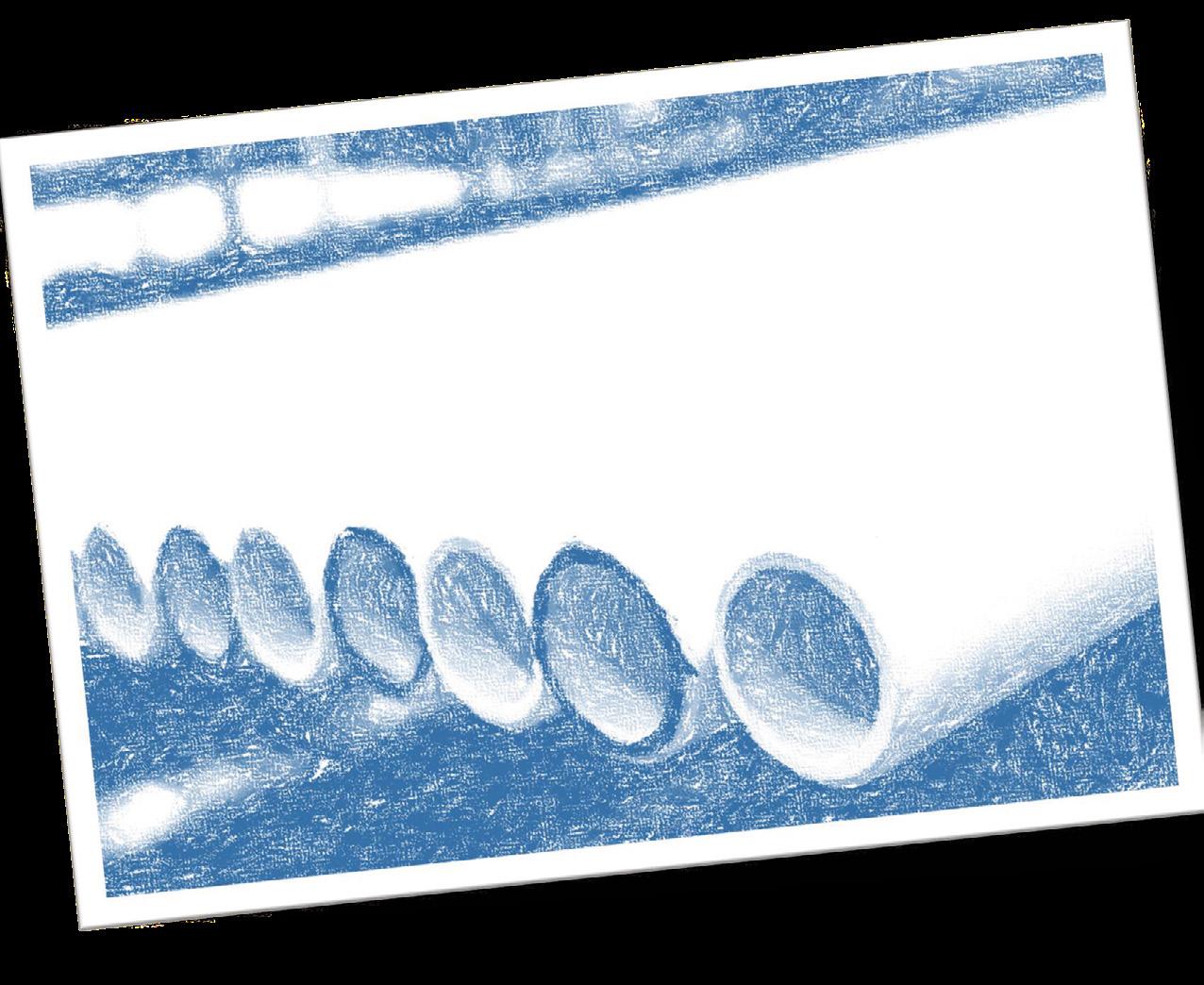
ITALCER BECOMES A BENEFIT CORPORATION AND INVESTS IN SMALL TILE SIZES
Italcer, one of Italy’s leading manufacturers of ceramic floor and wall tiles and bathroom furnishings, announced a new acquisition on 31 October, conducted through its Spanish subsidiary.
Equipe Cerámicas has acquired a 20% stake in Opificio Ceramico along with a call option for the majority shareholding.
Opificio Ceramico is a young Modena-based company specialising in luxury ceramic surfaces, with a focus on small handcrafted sizes and bespoke products.
The company was founded in 2018 by Emanuele Marcato, who embarked on a project centred around sustainable craftsmanship with the aim of delivering truly tailor-made products.
This operation marks the ninth acquisition completed in six years by the group helmed by Graziano Verdi (along with major shareholders Mindful Capital Partners, Miura and Capital Dynamics), following La Fabbrica-AVA, Elios, Devon&Devon, Rondine, Equipe Ceramicas, Fondovalle and Terratinta Group.
“Opificio Ceramico is becoming well established itself in the market thanks to its unique products that align perfectly with our sustainable production philosophy,” said Graziano Verdi “This deal solidifies our ambition to create
CLEAN ENERGY: CEFLA LAUNCHES NOVA
Last October, Cefla unveiled Europe’s first fuel cell cogeneration plant at its Imola facility, a project developed in partnership with the American company Bloom Energy. The system, named NOVA, stands out for its use of solid oxide technology in a combined heat and power (CHP) configuration, ensuring the generation of both electric-
an Italian design hub composed of high-end ceramic companies and generating significant synergies both in Italy and abroad.”
With projected 2023 revenues close to €400 million, the Italcer Group confirms its position as a leading international player in the ceramic industry with a strong commitment to sustainability. Confirming its focus on ESG, the company recently became a Benefit Corporation. Its goals, enshrined in its articles of incorporation, include reducing the greenhouse gas emissions deriving from its operations, enhancing energy efficiency through the use of renewable energy sources such as photovoltaic systems, pursuing ongoing product innovation, increasing the use of recycled materials (already higher than 50%) as part of a circular economy philosophy, and implementing corporate and community welfare policies for its employees.
In the last two years, Italcer has invested more than €20 million in sustainable innovation and each year consistently allocates more than 3% of its revenues to research and development.
ITALCER DIVENTA SOCIETÀ BENEFIT E INVESTE ANCHE SUI PICCOLI FORMATI
Italcer, tra i leader italiani nel settore delle pavimentazioni e dei rivestimenti in ceramica e dell’arredo bagno, ha annunciato lo scorso
ity and thermal energy. Furthermore, in the presence of an absorber, NOVA is also capable of generating cooling energy. Fuel cell technology is 25% more efficient than an endothermic source (engines or turbines) for the same power. Fuel cell technology maintains an electrical efficiency of 54% over its entire life cycle, ensuring better control over operational costs.
“Cefla’s goal is to encourage active discussion about decarboni-
31 ottobre una nuova operazione, condotta tramite la sua consociata spagnola. Equipe Ceràmicas ha infatti acquisito il 20% delle quote di Opificio Ceramico, concordando già un’opzione call per l’acquisizione della maggioranza.
Opificio Ceramico è una giovane realtà modenese specializzata in superfici ceramiche di lusso, con particolare attenzione ai piccoli formati artigianali e ai prodotti su misura. L’azienda è nata nel 2018 su iniziativa di Emanuele Marcato che ha data vita ad un progetto basato sull’artigianalità sostenibile per creare veri e propri manufatti ‘tailor-made’.
Per il gruppo guidato da Graziano Verdi (con Mindful Capital Partners, Miura e Capital Dynamics come soci di riferimento), si tratta della nona operazione realizzata in 6 anni, dopo La Fabbrica-AVA, Elios, Devon&Devon, Rondine, Equipe Ceramicas, Fondovalle e Terratinta Group.
“Opificio Ceramico si sta affermando sul mercato grazie a prodotti unici che si sposano perfettamente con la nostra filosofia produttiva sostenibile”, ha affermato Graziano Verdi “Con questa operazione confermiamo la nostra volontà di creare un hub italiano di design composto da aziende ceramiche alto di gamma attivando significative sinergie sia in Italia che all’estero”. Con una proiezione di fat-
turato per il 2023 che si avvicina ai 400 milioni di euro, il Gruppo Italcer si conferma uno dei principali player internazionali nel settore ceramico, e tra i più sensibili e attivi in tema di sostenibilità. A conferma dell’impegno in ambito ESG, l’azienda è recentemente diventata Società Benefit. I suoi obiettivi, inseriti in statuto, riguardano la riduzione delle emissioni di gas climalteranti nei processi aziendali, l’efficientamento energetico attraverso l’impiego di fonti rinnovabili come gli impianti fotovoltaici, la costante innovazione di prodotto con impiego sempre maggiore di materiali riciclati (già oggi oltre il 50%) a beneficio di un’economia circolare, nonché l’attuazione di politiche di welfare aziendale e territoriale a vantaggio dei propri dipendenti. Nell’ultimo biennio Italcer ha investito oltre 20 milioni di euro in innovazione sostenibile e ogni anno destina oltre il 3% dei ricavi in ricerca e sviluppo.

sation, focusing on reducing carbon footprints,” explains Chairman Gianmaria Balducci “The first step involves helping companies and large infrastructures to achieve greater efficiency. The partnership with Bloom Energy, a leader in this innovative technology, has enabled us to develop a comprehensive solution incorporating heat recovery.” The collaboration between Cefla and Bloom Energy broadens the range of clean energy options
accessible to Italian companies, assisting them in their transition towards sustainable energy. This technology makes it possible to transform various sources (hydrogen, natural gas and green fuels such as biogas and biomethane) into electrical energy without involving combustion, thereby reducing or completely eliminating CO2 emissions, but above all eliminating harmful particles such as NOx, SOx and CO.
24 CWR 154/2023
ENERGIA PULITA: CEFLA LANCIA NOVA
Lo scorso ottobre, presso lo stabilimento di Imola, Cefla ha inaugurato il primo impianto di cogenerazione a fuel cell installato in Europa, risultato della collaborazione con l’americana Bloom Energy. Si chiama NOVA e la sua peculiarità consiste nell’applicazione della tecnologia ad ossidi solidi in versione CHP, che garantisce anche la produzione di energia ter-
mica, in aggiunta all’energia elettrica. Inoltre, in presenza di un assorbitore, NOVA è in grado di produrre anche il ‘freddo’, quindi energia frigorifera.
La tecnologia delle fuel cell supera del 25% l’efficienza di una fonte endotermica (motori o turbine) a parità di potenza. Garantisce inoltre un grado di efficienza elettrica pari al 54% durante tutto il suo ciclo di vita e quindi un maggiore controllo sul conto economico. “Cefla si pone l’obiettivo di stimo-
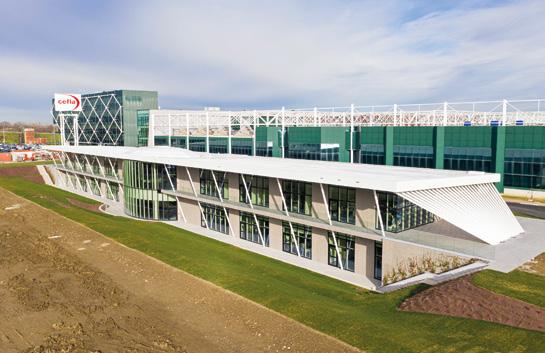
lare una discussione attiva sui temi della decarbonizzazione al fine di ridurre l’impronta carbonica e il primo passo è aiutare le aziende, così come le grandi infrastrutture, a generare efficienza”, spiega il presidente Gianmaria Balducci. “Il sodalizio con Bloom Energy, leader nello sviluppo di questa innovativa tecnologia, ci ha permesso di sviluppare la soluzione completa con recupero termico”. La partnership tra Cefla e Bloom Energy amplia l’offerta di energia
pulita a disposizione delle aziende italiane, supportandole nel percorso verso la transizione energetica. Questa tecnologia permette, infatti, di trasformare diverse fonti (idrogeno, gas naturale e combustibili green come il biogas e il biometano) in energia elettrica senza che avvenga combustione, consentendo quindi di ridurre o azzerare le emissioni di CO2, ma soprattutto di eliminare la presenza di particelle nocive dannose per l’uomo, quali NOx, SOx, CO.


world news
ADVERTISING
GRUPO LAMOSA PENALISED BY CONSTRUCTION SLOWDOWN
Following two years of sustained growth, Grupo Lamosa’s third quarter 2023 results reflect the normalisation of market demand. Mexico’s largest ceramic group reported an 11% decline in sales revenues in the first nine months of the year compared to the same period in 2022 to MXN 23.82 billion (about €1.3 billion). Domestic sales accounted for 62% of total revenues and saw a smaller contraction, dropping by 5% to MXN 14.66 billion (about €784 million). Foreign sales suffered a more significant decline, dropping by 20% to MXN 9.16 billion (about €496 million), although this was still higher than 2021 levels.
Of the two divisions through which Grupo Lamosa operates, the floor and wall tiles segment was hardest hit with a 16% decline in sales to MXN 16.91 billion (about €915.5 million), equivalent to 71% of the group’s total sales. This reduction was caused by weaker demand in both the new home construction and remodelling segments, not just in Mexico but also in foreign markets. By contrast, the Adhesives business made gains, with sales of MXN 6.9 billion (3% higher than in the first nine months of 2022).
Overall, EBITDA declined by 19%, with EBITDA margin at 21% of sales.
Despite the negative trend, Lamosa continued its investment programme with total investments in the first nine months of the year
amounting to MXN 1.99 billion (about €106 million), which went primarily on keeping its production plants and IT platforms up to date.
On the subject of investments, shortly before Cersaie 2023 the Mexican group announced the acquisition of the Spanish ceramic company Baldocer (brands Baldocer, Azulejos Benadresa (AB) and ETILE), a deal that was finalised on 31 October. The value of the acquisition was €425 million, with no less than €71 million to be paid as a balance in 2025 according to the company’s results.
This acquisition marks an important step forward in Grupo Lamosa’s growth strategy, enabling it to strengthen its presence in the European continent (where it has been operating with Roca Tile since 2021) and increase its share of high-end products worldwide.
Baldocer exports its products to more than 120 countries around the world and reported an EBITDA of €67 million in 2022.
According to forecasts, the acquisition of Baldocer will increase Grupo Lamosa’s consolidated revenues by approximately 16%. Installed production capacity will increase by 12% to approximately 275 million sqm/ year, cementing Lamosa’s position as the world’s second largest ceramic tile producer.
IL RALLENTAMENTO DELL’EDILIZIA PENALIZZA GRUPO LAMOSA
Dopo un biennio di crescita sostenuta, i risultati del terzo trime-

stre 2023 di Grupo Lamosa confermano la normalizzazione della domanda del mercato. Nei primi nove mesi dell’anno, i ricavi del maggiore gruppo ceramico messicano sono calati dell’11% rispetto allo stesso periodo del 2022, fermandosi a 23,82 miliardi di Pesos Messicani (circa 1,3 miliardi di Euro). Sul mercato nazionale, che rappresenta il 62% del fatturato totale, la flessione è stata più contenuta: le vendite sono scese a 14,66 miliardi di Pesos (circa 784 milioni di Euro) perdendo il 5%. Più pesante la contrazione dei ricavi all’estero, -20%, pari a 9,16 miliardi di Pesos (circa 496 milioni di Euro), comunque superiori ai livelli 2021.
Tra le due divisioni in cui opera Grupo Lamosa, a subire i contraccolpi maggiori è stato il segmento Piastrelle, dove le vendite sono calate del 16% a 16,91 miliardi di Pesos (circa 915,5 milioni di Euro), pari al 71% dei ricavi totali del gruppo: il risultato negativo è stato determinato dalla minore domanda sia nel comparto dell’edilizia nuova sia in quello delle ristrutturazioni, e sia sul mercato nazionale che all’estero. Al contrario, la divisione Adesivi ha guadagnato terreno con vendite pari a 6,9 miliardi di Pesos (+3% rispetto ai nove mesi del 2022).
Complessivamente, l’Ebitda è calato del 19%, con un margine sui ricavi pari al 21%.
Nonostante l’andamento negativo, Lamosa ha portato avanti il
suo piano di investimenti per un valore totale, nei 9 mesi, di 1,99 miliardi di Pesos (circa 106 milioni di Euro), destinati per lo più all’ammodernamento tecnologico degli impianti e delle piattaforme IT.
Restando in tema di investimenti, alla vigilia di Cersaie 2023 il gruppo messicano ha annunciato l’acquisizione dell’azienda ceramica spagnola Baldocer (marchi Baldocer, Azulejos Benadresa (AB) ed ETILE), operazione che è stata perfezionata il 31 ottobre. Il valore dell’acquisizione è pari a 425 milioni di euro, di cui non meno di 71 milioni (basati sui risultati dell’azienda) da versare a saldo nel 2025.
Per Grupo Lamosa questa operazione contribuirà, da un lato, a rafforzare la posizione in Europa, dove, sempre in Spagna, opera con Roca Tile dal 2021, e, dall’altro, ad aumentare la quota di prodotti di fascia alta commercializzati sui mercati internazionali. Baldocer, che esporta in oltre 120 paesi nel mondo, ha generato un Ebitda pari a 67 milioni di euro nel 2022. In base alle previsioni, l’incorporazione di Baldocer si tradurrà per il gruppo messicano in un incremento di circa il 16% del fatturato consolidato: la capacità produttiva installata crescerà del 12% a circa 275 milioni mq/anno, rafforzando Lamosa come secondo maggiore produttore mondiale di piastrelle ceramiche.

26 CWR 154/2023 world news

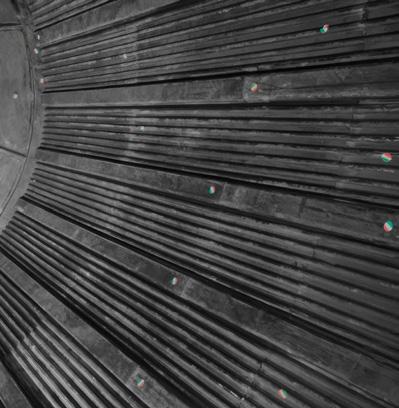



GEBERIT REPORTS DECLINE IN VOLUMES BUT INCREASE IN PROFITABILITY
Considering the extraordinarily difficult environment with declining building construction in Europe, the Geberit Group posted better-than-expected results in the first three quarters of 2023. Although volumes declined significantly from the record levels of 2022 (CHF 2,390 million, a decrease of 12.3% or 7.9% after currency adjustments), profitability increased. This was made possible above all thanks to high operational flexibility, lower energy prices and selling price increases (+10%), which partly offset the decline in volumes. EBITDA fell by 2.4% to CHF 749 million (+4% after currency adjustments), while EBITDA margin rose from 28.1% to 31.3%. Net income declined by 4.6% to CHF 516 million (currency-adjusted +2.1%).
Currency-adjusted net sales in Europe decreased by 9.2% overall after nine months. Italy and Western Europe (United Kingdom/Ireland, France, Iberian Peninsula) were
POPPI CLEMENTINO CONCLUDES A SUCCESSFUL 2023
2023 was a busy and successful year for Poppi Clementino, the Reggio Emilia-based company specialising in energy saving and recovery systems for the ceramic industry. Despite the market slowdown, the company met its annual targets and is already busy with orders for 2024. The company’s strong business performance has also prompted it to invest in expansion in Asia. In addition to the new sales office opened in the Foshan ceramic district, it has also strengthened its sales networks across a number of Asian markets, with an internal staff member maintaining a constant presence in the area. In November, Poppi Clementino
slightly down on the previous year with -1.1% and -1.4%, respectively. In contrast, Benelux (-3.8%), Switzerland (-5.8%) and Northern Europe (-7.5%) sustained more pronounced declines. Double-digit decreases were recorded in Austria (-12.5%), Germany (-13.4%) and Eastern Europe (-18.0%). Net sales declined further in the Far East/Pacific region (-4.7%) and in America (-1.3%), whereas the Middle East/Africa region posted growth (+11.5%).
In the product areas, currency-adjusted net sales decreased by 5.4% in Piping Systems, by 7.9% in Bathroom Systems and by 10.1% in Installation and Flushing Systems. For 2023 as a whole, Geberit expects a decline in net sales of around 5% in local currencies and an EBITDA margin of 29% to 30%.
GEBERIT: RICAVI IN CALO, MIGLIORA LA REDDITIVITÀ
Considerato il contesto particolarmente difficile, soprattutto per la contrazione dell’edilizia in Europa, il Gruppo Geberit ha chiuso i primi 9 mesi del 2023 con risultati migliori
also took part in the exhibitions ASEAN Ceramics in Vietnam and Unicera in Turkey and showcased its technologies at the Latech event organised by System Ceramics in Indonesia.
There have also been major changes at the headquarters, with the arrival of two highly experienced professionals in management roles in the Technical and Operations Department and the adoption of new equipment and hardware in the design department.
POPPI CLEMENTINO CHIUDE UN BUON 2023
Il 2023 è stato un anno intenso e ricco di soddisfazioni per Poppi Clementino, l’azienda di Reggio Emilia specializzata dei sistemi di risparmio e recupero energe-
rispetto alle attese. Sebbene i ricavi siano diminuiti significativamente rispetto ai livelli record del 2022 (-12,3% a 2.390 milioni di franchi svizzeri, o -7,9% al netto degli effetti valutari negativi), la redditività è migliorata. Ciò è stato possibile grazie all’elevata flessibilità operativa, alla riduzione dei costi energetici e all’incremento dei prezzi di vendita (+10%) che hanno in parte compensato il calo dei volumi. L’Ebitda è stato pari a 749 milioni di franchi (+4% al netto degli effetti valutari, o -2,4% in Franchi svizzeri) con un margine passato dal 28,1% al 31,3% sui ricavi. L’utile netto è stato pari a 516 milioni di Franchi (-4,6% o +2,1 al netto dei cambi). Nei 9 mesi, i mercati europei hanno registrato un calo complessivo del 9,2% in valute locali con l’Italia e
l’Europa Occidentale (Regno Unito/ Irlanda, Francia, Penisola Iberica) rispettivamente a -1,1% e -1,4%. Più pronunciata la flessione in Benelux (-3,8%), Svizzera (-5,8%) e in Nord Europa (-7,5%), mentre cali a doppia cifra si sono verificati in Austria (-12,5%), Germania (-13,4%) ed Europa dell’Est (-18,0%). In calo anche l’area Estremo Oriente/Pacifico (-4,7%) e l’America (-1,3%), mentre le vendite in Medio Oriente/ Africa sono cresciute dell’11,5%. L’andamento negativo dei ricavi ha riguardato tutte le tre divisioni, ossia Piping Systems (-5,4%), Bathroom Systems (-7,9%) e Installation & Flushing Systems (-10,1%). Per l’intero esercizio 2023 Geberit prevede una flessione dei ricavi di circa il 5% in valute locali e un margine Ebitda tra il 29% e il 30%.
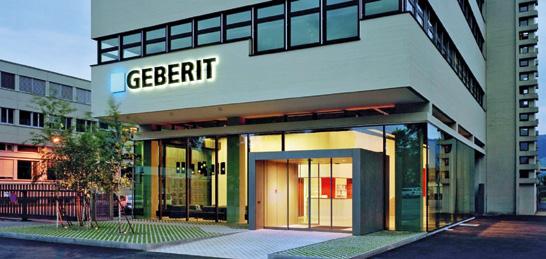
tico per l’industria ceramica. Nonostante il rallentamento del mercato, la società ha raggiunto gli obiettivi di budget ed è già impegnata sugli ordini per il 2024. Il buon andamento dell’attività ha anche spinto l’azienda ad investire sulla crescita in Asia: oltre alla nuova sede commerciale inaugurata nel distretto ceramico di Foshan, sono anche state rafforzate le reti vendite in vari mercati asiatici, con una risorsa interna dedicata a presidiare l’area in modo costante e proattivo. In novembre, Poppi Clementino ha anche partecipato alle fiere Asean Ceramics in Vietnam, e Unicera in Turchia, oltre ad aver presentato le sue tecnologie in occasione dell’evento Latech, or-
ganizzato da System Ceramics in Indonesia.
Importanti novità anche nell’headquarter, con l’ingresso nell’Ufficio Tecnico e Operativo di due professionisti di alto profilo in ruoli dirigenziali e l’adozione di nuove strumentazioni e hardware per potenziare il reparto progettazione.

28 CWR 154/2023
world news
inkjet decoration
robust, reliable and inkjet printers
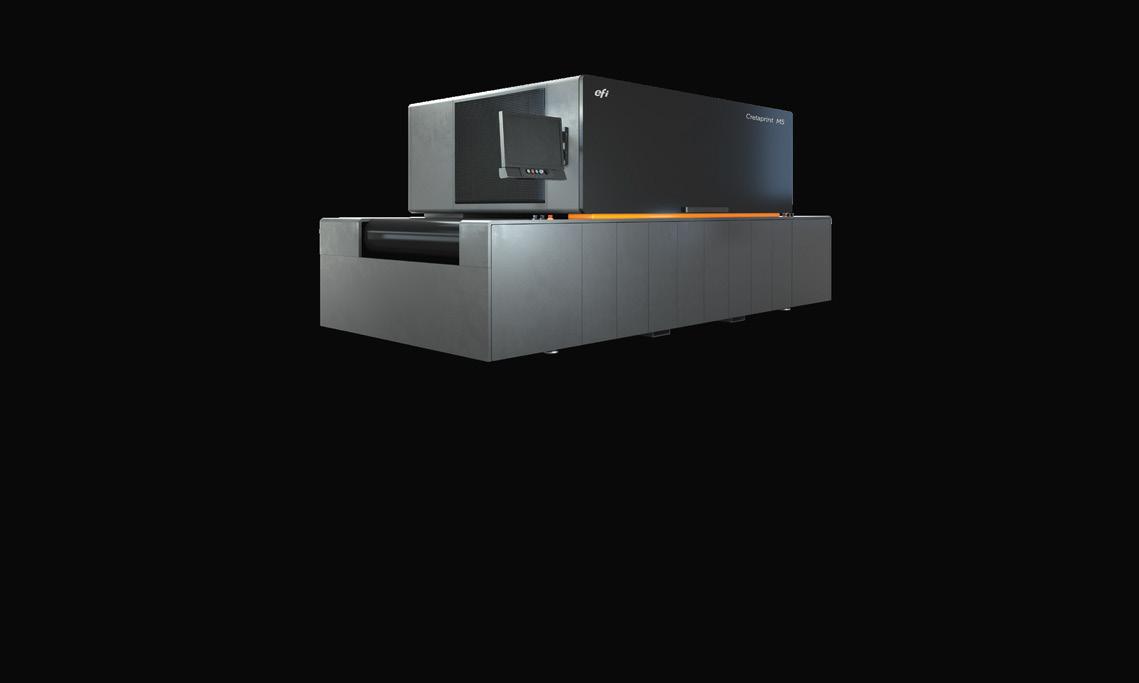
EFI Cretaprint has been in the global tile industry for 25 years with digital decoration solutions that include a wide range of inkjet printers, inks, and color management software. It is an innovative ecosystem delivering reliability and high image quality.
www.efi.com
· cretaprintsales@efi.com
CERAMICHE PIEMME TO INSTALL SECOND DURST SYSTEM
Ceramiche Piemme has announced the purchase of a second Durst Gamma DG system, the revolutionary technology for digital glazing of ceramic tiles developed by the South Tyrolean manufacturer. After testing the functionality of the Durst Gamma DG 101 model, the well-known Italian ceramic tile producer is now focusing on the Gamma DG 141 model with a wider print width for printing large size tiles. The machine will be installed in February at the ultra-modern production facility in the province of Modena, joining the other Durst technologies already adopted by the company.
“We introduced the first Durst digital printer in 2010 and our production department now has five Gamma XD series systems consisting of models 98, 108 and 148 installed on five different production lines,” explains Flavia Fiorino, Industrial Innovation Manager at Ceramiche Piemme.
“Five years ago we took the opportunity to be the first company to test the potential of the Gamma DG 101 digital glazing system with a view to experimenting with further aesthetic enhancement of our products.”
Gamma DG 101 immediately began operating in-line with one of the previously installed Durst Gamma XD systems to produce digitally printed textures in perfect alignment with the graphic designs. This enhances the three-dimensionality of the tiles, creating unprecedented visual and tactile effects. The combination of Gamma DG and Gamma XD technology has enabled Ceramiche Piemme to create four brand new product lines: Evoluta, Ibla, Journey and Limestone. Based on more than 10 years of intensive R&D work, Durst Gamma DG is capable of producing highly detailed structures on
smooth tiles, creating far more realistic material effects on the ceramic surfaces than could previously be achieved with other technologies, such as stone, marble and wood. This result is achieved thanks to Durst’s proprietary and revolutionary RockJET™ printheads, specially designed to handle ceramic glazes with the large (up to 45µm) high-viscosity particles that are needed for printing unlimited high-definition structures
“Based on our technical and manufacturing experience, the main benefit of this technology is the possibility of creating an infinite number of three-dimensional structures without altering the pressing machine but simply using a digitally applied glaze,” continues Fiorino “On an aesthetic level, Durst Gamma DG creates unique material effects that make for extremely realistic looking products.”
Alberto Bassanello, Sales Director Italy of the Durst Group, described Ceramiche Piemme’s continued trust in Durst as a source of pride as it testifies to the brand’s reliability and ability to innovate and confirms the validity of the Gamma DG technology, which allows for an efficient and truly sustainable production process.
CERAMICHE PIEMME RADDOPPIA CON DURST
Ceramiche Piemme ha annunciato l’acquisto di un secondo sistema Durst Gamma DG, la rivolu-
zionaria tecnologia per la smaltatura digitale delle piastrelle ceramiche messa a punto dal produttore altoatesino. Dopo aver testato le funzionalità del modello Durst Gamma DG 101, ora la nota azienda ceramica italiana punta sul modello Gamma DG 141 con luce di stampa più ampia per la gestione di piastrelle di grande formato. La macchina sarà installata a febbraio nel modernissimo sito produttivo alle porte di Modena, andando ad affiancarsi alle altre tecnologie Durst già presenti in azienda.
“Abbiamo introdotto la prima stampante digitale Durst nel 2010 e ora il nostro reparto produttivo conta cinque sistemi della serie Gamma XD, nei modelli 98, 108, e 148, installati su altrettante linee di produzione”, spiega Flavia Fiorino, Industrial Innovation Manager di Ceramiche Piemme. “Cinque anni fa abbiamo colto la possibilità di testare per primi le potenzialità del sistema di smaltatura digitale Gamma DG 101 nell’ottica di sperimentare un ulteriore sviluppo estetico dei nostri prodotti”.
Gamma DG 101 ha iniziato da subito a lavorare in linea con uno dei sistemi Durst Gamma XD già installati per la realizzazione di strutture stampate in digitale in perfetta sincronizzazione con le grafiche. Un plus in grado di esaltare la tridimensionalità delle piastrelle, conferendo loro effetti visivi e tattili senza precedenti. Proprio il binomio tecnologico tra Gamma DG e Gamma XD ha permesso a Ceramiche Piemme di dare vita in questi anni a quattro
inedite linee di prodotto di grande pregio: Evoluta, Ibla, Journey e Limestone.
Frutto di un intenso lavoro di R&D durato oltre 10 anni, Durst Gamma DG permette, infatti, di realizzare strutture particolarmente dettagliate sulle piastrelle lisce, riproducendo sul supporto ceramico effetti estremamente realistici di materiali come pietra, marmo e legno, fino ad ora non realizzabili con altre tecnologie.
Un risultato reso possibile grazie alle rivoluzionarie testine proprietarie Durst RockJET™, messe a punto per gestire smalti ceramici con particelle di grandi dimensioni (fino a 45µm) e ad elevata viscosità per la stampa di strutture illimitate ad alta definizione.
“Secondo la nostra esperienza –prosegue Fiorino - a livello tecnico-produttivo, il principale plus di questa tecnologia è la possibilità di creare un numero infinito di strutture tridimensionali senza intervenire sulla macchina di pressatura, ma semplicemente utilizzando uno smalto applicato in digitale. A livello estetico, Durst Gamma DG consente di realizzare effetti materici unici, che rendono il prodotto estremamente realistico”.
Per Alberto Bassanello, direttore vendite Italia di Durst Group, la rinnovata fiducia di Ceramiche Piemme è motivo di orgoglio poiché attesta l’affidabilità e la capacità di innovare del marchio Durst e conferma la validità di una tecnologia come Gamma DG che permette un processo produttivo efficiente e realmente sostenibile.

30 CWR 154/2023 world news



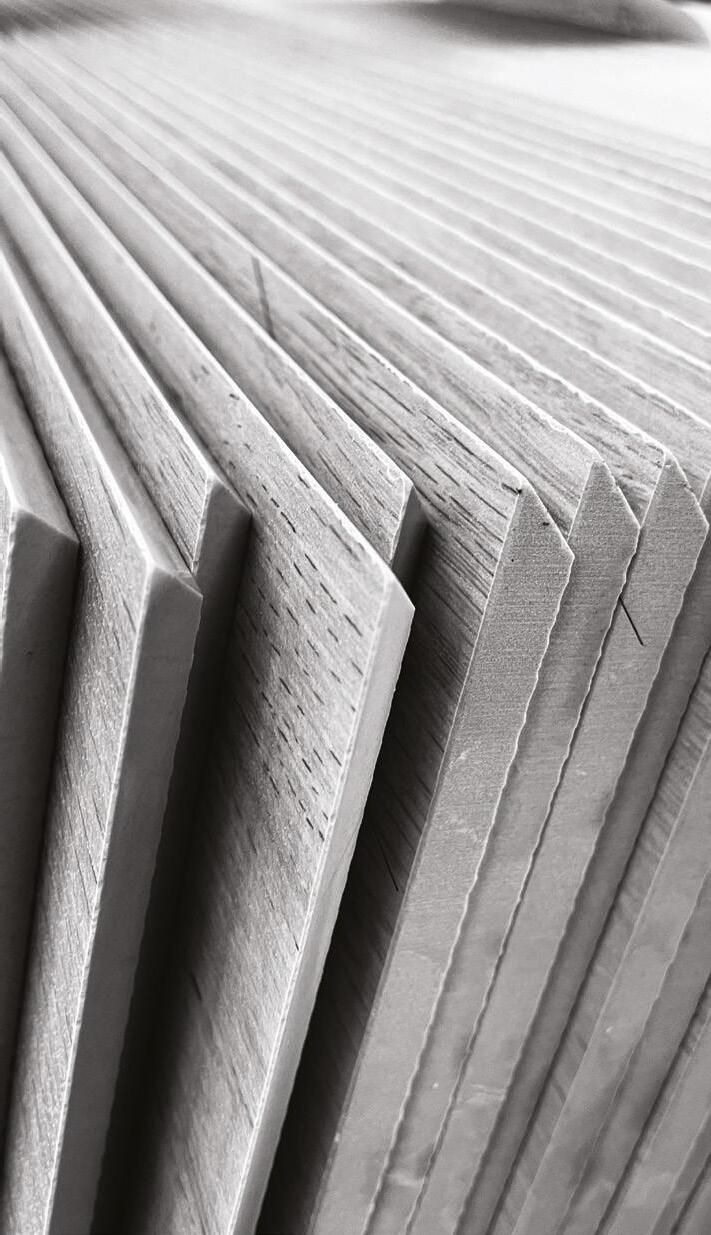

Giuliano Mussini has passed away
Giuliano Mussini, the founder of Panariagroup, passed away on Friday 1 December in Sassuolo at the age of 93. Renowned as a pioneer and innovator of the Italian ceramic tile industry, he played a pivotal role in the industry’s development. He founded Panaria Ceramica in 1974, and from the 1990s onwards initiated an expansion strategy that gradually transformed the company into its current status as one of the sector’s most important global multinationals. Now led by his children, the group has production facilities in Italy, Portugal, the United States and Germany, as well as a subsidiary in India.
The news of his passing was met with profound sorrow, as tributes poured in from throughout the industry and beyond. Giuliano Mussini was revered for his business skills, vision and foresight and led the group with passion, dedication, wisdom and authority for many years. His personal qualities and values such as humility, simplicity and honesty, his love for his family, his sense of responsibility and his immense respect for others earned him the esteem of everyone who knew him.
È scomparso Giuliano Mussini
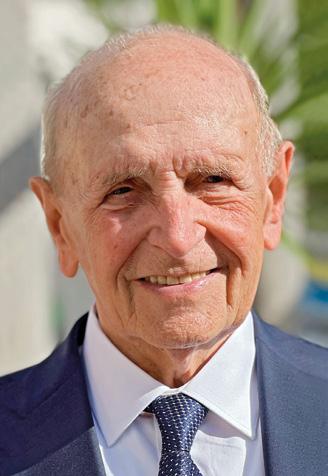
Our entire editorial team extends heartfelt condolences to his wife Gemma and children Emilio, Paolo, Marco and Silvia.
INTER SER REPORTS RECORD SALES OF VIRTO CERAMICS SIEVES
BY CUCCOLINI
The partnership agreement signed about a year ago between Cuccolini (part of the Virto Group since 2008) and Inter Ser has proved highly successful. Under the terms of the agreement, Inter Ser has been granted exclusive rights to market Virto Ceramics brand sieves and iron removers in numerous countries around the world, including the whole of South America and much of Asia, the Middle East and Africa. International sales of Virto Ceramics sieves have almost tripled since the partnership began, with significant numbers of orders re-
ceived from both tile and sanitaryware manufacturers. The results have been particularly significant in Bangladesh, India, Peru, Sri Lanka and Thailand, where leading sanitaryware manufacturers have recognised the value of the services offered by Inter Ser in terms of technical expertise and commercial support. The best-selling sieve in the sanitaryware sector is the VLB 1200 (single and double mesh), which is popular for its high performance (15-30% higher flow rate for the same size), efficiency and modularity. In addition, the 1200 and 1500 sizes are now also available with an integrated lid-lifting system and internal washing system for ease of maintenance and cleaning.
Giuliano Mussini, fondatore di Panariagroup, si è spento venerdì 1 dicembre a Sassuolo, all’età di 93 anni. Tra i pionieri e innovatori dell’industria ceramica italiana, artefice e protagonista del suo sviluppo, Mussini aveva fondato Panaria Ceramica nel 1974, avviando, dagli anni ’90, una strategia di espansione che avrebbe progressivamente trasformato l’azienda in quello che è oggi Panariagroup sotto la guida dei suoi figli: una delle più importanti multinazionali del settore a livello globale, con impianti produttivi in Italia, Portogallo, Stati Uniti e Germania, oltre alla società in India. Profondo il cordoglio suscitato dalla sua scomparsa. Unanime il riconoscimento del mondo industriale per le sue indubbie capacità imprenditoriali, della visione e lungimiranza con cui ha guidato per tanti anni il gruppo con passione, dedizione, saggezza e autorevolezza. Altrettanto forte è l’attestazione di stima sincera, di chiunque lo abbia conosciuto, per le doti umane e i valori che lo hanno contraddistinto: umiltà, semplicità, onestà, amore per la famiglia, responsabilità e un grandissimo rispetto per le persone. Alla moglie Gemma e ai figli Emilio, Paolo, Marco e Silvia le più sentite condoglianze da parte di tutta la nostra redazione.
Since 1989, Cuccolini has been a leading manufacturer and seller of vibrating sieves and iron removers for the ceramic industry, a sector in which it operates under the Virto Ceramics brand. Along with hundreds of other industrial applications, there are now more than 20,000 machines produced by Cuccolini installed worldwide, some of which have been in operation for more than 20 years thanks to their ease of maintenance and low cost.
INTER SER: VENDITE RECORD DI SETACCI VIRTO CERAMICS BY CUCCOLINI
Bilancio più che positivo per la collaborazione siglata circa un anno fa tra Cuccolini (dal 2008 parte di
Virto Group) e Inter Ser, a cui è stata affidata la commercializzazione in esclusiva di setacci e deferrizzatori a marchio Virto Ceramics in numerosi paesi del mondo, tra cui tutto il Sud America e gran parte di Asia, Medio Oriente e Africa. Dall’inizio della partnership, infatti, le vendite all’estero di setacci Virto Ceramics sono quasi triplicate, con un numero importante di commesse sia nel settore delle piastrelle che in quello dei sanitari. Di particolare rilevanza i risultati ottenuti in Bangladesh, India, Perù, Sri Lanka e Tailandia, dove primari produttori di sanitari hanno riconosciuto il valore di Inter Ser dal punto di vista del know how tecnico e del supporto commerciale. Il setaccio più venduto nel settore dei sanitari è il VLB 1200 (a singola e doppia rete), scel-
32 CWR 154/2023
to per le alte prestazioni (portata maggiore del 15 - 30% a parità di taglia), efficienza e modularità. Le taglie 1200 e 1500, inoltre, sono da ora disponibili anche con un sistema di sollevamento della fascia integrato al coperchio e con sistema di lavaggio interno per fa-
NOVAREF MAKES INVESTMENTS AND ACHIEVES INTERNATIONAL GROWTH IN 2023
Novaref, one of Italy’s leading manufacturers of refractory rollers, is set to conclude an excellent 2023 that has seen major manufacturing investments, a constantly evolving product portfolio and significant progress in international markets, especially the Americas.
Sales have grown in particular in South America, where the company has received orders from leading local tile manufacturers thanks to its portfolio of high-performance rollers and high-quality technical support. In particular, the new Nova HD roller, which has already been installed on numerous production lines, offers a perfect response to market requirements and delivers excellent
INCO INSTALLS A NEW PHOTOVOLTAIC SYSTEM
With the aim of reducing CO2 emissions and saving on energy costs, Inco Industria Colori has installed a photovoltaic array on the roofs of its factory located in Pavullo nel Frignano (MO). The total capacity of the photovoltaic panels amounts to 815 kW. The energy produced is used to power the company’s operations, bringing an estimated saving of around 35% of total consumption. Since installing the system, Inco has offset more than 2 million kg of CO2. The project is part of a broad-
cilitare manutenzione e pulizia. Dal 1989 Cuccolini è leader nella produzione e commercializzazione di vibrovagli e deferrizzatori per l’industria ceramica, compar to nel quale opera con il marchio Virto Ceramics. Insieme a centina ia di altre applicazioni industriali,
i macchinari prodotti da Cuccolini installati nel mondo sono ad oggi più di ventimila, alcuni dei qua-
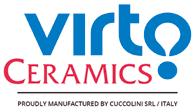
li in funzione da oltre 20 anni, grazie alla facilità di manutenzione e ai costi contenuti.

results in terms of durability and chemical resistance.
To ensure efficient and rapid delivery to ceramic companies in Central and North America, Novaref opened a new distribution warehouse in late summer.
The company has completed a number of structural investments, including the revamping of a kiln at the production facility in Colognola ai Colli in the province of Verona for the purpose of increasing production capacity and the expansion of the finishing department, which already this year has brought a significant improvement in delivery times.
Novaref is looking ahead to a challenging 2024 for the ceramic industry and is planning new investments in production to guarantee an increasingly complete range of rollers with higher performance and even more advanced features.
IL 2023 DI NOVAREF TRA INVESTIMENTI E CRESCITA ALL’ESTERO
Novaref, tra i più importanti produttori italiani di rulli refrattari, si appresta a chiudere un buon 2023, contrassegnato da importanti investimenti produttivi, un portafoglio prodotti in costante evoluzione e significativi progressi sui mercati internazionali, in primis le Americhe. Il volume d’affari è cresciuto soprattutto in Sud America dove l’azienda ha realizzato commesse con i maggiori produttori locali di piastrelle, grazie all’offerta di rulli dalle elevate prestazioni e di un qualificato supporto tecnico. In particolare, il nuovo rullo Nova HD, già installato su molte linee produttive, è riuscito a rispondere perfettamente alle esigenze del mercato, con ottimi risultati in termini di durabilità e resistenza all’aggressione chimica. Per garantire efficienza e rapidi-
tà di consegna alle aziende ceramiche in Centro e Nord America, Novaref ha inaugurato a fine estate un nuovo magazzino di distribuzione. Sul piano degli investimenti strutturali, presso il sito produttivo di Colognola ai Colli, in provincia di Verona, si sono conclusi i lavori di revamping di un forno di cottura che garantirà l’aumento della capacità produttiva ed è stato ultimato l’ampliamento del reparto di finitura che ha permesso, già da quest’anno, di migliorare significativamente i tempi di consegna.
Per il 2024, che si prospetta impegnativo e ricco di sfide per l’industria ceramica, Novaref ha programmato nuovi investimenti produttivi per garantire una gamma sempre più completa di rulli con caratteristiche e prestazioni sempre più evolute.

er environmental sustainability plan under which Inco has set itself a number of goals. It has already reduced electricity consumption by relamping, i.e. installing new LED ceiling lights that perform better in terms of power consumption, duty cycle and efficiency.
INCO INSTALLA UN NUOVO IMPIANTO FOTOVOLTAICO
Con l’obiettivo di ridurre le emissioni di CO2 e risparmiare sui costi energetici, Inco Industria Colori ha provveduto a installare un parco fotovoltaico sui tetti del proprio
stabilimento situato a Pavullo nel Frignano (MO). L’impianto è composto da pannelli fotovoltaici con una potenza complessiva pari a 815 KW; l’energia prodotta viene utilizzata per alimentare l’attività aziendale con un risparmio stimato intorno al 35% del consumo totale. Dalla data della sua installazione, Inco ha compensato oltre 2 milioni di kg di CO2. Il progetto si inserisce nell’ambito di un più ampio piano di sostenibilità ambientale in base al quale Inco ha fissato una
serie di obiettivi. L’azienda ha già ridotto il consumo di energia elettrica grazie al relamping, con l’installazione di nuove plafoniere led più performanti sia dal punto di vista dei consumi, del ciclo di vita e del rendimento.
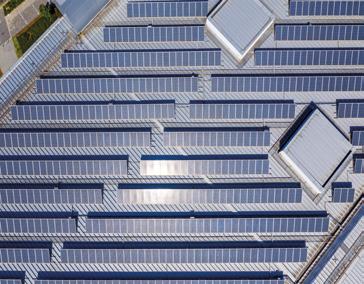
world news
33 CWR 154/2023
STUDIO MM HAS DEVELOPED A SCIENTIFIC METHOD FOR DETERMINING
STRESSES IN CERAMIC SLABS
Studio MM, a Mamiano, Parma-based research centre affiliated to the Arter network of high-technology laboratories in Emilia Romagna, has been working hard in recent years to develop a standardised scientific method for determining the precise levels of stress present in large ceramic slabs directly at the kiln exit. The results of the study have led to the development of a technology that is now being tested and validated and will enable tile manufacturers to make a big step forward in addressing this problematic issue.
The creation of stresses in large size tiles is a serious problem for ceramic tile manufacturers and may arise from various causes, including unsuitable process pa-

CERAMICA GLOBO CONTINUES ITS PARTNERSHIP WITH SETEC
Setec Group is continuing its valuable cooperation with Ceramica Globo, a leading Italian sanitaryware manufacturer. As part of the modernisation programme at its facility in Castel Sant’Elia (Viterbo), Ceramica Globo has also chosen Setec technology for its body preparation department.
The new body preparation technology, which started up last September, allows for fully automatic dosing of individual raw materials according to the selected recipe. The plant features state-of-the-art control and management systems to ensure body consistency and consequently high-quality finished products. The upgrade not only brought about a significant technological improvement, but also led to considerable cost savings
rameters and non-optimal bodies (such as an excess of vitreous phases or an overabundance of crystalline silica). Developing an analytical approach to quantify these stress levels during production will enable ceramic tile producers to determine when the stresses exceed the acceptable limits to guarantee the absence of defects and adjust process parameters or body composition accordingly. At the same time, industrial tests can also be conducted to compare the technological qualities of different ceramic bodies.
STUDIO MM SVILUPPA UN METODO SCIENTIFICO PER DETERMINARE IL TENSIONAMENTO DELLE LASTRE
Negli ultimi anni lo Studio MM di Mamiano (Parma) - Centro di Ricerca appartenente alla rete Arter dei laboratori per l’alta tecnologia
due to shorter processing times and reduced personnel costs. The Setec Group has been delivering machines and turnkey solutions to the sanitaryware and tableware industries for 35 years. Thanks to its in-depth technological knowledge of the process, Setec is able to deliver cutting-edge ceramic manufacturing solutions together with the expertise necessary to ensure high-quality, energy-saving production.
CERAMICA GLOBO RINNOVA LA COLLABORAZIONE CON SETEC
Prosegue la collaborazione virtuosa tra Setec Group e Ceramica Globo, tra le più importanti aziende italiane produttrici di sanitari. Nell’ambito del programma di ammodernamento del suo impianto di Castel Sant’Elia (Viterbo), Globo ha scelto la tecnologia Setec an-
dell’Emilia Romagna - è stato impegnato nella ricerca di un metodo scientifico standardizzato per determinare, in modo certo e normalizzato, l’esatto grado di tensionamento delle grandi lastre direttamente a uscita forno. I risultati dello studio hanno permesso lo sviluppo di una tecnologia che è ora in fase di collaudo e verifica e che permetterà alle aziende produttrici di compiere un decisivo salto di qualità. Quello del tensionamento sui grandi formati è un problema piuttosto sentito tra i produttori di superfici ceramiche. Può dipendere da una pluralità di cause, tra cui parametri di processo non congeniali, o impasti non ottimali (ad esempio per un eccesso di fasi vetrose o abbondanza di silice cristallina). Indipendentemente da quale sia l’origine, la prin-
cipale criticità lamentata è sempre quella del tensionamento post cottura. Trovare un approccio analitico per quantificare questo livello tensionale in tempo reale in fase di produzione permetterà quindi alle aziende ceramiche di intervenire sui parametri di processo o sulla composizione dell’impasto, ogni qual volta le verifiche tecniche sul grado di tensionamento evidenzieranno il superamento dei valori adottati come limiti di accettabilità per garantire l’assenza di difettologie. Allo stesso tempo, mediante test industriali si potranno anche confrontare fra loro le qualità tecnologiche di differenti impasti.

che per il reparto di preparazione impasti.
La nuova sala impasti, avviata lo scorso settembre, consente di gestire in modo del tutto automatico il dosaggio delle singole materie prime in funzione della ricetta selezionata. L’impianto prevede sistemi di controllo e gestione di ultima generazione per garantire la costanza degli impasti prodotti e quindi la qualità del prodotto finale. L’intervento ha consentito non solo un sensibile miglioramento tecnologico, ma anche un notevole risparmio economico legato alla riduzione dei tempi di lavorazione e dei costi del personale.
Il gruppo Setec da 35 anni offre macchine e soluzioni chiavi
in mano per l’industria dei sanitari e della stoviglieria. Grazie alla profonda conoscenza tecnologica del processo, Setec è in grado di fornire non solo le più moderne soluzioni per la produzione ceramica, ma anche il know-how per assicurare una produzione di qualità e volta al risparmio energetico.

SETEC GROUP I I
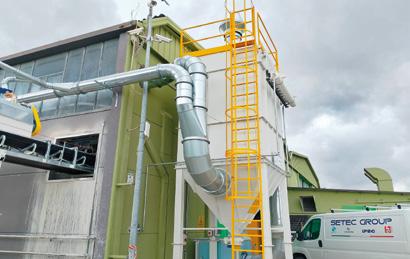



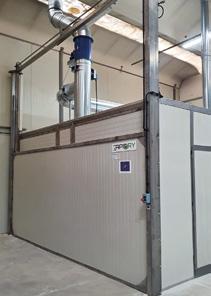
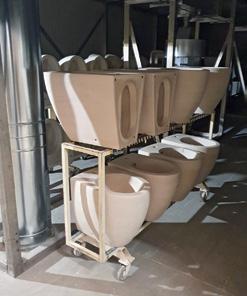



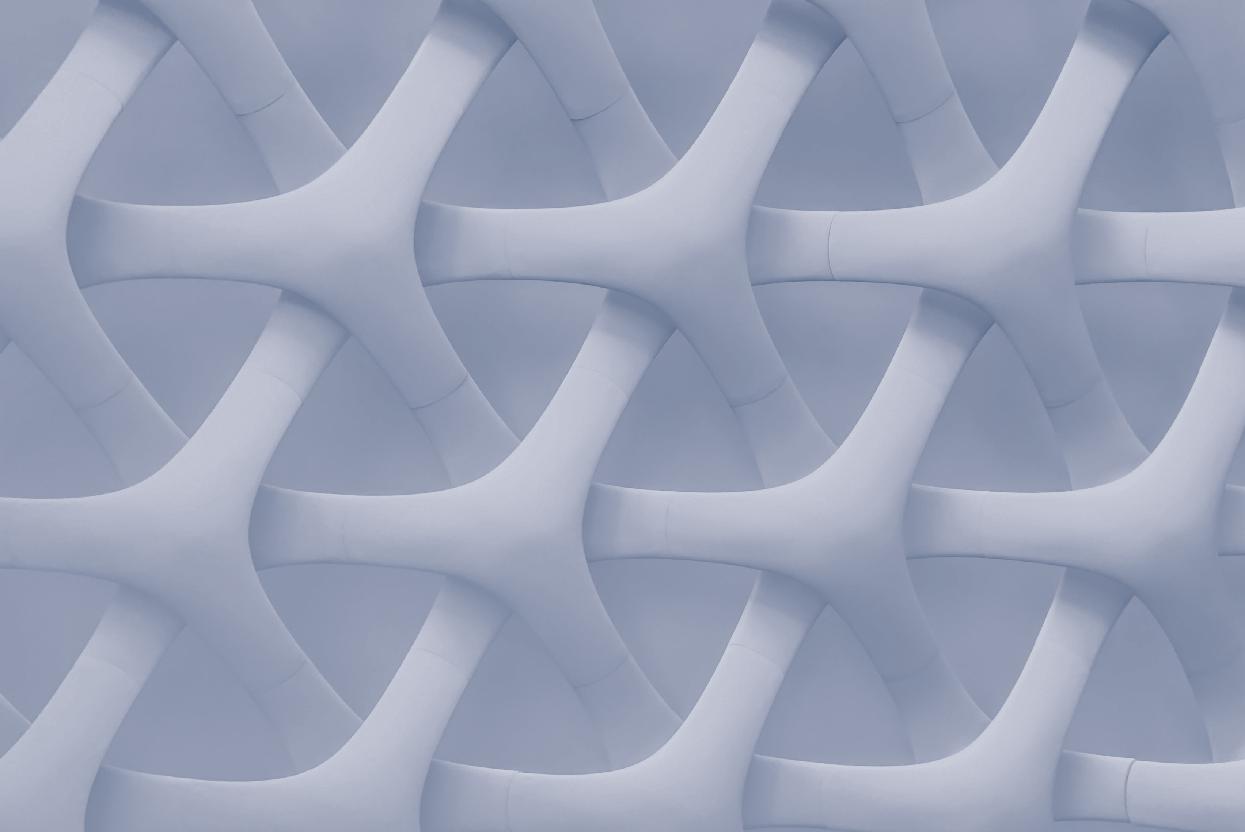
www.rapid-dry.eu
t u n n e l RAPID DRY THE NEXT-GENERATION DRYER FOR SANITARYWARE AND TABLEWARE WHICH REDUCES ENERGY CONSUMPTION AND CO2 EMISSIONS, WHILE PRESERVING PRODUCT QUALITY.
34 CWR 154/2023



BAVELLONI AT TISE 2024 IN LAS VEGAS
Bavelloni will be participating in the upcoming edition of TISE (The International Surface Event) to be held from 24-26 January 2024 at the Mandalay Bay Convention Center in Las Vegas.
The Bavelloni staff will welcome visitors to booth 4535, where they will illustrate the complete range of state-of-the-art technologies for machining natural and synthetic stone, ceramic and sintered materials, including the VE 350 4 ST vertical edger (part of the VE ST series), which will be shown in operation.
The VE 350 4 ST is designed to produce 46° raw chamfers on ceramic, sintered materials and stone, enabling subsequent coupling by gluing. Designed to work vertically, the VE 350 4
ST can grind strips, small-sized pieces and slabs up to 3 metres in height, catering in particular for applications in the furniture industry.
Bavelloni’s staff will be on hand to provide consultations on the company’s extensive range of dry cutting tables, vertical bevellers, double edgers and CNC work centres, including the brand new XRS Series premiered at Marmomac in September.
BAVELLONI AL TISE 2024 DI LAS VEGAS
Bavelloni parteciperà alla prossima edizione di TISE (The Internatio nal Surface Event), in programma dal 24 al 26 gennaio 2024 presso il Mandalay Bay Conven tion Center di Las Ve
gas. Presso lo stand 4535 lo staff Bavelloni illustrerà l’offerta completa di tecnologie all’avanguardia per la lavorazione di pietra naturale, sintetica, materiali ceramici e sinterizzati, in particolare le funzionalità della molatrice verticale VE 350 4 ST (serie VE ST) che sarà mostrata in funzione. La VE 350 4 ST è stata concepita per realizzare smussi grezzi a 46° su materiali ceramici, sinterizzati o pietra e consentire il successivo accoppiamento delle lastre mediante incollaggio. Pro-
gettata per lavorare in verticale, è in grado di processare strisce, pezzi di piccole dimensioni e anche lastre fino a 3 metri di altezza, per applicazioni soprattutto nel settore dell’arredamento. Il personale Bavelloni sarà a disposizione anche per fornire consulenza sulla vasta gamma di tavoli per il taglio a secco, bisellatrici verticali, molatrici bilaterali e centri di lavoro CNC tra i quali la nuovissima Serie XRS, presentata in anteprima a Marmomac lo scorso settembre.







Casting rate increase Higher productivity in sanitary ware. Moisture uniformity in the formed body Consistency of slip parameters Rheology under control Reolam CS 383 Reolam CS 383 world news ADVERTISING
VE 350 4 ST VERTICAL EDGER
MOLATRICE VERTICALE VE 350 4 ST
VE ST SERIES Discover more
SERIE VE ST

DISCOVER YOUR MATERIAL MOMENT
Before it’s Trending, it’s at Coverings.
The ultimate destination for inspiration and deal making, Coverings boasts nine miles of jaw-dropping tile and stone designs and immersive vignettes that will leave you floored. Only at Coverings can you experience 1,000+ exhibitors from 40+ countries, coming together to form an unprecedented hub of commerce, content, and creativity that simply can’t be missed.
April 22-25, 2024 | Atlanta, Georgia
Register at No Cost at Coverings.com #Coverings2024
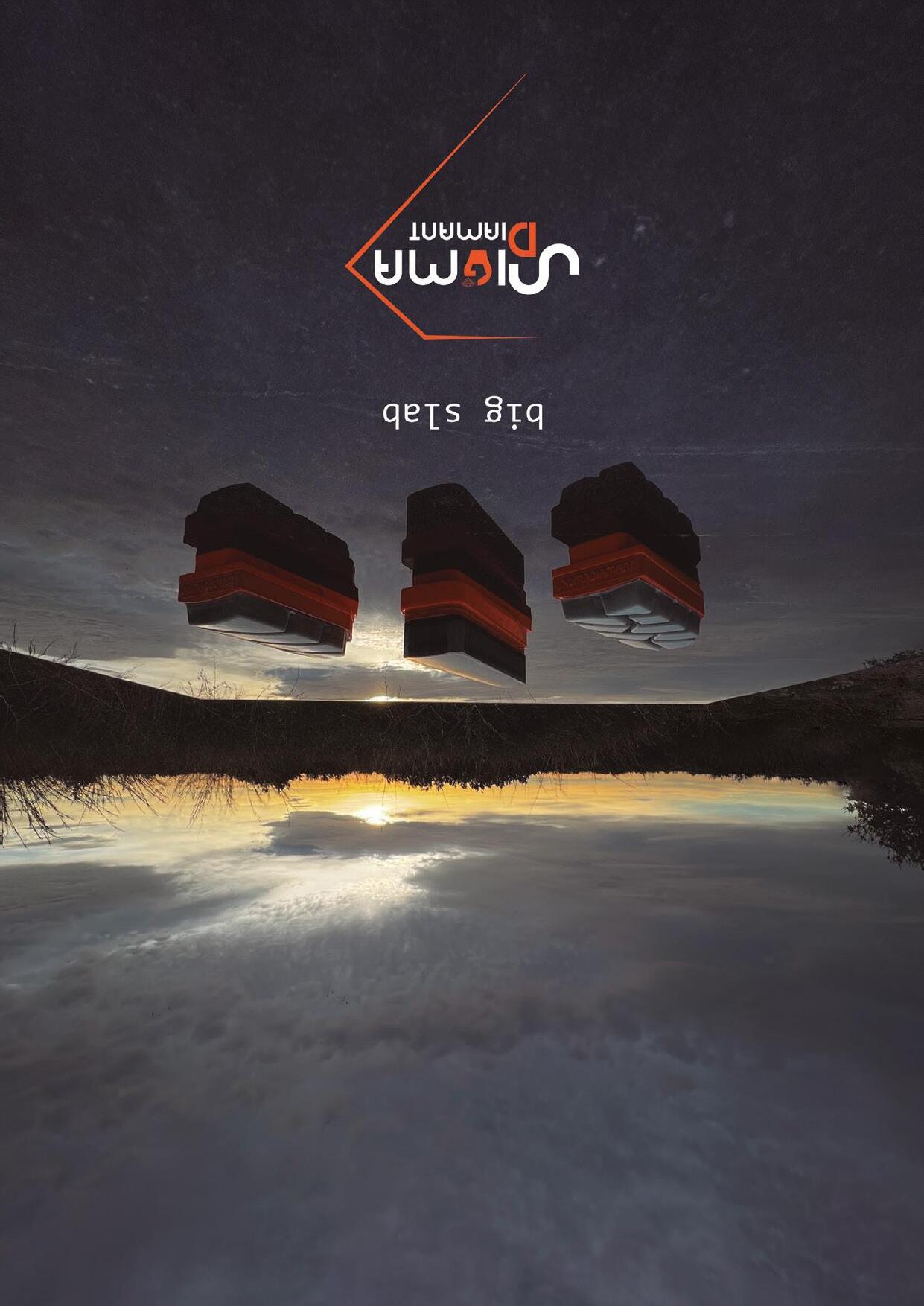



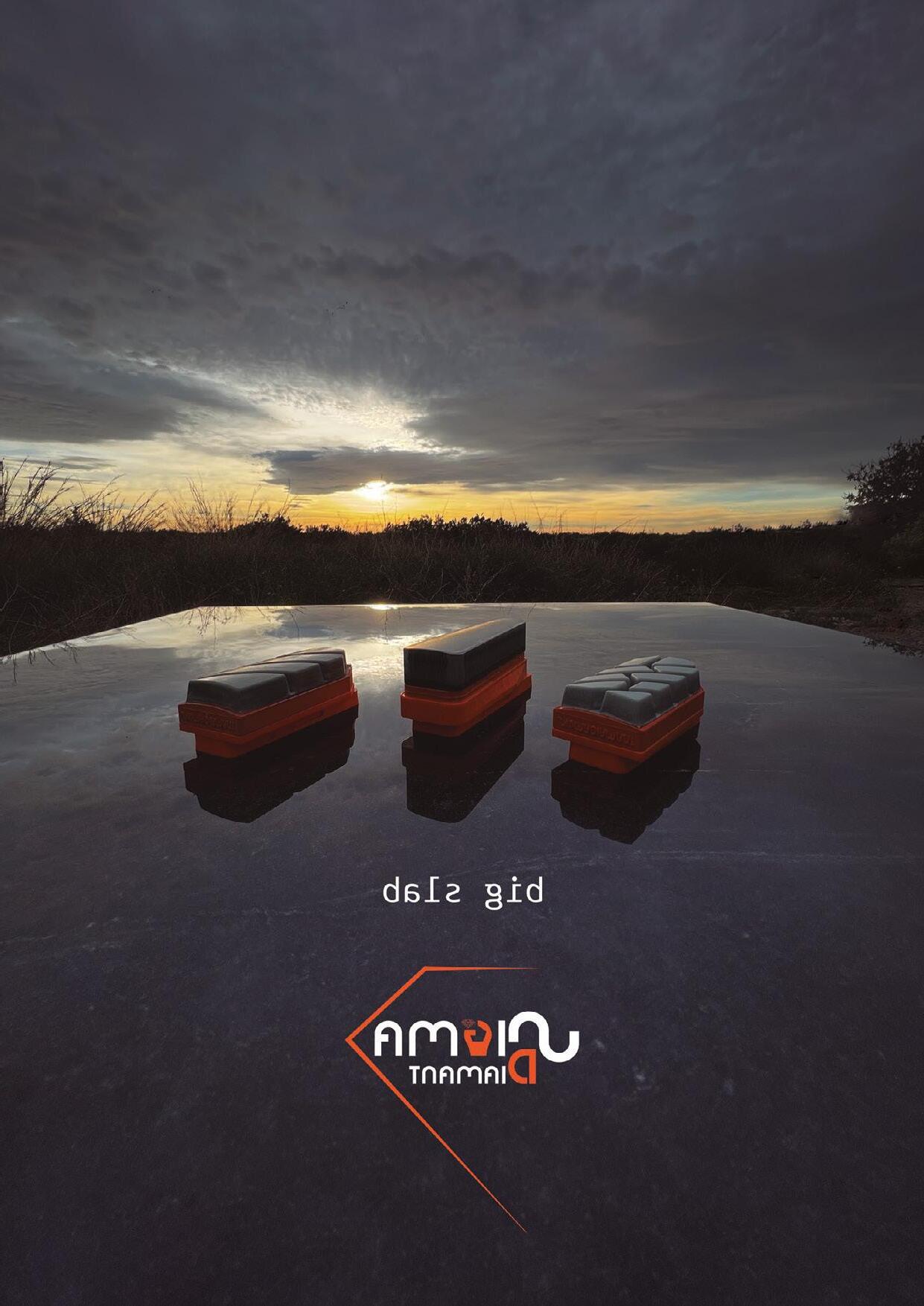







Design and sustainability were the key words at the conference “Ceramics of Value”
Design e sostenibilità al centro del convegno “Ceramica di valore”
On 17 October, more than 250 industry professionals gathered in the Florim Gallery auditorium in Fiorano Modenese to attend the technical conference entitled “Ceramics of ValueTechnologies and Materials for the Surfaces of the Future”, organised by Ceramic World Review and Ceramic World Web in cooperation with Acimac.
Following the forced interruption due to the pandemic, the return of the traditional annual Ceramic World Review and Acimac conference in the Sassuolo ceramic district generated significant interest among industry professionals. “This large turnout demonstrates just how important it remains for all players in the district to be able to meet and discuss issues relating to process and product innovation that will drive ceramic production in the future,” remarked Acimac chairman Paolo Lamberti. “After all, promoting innovation is part of our association’s DNA.”
Innovation was one of the key topics of the conference, which focused on the concept of value “We chose this theme after observing how the Italian ceramic industry overcame the crises of the last two years by focusing on value in all of its forms, including of course product excellence,” explained Paola Giacomini, editor of Ceramic World Review and moderator of the conference. “The aim of the conference was to explore the contribution that the latest technologies and materials can make to further enhancing value, whether it derives from technical quality, aesthetics and design, or sustainability.”
Oltre 250 operatori hanno affollato il 17 ottobre scorso l’auditorium della Florim Gallery di Fiorano Modenese per assistere al convegno tecnico “Ceramica di Valore - Tecnologie e materiali per le superfici del futuro”, organizzato da Ceramic World Review e Ceramic World Web, in collaborazione con Acimac.
Dopo l’interruzione forzata degli ultimi anni, il ritorno in presenza, nel distretto ceramico sassolese, del tradizionale appuntamento convegnistico annuale di Ceramic World Review e Acimac è stato seguito con notevole interesse dagli operatori della filiera dell’industria ceramica. “Questa grande affluenza – ha sottolineato il presidente di Acimac Paolo Lamberti – ci conferma quanto siano ancora importanti momenti di incontro e confronto tra tutti gli attori del distret-
to per approfondire i temi dell’innovazione di processo e di prodotto che guideranno le produzioni ceramiche di domani. Promuovere l’innovazione, del resto, è nel DNA della nostra associazione”.
Innovazione è stata certamente una delle parole chiave del convegno che ha voluto concentrare l’attenzione sul concetto di valore. “Valore che, per ogni azienda, è la somma di vari elementi tra cui, ovviamente, anche un prodotto d’eccellenza – ha aggiunto Paola Giacomini, direttrice di Ceramic World Review e moderatrice del convegno, il cui obiettivo era proprio “approfondire come e quanto le tecnologie e i materiali di ultima generazione possano contribuire ad incrementare ulteriormente quel valore, che derivi dalla qualità tecnica, dall’estetica e dal design, o dalla sostenibilità”.

38 CWR 154/2023


DI VALORE
Tecnologie e materiali per le superfici del futuro
Martedì 17 ottobre 2023
Con
The nine companies taking part in the conference – BMR, Colorobbia, Gruppo B&T-Projecta, Sacmi, Sicer, Smaltochimica, Surfaces Group, System Ceramics and Vetriceramici – offered their individual interpretations of the concept of “Ceramics of Value” with presentations that spanned the entire production line, from design and aesthetic research through to forming, decorating, firing and finishing ceramic surfaces.

Two of the most prominent themes that emerged from the various presentations were the production of products that increasingly resemble natural materials (from through-vein effects to three-dimensional surfaces) and colour as a key element of the luxury trend. In terms of the production process, Sacmi’s report on current research into zero-impact thermal processes attracted a great deal of interest.
The conference concluded with a roundtable discussion devoted to “The Value of Design” featuring two representatives of Acimac’s “Design Firms” group –Paolo Lamberti (Tecnografica) and Elena Pellesi (Digital Design) – along with Federico Borziani, Head of Product Development at Florim Group. Summaries of the nine presentations are published in the following pages, while videos of complete presentations and slides are available at CeramicWorldWeb.com (in Italian only). ◼
A fornire la loro interpretazione di “Ceramica di Valore” sono stati i nove protagonisti del convegno - BMR, Colorobbia, Gruppo B&T-Projecta, Sacmi, Sicer, Smaltochimica, Surfaces Group, System Ceramics e Vetriceramici - che hanno spazia-

to lunga tutta la linea produttiva, dalla ricerca sul design, alla formatura, decorazione, cottura e finitura delle superfici ceramiche. Tra i temi più trattati nei vari interventi, la produzione di materiali sempre più vicini ai prodotti naturali (dalla vena passante alle superfici tridimensionali) e il colore come elemento centrale del luxury trend. In tema di processo, ha riscosso molto interesse la relazione di Sacmi sulle ricerche in corso in tema di processi termici a impatto zero.

Il convegno si è concluso con una tavola rotonda dedicata a “Il Valore del Design” a cui hanno partecipato due rappresentati del raggruppamento “Studi di design” di Acimac - Paolo Lamberti (Tecnografica) ed Elena Pellesi (Digital Design) - e Federico Borziani, Responsabile Sviluppo Prodotti del gruppo Florim.

Nelle pagine seguenti si riportano gli abstract delle relazioni presentate, disponibili in versione integrale (video e slide) anche su CeramicWorldWeb.com
Scansiona il QR Code per rivedere il convegno 39 CWR 154/2023
FOCUS ON ceramics of value CONVEGNO CERAMICA
la partecipazione di: In collaborazione con: Sponsored by: Nell’ambito dell’evento: makeinitaly days 2023 Le nuove frontiere dell’automazione industriale ◼
Ceramic innovation: System Ceramics
redefines surfaces with technology and quality
Innovazione ceramica: System Ceramics
ridefinisce la superficie con tecnologia e qualità
Rita Cagnoli, System Ceramics (Fiorano Modenese, Italy)
From conventional ceramic tiles to the latest through-vein slabs, System Ceramics’ production line transforms ceramic surfaces into a highly competitive and sustainable asset for manufacturers.
System Ceramics has established itself as a pioneer within the dynamic landscape of the ceramic industry, responding to the growing need for materials with added value. The key to this revolution lies in reinterpreting the traditional role of ceramic tiles, elevating them from mere floor or wall coverings to prestigious interior design elements. This radical transformation has centred around the use of advanced technology and a production line specialising in throughvein ceramic slabs.
System Ceramics has expanded the field of application of ceramic tiles by moving beyond the limited definition of a surface and introducing a broader and higher value concept. The advent of through-vein technology has acted as the catalyst for this change. The use of Genesis technology to create products with remarkable aesthetic depth has made it possible to replicate natural materials almost to perfection. This change has made the traditional concept of “ceramic surface” obsolete, paving the way for new potential applications and market opportunities.
THE HI-TECH LINE FROM SYSTEM CERAMICS
System Ceramics’ response to this need for transformation is exemplified by its ceramic slab production line. The sequence of technologies consisting of Genesis, Superfast, Eye-tron and Creadigit Infinity represents the cutting edge of innovation in the industry.
• Genesis is a digitally-controlled full-body decoration system that replicates every aspect of the natural material. Deposition of the full-body spray-dried powder is the first step towards the creation of a ceramic product that emulates natural material to an astonishing degree.
• Superfast mouldless pressing technology not only focuses on the visible surface but also redefines the back of the tiles. The press is capable of creating a three-dimensional, customised design, taking the idea of a ceramic surface to an entirely new level in terms of customisation and originality.
• Eye-tron is a three-dimensional vision system that ensures
Dallo statuto tradizionale alla vena passante: la linea produttiva di System Ceramics trasforma la superficie ceramica in un elemento che garantisce elevata competitività e sostenibilità per le aziende. Nel mondo dinamico dell’industria ceramica, System Ceramics si è affermata come pioniere nella risposta alla crescente esigenza di conferire valore ai materiali. La chiave di questa rivoluzione risiede nella reinterpretazione dello statuto tradizionale della ceramica, passando da una mera funzione di pavimentazione o rivestimento a un elemento d’arredo di prestigio. Un cambiamento profondo che ha trovato la sua espressione attraverso una tecnologia avanzata e una linea per la produzione di lastre ceramiche con vena passante. System Ceramics ha affrontato l’ampliamento della destinazione d’uso della ceramica, superando la limitata definizione di superficie e introducendo un concetto più ampio e prezioso. L’avvento della tecnologia per realizzare la vena passante è stato il catalizzatore di questa trasformazione.
La capacità di creare artefatti con una profondità estetica significativa, attraverso l’utilizzo di Genesis, ha permesso di imitare in modo quasi totale la materia naturale. Questo cambiamento ha reso obsoleto il concetto tradizionale di “superficie ceramica”, apren-
do nuove possibilità di utilizzo e nuovi mercati.
LA LINEA TECNOLOGICA AVANZATA DI SYSTEM CERAMICS
La risposta di System Ceramics a questa esigenza di trasformazione è incarnata nella sua linea per la produzione di lastre ceramiche. La sequenza di tecnologie, composta da Genesis, Superfast, Eye-tron, e Creadigit Infinity, rappresenta l’avanguardia dell’innovazione nel settore.
• Genesis è il sistema di decorazione a tutta massa, gestito digitalmente, in grado di replicare ogni aspetto del materiale naturale. La deposizione dell’atomizzato a tutta massa è il primo passo verso la creazione di un prodotto ceramico che emula la materia naturale in modo sorprendente.
• Superfast, tecnologia di pressatura senza stampo, non si concentra solo sulla superficie, ma ridefinisce anche il retro delle piastrelle. La pressa è in grado di imprimere un design tridimensionale e personalizzato, portando l’idea di superficie ceramica a un nuovo livello di personalizzazione e originalità.
• Eye-tron è il sistema di visione tridimensionale che assicura una precisione senza pari nella realizzazione della
40 CWR 154/2023
Scansiona il QR Code per rivedere l’intervento integrale





unparalleled precision in creating the through-vein effect. Eye-tron scans and accurately detects the position of the through vein obtained with Genesis, making it a key component in ensuring a flawless end result.
• Creadigit Infinity represents the next step forward in high-resolution digital printing. Not only can it be positioned anywhere on the line, it also has an astonishing degree of flexibility, with configurations of up to 12 colours and different families of inks and materials, offering unprecedented control over the creation of ceramic surfaces.
System Ceramics has embraced the conceptual evolution of ceramic tiles from mere surface coverings to high quality interior design elements. This hi-tech line represents the pinnacle of excellence in the ceramic industry, redefining standards and opening up new prospects for the sector. The combination of Genesis, Superfast, Eye-tron and Infinity offers a comprehensive approach that provides an effective response to the growing demand for new value in ceramic surfaces, cementing System Ceramics’ position at the forefront of innovation and creativity in the industry. ◼
vena passante. Scansionando e rilevando con esattezza la posizione della vena passante ottenuta con Genesis, Eyetron è un componente chiave per garantire un risultato finale impeccabile.
• Creadigit Infinity rappresenta l’evoluzione nella stampa digitale ad alta risoluzione. Oltre alla possibilità di posizionamento in qualunque punto della linea, la sua flessibilità - con configurazioni fino a 12 colori e diverse famiglie di inchiostri e materiali - offre un controllo senza precedenti sulla creazione della superficie ceramica.
System Ceramics ha abbracciato il cambiamento nello statuto della ceramica, passando da un concetto limitato di superficie a un elemento d’arredo di alta qualità. Questa linea tecnologica avanzata rappresenta l’eccellenza nell’industria ceramica, ridefinendo gli standard e aprendo nuove prospettive per il settore.
La combinazione di Genesis, Superfast, Eye-tron, e Infinity offre un approccio completo che risponde in modo efficace alla crescente domanda di un valore rinnovato nella superficie ceramica, ponendo System Ceramics all’avanguardia dell’innovazione e della creatività nel settore. ◼

Joe Lundgren is a globally recognized product and marketing expert in the ceramic and stone worldwide markets. His specialty is Business Development, Product Management, and Marketing.
Joe has developed his expertise in strategic planning, new product development, and marketing strategy for North America during his 27 year career at Dal-Tile, a subsidiary of Mohawk Industries.
Joe has extensive experience in multiple sales channels including distribution and Home Centers.
Additionally, Joe represents the Tile Council of North America (TCNA) for its testing laboratories, which has Joe at the epicenter of the industry for all new initiatives.
Please contact Joe Lundgren for a free consultation proposal!
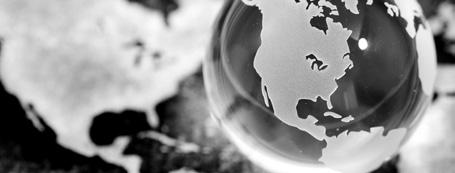
WHERE GROWING YOUR BUSINESS IS OUR PURPOSE.
+1.214.641.7773 JOSEPHLUNDGRENCONSULTING.COM CONVEGNO CERAMICA DI VALORE materiali per le superfici del futuro 2023 Nell’ambito dell’evento: makeinitaly days
Le nuove frontiere dell’automazione industriale FOCUS ON ceramics of value ADVERTISING
2023
Rita Cagnoli
Colored Luxury Surfaces
Colored Luxury Surfaces
Eros Giavelli, Vetriceramici (Fiorano Modenese, Italy)
“The future has a way of arriving unannounced,” wrote Pulitzer Prize-winning US political commentator George F. Will. This quote is an eloquent reminder of the importance of staying forward-thinking and prepared for the future in any industry, including ceramic tile production.
Vetriceramici adopts this forward-looking approach by keenly observing consumption macro-trends. Understanding the trajectory of these trends is pivotal for steering research and designing the materials and surfaces of the future. To enhance this effort, Vetriceramici has partnered with Carlin Creative Trend Bureau, a Paris-based Trend Setter company with over 70 years of experience collaborating with leading international brands across diverse sectors such as cosmetics, electronics, automotive, and fashion. Carlin Creative Trend Bureau specialises in interpreting consumer expectations and translating them into aesthetic codes for colour and materials. This exclusive collaboration with Vetriceramici has resulted in extensive research into the world of interior design, focusing particularly on the colours and surfaces that will shape upcoming trends.
Immersive Real life, Sense and Biotechphilia are the three macro-trends that emerged from the study and guided the Vetriceramici laboratories in the development of new surfaces.
Technology remains the common thread running through all these macro-trends. The younger generations, being digital natives, possess an inherent understanding of these technological languages. They feel a natural affinity and connection to digital platforms, seeking products and materials that seamlessly integrate with the digital world.
Digital is often equated with freshness, dynamism and fluidity, three qualities that are much in evidence in one of the results of the collaboration with Carlin: Colored Luxury Surfaces
Vetriceramici has developed two types of surfaces based on these principles.
The Luxury HyperGlossy surface has a rich, opulent texture with aesthetic and technological qualities that far surpass typical polished glossy finishes. It incorporates suspended glitter made from exclusive materials produced in the Casola Valsenio factory. These materials are highly stable and easy to mix with other types of products, and can be applied either uniformly or in patterned designs based on predetermined graphics.
“Il futuro ha un modo di arrivare senza preavviso” (cit. George F. Will). L’espressione del premio Pulitzer statunitense ci ricorda quanto sia indispensabile, in qualsiasi settore industriale, mantenere lo sguardo rivolto al futuro per non farsi trovare impreparati. Questo vale, evidentemente, anche per la manifattura ceramica. Per Vetriceramici questo approccio non può prescindere dalla conoscenza e dallo studio dei macrotrend dei consumi: comprenderne l’orientamento e i cambiamenti è fondamentale per indirizzare correttamente l’attività di ricerca e progettazione dei nuovi materiali e delle superfici del futuro. Nasce da qui la collaborazione con Carlin Creative Trend Bureau, società parigina di Trend Setter che da oltre 70 anni collabora con i più importanti brand internazionali in diversi settori (cosmetica, elettronica, automotive, abbigliamento …), traducendo le aspettative del consumatore in codici estetici per il colore e i materiali. Questa collaborazione esclusiva con e per Vetriceramici ha avuto come risultato una ricerca approfondita sul mondo dell’Interior Design, con un particolare focus sui colori e sulle superfici che saranno di tendenza nei prossimi anni. Immersive Real life, Senso e Biotechfilia sono i tre macrotrend emersi dallo studio che hanno guidato i labo-
ratori Vetriceramici nello studio di nuove superfici.
Il filo conduttore si conferma la tecnologia. Le nuove generazioni, i nativi digitali, intendono e interagiscono molto bene con questi linguaggi ai quali sentono istintivamente di appartenere, e cercano prodotti e materiali che siano in grado di collegarsi simbioticamente al mondo digitale.
Digitale è spesso sinonimo di freschezza, dinamicità, fluidità, tre elementi che caratterizzano uno dei risultati della collaborazione con Carlin: le Colored Luxury Surfaces
Due le tipologie di superfici sviluppate partendo da queste linee guida.
Luxury HyperGlossy si presenta come una superficie particolarmente ricca, materica e lussuosa, con un valore estetico e tecnologico enormemente più interessante e di valore rispetto alle semplici superfici lucide levigate. È arricchita da glitter in sospensione costituiti da materiali esclusivi prodotti nello stabilimento di Casola Valsenio, particolarmente stabili e facilmente miscelabili con altri tipi di materiali, applicabili sia a campo pieno sia ad incastro seguendo l’andamento grafico predeterminato.
In totale antitesi all’HyperGlossy c’è poi il trend che esalta il fascino elegante di superfici satinate soft touch, smo-
42 CWR 154/2023


CONVEGNO CERAMICA DI VALORE
Tecnologie e materiali per le superfici del futuro
Martedì 17 ottobre 2023
Con la partecipazione di:

In contrast, the second trend emphasises the allure of soft touch, smooth and textured satin surfaces . With their warm colour tones, soft appearance, rich material and three-dimensional effects, these surfaces are ideal for emulating stone, marble and wood.
Vetriceramici uses BFASE technology for this trend, applying two different layers of grit to achieve the ambitious goal of “Zero Porosity”.
BFASE allows for the creation of satin finishes simply by lapping, ensuring a finished product with the same characteristics as a polished lapped surface. This is often a difficult result to achieve, as the most experienced ceramic technicians are well aware.
So what materials will be used to produce the ceramics of the future? Vetriceramici proposes high-performance, versatile materials that are easy to mix and compatible with a variety of digital technologies, resulting in luxurious, soft and natural surfaces. Based on its almost four decades of experience, Vetriceramici firmly believes that the quality of materials will always remain key to the ceramic industry’s future. ◼

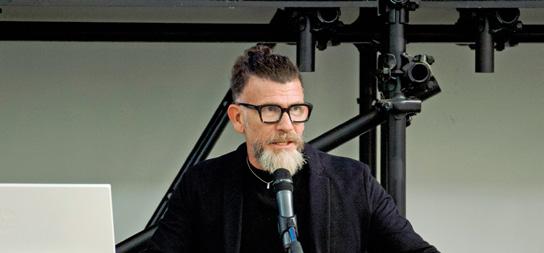
oth e materiche. Queste superfici sono perfette per pietre, marmi e legni, di tonalità di colore calde, dall’aspetto morbido, ricchissime di materia ed effetti tridimensionali. In Vetriceramici la declinazione tecnologica di questa tendenza è il BFASE, un’applicazione “a sandwich” di diverse materie progettate esclusivamente per questo scopo. Obiettivo ambizioso raggiunto con BFASE è la “Porosità Zero” che si ottiene applicando

due differenti strati di graniglia. BFASE è perfetto per realizzare superfici satinate ottenute tramite la semplice lappatura, garantendo in questo modo un prodotto finito con le stesse caratteristiche di un lappato lucido; un risultato spesso difficile da ottenere, come ben sanno i tecnici più esperti in ceramica.
Quali saranno, quindi, i materiali per realizzare la ceramica del futuro?
Vetriceramici propone materiali performanti, versatili, facilmente miscelabili e adatti alle più svariate tecnologie digitali per ottenere superfici ricche e lussuose, morbide e naturali. Con quasi quaranta anni di esperienza, Vetriceramici è profondamente convinta che a vincere sarà sempre e comunque la materia! ◼

43 CWR 154/2023
Sponsored by: Nell’ambito dell’evento: makeinitaly days 2023 Le nuove frontiere dell’automazione industriale FOCUS ON ceramics of value
Scansiona il QR Code per rivedere l’intervento integrale
Eros Giavelli
Rethinking thermal processes: the value of a zero-impact future
Ripensare i processi termici: il valore di un futuro a
Given the steadily rising emissions costs facing the ceramic industry, both in Europe and beyond, speeding up the pace of progress towards the goal of climate neutrality is increasingly becoming a key competitive factor, and one that is supported by governments around the world through incentives to invest in clean energy.
This report takes stock of the state of the art, focusing in particular on the use of alternative fuels and the recovery of waste heat. It focuses above all on kilns and dryers, which account on average for 46% of the total emissions of a ceramic factory, and on the technologies (many of them ready-to-market) that can be used to reduce or eliminate these emissions.
One existing solution on the market is Sacmi’s “zero fuel” dryer, a newly developed machine which efficiently exploits hot air recovered from kilns to reduce fuel consumption to zero under steady-state conditions. This solution has gained traction within the Italian ceramic industry, with several highly effective installations already in place, encouraging further efforts in this direction.
The next area of intervention is the kiln, which alone is responsible for almost 40% of emissions. For this reason, Sacmi has invested heavily in the firing stage, focusing on three main areas:
• heat recovery and kiln adjustments (which bring immediate benefits in terms of lower consumption and a corresponding increase in product quality);
• development of a new generation of digitally controlled kilns (Maestro range), already equipped to operate with up to 50% natural gas-hydrogen blends;
• the recent inauguration of the new 100% hydrogen kiln prototype and the associated pure hydrogen production and storage station.
The successful initial firing tests carried out recently on the new “full H” kiln prototype, utilising pure hydrogen as fuel, have shown promising results. The initial tile firing conducted on October 23 marked a proud achievement for the team behind the project.
Moving forward, the roadmap is clear. Over the coming months, all the necessary tests will be carried out on real products to ensure the quality of production using this new technology. These tests will specifically focus on assessing the implications of hydrogen’s different calorific value compared to natural gas and the adjustments that will need to be made to firing curves and
impatto zero
Daniele Baldini, Sacmi (Italy)
Alla luce del progressivo aumento del “costo delle emissioni” per l’industria ceramica, in Europa e non solo, accelerare verso gli obiettivi di neutralità climatica diventa sempre più un fattore di competitività, supportato peraltro dai governi di tutto il mondo che incentivano gli investimenti in energia pulita.
In questa relazione facciamo il punto sullo stato dell’arte, concentrandoci in modo particolare sull’utilizzo dei combustibili alternativi e sul recupero dei cascami termici. Si parla di forno ed essiccatoio, soprattutto, che incidono mediamente del 46% sulle emissioni totali di un impianto ceramico, e delle tecnologie (molte delle quali ready-to-market) utili per ridurre o azzerare questa quota.
Già sul mercato è l’essiccatoio «zero fuel» di Sacmi, una macchina di nuova concezione che, sfruttando in modo efficiente i recuperi di aria calda proveniente dai forni di cottura, consente in condizioni stazionarie di azzerare il consumo di combustibile. Si tratta di una soluzione già consolidata, anche nel distretto ceramico italiano vi sono già alcune realizzazioni ben funzionanti che incoraggiano a lavorare in questa direzione.
Vi è quindi il forno, responsabile da solo di quasi il 40% delle emissioni. Sulla fase di
cottura Sacmi ha concentrato investimenti e risorse in tre principali direzioni:
• recuperi e regolazioni (con vantaggi immediati in termini di minori consumi e parallelo incremento di qualità del prodotto);
• sviluppo di una nuova generazione di forni a gestione digitale (gamma Maestro), già adeguati per gestire sino al 50% di miscele metano-idrogeno;
• e la recente inaugurazione del nuovo prototipo di forno 100% a idrogeno e relativa stazione di produzione stoccaggio dell’idrogeno puro.
Il nuovo prototipo di forno “full H” ha già dato ottimi risultati, con le prime prove di cottura realizzate con successo, nelle scorse settimane, utilizzando come combustibile l’idrogeno puro. Dopo l’accensione del forno, il 23 ottobre è stata cotta la prima piastrella, con grande orgoglio da parte del team che ha contribuito al progetto.
Ora il percorso è segnato. Nei prossimi mesi saranno effettuate tutte le prove su prodotti reali per garantire la qualità dell’output con questa nuova tecnologia, testando sul campo le conseguenze del differente potere calorifico dell’idrogeno rispetto al metano e le correzioni necessarie alla gestione delle curve di cottura e dell’avanzamento del materiale.
44 CWR 154/2023
material feed rates to optimise performance.
CONVEGNO CERAMICA DI VALORE


Tecnologie e materiali per le superfici del futuro
Martedì 17 ottobre 2023
Con la partecipazione di:

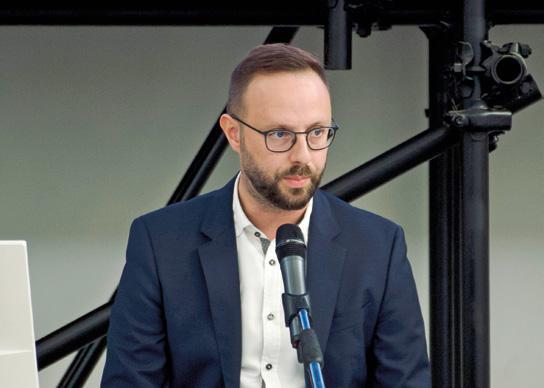
Given the importance of quality and reliability, these tests will examine the potential impact of using hydrogen in terms of tone and calibre, the consequences of “transients” (sudden changes in the composition of the blend), and the impact of the combustion atmosphere on the durability and reliability of the various kiln components (insulation, rollers, burners, etc). An essential aspect of this process is the new pure hydrogen production and storage station, built at the Sacmi Forni & Filters site and one of the first of its kind in Italy. The facility consists of an electrolyser where hydrogen is produced at a rate of 20 Nm³ per hour. It is then compressed to increase the outlet pressure from 8-12 bar to approximately 200 bar. This is essential in order to facilitate storage, since one of the downsides of hydrogen is that it is highly voluminous (much more so than natural gas/LPG and up to seven times more voluminous for the same calorific value). The third and final station involves storage in cylinders, which enables the team to continuous testing with 100% hydrogen for durations of up to two and a half days. The process involves blending hydrogen with natural gas, while maintaining precise control over the blend’s composition.
A 100% electric kiln is also under study, although it presents significant technological challenges. This project, however, is not starting from scratch as Sacmi already boasts some highly advanced examples of electric sanitaryware kilns powered by renewable energy and has conducted advanced research on dryers. The first prototype of an e-kiln designed for tiles is expected to be installed in the laboratory by the end of 2024 Underlying all of these efforts is the question of energy infrastructures. The goal is to be prepared for any future developments (hydrogen, electric, etc.) by developing solutions that meet manufacturers’ needs in terms of quality, productivity and flexibility. At the same time, the industry must make a concerted effort to foster the development of suitable public and industrial policies by accelerating the pace of technological progress. ◼
La qualità e l’affidabilità anzitutto. Ecco perché questi test comprendono l’eventuale impatto dell’idrogeno in termini di tono e calibro, effetto dei “transitori” (repentino cambiamento nella composizione della miscela), conseguenze dell’atmosfera di combustione sulla durata e affidabilità delle varie componenti (isolamento, rulli, bruciatori, etc).
Essenziale in questo percorso è la disponibilità della nuova stazione di produzione e stoccaggio dell’idrogeno puro, realizzata nella sede di Sacmi Forni & Filters e tra le prime in Italia nel suo genere. La stazione si compone di un elettrolizzatore dove l’idrogeno viene prodotto ad una velocità di 20 Nm³ l’ora. Quindi compresso, portando la pressione in uscita da 8/12 bar a circa 200 bar. L’operazione è essenziale per agevolare lo

stoccaggio, visto che uno dei “difetti” dell’idrogeno è di essere molto voluminoso (molto più voluminoso del metano/ gpl, anche fino a sette volte a parità di potere calorifico). Terza ed ultima stazione, lo stoccaggio in bombole che permette al team di condurre dei test continuativi al 100% idrogeno che possono durare fino a due giorni e mezzo. L’idrogeno viene miscelato con il metano, ed il controllo della composizione della miscela è totale.
Allo studio c’è anche il forno 100% elettrico, con sfide tecnologiche non banali. In questo caso, tuttavia, non si parte da zero. In Sacmi ci sono già esempi molto avanzati nel business del sanitario (forno elettrico alimentato da energia rinnovabile) e studi altrettanto avanzati sull’essiccatoio. Per quanto riguarda il primo prototipo di e-kiln per piastrelle, è prevista l’installazione in laboratorio entro il 2024 Sullo sfondo, infine, il tema delle infrastrutture energetiche, con l’obiettivo di farsi trovare pronti a qualsiasi evoluzione (idrogeno, elettrico, etc) con soluzioni già adeguate alle esigenze dei produttori in termini di qualità, produttività, flessibilità. Ma anche di stimolare attivamente, accelerando sulla tecnologia, lo sviluppo di adeguate politiche pubbliche e di filiera. ◼
45 CWR 154/2023
Sponsored by: Nell’ambito dell’evento: makeinitaly days 2023
nuove frontiere dell’automazione industriale
ceramics
Le
FOCUS ON
of value
Daniele Baldini
Scansiona il QR Code per rivedere l’intervento integrale
Forma Plus: material and sustainability
Forma Plus: materia e sostenibilità
Paolo Monari, Antonella Baglio, Colorobbia (Italy)
In past years, the demand for increasingly high aesthetic appeal resulted in ever greater differentiation between ceramic products, especially in terms of graphic design. Today, however, we are witnessing a digital transformation that involves not only the decoration stage but the complete digitalisation of production processes. The emergence of new application techniques allows for the creation of innovative ceramic products that meet increasingly stringent aesthetic and technical requirements.
Colorobbia’s Forma Plus suite of products epitomises this transformation, offering a variety of solutions for giving form to matter and consequently creating three-dimensional textured effects and surfaces.
This suite includes three different types of products that can be used to transform completely smooth ceramic substrates into three-dimensional surfaces:
• Graffiti inks: Exploiting the water repellent properties of solvent-based products, Graffiti inks can be combined with traditional engobes and glazes to create microstructures.
• Glues and Neogrits: When used in conjunction with digital glues that maximise their bonding capacity, grits create natural finishes with deep and well-defined textures.
• Extraglazes: These water-based glazes are specially formulated for use with new high-discharge digital machines, both for full-field glazing and for creating selective decorations and material relief effects.
The use of digital inks, glues, glazes, grits and microgrits allows for the creation of highly realistic relief surfaces that replicate natural stone, marble and wood, while at the same time preserving the ceramic properties and technical performance of the finished product.
By achieving new technical and aesthetic standards, the Forma Plus product line is capable of creating finished products with unique and inimitable qualities, a level of customisation and tailor-made finish that is synonymous with added value.
Colorobbia’s Forma Plus suite of products helps the ceramic industry achieve its latest goal of replicating natural materials in terms of both aesthetics and quality.
In addition, the ability to manufacture products with increasingly realistic aesthetics will also lead to a reduction in the use of natural stone for interior design projects, further cementing the role of ceramic tiles as a sustainable, long-term material. Colorobbia has been committed to environmental sustainability for decades.
Negli anni passati la richiesta di requisiti estetici sempre più elevati ha portato alla differenziazione dei prodotti ceramici soprattutto dal punto di vista grafico. Oggi, invece, stiamo assistendo ad una trasformazione digitale che si manifesta non solo nella fase di decorazione, ma anche e soprattutto attraverso una completa digitalizzazione dei processi. Grazie a nuove tecniche applicative è possibile realizzare innovativi prodotti ceramici che soddisfano requisiti estetici e tecnici sempre più esigenti. La famiglia dei prodotti Forma Plus di Colorobbia sintetizza questa evoluzione, offrendo differenti soluzioni per dare “forma” alla materia e conseguentemente creare effetti e superfici strutturate tridimensionali.
Esistono tre modi – ovvero tre tipologie di prodotto - per creare superfici tridimensionali a partire da supporti ceramici completamente lisci:
• Inchiostri “Graffiti”: Grazie alla idrorepellenza degli inchiostri base solvente, è possibile costruire microstrutture combinando gli inchiostri Graffiti con engobbi e smalti tradizionali.
• Colle e graniglie “Neogrits”: Le graniglie, in combinazione con colle digitali che ne massimizzano la capacità di adesione, consentono di ottenere finiture naturali con strutture profonde e ben definite.
• “Extraglazes”: Sono smalti a base acqua, con proprietà studiate per le nuove macchine digitali con scarico ad alto peso, sia per smaltatura a campo pieno sia per creare decorazioni selettive ed effetti di rilievo materico.
L’utilizzo di inchiostri, colle, smalti digitali, graniglie e micrograniglie consente di realizzare superfici a rilievo estremamente realistiche per riprodurre pietre, marmi e legni naturali, mantenendo al contempo inalterate le proprietà ceramiche e le prestazioni tecniche del prodotto finito.
Grazie al raggiungimento di nuovi standard tecnici ed estetici, la famiglia di prodotti Forma Plus consente di conferire al prodotto finale una peculiarità unica e inimitabile, una customizzazione ed un “tailor-made” che diventa sinonimo di valore aggiunto.
L’ultimo target ceramico è infatti quello di replicare esteticamente e qualitativamente la materia naturale e i prodotti Forma Plus di Colorobbia permettono di raggiungere ancora di più tale obiettivo.
Inoltre, la possibilità di fabbricare prodotti con un’estetica sempre più reale permetterà anche di ridurre l’impiego di pietre naturali per realizzare progetti d’arredo. La ceramica si configura ancora una volta come materiale sostenibile di lungo periodo.
46 CWR 154/2023


VALORE
materiali per le superfici del futuro
Scansiona il QR Code per rivedere l’intervento integrale


Each Forma Plus product family features digital inks from the Air Evolution series These inks have special organic formulations that significantly reduce emissions of odorous agents and harmful substances (particularly aldehydes) formed during the complex chemical and physical decomposition reactions that occur inside kilns.
Another significant eco-friendly innovation is a line of water-based digital glues, which together with Extraglazes digital glazes for selective 3D decoration aim to achieve zero impact in terms of atmospheric emissions during tile firing processes. ◼


Su questo tema merita una sottolineatura la decennale vocazione di Colorobbia agli aspetti legati alla sostenibilità ambientale.
In questa ottica, infatti, all’interno di ciascuna famiglia di prodotti Forma Plus, sarà possibile trovare inchiostri digitali della serie Air Evolution che, grazie alla loro speciale formulazione organica, rendono possibile una consistente riduzione delle emissioni industriali sia in termini di agenti odorigeni, che in termini di sostanze nocive (aldeidi) che si formano nelle complesse reazioni di decomposizione chimico-fisica all’interno dei forni ceramici.
Una ulteriore evoluzione “green” è poi rappresentata da una linea di Colle Digitali a Base Acqua che, unitamente agli smalti digitali Extraglazes per la decorazione 3D selettiva, mirano a raggiungere l’obiettivo di “impatto zero” dal punto di vista delle emissioni in atmosfera durante i processi di cottura delle piastrelle. ◼
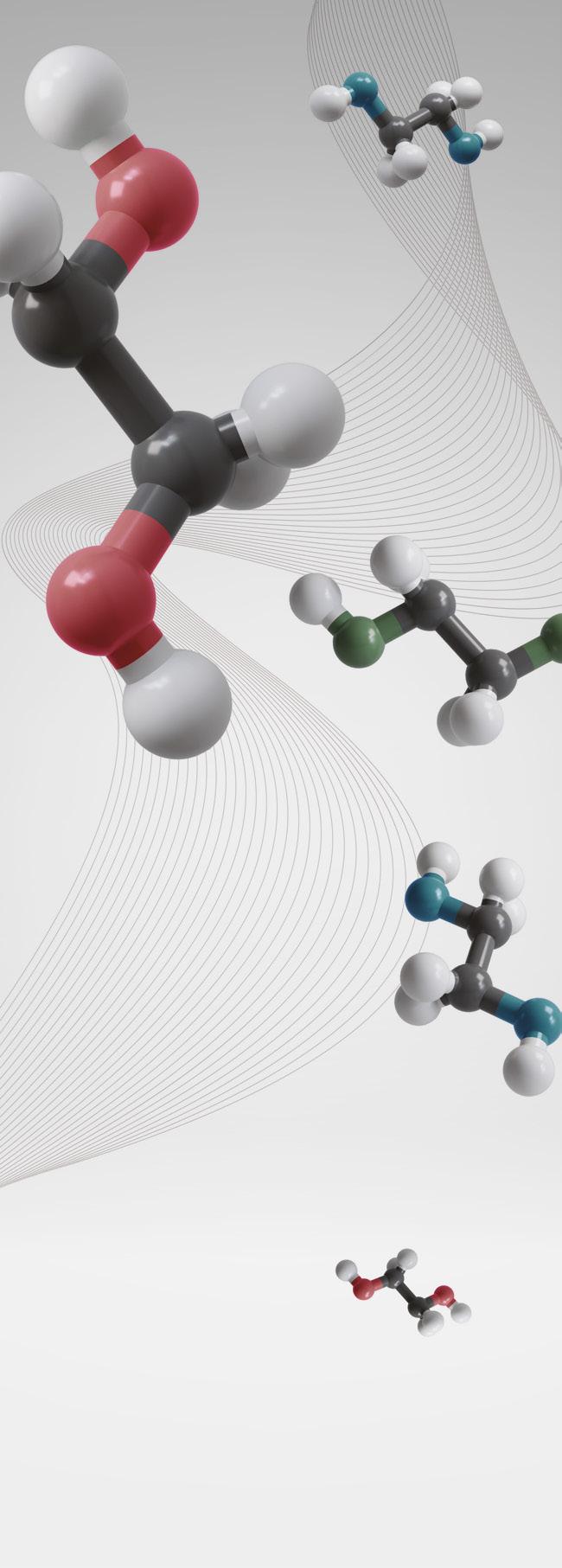
dell’evento: makeinitaly days 2023 frontiere dell’automazione industriale
ON ceramics
value
FOCUS
of
Paolo Monari
ADVERTISING
Antonella Baglio
Material textures: the role of chemicals
Trame materiche: il ruolo della chimica
Federico Piccinini, Smaltochimica (Fiorano Modenese, Italy)
In recent years, the ceramic industry has undergone profound changes that have redefined the very concept of ceramic tiles. Thanks to increasingly advanced technologies, ceramic tiles have evolved into high-value products with remarkable aesthetic appeal and exceptional technical performance, and can now compete successfully with prestigious materials such as wood, marble and natural stone. The key drivers of this transformation include digital decoration, large tile sizes, surface finishes and the application of various types of materials.
Organic chemicals have played an essential, albeit hidden role in this revolution. While not immediately perceptible once they have performed their function (they almost always disappear during the firing process), they must nevertheless guarantee precise, easy and reproducible application.
One of the keys to creating the most sophisticated and intricate ceramic surfaces lies in the ability of ceramic designers to bring a sense of three-dimensionality to their creations, making them original and difficult to imitate.
The use of grits is a powerful means of building textures and structures, bringing richness and depth to products.
Dry application is the most traditional technique. The first step involves application of a binder, generally using an airless spray system, after which solid material is deposited by means of a grit applicator. This process generally involves depositing a large quantity of granular vitreous material, which is subsequently lapped or polished to achieve compact surfaces with extraordinary depth and a high gloss level. The DRYCOL series stands out for its excellent bonding capacity, flowability and wettability. It is capable of bonding large quantities of grit without limitations on particle sizes. It is also suitable for fixing granulates, pellets, flakes and powders. Drycol products can also be used as final fixatives to consolidate the deposited material and prevent dust formation during firing.
Due to its exceptional versatility, the most widely used technique involves applying aqueous suspensions of micro-grits using traditional glazing applicators (mainly airless systems but in some cases curtain coaters). This method is ideal for producing natural, lapped or polished surfaces. It involves the preparation of mixtures called “slips” consisting of fine vitreous grits with controlled particle sizes, suspension agents/binders to aid application, water and in most cases glazes and/or fine ceramic raw materials in varying proportions.
The GRANICOL family consists of complex formulations designed to ensure low viscosity coupled with high flowability and wettability during application, resulting in exceptional, defect-free surface finishes. The high flow limit at rest prevents sed-
Negli ultimi anni il settore ceramico ha affrontato enormi cambiamenti che hanno trasformato il concetto di piastrella. Grazie a tecnologie sempre più sofisticate, la ceramica si è convertita in un materiale ad altissimo valore aggiunto, di grande impatto estetico ed ottime prestazioni tecniche, capace di competere con successo con materiali pregiati quali legno marmi, pietra naturale. Tra i protagonisti di questa metamorfosi annoveriamo la decorazione digitale, i grandi formati, le finiture superficiali e certamente l’apporto di materia nelle sue varie declinazioni.
Il ruolo della chimica organica in questa rivoluzione è tanto essenziale quanto silente: non immediatamente percepibile una volta esaurita la propria missione (quasi sempre svanisce con la cottura), deve comunque garantire un’applicazione precisa, facile, riproducibile. Una delle chiavi per dar vita alle superfici ceramiche più raffinate e complesse è rappresentata dalla capacità con cui i ceramisti donano tridimensionalità alle proprie creazioni rendendole originali e difficilmente imitabili. L’utilizzo delle graniglie rappresenta uno strumento potente per costruire trame e strutture, conferendo ricchezza e profondità ai prodotti. L’applicazione a secco è la tecnica più tradizionale: la fase solida si deposita tramite un granigliatore preceduto dalla stesura di un binder solitamente tramite airless. Generalmente si
deposita abbondante materia vetrosa granulare che viene successivamente lappata o levigata ottenendo superfici compatte, caratterizzate da estrema profondità ed elevato grado di gloss. La serie DRYCOL si distingue per eccellente capacità di adesione, elevata scorrevolezza, ottima bagnabilità. Consente l’aggrappo di elevati quantitativi di graniglie senza vincoli di granulometria. È adatta a fissare anche granulati, pellettizzati, scaglie e polveri. I prodotti Drycol possono essere impiegati anche come fissativi finali per consolidare la deposizione evitando fenomeni di spolvero in cottura.
La tecnica produttiva più utilizzata, grazie all’estrema versatilità, è la deposizione di sospensioni acquose di micro-graniglie mediante applicatori per smaltatura tradizionale (prevalentemente airless, in qualche caso vela). Questa metodica si presta all’ottenimento di superfici naturali, lappate o levigate. Consiste nella preparazione di miscele, denominate “sbobbe”, costituite da graniglie vetrose fini a granulometria controllata, coadiuvanti per l’applicazione con funzione sospensivante-legante, acqua e, nella maggior parte dei casi, smalti e/o materie prime ceramiche fini in proporzioni estremamente variabili.
La famiglia GRANICOL è costituita da formulati complessi, progettati per assicurare bassa viscosità, scorrevolezza e bagnabilità nelle fasi di applicazione, per ottenere ottime finiture superficiali esenti da difetti; l’elevato li-
48 CWR 154/2023


CONVEGNO CERAMICA DI VALORE
Tecnologie e materiali per le superfici del futuro
Martedì 17 ottobre
Con
Scansiona il QR Code per


imentation and consequent accumulation in the tank and booth. The range consists of a complete line of products to meet every production requirement, aligning with process needs, operational parameters and drying times.
The product line includes formulations optimised for high-density applications with high suspending power suitable for use with coarse grits or very low-density applications, as well as fluidised, self-levelling formulations capable of ensuring optimal application under all operating conditions. It also includes concentrated, easily dispersible powder versions to reduce warehousing space and cut down transport costs.
Glues for inkjet printing represent the latest frontier in this type of application. When used in full-field applications, they are ideal for large slabs as they reduce the volume of liquid phase deposited. Their ability to handle intricate graphic designs makes them the ideal choice for adding material to ceramic surfaces while fully exploiting the benefits of digital technology. They are extremely flexible and can be used across different areas of the production process, from surface finishing to decoration and even in creating three-dimensional structures. This effectively decouples the relief-forming stage from the press, enormously enhancing creative potential.
Smaltochimica offers an extensive array of digital glues, divided into three distinct families tailored to specific needs, whether functional, aesthetic or environmental. Suitable for use on dedicated stand-alone machines with integrated applicators or on standard machines in conjunction with conventional grit applicators, they are designed to maximise bonding strength and guarantee excellent results for full-field applications (for polished, lapped or natural surfaces) and for decoration.
The DIGICOL PLUS series comprises flexible products approved for use with the majority of commercially available printheads. Combining excellent performance and ease of use, they are available in a wide range of textures, from extra-glossy to non-reflective matt finishes.
The exclusive formulations of the DIGICOL PURE series play a pivotal role in controlling organic carbon emissions and minimising odorous components throughout the firing phases. This reduces the environmental impact of the production process without requiring alterations to production lines.
DIGICOL NEXT inks are a pioneering range of water-based products that significantly lower all the main emission parameters, namely carbon, aldehydes and odorous compounds. Designed exclusively for use with approved printheads, they are capable of binding very large quantities of grit and are compatible with commonly used digital inks. ◼
mite di scorrimento nella condizione di quiete evita fenomeni di sedimentazione e conseguenti accumuli nel mastello e nella cabina. La gamma si compone di un’intera linea di prodotti per soddisfare ogni esigenza produttiva sposando al meglio le necessità di processo, i parametri di esercizio e i tempi di asciugamento.
Esistono prodotti ottimizzati per le applicazioni ad alta densità e ad elevato potere sospensivante, adatti a graniglie grossolane o applicazioni a bassissime densità, formulazioni fluidificate, autolivellanti per assicurare una stesura ottimale in ogni condizione operativa, versioni in polvere concentrate e facilmente disperdibili per consentire risparmio di spazio nei magazzini e riduzione dei costi di trasporto.
Le colle per stampa a getto d’inchiostro rappresentano l’ultima frontiera di questa tipologia di applicazione. Se impiegate a campo pieno, sono ideali per le grandi lastre poiché consentono di ridurre i quantitativi di fase liquida depositata. La possibilità di lavorare su un pattern grafici dettagliati ne fa lo strumento più idoneo per conferire materia ai prodotti ceramici sfruttando al meglio i vantaggi del digitale. Estremamente flessibili, trovano collocazione in zone differenti della filiera produttiva: dalla finitura superficiale, al decoro fino alla costruzione di strutture tridimensionali che di fatto svincolano il rilievo dalla pressa aumentando espo-
nenzialmente le possibilità creative. Smaltochimica dispone di una vastissima gamma di colle digitali, articolata in tre famiglie distinte per identificare la soluzione più idonea ad ogni esigenza, sia essa funzionale, estetica o ambientale. Adatte all’uso in macchine stand alone dedicate con applicatore integrato, o in stampanti standard, abbinate a granigliatori tradizionali, sono studiate per massimizzare il potere di adesione e garantire ottimi risultati per applicazioni a campo pieno (per superfici levigate, lappate o naturali) e decorazione.
DIGICOL PLUS è costituita da prodotti flessibili, omologati per la maggior parte delle testine in commercio, che assicurano ottime prestazioni ed estrema facilità di uso. Sono disponibili in una vastissima gamma di texture dall’extra-glossy al matt anti-luce. Le formulazioni esclusive della serie DIGICOL PURE consentono di tenere sotto controllo le emissioni di carbonio organico e le componenti odorigene durante le varie fasi di cottura, migliorando l’impatto ambientale del processo produttivo. Non necessitano di modifiche alle linee produttive. Gli inchiostri DIGICOL NEXT rappresentano un innovativo sistema di prodotti base-acqua che abbattono significativamente tutti i parametri emissivi comunemente rilevati: carbonio, aldeidi ed odorigeni. Utilizzabili esclusivamente con testine omologate, consentono di legare elevatissimi quantitativi di graniglia e sono compatibili con gli inchiostri digitali di uso comune. ◼
49 CWR 154/2023
In collaborazione con: Sponsored by: Nell’ambito dell’evento: makeinitaly days 2023 Le nuove frontiere dell’automazione industriale FOCUS ON ceramics of value
Piccinini
la partecipazione di:
Federico
rivedere
integrale
l’intervento
Design technology: an integrated line for 3D products
La tecnologia del design: una linea integrata per prodotti 3D
Cristian Venturelli, Luca Migliori, Gruppo B&T (Formigine, Italy)
Gruppo B&T, a manufacturer of complete plants for the ceramic and agglomerated quartz industries, focuses on several key elements for creating value within the ceramic sector. These include consistently achieving aesthetically flawless and reproducible natural effects on finished ceramic products, providing comprehensive support to customers throughout the production process, and cutting production costs while maximising energy savings.
To consistently maintain these high standards, the company has developed a complete and integrated line equipped with cutting-edge technologies based on the intensive R&D efforts undertaken at bt-LAB, the group’s dedicated technology centre, in close cooperation with its partners. The aim is to create ceramic products with unique designs inspired by nature, ensuring maximum productivity in sizes up to 200x400 cm and thicknesses ranging from 6 to 30 mm
The creation of distinctive ceramic surfaces begins prior to pressing, with the preparation of spray-dried powders and decorative materials.
Gruppo B&T proposes three patented solutions for these applications called Dune, Lapis and Venus, each of which can be used individually or in combination with the others to create surprising designs ideal for kitchen countertops and vanity units.
Dune is a powder handling technology installed at the press infeed to create unique full-body stratifications . The full-body aesthetic effects can also include flakes, micronised powders, thin layered veins and colour variations and in turn can be enhanced with digital decoration.
The Venus system, on the other hand, combines full-thickness aesthetic effects with synchronised digital decoration on the downstream glazing line, creating an elegant, classic and refined design capable of enhancing any surface. This technology is capable of producing veined patterns made up of multiple veins, micronised powders and shade variations, and relies on Lynx , Projecta’s new patented vein recognition vision device, to ensure perfect alignment between the through-vein effects and digital printing . This technology can handle up to 8 input colours to deliver a wide range of single- and double-loaded and full-body products.
Finally, Lapis is a full thickness decoration technology capable of creating veins (including digital veins) with different depths and dimensions, multiple colours, multiflakes and dry coloured powders. Here too, Lynx can be used to align the through-vein
La costante aspirazione al raggiungimento della perfezione estetica e ripetibile degli effetti naturali sul prodotto ceramico finito; il supporto al cliente lungo tutta la linea produttiva per renderlo partner di un progetto completo; la riduzione dei costi di produzione e l’energy saving. Sono questi gli aspetti principali che generano valore in ambito ceramico secondo Gruppo B&T, produttore di impianti completi per l’industria ceramica e del quarzo agglomerato. Per garantire questi standard elevati ogni giorno, l’azienda ha sviluppato una linea completa ed integrata con le migliori tecnologie, frutto dell’intensa attività di R&D condotta in bt-LAB, il suo centro tecnologico e in stretta collaborazione con i partner, per creare prodotti ceramici dal design unico, ispirato alla natura stessa, garantendo il massimo della produttività e dimensioni fino a 200x400 cm con spessore da 6 a 30 mm
La creazione di superfici ceramiche distintive comincia prima della pressatura, dalla preparazione delle polveri atomizzate e dei materiali decorativi. In questo ambito sono tre le soluzioni proposte e brevettate - Dune, Lapis e Venusognuna delle quali, da sola o in combinazione con le altre, dà vita a design sorprendenti, perfetti per top da cucina e vanity.
Dune è la tecnologia di gestione delle polveri, in alimentazione alla pressa, che permette di creare stratificazioni uniche a tutta massa. Gli effetti estetici a tutto spessore possono includere anche scaglie, micronizzati, vene sottili stratificate, variazioni cromatiche ed essere impreziositi a loro volta con la decorazione digitale.
Il sistema Venus invece combina effetti estetici a tutto spessore con la successiva e sincronizzata decorazione digitale sulla linea di smaltatura a valle, creando un design elegante, classico e raffinato, capace di esaltare qualsiasi superficie. Questa tecnologia consente di realizzare venati composti da più vene, micronizzati e stonalizzati e si avvale di una sincronizzazione fra vena passante e stampa digitale con Lynx, il nuovo dispositivo di visione per il riconoscimento della vena brevettato da Projecta. Gestione fino a 8 colori in ingresso per garantire un ampio range di prodotti, in singolo e doppio caricamento e a tutta massa. Infine Lapis è la tecnologia di decorazione a tutto spessore che consente la realizzazione di venature, anche digitali, con differenti profondità e dimensioni, multicolori, multiflakes e con polveri colorate a secco. Anche in questo caso è possibile l’abbinamento fra vena passante e stampa digitale con Lynx. Le venature possono essere posizionate in qualsiasi punto della lastra e nel numero desiderato. La
50 CWR 154/2023


CONVEGNO CERAMICA DI VALORE
Tecnologie e materiali per le superfici del futuro
Martedì 17 ottobre 2023

effect with the digital printing. The veins can be produced in the desired number anywhere on the slab. This solution is ideal for matt or glossy surface finishes

Dune, Lapis and Venus are fully compatible and achieve the best results with SITI’s innovative mouldless press Supera®, which is ideal for both large and more traditional sizes while maintaining a very high level of productivity, lowering manufacturing costs and guaranteeing customers the ability to manufacture products that are unique on the market.
Following the dryer, the complete line continues with digital decoration technologies produced by Projecta. In addition to the above-mentioned Lynx, these include:
• Innova Glaze with high-discharge printheads for digital glaze application;
• the new Digifix to create natural textures as well as effects with functional fluids;
• the digital printers PRO, Mega and Innova , the latter being a modular technology that can accommodate up to 20 colour bars;
• and finally 3D decoration obtained with Dryfix , the only printer on the market designed specifically for digitalised application of powders and capable of creating deep textures, material decorations and high-gloss full lappato effects. All the technologies are supported by the new Sprinta software.
Any discussion of product aesthetics must include the added value obtained in the finishing phase. With this in mind, the line is complemented by Ancora’s latest technologies, including Tornado , the fully automated dry squaring machine for large production runs in sizes up to 360 cm and thicknesses from 3 to 40 mm; Matrix , a lapping and polishing machine specially designed for large slabs and capable of extremely versatile configurations, thereby eliminating downtime; and Powerlux , a high-end technology for a super-gloss treatment with gloss levels from 30 to 50 points on both traditional and large sizes up to 200 cm. ◼


soluzione è perfetta per finiture superficiali opache o lucide.
Dune, Lapis e Venus sono perfettamente compatibili e trovano il massimo della loro espressione con Supera®, l’innovativa pressa senza stampo di SITI, ideale sia per grandi formati che per quelli più tradizionali, mantenendo un’altissima produttività, abbattendo i costi di fabbrica e garantendo al cliente la realizzazione di prodotti unici sul mercato. La linea completa prosegue, dopo l’essiccatoio, con le tecnologie di decorazione digitale prodotte da Projecta. Oltre al già citato Lynx, parliamo di:
• Innova Glaze con testine ad alto scarico, per l’applicazione dello smalto digitale;
• la nuova Digifix per realizzare strutture naturali e definite ed effetti con fluidi funzionali;
• le stampanti digitali PRO, Mega e Innova, quest’ultima una tecnologia modulare che può arrivare fino a 20 barre colore;
• e, infine, la decorazione 3D ottenuta con Dryfix, la stampante unica sul mercato dedicata all’applicazione digitalizzata di polveri, in grado di realizzare strutture profonde, decori materici e full lappato high gloss distintivi.
Tutte le tecnologie sono supportate dal nuovo software Sprinta
Quando si parla di estetica del prodotto non si può tralasciare il valore aggiunto ottenuto in fase di finitura. Per completare la linea si inseriscono le ultime tecnologie di Ancora tra cui: Tornado, la squadratrice a secco totalmente automatizzata per grandi produzioni in formati fino al 360 cm e con spessori da 3 a 40 mm; Matrix, la lappatrice e levigatrice specifica per grandi lastre, capace di un’estrema versatilità di configurazione azzerando i fermi di produzione; e Powerlux, tecnologia top di gamma per un trattamento super gloss dai 30 ai 50 punti sia sui formati tradizionali sia sui più grandi, fino ai 200
cm. ◼ 51 CWR 154/2023
partecipazione di: Sponsored by: Nell’ambito dell’evento: makeinitaly days 2023 Le nuove frontiere dell’automazione industriale FOCUS ON ceramics of value
Con la
Cristian Venturelli
Luca Migliori
il QR Code per rivedere l’intervento integrale
Scansiona
Digital innovation in natural ceramic textures
Innovazione digitale nelle strutture ceramiche naturali
Alan Nappa, Riccardo Mazzi - Sicer (Italy)
Digital innovation has always evolved in step with market trends, and this is particularly evident in the current market landscape dominated by demand for natural-looking ceramic textures.
This has led to considerable research and development efforts aimed at fully exploiting the benefits of digital products in terms of cost optimisation and the potential for rapid and extensive customisation.
To add three-dimensionality to the ceramic surface without using an engraved punch or a dedicated roller, Sicer has developed various types of digital texturing agents suitable for different uses and desired final effects.
The texturing agent has a water repellency effect on the subsequently applied engobe and/or glaze and burns off in the kiln, leaving gaps on the tile surface. This results in a visible and tactile texture that can be further improved by combining the texturing agent with engobes and glazes with specific chemical/physical properties.
The first new product proposed by Sicer is a non-material-effect texturing agent with high repellency. Ideal for creating large surface gaps, this texturing agent has been specially developed for the production of large slabs and can be applied prior to the dryer, because even when dry its special formulation enables it to retain its water-repellency and resist effect. As a result, it is possible to apply engobe or glaze even after a period of several days.
The Sicer range also includes an opaque material-effect texturing agent that is ideal for more traditional tile sizes but can also be used effectively on slabs. Its high level of detail and sharp edges make it ideal for reproducing natural stone with strongly defined incisions or wood with fine engravings. Unlike the previous texturing agent, the engobe or glaze must be applied while the product is still wet, i.e. just a few metres down the line from the point where the texturing agent is applied.
Finally, to cater for all requirements, Sicer has also developed a transparent matt material-effect texturing agent suitable for dark coloured designs or for the production of wood-effect tiles. It has the same characteristics as the previous texturing agent, and the two can be used in combination to create both transparent and opaque surfaces after firing.
To maximise the texturing effect of the digital product, it is important to perform an in-depth analysis of the engobes or
Innovazione digitale e tendenza di mercato sono sempre andati di pari passo in un contesto in cui la ricerca di strutture ceramiche naturali è sempre più centrale.
Molto è stato ricercato e sviluppato in questo senso per sfruttare al massimo i punti di forza dei prodotti digitali, ossia, da un lato, l’ottimizzazione dei costi, e, dall’altro, le molteplici e veloci possibilità di personalizzazione.
Per conferire tridimensionalità alla superficie ceramica anche senza l’utilizzo di un tampone inciso o di un rullo dedicato, Sicer ha studiato differenti tipi di strutturanti digitali a seconda dell’utilizzo e dell’effetto finale ricercato.
Lo strutturante agisce come un idrorepellente per la successiva applicazione di un engobbio e/o dello smalto: bruciando nel forno, lo strutturante lascia degli spazi vuoti, quindi una struttura rilevabile all’occhio e al tatto, migliorando ulteriormente la performance se abbinato ad engobbi e smalti con precise caratteristiche chimico/fisiche.
Il primo strutturante proposto da Sicer è non materico ad alta repellenza. Ideale per ottenere “aperture” molto ampie, questo strutturante è stato sviluppato appositamente per la produzione di grandi lastre e può essere utilizzato anche prima dell’essiccatoio, poiché, anche da asciutto,
mantiene l’effetto idrorepellente e riservante grazie ad una formulazione dedicata; per questa ragione è quindi possibile applicare l’engobbio o lo smalto anche dopo diversi giorni. La gamma Sicer comprende anche uno strutturante materico coprente, ideale per formati ceramici più tradizionali, ma utilizzabile e funzionale anche su lastre; si caratterizza per l’alto dettaglio con bordi a spigolo vivo ed è quindi ottimale per la riproduzione di pietre naturali con incisioni molto definite o di legni con incisioni sottili. A differenza dello strutturante precedente, l’engobbio o smalto deve essere applicato a strutturante ancora umido, ossia pochi metri dopo lo strutturante stesso. Infine, per rispondere ad ogni tipo di esigenza, Sicer ha realizzato anche uno strutturante materico matt trasparente utilizzato per le grafiche scure o la produzione di ceramica a effetto legno; possiede le stesse caratteristiche dello strutturante precedente, a cui può essere abbinato nel caso si vogliano realizzare sia superfici trasparenti che coprenti dopo cottura.
Per massimizzare l’effetto struttura del prodotto digitale, è fondamentale la ricerca dei materiali abbinati - engobbi o smalti – che devono avere caratteristiche reologiche specifiche, così come lo studio del disegno grafico che può aiutare a rendere l’incisione più visibile e percepibile.
52 CWR 154/2023


CONVEGNO CERAMICA DI VALORE
Tecnologie e materiali per le superfici del futuro
Martedì 17 ottobre 2023
Con la partecipazione di:

glazes it is used in combination with to ensure they have the right rheological characteristics. It is also necessary to study the graphic design, which can enhance the visibility of the incision.
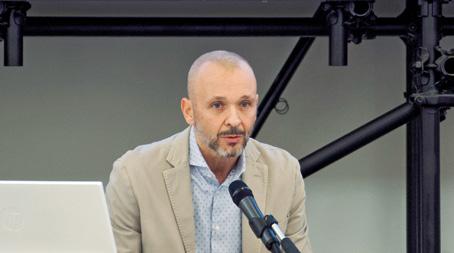
One additive technique that can be used to create a material-effect texture involves adding a digital glue + grit application to the resist effect of the texturing agent. This significantly increases the thickness of the texture and gives the ceramic surface a more natural look.
Sicer’s latest research has led to the development of two types of digital glue: a water-based glue with almost zero emissions approved for use with the printheads currently on the market; and a brand new low-emissions solvent-based matt glue which opens up a whole new range of aesthetic possibilities for natural surfaces.
This material-effect matt glue is designed to complement glossy solvent-based glues suitable for full-lapped and/or glossy grits and results in a neutral appearance after firing. It can also be used effectively in conjunction with grits designed to enhance the matt surface.
The key characteristics of this innovative product are its versatility and multifunctionality.
By studying a specific inorganic material-effect component, Sicer has developed a product that is capable of optimising technical/aesthetic results both with dry applications of matt grit and with applications of vitrified glossy grit.
Sicer’s new matt glue is the company’s flagship product for creating textured material-effect ceramic surfaces. It has developed a matt vitreous mixture and a compact glossy vitreous mixture (both with a dedicated particle size) which can be used in conjunction with a special surface finish to create three-dimensional vitreous decorations characterised by very low reflection and consequently very natural-looking edge areas.
By combining the two vitreous mixtures using the latest multiple grit deposition systems, a single line can rapidly (and simultaneously) produce a wide range of natural surfaces, thereby optimising costs and production time. ◼

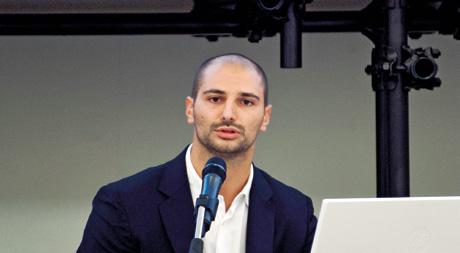
Una tecnica additiva per completare la creazione di una struttura materica consiste nell’aggiungere all’effetto riservante dello strutturante anche un’applicazione di colla digitale + graniglia. Questo aumenta notevolmente lo spessore della struttura e conferisce più naturalezza alla superficie ceramica.
Le ultime ricerche di Sicer hanno portato alla realizzazione di due tipologie di colle digitali: una colla base acqua a emissioni quasi nulle, omologata per le testine attualmente sul mercato; e una nuovissima colla matt a base solvente low emission, che apre un inedito ventaglio di possibilità estetiche per le superfici naturali.
Questa colla matt materica è stata ideata come corredo alle colle a base solvente lucide (ideali per full lappato e/o con graniglie lucide) per ottenere un aspetto neutro dopo cottura, perfetto anche in abbinamento a graniglie appositamente studiate per valorizzare la superficie matt. I punti focali di questo innova-
tivo prodotto sono la versatilità e polivalenza.
Lo studio di una componente materica inorganica specifica ha portato infatti all’ottenimento di un prodotto in grado di massimizzare il risultato tecnico/estetico sia con applicazioni a secco di graniglie matt, sia con applicazioni di graniglie lucide vetrificate.
La nuova colla matt di Sicer è il prodotto di punta per la realizzazione di superfici ceramiche strutturate e materiche: attraverso lo studio mirato di una miscela vetrosa matt e una miscela vetrosa lucida compatta (entrambe con granulometria dedicata) e di una finitura superficiale, il produttore è in grado di ottenere decorazioni vetrose tridimensionali, caratterizzate da zone di bordo a bassissima riflessione, quindi molto naturali. Accorpando la presenza simultanea delle due miscele vetrose tramite gli ultimi sistemi di deposizione multipla di graniglie, una singola linea potrà realizzare velocemente (e contemporaneamente) un’ampia gamma di superfici naturali, ottimizzando costi e tempi di produzione.
◼ 53 CWR 154/2023
Sponsored by: Nell’ambito dell’evento: makeinitaly days 2023
nuove frontiere dell’automazione industriale
Le
FOCUS ON ceramics of value
Alan Nappa Riccardo Mazzi
Scansiona il QR Code per rivedere l’intervento integrale
High-value ceramics according to BMR
La ceramica di valore secondo BMR
Marco Sichi, BMR (Scandiano, Italy)
While the ceramic end-of-line stage has traditionally been prone to subjective assessments, the current goal is to develop systems and solutions that prioritise objectivity. This sense of objectivity is the added value that BMR consistently strives to bring to its processes in order to deliver the very best finishing technology to its global clientele. Driven by this vision, BMR has progressively implemented state-of-the-art systems encompassing artificial intelligence, process vision and digitalisation with the goal of developing lines that not only ensure objectivity but also allow for extensive customisation of ceramic surfaces.
The new versions of Leviga and Supershine, namely LeviCompact and Supershine Plus, draw inspiration from these latest technological advances.
LeviCompact is an exclusive BMR-patented solution for lapping, satin finishing and polishing large slabs with widths of 1200 mm, 1600 mm and 1800 mm. It is the first solution in the world to feature two parallel oscillating bridges with 10 heads each, allowing for higher speeds and greater uniformity than conventional solutions. These characteristics increase productivity while minimising the risk of aesthetic defects on finished products.
LeviCompact offers even higher performance in terms of digitalisation and customisation. This solution introduces a new graphic interface for easier viewing and greater control. The use of dedicated proportional valves allows the pressure to be controlled digitally and replaces the need for manual adjustments. Operators can also set three different working areas (operator side, centre and the side opposite the operator) where different pressures can be applied to the material. By setting the desired absorption set point, the system balances the pressure in such a way as to control the removal of ceramic material, thereby avoiding waste. The machine is also equipped with a system for recording abrasive changes whereby the operator enables an abrasive change and the machine logs the number of operational hours completed. Supervisors can access this information via the PLC to monitor production efficiency and decide to replace the tool when it is no longer suitable.
Supershine Plus, with a range from 16 to 20 heads, is the new version of BMR’s flagship Supershine machine. The new version is able to handle one or more products separately thanks to the use of peristaltic pumps equipped with two feed chan-
Il fine linea ceramico conosciuto fino ad ora era soggetto, perdonate il gioco di parole, alla soggettività. L’obiettivo oggi è invece quello di creare sistemi e soluzioni per un fine linea che sia il più oggettivo possibile. Questo è il valore aggiunto per il quale BMR lavora ogni giorno, con l’intento di fornire ai propri clienti in giro per il mondo le migliori tecnologie per la finitura. Spinti da tale propensione, BMR in questi anni sta implementando sui propri prodotti i più moderni sistemi legati a intelligenza artificiale, visione dei processi e digitalizzazione, per avere una linea non solo oggettiva, ma anche con un alto grado di personalizzazione della superficie ceramica realizzata.
Plasmate da queste nuove prospettive tecnologiche, ecco quindi le nuove versioni di Leviga e Supershine, ovvero LeviCompact e Supershine Plus
LeviCompact è un’esclusiva soluzione brevettata BMR per la lappatura, la satinatura e la lucidatura di grandi lastre con larghezza 1200-1600-1800 mm. Si tratta della prima soluzione al mondo dotata di due ponti oscillanti paralleli da 10 teste ciascuno, che consentono una maggiore velocità e una maggiore uniformità rispetto alle soluzioni tradizionali.
Caratteristiche che ne aumentano la produttività limitando al massimo la possibilità di difetti estetici delle lastre.
LeviCompact offre prestazioni ancora più elevate, in direzione digital e custom. La soluzione presenta una nuova interfaccia grafica per una lettura più facilitata ed un miglior controllo. Attraverso apposite valvole proporzionali è possibile regolare la pressione in maniera digitale (e non più manuale). Inoltre, l’operatore potrà impostare tre diverse fasce di lavoro (lato operatore, centro e lato opposto all’operatore) per variare la pressione esercitata sul materiale. Impostando poi il Set point di assorbimento voluto, il sistema bilancia la pressione in modo da regolare l’asportazione del materiale ceramico, evitando gli sprechi. La macchina inoltre è dotata di un sistema che registra il cambio degli abrasivi: l’operatore abilita il cambio abrasivo e la macchina registra le ore di lavoro effettuate. Il supervisore può leggere il registro dal PLC e verificarne così la produzione e determinarne la sostituzione dell’utensile quando non più idoneo. Supershine Plus, con gamma a 16 e 20 teste, è la nuova versione del must di BMR, la Supershine: la nuova versione garantisce la gestione di uno o più prodotti in modo separato grazie alle pompe peristaltiche per il dosaggio del prodotto, che vengono dotate di due
54 CWR 154/2023


CONVEGNO CERAMICA DI VALORE
Tecnologie e materiali per le superfici del futuro
Martedì 17 ottobre 2023 Con

nels for product dosing. The pumping system with ModBus communication has been replaced by a more powerful system equipped with an EtherCat communication channel which guarantees more rapid and precise dosing and consequently reduced material losses. Thanks to temperature control, it increases processing uniformity and avoids problems caused by temperature fluctuations. Supershine Plus is the first and only dry super polishing machine capable of digitalising the entire polishing and treatment process, as well as obtaining an unlimited range of finishing solutions, all of which can be replicated using a tested procedure. Thanks to the new digital equipment, Supershine Plus uses software-controlled satellite heads to apply product A, then applies product B to give the surface the specific functional characteristics requested by the customer. In this process, Supershine makes the surface safe and resistant to scratching, foot traffic wear, stains and mould

canali di alimentazione. Il sistema di pompaggio con comunicazione ModBus è stato sostituito con quello più prestazionale dotato di canale di comunicazione EtherCat, che garantisce un dosaggio più rapido e più preciso, quindi limitando la dispersione del materiale.

è la prima e unica super-lucidatrice a secco che può garantire la digitalizzazione dell’intero processo di lucidatura e trattamento, nonché l’ottenimento di infinite soluzioni di finitura, replicabili grazie ad un iter collaudato.
Grazie alle nuove componenti digitali, la Plus utilizza, tramite il software, le teste satellitari per effettuare la stesura di un prodotto A, per poi ricorrere a un prodotto B per conferire alla superficie le specifiche funzionalità richieste dal cliente. In tutto questo processo, la Supershine rende la superficie sicura e resistente a graffi, calpestio, macchie e muffe
However, the latest new machine to emerge from the Scandiano factory is WOF (World of Finishes), a new finishing concept that represents a remarkable technical revolution. This new operating philosophy involves the use of specific finishing systems and paves the way for the world of digital finishing. Today, thanks to WOF, it is possible to use lapping machines to achieve any kind of finish by harnessing the synergy between tools and software. This new breakthrough from BMR opens up unprecedented potential for creating unique, customised and original tiles while maintaining the ability to reproduce them consistently from a proven recipe. ◼
E grazie al controllo della temperatura aumenta l’uniformità della lavorazione sul processo evitando problematiche dovute agli sbalzi di temperatura. Supershine Plus

Ma l’ultima novità in termini cronologici uscita dallo stabilimento di Scandiano è WOF (World of Finishes): si tratta di un nuovo concetto di finitura che rappresenta una notevole rivoluzione tecnica, un nuovo atteggiamento operativo che si concretizza in specifici sistemi di finitura e che apre le porte al mondo della finitura digitale. Oggi, grazie a WOF, è possibile realizzare qualsiasi tipo di finitura nelle macchine lappatrici sfruttando la sinergia tra gli utensili e il software. In questo modo BMR dà il via a una nuova possibilità: creare piastrelle uniche, personalizzate, originali, ma riproducibili grazie a una ricetta collaudata. ◼
55 CWR 154/2023
la partecipazione di: Sponsored by: Nell’ambito dell’evento: makeinitaly days 2023 Le nuove frontiere dell’automazione industriale
ON ceramics
FOCUS
of value
Marco Sichi il QR Code per rivedere l’intervento integrale
Scansiona
A World of Finishes
“World of Finishes”, un mondo di superfici
Marco Scalari and Fabrizio Battaglia, Surfaces Group (Italy)
The WOF (World Of Finishes) project introduced by Surfaces Group marks a significant technical breakthrough, a new operational approach based on specialised finishing systems. Effectively, World of Finishes serves as a gateway to the world of digital finishing
By adopting WOF, lapping machines can be used to achieve any kind of finish through the combination of Surfaces Group tools and BMR software and using textures created either by the press or by digitally applied grits or glazes. WOF opens up unprecedented potential for creating unique, customised and original tiles while maintaining the ability to reproduce the effects consistently from a proven recipe.
Although the dominant trend up to now has focused on timeworn natural stone with irregular surfaces and alternating dull and shiny areas, the system can actually be used to achieve any desired effect.
So how does World Of Finishes work?
BMR’s new software allows the lapping machine to perform a series of controlled, programmable and repeatable actions capable of achieving any desired result or surface effect.
Surfaces creates the recipe which is introduced into the software and acts as a reference for the lapping machine, which follows the pre-established settings to achieve the same result in a repeatable manner. The recipes provided by Surfaces effectively consist of a sequence of technical parameters that the machine has to follow (single head control, head working time, head pause time, possibility of excluding heads), combined with a series of innovative abrasives tailored specifically to the new operating approach.
Essentially, the WOF proposal consists of:
• dedicated software for creating work cycles for each head (the number of which can be adapted to requirements);
• an electromechanical kit produced by BMR, complete with operational recipes (sequences, movements, working times, etc.);
• a simulator that allows for the faithful transfer of information from a test machine to an industrial-scale version;
• dedicated state-of-the-art tools optimised for this specific process.
In practical terms, the simulator present in Surfaces’ pilot plant in Sassuolo is able to create a simulation of the WOF machining process using a BMR machine and Surfaces tools. The next step involves inputting the machine’s specific data
WOF, acronimo di World Of Finishes, è un nuovo progetto di Surfaces Group che rappresenta una notevole rivoluzione tecnica, un nuovo atteggiamento operativo, che si concretizza in specifici sistemi di finitura. World of Finishes, infatti, apre le porte al mondo della “finitura digitale”.
Oggi, grazie a WOF, è possibile realizzare qualsiasi tipo di finitura nelle macchine lappatrici sfruttando la sinergia tra gli utensili Surfaces Group e il software BMR e l’utilizzo di strutture o da pressa o ricavate da graniglie applicate in digitale o smalti. WOF ha dato il via a una nuova possibilità: creare piastrelle uniche, personalizzate, originali. Uniche, ma riproducibili grazie a una ricetta collaudata. La tendenza prevalente realizzata finora è stata quella della pietra naturale, consumata dal tempo: superfici irregolari, ricche di zone opache e lucide alternate. Tuttavia, è possibile realizzare qualsiasi effetto desiderato.
Come funziona World Of Finishes?
Il nuovo software di BMR permette alla lappatrice di eseguire una serie di azioni controllate, programmabili e ripetibili, in grado di fornire qualsiasi risultato o effetto desiderato sul prodotto. Surfaces, invece, crea la ricetta che, inserita nel softwa-
re, funge da linea guida per la lappatrice ed è quindi in grado di garantire lo stesso risultato in modo ripetibile, seguendo le impostazioni prestabilite.
Le ricette fornite da Surfaces saranno a tutti gli effetti una sequenza di parametri tecnici che la macchina dovrà seguire (controllo singola testa, tempo lavoro testa, tempo pausa testa, possibilità di escludere delle teste), abbinati alla nuova logica di lavoro e conseguentemente accompagnata da una serie di abrasivi innovativi appositamente studiati.
In sintesi, la proposta WOF consiste in:
• un software dedicato che permette di creare cicli di lavoro per ogni testa (molteplici a seconda delle esigenze);
• kit elettromeccanico realizzato da BMR, con una ricetta operativa (sequenze, movimenti, tempi di lavoro, ecc…);
• un simulatore che permette il passaggio fedele delle informazioni da macchina test a macchina industriale.
• utensili di ultima generazione dedicati per questo processo specifico.
In pratica, il simulatore, presente nel Pilot Plant di Surfaces a Sassuolo permette di creare una simulazione del processo di lavorazione WOF basato su macchina BMR e utensili Surfaces, mentre quest’ultima inserisce i dati puntuali della macchina e verifica il corretto setup
56 CWR 154/2023


VALORE
materiali per le superfici del futuro

days 2023

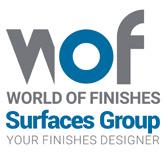
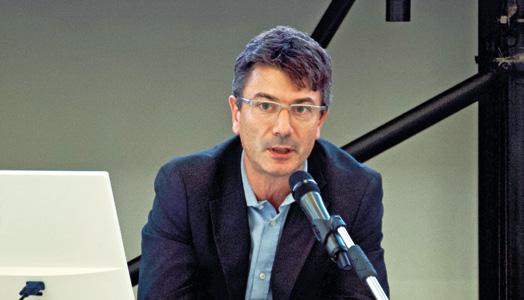

and verifying the correct setup to achieve the best machining process. After processing, the simulator is able to provide a variety of statistics on the coverage of the ceramic surface achieved with one or more heads, allowing operators to decide which area of the product to focus on. The machine can naturally be equipped with a wide variety of tools.
When contemplating the future of ceramics and strategies for enhancing the material’s value, World Of Finishes emerges as one of the new technologies poised to play a leading role in the years to come. ◼
per ottenere la migliore lavorazione.
Dopo l’elaborazione, il simulatore è in grado di fornire diverse statistiche sulla copertura di una o più teste sulla superficie ceramica; questo permette agli operatori di decidere in che zona del prodotto andare a lavorare. La macchina può essere ovviamente allestita con i più svariati utensili.
Se pensiamo alla ceramica del futuro e a come darle valore, World Of Finishes si posiziona tra le nuove tecnologie destinate a diventare protagoniste nei prossimi tempi. ◼


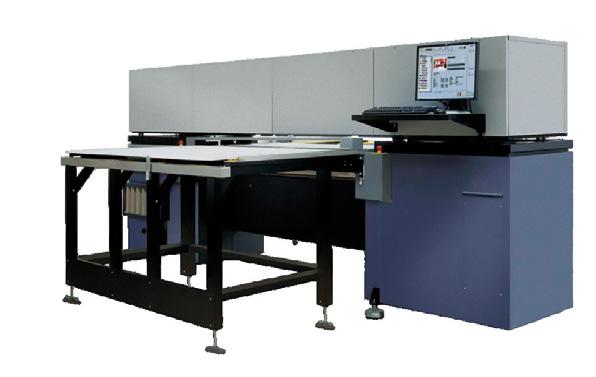
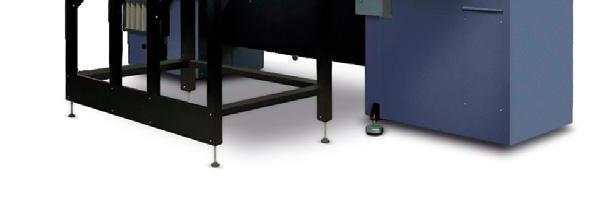
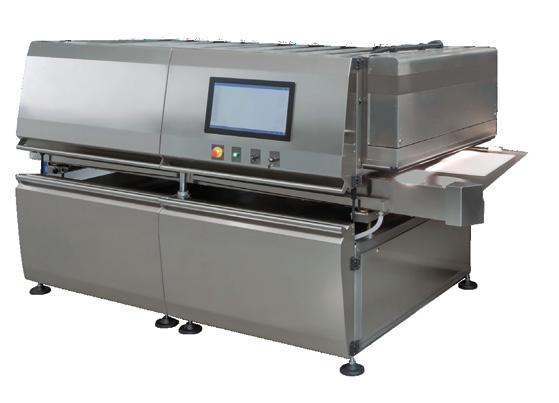
BE OPEN TO SECOND HAND
BE OPEN TO


scopri di più tradeco-srl.it
ADVERTISING
makeinitaly
frontiere dell’automazione industriale FOCUS ON ceramics of value
dell’evento:
Marco Scalari
Fabrizio Battaglia
Scansiona il QR Code per rivedere l’intervento integrale
World sanitaryware exports and imports
Export e import mondiale di sanitari
Luca Baraldi, MECS / Acimac Research Dept. (l.baraldi@mecs.org)
World ceramic sanitaryware import/export flows grew by 71.3% from 2.16 million to 3.7 million tonnes over the period 2010-2022, corresponding to a compound annual growth rate of 4.6%. However, the positive trend that continued for almost the entire period (with the exception of 2020, due to the pandemic) was interrupted again in 2022 with a 5.6% decline in exports compared to 2021 . This negative trend was observed in practically all geographical areas of production and in the major exporting countries.
Asia remained the largest world sanitaryware exporter, increasing its share of world exports to 66% despite a 3.5% fall to 2.44 million tonnes in 2022. This was a combined result of contractions in almost all the major Asian exporting countries, namely China, India, Thailand and Vietnam, with the only positive exception being Iran.
Exports from the European Union , the world’s second largest exporter, also fell by 3.7% to 520,000 tonnes. The three largest exporting countries alone accounted for half of EU exports, but followed different trajectories, with Poland and Portugal maintaining their 2021 levels, while Germany’s exports declined by 4.6%. Exports from North America (NAFTA) suf-
Nel periodo 2010-2022, i flussi globali di import-export di articoli sanitari in ceramica sono aumentati del 71,3%, da 2,16 a 3,7 milioni di tonnellate, con un tasso di crescita annuo composto del 4,6%. Il trend positivo che ha caratterizzato quasi tutto l’arco temporale (ha fatto eccezione il 2020, causa pandemia), si è tuttavia nuovamente interrotto nel 2022, chiuso con una flessione dell’export del 5,6% sul 2021. L’andamento negativo si è riscontrato praticamente in tutte le aree geografiche di produzione e nei maggiori paesi esportatori.
L’Asia si conferma il maggior esportatore mondiale di sanitari rafforzando la sua quo-
ta sull’export mondiale al 66%, nonostante il calo del 3,5% nel 2022, a 2,44 milioni di tonnellate; a tale risultato hanno contribuito le contrazioni dei maggiori esportatori asiatici - Cina, India, Tailandia, Vietnam - con l’unica eccezione positiva in Iran. In calo del 3,7% anche l’export dell’Unione Europea, secondo maggiore esportatore mondiale, sceso a 520mila ton.; qui, i tre maggiori paesi esportatori coprono da soli la metà dell’export UE, ma hanno avuto un’evoluzione diversa: Polonia e Portogallo hanno mantenuto i livelli del 2021, mentre la Germania ha segnato una flessione del 4,6%. Un calo più pesante, a doppia cifra, ha riguardato l’export del Nord America
Source: Mecs / Acimac Research dept. on BSRIA and ITC data
area
2010 2015 2016 2017 2018 2019 2020 2021 2022 % 22/21 CAGR 22/10 % on 2022 world exports Asia 1,100,506 1,697,734 1,603,571 1,756,791 1,988,977 2,220,614 2,127,623 2,533,625 2,444,509 -3.5% 6.9% 66.0% European Union 522,118 569,475 583,409 570,549 585,034 541,584 488,917 539,775 519,756 -3.7% 0.0% 14.0% Other Europe 132,132 185,960 187,805 203,077 220,127 237,166 235,176 291,352 253,113 -13.1% 5.6% 6.8% NAFTA 268,401 340,565 368,326 366,973 375,412 365,789 368,372 379,235 327,907 -13.5% 1.7% 8.9% South America 100,043 72,548 80,315 79,513 89,375 86,782 78,814 99,853 84,479 -15.4% -1.4% 2.3% Africa 35,861 84,042 71,958 65,933 66,113 75,238 64,296 79,216 73,571 -7.1% 6.2% 2.0% Oceania 1,960 902 1,084 411 583 580 315 364 867 138.2% -6.6% 0.0% TOTAL WORLD 2,161,021 2,951,226 2,896,468 3,043,247 3,325,621 3,527,753 3,363,513 3,923,420 3,704,202 -5.6% 4.6% 100.0% % var y-o-y 2.1 -1.9 5.1 9.3 6.1 -4.7 16.6 -5.6
TAB. 1 - EXPORTS OF SANITARYWARE BY AREA (TONS) Export di sanitari per
geografica (ton)
FOCUS ON sanitaryware
58 CWR 154/2023

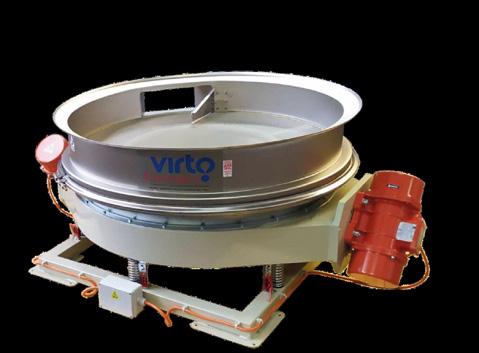








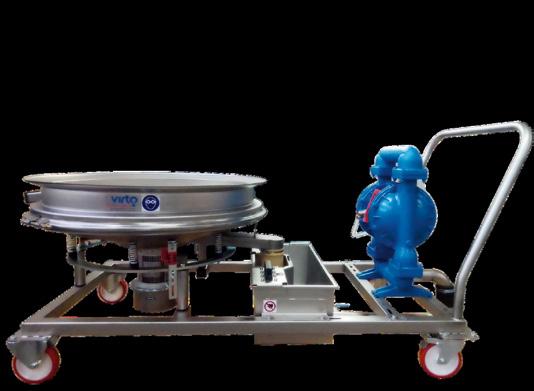





























CERAMICS PROUDLY MANUFACTURED BY CUCCOLINI SRL / ITALY DEMAG/CER VSB/VSM SINCE On The Market Since 1990. Over 20.000 Sieves installed worldwide. Quality manufacturing by Cuccolini srl / Virto Group. 1990 OVER 20.000 INSTALLATIONS VLB/VLC/VLH/VLM GRC/GRE/GRM/GRP/GRS VP2 Discover more on: virtoceramics.com DISTRIBUTED BY: NAMEPLATE CHECK THE INTER SER exclusive dealer for several countries.
fered a more severe, double-digit decline, down to 328,000 tonnes (down 13.5% on 2021), largely attributable to the -10% drop in Mexico. Exports from non-EU European countries recorded a similar contraction (-13.1% to 253,000 tonnes), with Turkey down 8.3% (187,000 tonnes). Next, again with a downward trend, came South America (84,000 tonnes, -15.4%) and Africa (73,000 tonnes, -7%).
A glance at the twelve-year period as a whole provides a clear picture of how exports have evolved in each area and in particular reveals the growth of Asia, whose exports have more than doubled from 1.1 to 2.4 million tonnes (CAGR 2022/2010 +6.9%). Asia’s percentage share of global exports has risen from 51% in 2010 to the current figure of 66%, winning shares from almost all the other regions.
By contrast, the EU’s exports remained unchanged at 522,000 tonnes during the period in question, with its share of world trade falling from 24.2% to 14%. The NAFTA region’s share fell from 12.4% to 8.9% despite overall 22% growth in exports since 2010. South America, which in 2010 accounted for 4.6% of world exports, saw its share drop to 2.3%, while volumes remained stable over the 12-year period. The only exceptions were non-EU European countries and Africa. Non-EU Europe saw its share of world exports rise from 6.1% to 6.8% over the 12-year period thanks to a 92% increase in export volumes, while Africa’s exports grew by 105% over the period, raising its share of global trade from 1.7% to 2%.
The 2022 ranking of the top 10 exporter countries changed very little in terms of positions, with Poland rising from 6th to 5th place and Iran from 10th to 9th, switching positions with Thailand and Vietnam respectively. China remained at the top of the ranking with exports of 1.92 million tonnes (down 2.6%
(NAFTA), sceso a 328mila ton. (-13,5% sul 2021) e sul quale ha pesato il -10% del Messico; analoga la flessione dell’export dei Paesi europei extra-UE (-13,1% a 253mila ton.), con la Turchia a -8,3% (187mila ton.). Seguono, sempre con segno meno, il Sud America (84mila ton., -15,4%) e l’Africa (73mila ton., -7%).
Riportata su un arco temporale di dodici anni, la fotografia di come si sono evolute le esportazioni di ogni singola area è inequivocabile e mostra lo sviluppo dell’Asia, il cui export è più che raddoppiato, da 1,1 a 2,4 milioni ton (CAGR 2022/10, +6,9%). In termini di quote percentuali sull’export globale, l’Asia è passata dal 51% del 2010 al 66% attuale, erodendo le posizioni di quasi tutte le altre aree.
Al contrario, nel periodo in esame l’export UE è rimasto invariato sui 522mila ton, con una quota sul commercio mondiale che è passata dal 24,2% al 14%. Quella dell’area NAFTA è scesa dal 12,4% all’8,9%, pur
con un incremento dell’export del 22% dal 2010. Il Sud America, che nel 2010 rappresentava il 4,6% dell’export mondiale, è ora al 2,3%, con volumi tendenzialmente in calo nel periodo in esame. Uniche eccezioni si confermano i Paesi dell’Europa extra-UE e l’Africa: i primi hanno aumentato la propria quota sull’export mondiale nei 12 anni dal 6,1% al 6,8%, grazie ad un incremento dei volumi esportati del 92%; l’Africa ha visto crescere le sue esportazioni del 105% nel periodo in esame, portando la quota sul commercio globale dall’1,7% al 2%.
La classifica 2022 dei 10 Paesi top exporter ha subito poche variazioni rispetto al 2022 per quanto riguarda i posizionamenti: la Polonia è salita dal 6° al 5° posto, l’Iran dal 10° al 9°, invertendo le posizioni rispettivamente con Tailandia e Vietnam. Al vertice della classifica rimane la Cina, con esportazioni pari a 1,92 milioni ton. (-2,6% sul 2021); da sola, la Cina genera il 78% dell’export asiatico e il 52% dell’export mondiale.
Source: Mecs / Acimac Research dept. on BSRIA and ITC data
TAB. 2 - THE TOP EXPORTING COUNTRIES (TONS) I maggiori Paesi esportatori (ton) 2010 2015 2016 2017 2018 2019 2020 2021 2022 % 22/21 CAGR 22/10 % on 2022 world exports China 901,962 1,335,212 1,238,558 1,378,951 1,532,833 1,747,579 1,698,152 1,968,003 1,917,768 -2.6% 6.5% 51.8% Mexico 226,569 295,439 322,169 326,289 342,666 335,958 333,230 328,904 295,441 -10.2% 2.2% 8.0% India 15,076 119,752 135,776 137,717 182,691 199,371 171,698 264,253 251,195 -4.9% 26.4% 6.8% Turkiye 94,354 120,613 127,065 140,759 154,285 164,809 166,370 203,467 186,656 -8.3% 5.8% 5.0% Poland 67,572 77,048 80,323 76,620 78,617 77,470 82,537 91,206 91,397 0.2% 2.5% 2.5% Thailand 57,189 79,242 81,016 86,512 96,067 92,094 87,129 111,703 88,218 -21.0% 3.7% 2.4% Germany 63,742 65,734 79,124 75,478 81,952 80,382 75,861 88,863 84,735 -4.6% 2.4% 2.3% Portugal 75,049 87,434 93,891 94,164 101,654 81,574 65,438 82,200 82,012 -0.2% 0.7% 2.2% Iran 25,895 31,420 33,962 35,206 46,573 46,469 48,893 52,869 57,865 9.4% 6.9% 1.6% Vietnam 19,590 47,892 35,034 40,457 41,292 52,982 51,986 67,565 57,669 -14.6% 9.4% 1.6% TOTAL 1,546,998 2,259,786 2,226,918 2,392,153 2,658,630 2,878,688 2,781,294 3,259,033 3,112,956 -4.5% 6.0% % on total world exports 71.6% 76.6% 76.9% 78.6% 79.9% 81.6% 82.7% 83.1% 84.0%
60 CWR 154/2023 sanitaryware FOCUS ON


on 2021), alone accounting for 78% of Asian and 52% of world exports. Mexico , the second largest exporter country with an 8% share of global exports, suffered a 10.2% fall in its exports to 295,000 tonnes. Following very strong growth in 2021, India also experienced a decline, with export volumes falling from 264,000 tonnes to 251,000 tonnes last year (-4.9%). Next came Turkey with 187,000 tonnes (-8.3%), Poland (91,000 tonnes, +0.2%), then Thailand, Germany, Portugal, Iran and Vietnam. Overall, the 10 largest sanitaryware exporter countries accounted for 84% of global exports.
An analysis of 2022 imports to the various continents not only
Il Messico, secondo grande esportatore con una quota dell’8% sull’export globale, ha ridotto le sue esportazioni del 10,2% a 295mila ton. Battuta d’arresto (dopo il fortissimo sviluppo del 2021) anche per l’India, che l’anno scorso ha visto i volumi esportati scendere da 264mila ton. a 251mila ton. (-4,9%). Seguono la Turchia
con 187mila ton. (-8,3%), la Polonia (91mila ton., +0,2%), Tailandia, Germania, Portogallo, Iran e Vietnam. Complessivamente, i 10 maggiori esportatori di sanitari hanno realizzato l’84% dell’export globale.
L’analisi delle importazioni 2022 nei vari continenti conferma l’Asia e il Nord America non solo come le due aree in
Source: Mecs / Acimac Research Dept. on BSRIA and ITC data
Source: Mecs / Acimac Research dept. on BSRIA and ITC data
2010 2015 2016 2017 2018 2019 2020 2021 2022 % 22/21 CAGR 22/10 % on 2022 world imports Asia 478,338 818,090 793,850 833,259 926,612 1,023,083 942,443 1,078,614 1,114,587 3.3% 7.3% 30.1% European Union 692,328 791,241 812,874 837,139 880,867 913,292 838,875 837,865 769,859 -8.1% 0.9% 20.8% Other Europe 96,507 89,772 70,806 77,761 90,187 87,862 96,767 242,811 208,218 -14.2% 6.6% 5.6% NAFTA 620,716 809,546 819,097 866,815 948,435 967,327 986,193 1,132,138 1,032,911 -8.8% 4.3% 27.9% South America 119,957 146,436 130,758 140,950 145,579 158,296 143,521 217,373 183,171 -15.7% 3.6% 4.9% Africa 111,952 235,655 199,740 221,986 259,390 310,834 288,084 336,648 310,262 -7.8% 8.9% 8.4% Oceania 41,223 60,486 69,343 65,337 74,551 67,059 67,629 77,971 85,194 9.3% 6.2% 2.3% TOTAL WORLD 2,161,021 2,951,226 2,896,468 3,043,247 3,325,621 3,527,753 3,363,513 3,923,420 3,704,202 -5.6% 4.6% 100.0% % var y-o-y 2.1 -1.9 5.1 9.3 6.1 -4.7 16.6 -5.6
TAB. 3: IMPORTS OF SANITARYWARE BY AREA (TONS) Import di sanitari per area geografica (ton)
I maggiori Paesi
(ton) 2010 2015 2016 2017 2018 2019 2020 2021 2022 % 22/21 CAGR 22/10 % on 2022 world imports USA 500,415 683,754 690,500 738,424 811,329 817,814 837,589 931,311 875,416 -6.0% 4.8% 23.6% Germany 107,509 142,391 147,060 140,282 148,431 150,425 144,299 155,318 149,626 -3.7% 2.8% 4.0% Republic of Korea 84,543 132,361 147,756 142,706 142,732 142,658 127,185 156,902 141,505 -9.8% 4.4% 3.8% France 115,108 101,819 107,421 116,870 125,738 135,313 125,226 150,811 130,060 -13.8% 1.0% 3.5% United Kingdom 103,815 147,323 145,992 151,904 138,454 143,344 118,906 131,784 112,302 -14.8% 0.7% 3.0% Canada 104,680 104,119 108,442 106,137 103,682 107,464 107,013 138,487 108,422 -21.7% 0.3% 2.9% Spain 83,634 88,245 93,758 89,036 108,096 104,981 86,835 118,467 103,707 -12.5% 1.8% 2.8% Saudi Arabia 33,592 83,934 67,918 58,100 51,814 74,034 82,903 70,855 88,027 24.2% 8.4% 2.4% Vietnam 3,866 7,693 12,476 20,855 32,342 55,237 68,354 75,538 84,719 12.2% 29.3% 2.3% Philippines 25,667 39,508 41,191 39,507 49,829 55,205 49,561 71,708 81,247 13.3% 10.1% 2.2% TOTAL 1,162,829 1,531,147 1,562,514 1,603,821 1,712,447 1,786,475 1,747,870 2,001,181 1,875,031 -6.3% 4.1% % on total world imports 53.8% 51.9% 53.9% 52.7% 51.5% 50.6% 52.0% 51.0% 50.6%
TAB. 4 - THE TOP IMPORTING COUNTRIES (TON)
importatori
62 CWR 154/2023 sanitaryware FOCUS ON

confirms Asia and North America as the two regions accounting for the majority of sanitaryware imports but also reveals that they are almost level in terms of imported volumes: Asia with 1.11 million tonnes (30% of global imports, +3.3% over 2021); North America with 1.03 million tonnes (27.9% of global imports, -8.8% over 2021). The European Union can also be included in this leading group, which despite a drop of 8% to 770,000 tonnes in 2022, accounts for 21% of global imports. The remaining 21% of world imports are divided between Africa, South America, non-EU European countries and Oceania.
The 2022 ranking of the top 10 sanitaryware importing countries saw a number of changes in position compared to the previous year, as well as the exit of Italy and the entry of Saudi Arabia. Overall, the ten largest sanitaryware importers
cui si concentra la maggior parte delle importazioni di sanitari, ma anche la loro relativa equivalenza nei volumi importati: 1,11 milioni ton. in Asia (il 30% dell’import globale, +3,3% sul 2021); 1,03 milioni ton. in Nord America (il 27,9% dell’import globale, -8,8% sul 2021). Possiamo far rientrare in questo gruppo anche l’Unione Europea che, nonostante la flessione dell’8% nel 2022, a 770mila ton., assorbe il 21% dell’import globale.
Il restante 21% dell’import mondiale è ripartito tra Africa, Sud America, Paesi europei extra-UE e Oceania.
La classifica 2022 dei 10 maggiori Paesi importatori di sanitari vede diversi riposizionamenti rispetto a quella di un anno prima, oltre all’uscita dell’Italia e l’ingresso dell’Arabia Saudita. Complessivamente, i dieci maggiori importatori hanno rappresentato il 50,6% dell’import globale di sanitari (1,86 milioni ton.).
Asia 50,9% European Union 24,2% Other Europe 6,1% NAFTA 12,4% South America 4,6% Africa 1,7% Oceania 0,1% 2010 Asia 22,1% European Union 32,0% Other Europe 4,5% NAFTA 28,7% South America 5,6% Africa 5,2% Oceania 1,9% 2010 Asia 50,9% European Union 24,2% Other Europe 6,1% NAFTA 12,4% South America 4,6% Africa 1,7% Oceania 0,1% 2010 Asia 22,1% European Union 32,0% Other Europe 4,5% NAFTA 28,7% South America 5,6% Africa 5,2% Oceania 1,9% 2010 Asia 66,0% European Union 14,0% Other Europe 6,8% NAFTA 8,9% South America 2,3% Africa 2,0% 2022 Asia 30,1% European Union 20,8% Other Europe 5,6% NAFTA 27,9% South America 4,9% Africa 8,4% Oceania 2,3% 2022 Asia 66,0% European Union 14,0% Other Europe 6,8% NAFTA 8,9% South America 2,3% Africa 2,0% 2022 Asia 30,1% European Union 20,8% Other Europe 5,6% NAFTA 27,9% South America 4,9% Africa 8,4% Oceania 2,3% 2022
FIG. 1 - SANITARYWARE EXPORTS BY AREA (SHARES IN % - 2010 VS. 2022)
Export di sanitari per area geografica (quote % - 2010 vs. 2022)
FIG. 2 - SANITARYWARE IMPORTS BY AREA (SHARES IN % - 2010 VS. 2022)
64 CWR 154/2023 sanitaryware FOCUS ON
Import di sanitari per area geografica (quote % - 2010 vs. 2022)
Rimini Expo Centre - Italy 24 - 27 SEPTEMBER 2024 tecnaexpo.com The international exhibition of technologies and supplies for surfaces IN COLLABORATION WITH WITH THE SUPPORT OF ORGANIZED BY
accounted for 50.6% of global sanitaryware imports (1.86 million tonnes).
In 2022, the United States was once again the world’s biggest sanitaryware importer with 875,000 tonnes (6% down on 2021). It retained a strong lead over all other importing countries with 23.6% of world imports, as well as almost all (85%) of imports to the NAFTA region. This marks the continuation of a longstanding record considering that in 2010 the USA imported more than 500,000 tonnes, 23% of world imports. Germany climbed to second place with imports of almost 150,000 tonnes (-3.7% over 2021), overtaking South Korea at 141,000 tonnes (-9.8%), followed by France (130,000 tonnes, -13.8%), the United Kingdom (112,000 tonnes, -14.8%), Canada, Spain, Saudi Arabia, Vietnam and the Philippines. Germany and Vietnam rank among both the top 10 exporters and the top 10 importers of sanitaryware, both with higher import than export volumes.
One final point of interest is the analysis of the main export destinations with respect to the geographical areas of production . Four out of seven areas sell the vast majority of their exports within their own geographical regions or continents: 97% of North American exports remain in the NAFTA region; 82% of South American exports remain in Latin America; 80% of Oceania’s exports remain in Oceania; and 78% of the European Union’s exports are sold in EU markets. At the other extreme, 85% of exports from non-EU Europe are sold in other regions, particularly the EU (Turkey’s largest export market). Likewise, 82% of Africa’s exports are sold outside Africa and Asia sells 58% of its exports outside the Asian continent thanks to China’s ability to ship to almost all global regions. ◼
Maggiore importatore mondiale di sanitari si confermano gli Stati Uniti, che nel 2022 hanno importato 875mila ton. (-6% sul 2021).
Il distacco rispetto a tutti gli altri Paesi importatori si mantiene elevato: le importazioni USA rappresentano infatti il 23,6% dell’import mondiale, oltre che la quasi totalità (l’85%) di quello dell’area NAFTA. Un primato storico: già nel 2010 gli USA importavano oltre 500mila ton., ossia il 23% dell’import globale.
Sale al secondo posto la Germania che ha importato quasi 150mila ton. (-3,7% sul 2021), superando la Corea (141mila ton., -9,8%), seguita da Francia (130mila ton., -13,8%), Regno Unito (112mila ton., -14,8%), Canada, Spagna, Arabia Saudita, Vietnam e Filippine.
Germania e Vietnam rientrano sia tra i 10 maggiori esportatori che tra i 10 maggiori importatori di sanitari, entrambi con volumi importati superiori a quelli esportati.
Interessante è infine l’analisi della destinazione prevalente delle esportazioni rispetto alle aree geografiche di produzione
Quattro aree su sette destinano la stragrande maggioranza del loro export all’interno della propria area geografica o continente: il 97% dell’export del Nord America rimane in area Nafta; l’82% di quello sudamericano non esce dall’America Latina; l’80% di quello dell’Oceania resta in Oceania e il 78% di quello dell’Unione Europea è rivolto a mercati UE.
All’estremo opposto, l’85% dell’export dell’Europa extra-UE è destinato ad altre aree, prevalentemente la UE, principale mercato di sbocco della Turchia.
Allo stesso modo, l’82% dell’export africano esce dall’Africa e l’Asia spedisce il 58% del proprio export al di fuori del continente asiatico, grazie alla capacità della Cina di raggiungere praticamente tutte le aree del globo. ◼
Destinazione delle esportazioni rispetto al continente di produzione - 2022
41,7% 77,8% 15,3% 97,1% 81,8% 18,2% 80,3% 58,3% 22,2% 84,7% 2,9% 18,2% 81,8% 19,7% 0% 10% 20% 30% 40% 50% 60% 70% 80% 90% 100% Asia European Union
NAFTA South
Oceania
Export
Other Europe
America Africa
Export inside integrated areas
outside integrated areas
FIG. 3 - EXPORTS INSIDE AND OUTSIDE INTEGRATED AREAS (SAME CONTINENT OF PRODUCTION) - % SHARES 2022
66 CWR 154/2023 sanitaryware FOCUS ON


Delivering Your Parts Worldwide www.essepienne.com info@essepienne.com +39 0536 071132 ESSEPIENNE SRL, Via Falzarego 70, 41049 - Sassuolo (MO), Italy
*
THE BIG PLAYERS IN THE SECTOR
Toround off the international tradefigures forthesanitarywaresector, wearepresenting the keyfigures for the big players updated to 31 December 2022. Where available we also provide the figures for turnovergenerated purely from sales of sanitaryware. This allows for a more uniform comparison between large groups which often operate in multiple segments. To provide a more complete picture of group size, we also include total or consolidated turnover. The figures were supplied directly by the companies themselves or in some cases were based on estimates or obtained from public sources.
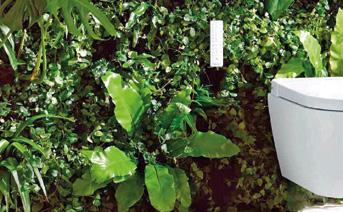
1
76 (total group) in Spain (9), rest of Europe, America, North Africa, Asia Roca, Laufen, Celite, Incepa, Parryware, Jika, Ying 2
in USA, Mexico, Brazil, Morocco, Thailand, India, China, Indonesia Kohler, Jacob Delafon, Sterling, Ann Sacks
4 in Japan + 12 in China, Taiwan, Indonesia, India, Vietnam, Thailand, USA, Mexico TOTO
plants in Finland, Sweden, Poland, Germany, Switzerland, France, Portugal, Italy, Ukraine Geberit
5
Corona, Mansfield, American Standard, Vortens, Incesa Standard, Ecoline, Ambiance 6
American Standard, Lixil, Inax, Grohe, Jaxson
Group Country Capacity in 2022 (mill. Pcs.) Production 2022 (mill. Pcs.) 2022 Exports % 2022 Total Group turnover (mill. €) Sanitaryware plants / Location Main Brands / Companies
Roca Group Spain n.a. 28.0 80 2,092.0 (sanitaryware, and other businesses)
Group USA 25 0* 19 0* n.a. n.a. 15
Ltd Japan n.a. 11 6 n.a. 5,547.1 (bathroom, tiles, other)
Kohler
3 TOTO
14 5* 11 5* n.a. 3,463.9 (3,392 mill. CHF) of which 1,054.9 Bathroom Sanitaryware
4 Geberit Group Switzerland
13.5 10.6 n.a. 779.1 (303.1
2
1
Guatemala, 1 in
1 in
Corona Colombia
sanitaryware, 161.6 tiles, 314.5 other activities)
in Colombia + 3 in Mexico,
in
Nicaragua,
USA
Lixil Corporation Japan 10 -12* 9.0* n.a. 10,372 (sanitaryware & other businesses) 10
in Japan, China, Vietnam, Indonesia, Thailand
7 Huida Sanitaryware China 10.0* 7.0* n.a. 458.9 2 in China Huida, Dofiny 8 Cersanit Poland 7.5* n.a. n.a. 432.7 (sanitaryware, tiles) 1 in Poland, 1 in Ukraine Cersanit, Mito 9 Ideal Standard Belgium 7.0* 6.5* n.a. 737.0 1 in Czech Rep., 1 in Bulgaria, 1 in UK, 1 in Egypt Ideal Standard, Porcher, Armitage Shanks On 18 September 2023, Villeroy & Boch announced the acquisition of Ideal Standard, which will be completed in early 2024 10 Arrow China 8.7* 6.5* n.a. 1,003.8 (471 sanitaryware) 5 in China Arrow, Faenza, Annwa 11 Eczacibasi VitrA Turkey 5.7 5.7 60 n.a. 1 in Turkey, 1 in Russia VitrA 12 Dexco Brazil 11 3 5.6 6 1,572 (169 sanitaryware, 212 tiles, 1190 other activities) 4 in Brazil Deca 13 Lecico Egypt 6 7 5.1 73 123.7 (75.7 sanitaryware, 40.9 tiles, 7.1 other) 4 in Egypt (incl. Tiles), 1 in Lebanon Lecico 14 RAK Ceramics UAE 5 0 4.8 60 883.0 (138 sanitaryware, 545 tiles, 200 other activities) 2 in UAE, 3 in India and Bangladesh RAK Ceramics, Eliesaab 15 Duravit Germany 4.5 4.1 n.a. 715.8 3 in Germany, 1 in France, 2 in Egypt, 3 in China, 1 in Tunisia, 1 in India Duravit
estimates - Source/Fonte: MECS / Acimac
68 CWR 154/2023
Sensowash
D-Neo by Duravit

I BIG DEL SETTORE
A completamento dei dati di commercio internazionale di sanitari, presentiamo i dati di sintesi dei maggiori player del settore aggiornati al 31/12/2022. Laddove disponibili, riportiamo i dati del fatturato generato dalla sola vendita di sanitari, per consentire un confronto più omogeneo tra grandi gruppi spesso operanti in più comparti. Per fornire un quadro più completo della dimensione di gruppo si riporta anche il fatturato totale o il consolidato. I dati sono stati forniti direttamente dalle aziende o, in alcuni casi, stimati o recuperati da fonti pubbliche.
On 18 September 2023, Villeroy & Boch announced the acquisition of Ideal Standard, which will be completed in early 2024
Group Country Capacity in 2022 (mill. Pcs.) Production 2022 (mill. Pcs.) 2022 Exports % 2022 Total Group turnover (mill. €) Sanitaryware plants / Location Main Brands / Companies 16 Turkuaz Seramik Turkey 3 6 3.6 50 n.a. 2 in Turkey Turkuaz Seramik, Cerastyle 17 Cisa SA Ecuador 4 5 3 3 n.a. 105.1 (70.2 sanitaryware, 4 6 tiles, 30.3 other activities) 2 in Ecuador, 1 in Chile Edesa,
18 Hindware Limited India 4 2* 3.0* n.a. n.a. 2 in India Hindware,
Hindware Italian Collection 19 Cera Sanitaryware India 3 3* 3 0* n.a. 201,7 1 in India Cera 20 Villeroy & Boch Germany 3 0* 3.0* n.a. 994.5 (662 bathroom & wellness, 329 dining) 13
Villeroy &
Gustavsberg/Vatette,
Mondial
Briggs, Fanaloza
Queo,
(total group). 5 sanitaryware plants in Germany, France, Hungary, Romania, Thailand
Boch,
Alföldi,
21 Canakcilar Seramik Turkey 2 6 2 6 60 n.a. 2 in Turkey Creavit 22 Saudi Ceramics Saudi Arabia 3.6 2 5* n.a. 371.3 (tiles, sanitaryware, bricks, other) 2 in Saudi Arabia Saudi Ceramics 23 Siam Sanitary Ware Thailand 2 6 2.4 23 101 (sanitaryware) 2 in Thailand COTTO 24 Ferrum Argentina n.a. 2.4* n.a. 164.9 (sanitaryware) 2 in Argentina Ferrum 25 Ceramica Cleopatra Egypt 2 5* 2 4* n.a. n.a. 2 in Egypt Cleopatra, Eldorado 26 ECE Holding Turkey 2.4 2.0 n.a. n.a. 2 in Turkey ISVEA, Ece 27 Ceramic Industries South Africa 2.3 1.9 12.5 249.0 (49 sanitaryware, 203 tiles) 2 in South Africa Betta, Bettabath 28 Trebol Peru 2.6 1.9 6.2 50.7 (34.8 sanitaryware, 15.9 other activities) 1 in Peru Trebol 29 Viglacera Vietnam 2.2 1.9 15 565 (tiles, sanitaryware, other) 4 in Vietnam, 1 in Cuba Viglacera, Viglacera Platinum, Sanfi, SanVig 30 Kale Group Turkey 1.6* 1.0 33 321.5 (21.1 sanitaryware, 288.6 tiles, 11.9 other activities) 1 in Turkey Kale Banyo, IDA FOCUS ON sanitaryware 69 CWR 154/2023
Villeroy & Boch: a new giant in the sanitaryware industry
Villeroy & Boch compra Ideal Standard e scala il settore
Milena Bernardi (m.bernardi@kairosmediagroup.it)
On 18 September, Villeroy & Boch signed an agreement to acquire the operating companies in the Ideal Standard Group. The approximately €600 million deal is expected to be completed in early 2024.
As a result of the acquisition, the Mettlach-based multinational will incorporate a €737 million group (2022 figure) with eight factories. Four of these are located in the Czech Republic, Bulgaria, the UK and Egypt and are devoted to ceramic sanitaryware production with an annual output of around 6.5 million pieces, while the other four specialise in the production of taps and fittings, shower trays and bathtubs.
These eight plants will join the 13 already owned by Villeroy & Boch, five in the sanitaryware sector (in Germany, France, Hungary, Romania and Thailand) and the others in the bathroom furnishings and tableware sectors.
Given the size of the two groups, the acquisition will redraw the map of the major players in the sanitaryware and bathroom fittings industry and establish the Villeroy & Boch Group as one of the world leaders in the sector. In the Bathroom & Wellness Division alone, the German multinational will double its revenues from €662 million in 2022 to approximately €1.4 billion. Including the Dining & Lifestyle business, the group’s total turnover will exceed €1.7 billion, compared to €994.5 million in 2022.
“This merger means that we will now become a stronger global player in the bathroom sector in terms of turnover and combined expertise,” explains Georg Lörz, CEO Bathroom & Wellness of Villeroy & Boch “Our complementary strengths also make us more competitive and significantly improve our starting position for achieving additional growth.”
Villeroy & Boch is financing the transaction from its own liquid funds and with borrowing of €250 million. Ideal Standard’s existing loans and financial liabilities are not part of the transaction scope.
We met Georg Lörz to find out more about the transaction and the market prospects.
CWR: You mentioned the complementary strengths of Villeroy & Boch and Ideal Standard. Could you tell us more about them?
GEORG LÖRZ: The merger will create a powerful combination of complementary established brand and sales strategies. Villeroy & Boch has a strong geographical basis in Central and Northern Europe as well as in Asia, while Ideal Standard enjoys an excellent reputation with its brand portfolio in the UK, Italy and the Middle East / North Africa region in particular. Diversi-
Il 18 settembre scorso Villeroy & Boch ha siglato l’accordo per l’acquisizione delle società operative del gruppo Ideal Standard. La transazione, del valore di circa 600 milioni di euro, sarà completata a inizio 2024.
Ad essere incorporato nella multinazionale di Mettlach sarà un gruppo da 737 milioni di euro (dato 2022) e otto stabilimenti: quattro – in Repubblica Ceca, Bulgaria, Regno Unito ed Egitto - dedicati alla produzione di circa 6,5 milioni di pezzi di sanitari in ceramica, e gli altri quattro attivi nella produzione di rubinetteria e accessori, piatti doccia e vasche.
Otto impianti che si aggiungeranno ai 13 di Villeroy & Boch, cinque nel comparto sanitari (in Germania, Francia, Ungheria, Romania e Tailandia) e gli altri nei settori arredobagno e stoviglieria.
Per la dimensione dei due protagonisti, l’operazione è quindi destinata a ridisegnare la mappa dei grandi player dell’industria dei sanitari e dell’arredobagno, collocando il gruppo Villeroy & Boch tra i leader mondiali del settore. Nel solo comparto Bathroom & Wellness, la multinazionale tedesca potrà raddoppiare i ricavi, dai 662 milioni di euro del 2022 a circa 1,4 miliardi di euro; includendo anche il business Dining & Lifestyle, il fatturato totale del gruppo supererà quota 1,7 miliardi di euro, contro i 994,5 milioni dell’esercizio 2022.
“Con questa fusione diventeremo un player globale più forte in termini di fatturato e competenze combinate. Inoltre, la complementarità dei nostri punti di forza ci renderà ancora più competitivi, migliorando significativamente la nostra posizione strategica per consentire l’ulteriore crescita “, ha dichiarato Georg Lörz, CEO della divisione Bathroom & Wellness di Villeroy & Boch.
Villeroy & Boch ha finanziato la fusione con liquidità propria e un finanziamento di 250 milioni di euro, escludendo dall’operazione prestiti e crediti esistenti in capo a Ideal Standard.
Abbiamo incontrato Georg Lörz per approfondire l’operazione e le prospettive di mercato.
CWR: Sottolineava la complementarità di Villeroy & Boch e Ideal Standard sotto diversi aspetti. Ce li descrive?
GEORG LÖRZ: Ad essere complementari sono soprattutto le strategie commerciali e di marchio, ma non solo. Villeroy & Boch, ad esempio, detiene un forte posizionamento in Europa centrale e settentrionale, così come in Asia, mentre Ideal Standard gode di un’eccellente reputazione nel Regno Unito, in Italia e nell’area MENA (Medio Oriente e Nord Africa). Altrettanto strategica è la diversità dei segmenti di mercato: Villeroy & Boch è più concentrata su una clientela privata di fascia alta, mentre Ideal Standard possiede una parti-
70 CWR 154/2023
ty in terms of market segments is just as important. While Villeroy & Boch’s sales strategy focuses primarily on a high-end private customer base, Ideal Standard possesses special expertise in the project business, including for the public sector, the healthcare sector and for developers of large residential, hotel and commercial properties.
In addition, alongside a broad range of ceramic bathroom ware and other products, Ideal Standard comes with an established fittings business, which generated more than a third of its revenue in 2022.
CWR: In announcing the deal, you also mentioned the similarities between the two groups in terms of corporate culture. What were you referring to exactly?
colare expertise nel segmento dei progetti pubblici e privati, dall’ambito sanitario al residenziale, alberghiero e commerciale.
Sul fronte produttivo, poi, accanto alla vasta gamma di sanitari in ceramica, vasche e piatti doccia, Ideal Standard vanta un’attività consolidata anche nel settore rubinetteria e accessori, divisione che nel 2022 ha generato oltre un terzo dei ricavi.

Talking to...
Georg Lörz
CWR: Annunciando l’operazione, avete citato anche le affinità tra i due gruppi in termini di cultura di impresa. A cosa vi riferite?
G. LÖRZ: Villeroy & Boch e Ideal Standard sono entrambi brand forti che affondano le proprie radici nella tradizione e che condividono gli stessi valori, come il marcato orientamento al servizio, la passione per il design e un impegno costante verso l’innovazione.

71 CWR 154/2023 FOCUS ON sanitaryware
G. LÖRZ: Villeroy & Boch and Ideal Standard are both strong brands steeped in tradition and share similar values. These include a pronounced service orientation, a flair for good design and a constant striving for innovation.
CWR: Are you already considering how to develop specific synergies between the two groups and what technological investments to make at Ideal Standard’s facilities?
G. LÖRZ: We have not yet made any decisions. After the final closing, which is expected to take place in the first quarter of 2024, we will begin the integration phase during which we will clearly outline the plan of action.
CWR: Let’s turn to the market and the current slowdown in demand. What were Villeroy & Boch’s results for the first 9 months of 2023?
G. LÖRZ: The challenging economic environment also affected our results. The group’s consolidated revenue dropped to €650.6 million, a decrease of €77.7 million or 10.7% year-onyear. Adjusting for currency effects, the contraction stood at 8.8%. The negative repercussions also affected our earnings before interest and taxes (EBIT), which fell by 11.7% to €56.8 million. This downturn in earnings was primarily due to the reduced revenue, although we did manage to partially offset this through cost savings and income from currency hedges.
CWR: How did you perform in the various geographical areas you operate in?
G. LÖRZ: Revenue in the EMEA region (Europe, Middle East, Africa) declined by 13% or €76.4 million. This was largely due to the weak performance in Central Europe, where revenue fell by 13.5% or €32.9 million. By contrast, revenue in Southern Europe increased by 9.6% or €3.1 million. Overseas, revenue in China increased by 13.1% or €8.9 million, thanks chiefly to good project business. This limited the revenue decline in non-EMEA markets to 0.9% or €1.3 million.
CWR: What impact has the construction slowdown in Europe had on your Bathroom & Wellness division?
G. LÖRZ: In the first nine months of this year, the division’s nominal revenue stood at €435.8 million, a decline of 13.9% (or 11.5% on a constant currency basis) compared to the strong performance in the same period in 2022. The downturn in revenue was observed in all business areas, but was particularly pronounced in the ceramic sanitaryware business due to the slowdown in Europe’s construction industry and in the wellness business. By contrast, new products such as toilets with new TwistFlush technology met with a positive market response. Outside Europe, as I was saying, we achieved substantial revenue growth in Asia with market-specific products including our ViClean shower toilets in particular.
CWR: State già valutando come sviluppare le sinergie e quali investimenti tecnologici realizzare sugli impianti di Ideal Standard?
G. LÖRZ: Al momento è ancora prematuro parlarne. Dopo il closing definitivo, previsto nel primo trimestre del 2024, inizierà la fase di integrazione durante la quale si delineerà con chiarezza il piano di azione.
CWR: Spostiamoci sul mercato e sull’attuale rallentamento della domanda. Villeroy & Boch come ha chiuso i primi 9 mesi del 2023?
G. LÖRZ: Il difficile contesto economico ha pesato anche sui nostri risultati. Il fatturato consolidato di gruppo è sceso a 650,6 milioni di euro, segnando un calo di 77,7 milioni di euro, ovvero del 10,7% su base annua. Al netto degli effetti valutari la contrazione è stata dell’8,8%. Le ripercussioni negative si sono evidenziate anche sul reddito operativo netto (Ebit) che ha registrato una flessione dell’11,7% scendendo a 56,8 milioni di euro. La contrazione, parzialmente compensata dalla riduzione dei costi e dalle coperture valutarie, è da attribuire principalmente al calo delle vendite.
CWR: Qual è stato l’andamento nelle varie aree geografiche in cui operate?
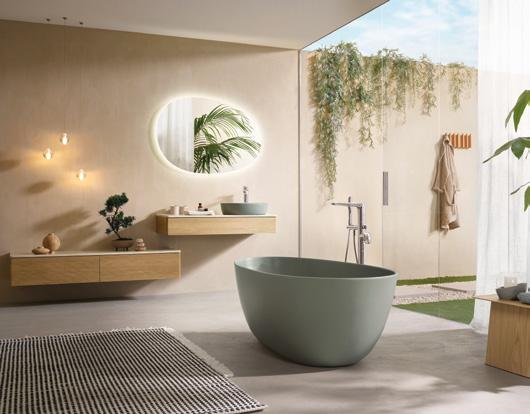
G. LÖRZ: I ricavi nell’area EMEA (Europa, Medio Oriente, Africa) sono diminuiti del 13%, ossia 76,4 milioni di euro in meno. A pesare di più è stata la debole performance registrata in Europa centrale, dove le vendite sono calate del 13,5% (32,9 milioni di euro in meno). Al contrario, in Europa meridionale i ricavi sono aumentati di 3,1 milioni di euro (+9,6%). Sugli altri mercati esteri, da segnalare l’ottimo andamento in Cina (in crescita di 8,9 milioni di euro, +13,1%, per lo più nel segmento dei progetti), che ha consentito di limitare la flessione sui mercati extra EMEA ad un -0,9% (1,3 milioni di euro).
CWR: Che impatto ha avuto la frenata delle costruzioni in Europa sulla vostra divisione Bathroom & Wellness?
G. LÖRZ: Nei primi 9 mesi di quest’anno, i ricavi della divisione si sono fermati a 435,8 milioni di euro, vale a dire una flessione del 13,9% (o -11,5% a valuta costante) rispetto allo stesso periodo del 2022, che era stato effettivamente molto brillante. La contrazione ha interessato tutti i segmenti di attività, sebbene sia stata particolarmente pronunciata nel comparto della ceramica sanitaria, penalizzato, appunto, dal rallentamento dell’edilizia in Europa, e nel segmento Wellness. Al contrario, i nuovi prodotti, come i WC con la nuova tecnologia TwistFlush, hanno avuto riscontri di mercato positivi. Fuori dall’Europa, come dicevo, abbiamo invece ottenuto una notevole crescita del fatturato in Asia grazie a prodotti specifici per il mercato locale, in particolare i vasi bidet ViClean. Dal punto di vista del risultato operativo, la divisione Bathroom & Wellness ha chiuso i primi nove mesi dell’anno con un Ebit a 45,7 milioni di euro, contro i 53,9 milioni di euro dell’anno precedente. Il calo dei prezzi dell’energia e delle materie prime ha compensato solo parzialmente la flessione.
72 CWR 154/2023 sanitaryware FOCUS ON


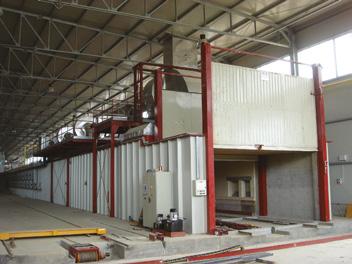
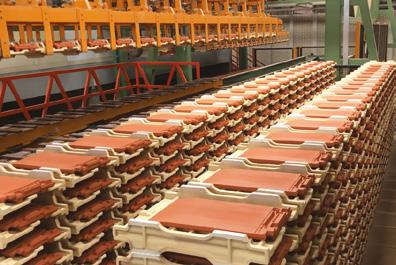
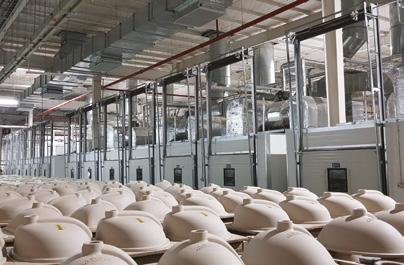
In terms of operating results, the division closed the first nine months of 2023 with an EBIT of €45.7 million, compared to €53.9 million in the previous year. Falling energy prices were only partially able to offset the downturn in earnings.
CWR: The impact on the Dining & Lifestyle division was less severe. Why was this?
G. LÖRZ: In the first nine months of 2023, the Dining & Lifestyle Division experienced only a modest downturn in revenue, dropping from €219.5 million to €212.3 million, a decline of 3.3% (or 2.7% on a constant currency basis). Our project business, particularly with hotel and restaurant customers, saw a notable growth of €1.6 million. This was a result of our strategic focus on the high-end segment, which has been less affected by the economic slowdown. Additionally, our revenue in retail stores was slightly higher than the previous year, totalling €61.8 million. On the other hand, our e-commerce business faced challenges, aligning with the general trend in online retail, with a downturn in revenue of €8 million.
Overall, the Dining & Lifestyle Division ended the first nine months with a satisfactory operating result (EBIT) of €12.1 million, similar to that of 2022.
CWR: Could you tell us about your latest investments?
G. LÖRZ: Across the group we invested €24.6 million in the first nine months of 2023, with the Bathroom & Wellness Division accounting for €16.9 million. For example, we installed new pressure casting machines and a photovoltaic system in Hungary, a washbasin pressure casting system in Romania, a new vertical moulding machine in Belgium and new moulds for the wellness plant in the Netherlands.
Investment in the Dining & Lifestyle Division mainly related to the modernisation and acquisition of new production facilities and pressing tools in the Merzig and Torgau facilities as well as the modernisation of our own retail stores.
For the whole year 2023, our investment forecasts remain unchanged at an expected €50 million.
CWR: How do you expect to close the year 2023?
G. LÖRZ: The market environment continues to be characterised by an unusually high degree of uncertainty due to the continued construction industry crisis and the further rise in interest rates. Adverse effects may also derive from a renewed escalation of trade disputes and political conflict between the US and China. Given the further deterioration of conditions in the European construction industry in the third quarter of 2023 and negative currency effects, we expect to close the year with a reduction in sales of between 3% and 6% and a decrease in EBIT of between 5% and 10%. Based on the revised targets, the return on net operating assets is expected to range between 23% and 25%.
CWR: Sulla divisione Dining & Lifestyle l’impatto è stato più lieve. A cosa è dovuto?
G. LÖRZ: Effettivamente, nei nove mesi, la divisione Dining & Lifestyle ha riportato solo una modesta contrazione dei ricavi, scesi da 219,5 a 212,3 milioni di euro, pari al -3,3% (o -2,7% al netto degli effetti valutari). A questo risultato ha contribuito positivamente l’attività nel settore Ho.Re.Ca., cresciuta di 1,6 milioni di euro, merito della scelta strategica di posizionarci nella fascia alta del mercato, meno penalizzato dal rallentamento dell’economia. In leggera crescita anche le vendite nel canale retail che ha generato ricavi pari a 61,8 milioni di euro, mentre quelli dal canale e-commerce sono calati di 8 milioni di euro, allineandosi ad una tendenza piuttosto generalizzata in questo comparto.
Soddisfacente anche il risultato operativo (EBIT), che si è mantenuto su livelli prossimi a quelli del 2022, pari a 12,1 milioni di euro.
CWR: Ci parla dei vostri ultimi investimenti?
G. LÖRZ: Tra gennaio e settembre abbiamo investito 24,6 milioni di euro, di cui 16,9 milioni per il rinnovamento tecnologico di varie strutture produttive della divisione Bathroom & Wellness. Ad esem-
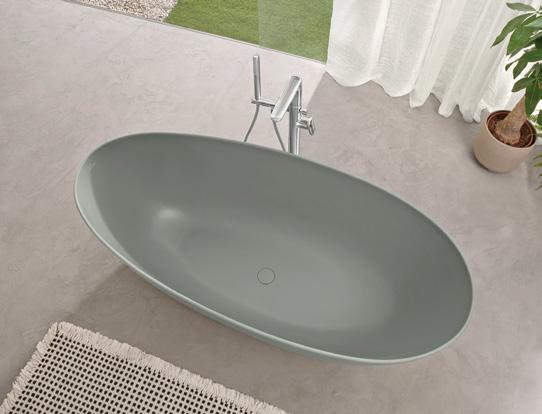
pio, nello stabilimento ungherese abbiamo installato nuove macchine di colaggio a pressione, oltre all’impianto fotovoltaico; in Romania abbiamo avviato l’impianto di colaggio a pressione per lavabi; in Belgio è stato inserito un sistema di stampaggio verticale e nello stabilimento olandese dedicato ai prodotti wellness sono stati aggiunti nuovi stampi.
Gli investimenti nella divisione Dining & Lifestyle hanno riguardato principalmente il revamping e l’acquisto di nuovi macchinari e presse per gli stabilimenti di Merzig e Torgau, nonché la modernizzazione dei nostri negozi di proprietà.
Per l’intero 2023 è stato confermato un programma totale di investimenti pari a 50 milioni di euro.
CWR: Quali sono le vostre previsioni per la chiusura di questo esercizio?
G. LÖRZ: Il contesto di mercato resta caratterizzato da un grado di incertezza insolitamente elevato a causa della perdurante crisi dell’edilizia e dell’ulteriore aumento dei tassi di interesse. Effetti negativi potrebbero anche derivare da una nuova escalation delle dispute commerciali e del conflitto politico tra Stati Uniti e Cina. Considerando l’ulteriore indebolimento del settore delle costruzioni in Europa nel terzo trimestre e gli effetti valutari negativi, prevediamo di chiudere l’esercizio con un fatturato in calo dal 3 al 6% e con una flessione dell’Ebit tra il 5 e il 10%. Sulla base degli obiettivi rivisti, il rendimento del capitale operativo netto dovrebbe essere compreso tra il 23% e il 25%.
CWR: Quali sono le vostre aspettative sulla ripresa del settore sanitari?
G. LÖRZ: Quello dei sanitari è un settore in rapida crescita a livello globale, spinto da una domanda di spazi abitativi
74 CWR 154/2023 sanitaryware FOCUS ON

CWR: What are your expectations regarding the future recovery of the sanitaryware industry?
G. LÖRZ: We see the sanitaryware industry as a global growth market. Structurally, there is still a high demand for living space that needs to be met with production capacities and a corresponding product range in the long term. While we still see challenges at present, we expect the industry to recover from the current situation in the medium term. The bathroom sector is a market in which scale effects will play an increasingly important role in remaining competitive and attracting future investment. For this reason alone, the acquisition of Ideal Standard represents the right strategic step for Villeroy & Boch.
CWR: Besides the integration of Ideal Standard, what other projects will you be focusing on in 2024?
G. LÖRZ: We are focusing above all on our sustainability goals, which include the transition to renewable energy. For example, an existing chamber kiln at the company’s headquarters in Mettlach has been completely converted and can now run on hydrogen. The test phase for this pioneering solution began in November and initially aims to evaluate the effects of hydrogen operation on the colour, quality, and glaze of the sanitaryware. The test results will then form the basis for a possible conversion of other production facilities, including the tunnel kilns for large-scale production. At the same time we are working to electrify the kilns at other sites where a hydrogen connection is not feasible. In the long term, this diversified strategy will result in a sustainable and resilient production network. From a sales and marketing perspective, we launched a program in 2023 that will enable us to follow customers even more closely throughout their purchasing experience and to provide them with the best possible offer. This strong focus on the needs of consumers will continue to be essential after the integration of Ideal Standard. ◼
che resta strutturalmente elevata e che dovrà essere soddisfatta nel lungo termine con una capacità e un’offerta produttiva adeguata. Anche se al momento permangono sfide considerevoli, ci aspettiamo una ripresa del comparto già nel medio periodo. In questo contesto, le economie di scala giocheranno un ruolo sempre più determinante ai fini della
competitività e della capacità di attrarre investimenti. Già solo per questa ragione, l’acquisizione di Ideal Standard rappresenta una scelta strategica corretta per Villeroy & Boch.
CWR: Oltre all’integrazione di Ideal Standard, su quali altri progetti vi concentrerete nel 2024?
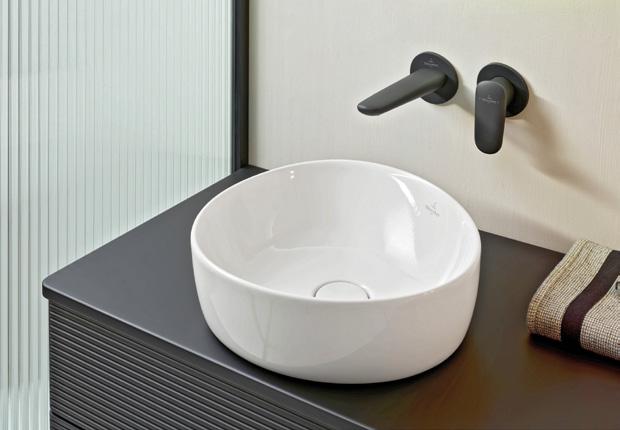

G. LÖRZ: Ci stiamo focalizzando soprattutto sui nostri obiettivi di sostenibilità che prevedono la transizione verso l’utilizzo di energie rinnovabili. Nello stabilimento di Mettlach, ad esempio, abbiamo completamente riconvertito un forno a camera per renderlo funzionante a idrogeno, una soluzione pionieristica che, da novembre, è in fase di test per valutare gli effetti su colore, qualità e smalto dei sanitari. I risultati ottenuti costituiranno la base per una possibile riconversione di altri impianti produttivi, compresi i forni a tunnel per la produzione su larga scala. In parallelo, stiamo lavorando anche per elettrificare i forni nei siti dove il collegamento all’idrogeno non è fattibile. Nel lungo termine, questa strategia diversificata si tradurrà in una struttura produttiva sostenibile e resiliente.

Sul fronte commerciale e marketing, invece, nel 2023 abbiamo lanciato un programma che ci consentirà di seguire ancor più da vicino il cliente nella sua esperienza di acquisto fornendogli l’offerta migliore e più aderente alle sue esigenze. Questa attenzione sarà fondamentale anche dopo l’integrazione di Ideal Standard. ◼
76 CWR 154/2023 sanitaryware FOCUS ON



VitrA inaugurates fifth sanitaryware plant
VitrA inaugura il quinto impianto per sanitari
VitrA, the flagship brand of Eczacıba ş ı Building Products and Turkey’s largest exporter of ceramic sanitaryware, has accounted for half of the country’s exports in this sector for decades. Recently, on 18 October 2023, the brand celebrated the inauguration of its 5th facility at the VitrA Production Campus in Bilecik, Bozüyük. The new plant commenced operations just four years after the introduction of the second phase of VitrA’s fourth ceramic sanitaryware plant in 2019 and exemplifies the group’s consistent strategy of reinvesting profits to fuel growth.
Building on VitrA’s 65-year history in ceramic production, the new plant also marks a new milestone in the company’s pursuit of innovation as it combines the core values of cutting-edge technology, AI and sustainability.
Speaking at the opening ceremony, Eczacıba ş ı Holding’s Chairman Bülent Eczacıba ş ı commented: “With an investment of €76.5 million , our new facilities leverage advanced AI technology, ensuring end-to-end automation. Sustainability is ingrained in our business model. Our recent inclusion of a solar power plant at the VitrA Production Complex and the switch to I-REC certified green electricity exemplifies our dedication to zero carbon emissions.”
With the start-up of the fifth plant, VitrA’s annual sanitaryware production has surged to 6.7 million units , with concealed cistern production reaching 2 million units. The expansion has led to a 50% increase in the size of the Bozüyük campus , which now extends over 469,000 sqm and houses a workforce of 3,664 professionals.
With this latest investment, Eczacıba ş ı Building Products is poised for remarkable growth. This strategic initiative aims to enhance operational efficiency, meet surging demand and broaden market reach.
“Our constant focus on combining technology and human talent while safeguarding the future of our planet has laid the foundation for our continued growth,” remarked Özgen Özkan, CEO of Eczacıba ş ı Building Products “We’re ready to meet the growing demand of the European market, with a production of 6.7 million units that firmly establishes us as one of the top European producers.” Özkan also mentioned the decision to shift concealed cistern production to the new facility and commented on future projects, notably an expected 50% increase in tap production by the end of 2024.
Lo scorso 18 ottobre, presso il VitrA Production Campus di Bilecik, Bozüyük, il gruppo turco Eczacıbaşı Building Products ha inaugurato il quinto stabilimento produttivo di VitrA, il suo brand di punta, nonché maggiore esportatore nazionale di sanitari in ceramica. Il nuovo impianto entra in produzione a soli quattro anni dall’avvio della seconda fase di investimenti per lo stabilimento n. 4 di Bozüyük; una progressione che riflette l’approccio coerente del gruppo al reinvestimento degli utili per alimentare la crescita. Non solo. Forte di 65 anni di storia nella produzione di ceramica, VitrA segna anche un nuovo traguardo all’insegna dell’innovazione: il nuovo impianto integra, infatti, in maniera virtuosa, tecnologia all’avanguardia, AI e sostenibilità, capisaldi della mission aziendale.
A sottolinearlo è stato lo stesso Presidente di Eczacıbaşı Holding, Bülent Eczacıbaşı, nel suo intervento alla cerimonia di inaugurazione. “Con un investimento di 76,5 milioni di euro – ha dichiarato - i nostri nuovi impianti utilizzano una tecnologia AI tra le più avanzate, garantendo un’automazione end-to-end. La sostenibilità è radicata nel nostro modello di business. La recente inclusione di un impianto solare nel complesso produttivo di VitrA e la transizione verso un’energia verde certificata
I-REC testimoniano il nostro impegno verso l’azzeramento delle emissioni di carbonio”.
Con l’avviamento del quinto impianto, la produzione di sanitari di VitrA è salita a 6,7 milioni di pezzi/anno, con una produzione di cassette a incasso che ha raggiunto 2 milioni di pezzi. L’espansione ha portato a un aumento del 50% delle dimensioni del campus di Bozüyük, che ora si estende su 469mila mq e ospita una forza lavoro di 3.664 persone. Un investimento strategico, quindi, grazie al quale Eczacıbaşı Building Products è ora pronta per una fase di crescita notevole che può contare su una migliore efficienza operativa e volumi idonei a soddisfare l’aumento della domanda e ad ampliare la presenza sul mercato.
“La nostra costante attenzione nel riuscire a coniugare tecnologia e talento umano, salvaguardando il futuro del nostro pianeta, ha posto le basi per una continua crescita”, ha sottolineato il CEO di Eczacıbaşı Building Products, Özgen Özkan “Siamo pronti a soddisfare la crescente domanda del mercato europeo e la nostra produzione attuale di 6,7 milioni di unità ci colloca tra i primi produttori del continente”. Özkan ha menzionato inoltre la decisione di spostare la produzione di cassette a incasso nel nuovo stabilimento e, anticipando i progetti futuri,
78 CWR 154/2023

VITRA’S FIFTH PLANT IS EQUIPPED WITH SACMI TECHNOLOGY
In 1958 VitrA became the first Turkish company to start producing ceramic sanitaryware and is now a leading international sanitaryware group with exports to 75 countries worldwide. Sacmi has been one of its key technology partners for over 20 years and supplied all the key technologies for this fifth plant.
ROBOTCASTING
VitrA has chosen to devote its fifth plant to the production of the most elegant, complex and large-sized pieces in its product range, some of which weigh up to 30 kg or more. For this purpose, Sacmi has supplied five new AVM cells for a total of ten casting machines and two AVB cells
The high-performance, reliable and flexible AVM machine is renowned within the sanitaryware industry for its ability to produce complex pieces thanks to a modular platform that places the mould at the centre of operations and allows customers maximum freedom to manage automation systems and auxiliary equipment. Each cell is made up of two machines served by a robot which handles glue application, demoulding, piece transfer to the pre-dryer and subsequent automatic car loading.
The FPV pre-dryer assists the piece ageing process, saving time and ener-
ha annunciato un aumento del 50% della produzione di rubinetti entro la fine del 2024.
LA TECNOLOGIA SACMI PROTAGONISTA DEL “QUINTO IMPIANTO” VITRA
Prima azienda ad avviare nel 1958 la produzione di ceramica sanitaria in Turchia, oggi VitrA è un Gruppo internazionale leader nella produzione e commercializzazione di ceramica sanitaria, con export in 75 Paesi. Partner tecnologico da oltre 20 anni è Sacmi, che ha fornito tutte le tecnologie chiave per questo quinto impianto.
COLAGGIO CON ROBOTCASTING
Gli articoli più eleganti, complessi e dal peso unitario importante – anche fino a 30 kg e oltre – saranno il prodotto d’elezione realizzabile in questo impianto, per il quale Sacmi ha fornito 5 nuove celle AVM, per un totale di 10 moduli di colaggio, e 2 celle AVB Performante, affidabile, flessibile, AVM è la soluzione di riferimento nel mondo per la produzione di pezzi complessi, grazie ad una piattaforma modulare che mette al centro lo stampo e consente la massima libertà nella gestione dell’automazione e degli asservimenti. Ogni isola fornita è composta da 2 moduli ed asservita da robot che gestisce l’applicazione della colla, la sformatura dello stampo e la movimentazione dei pezzi al pre-essiccatoio, sino al carico automatico su carro.

La presenza del pre-essiccatoio
79 CWR 154/2023
RobotCasting
FOCUS ON sanitaryware
gy and optimising logistics.
VitrA has also started up two new AVB 150 units, the multi-mould solution devoted to the casting of openrim WCs with a fivepart mould and equipped with a demoulding robot for an average production of more than 730 pieces per day.
Manual operations are minimised and are limited to piece inspection and car loading at the end of the robot-controlled piece transport and deposit system, which facilitates the ageing process.
RobotCasting
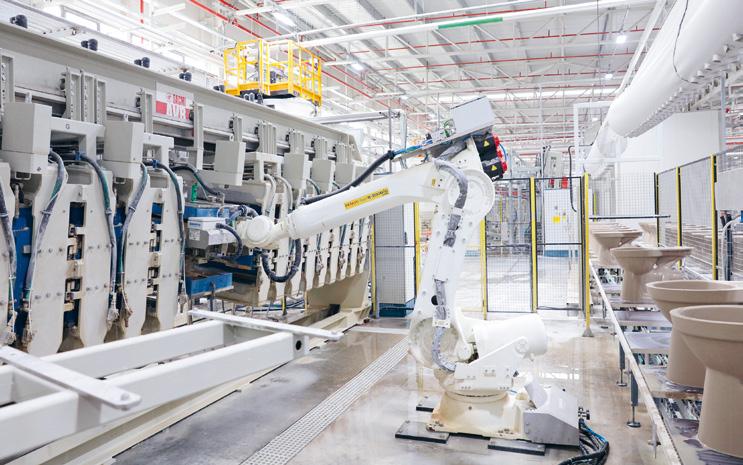
DRYERS
Once the casting and ageing stages have been completed, the pieces enter the new intermittent dryers supplied by Sacmi, two with three chambers (36 cars) and one with two chambers (12 cars). The outstanding feature of these machines is the optimised distribution of hot air, made possible by the use of cone fans which guarantee maximum air distribution uniformity and bring significant advantages in terms of process repeatability and consistency.
Each chamber has a thermal output of 490 kW, sufficient to perform two 11-hour drying cycles per day. The result is a production capacity of 1440 pieces per day in the two 3-chamber dryers and 960 pieces in the 2-chamber dryer. The drying cycle takes place at a controlled temperature (90°C) to bring the residual moisture content of the piece to below 1%.
Precise control of the drying curves is achieved by means of temperature and humidity probes and by the system which governs the controlled emission of residual air to guarantee optimum humidity and temperature parameters inside the chamber at all times.
ROBOTGLAZE
For robotised glazing of the pieces, Sacmi supplied VitrA with seven RobotGlaze solutions. Designed in collaboration by VitrA and the Sacmi
GLI ESSICCATOI
FPV agevola la maturazione del pezzo , riducendo i tempi, risparmiando energia e ottimizzando la logistica. Avviate in VitrA anche le 2 nuove AVB 150 , la soluzione multistampo che sarà dedicata al colaggio di vasi a brida aperta in cinque parti di stampo ed equipaggiata con robot di sformatura, per una produzione media di oltre 730 articoli al giorno. Ridotte al minimo le operazioni manuali, che si limitano all’ispezione del pezzo ed al carico su carro alla fine del sistema di trasporto e deposito pezzi, gestito dal robot, che ne agevola la maturazione.
Completate le fasi di colaggio e maturazione, gli articoli entrano nei nuovi essiccatoi intermittenti, due da tre camere (36 carrelli) ed uno da due camere (12 carrelli). Queste soluzioni Sacmi si caratterizzano per la distribuzione dell’aria calda ottimizzata, grazie ai ventilatori a cono che garantiscono massima uniformità nella distribuzione dell’aria, con vantaggi in termini di costanza e ripetibilità del processo.
Ogni camera è dotata di potenzialità termica pari a 490 kW, sufficiente per eseguire due cicli di essiccazione al giorno, della durata di 11 ore ciascuno. Ne risulta una produttività pari, rispettivamente, a 1.440 pezzi al giorno (nei due essiccatoi a 3 camere) e 960 pezzi (nell’essiccatoio a due camere). Il ciclo di essiccazione avviene a temperatura controllata (90 °C) per portare l’umidità residua dell’articolo al di sotto dell’1%. Il puntuale controllo delle curve di essiccazione è reso possibile da opportune sonde di temperatura e umidità e dal sistema che governa l’espulsione controllata dell’aria residua, per garantire sempre i parametri ottimali di umidità e temperatura all’interno della camera.

SMALTATURA CON ROBOTGLAZE
Per la smaltatura robotizzata degli articoli, Sacmi ha fornito a VitrA 7 soluzioni RobotGlaze
80 CWR 154/2023 sanitaryware FOCUS ON
Dryers - Essiccatoi
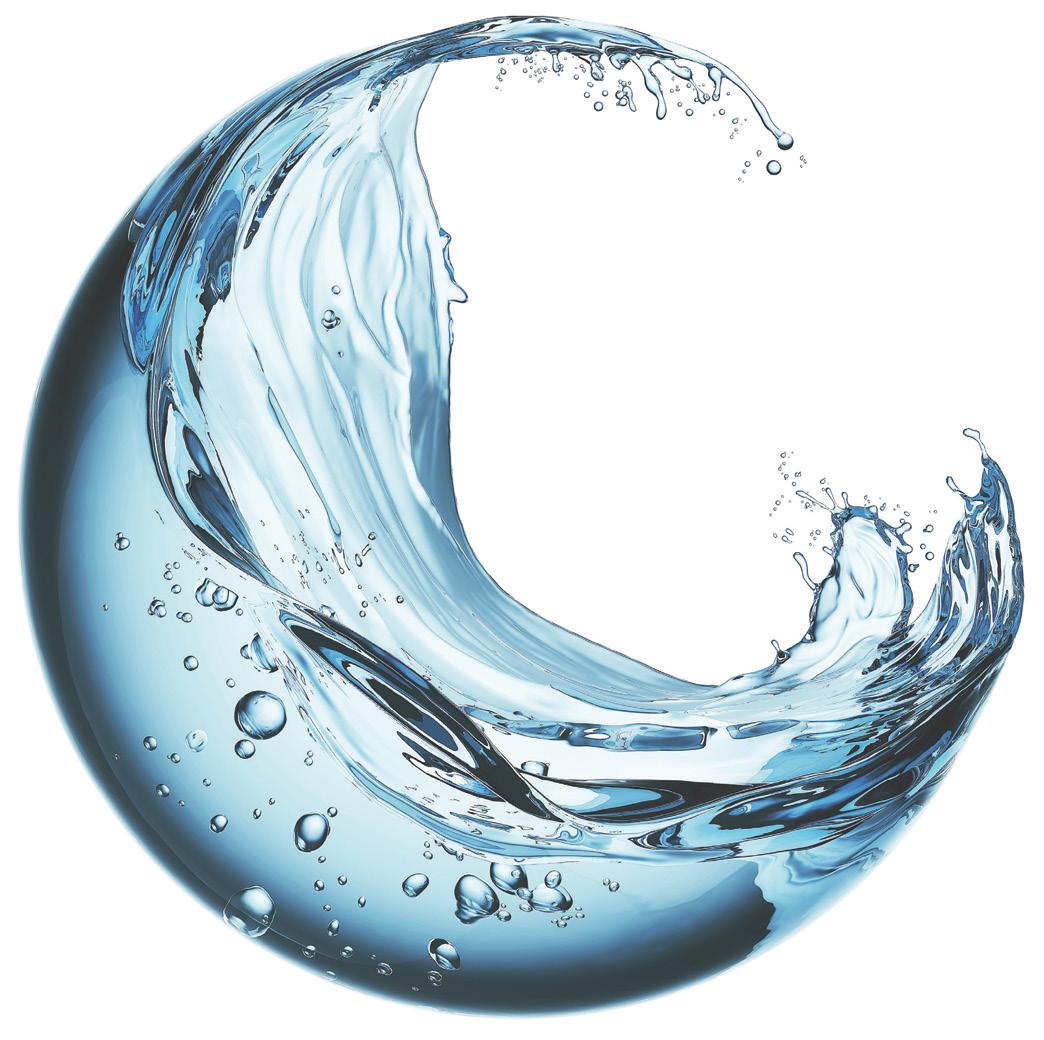
team, this solution stands out for its total automation. It is specially configured with two handling robots for each cell, which control movements and in the case of WCs transfer the piece to the siphon glazing machines.
Each cell can handle from 730 to more than 1050 pieces per day, according to the production mix. During this stage, VitrA will use four of the new complete glazing lines for WCs and three for washbasins. The solution is equipped with all the latest technology for optimising glaze consumption and overspray recovery, including the exclusive Sacmi Mass Control® system and the glaze recovery system based on water curtain filters. A crucial part of the glazing cell is the Sacmi-Gaiotto GA-OL 9-axis (6 + 3 optional) robot, equipped with software for offline programming of the glazing recipes. Glaze application is carried out using the GDA 80 spray-gun, Sacmi’s popular zero-maintenance solution which has become a benchmark in the market.
KILNS
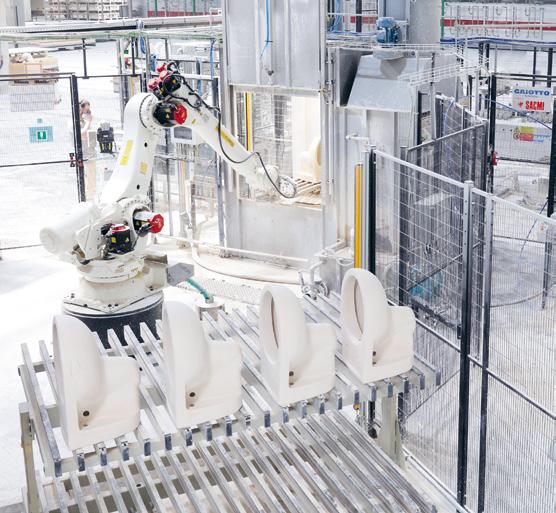
vasi, 3 alla smaltatura dei lavabi. Presenti anche tutti gli accorgimenti per ottimizzare il consumo di smalto e recuperare l’overspray, dal sistema esclusivo Sacmi Mass Control® al sistema di recupero dello smalto tramite filtri a velo d’acqua Protagonista della cella è il robot GA-OL Sacmi-Gaiotto a 9 assi (6 + 3 opzionali), equipaggiato con il software per la programmazione offline delle ricette di smaltatura.
L’applicazione dello smalto è gestita dalla pistola GDA 80, la soluzione zero maintenance di Sacmi, divenuta riferimento nel mercato.
LE MACCHINE TERMICHE
For its fifth plant, VitrA has chosen a state-of-the-art TWS Sacmi-Riedhammer tunnel kiln with a length of 135 metres, a width of 3.6 metres and a working height of 800 mm. The tunnel kiln can handle up to 135 cars holding 82 tons of product per day, equivalent to 3,280 pieces of various types.
The kiln is equipped with EMS 400, Riedhammer’s top-of-the-range solution for recovering air, which serves to pre-
Frutto di un lavoro progettuale comune tra i team VitrA e Sacmi, l’automazione totale delle operazioni distingue questa soluzione, configurata con due robot di handling per ogni cella che governano le movimentazioni e, nel caso dei vasi, il conferimento dell’articolo alla smaltasifoni. Ogni cella può gestire da 730 a oltre 1.050 articoli al giorno, a seconda del mix produttivo. In questa fase, 4 delle nuove linee complete saranno dedicate da VitrA alla smaltatura dei
Per il suo quinto impianto, VitrA ha scelto il forno a tunnel di ultima generazione, TWS Sacmi-Riedhammer da 135 metri di lunghezza, 3,6 di larghezza e altezza utile 800 mm. Il tunnel può accogliere sino a 135 carri per 82 tonnellate di prodotto al giorno, pari a 3.280 pezzi nelle varie tipologie. Il forno è equipaggiato con EMS 400, il top di gamma delle soluzioni Riedhammer per il recupero dell’aria per il preriscaldo dell’aria di combustione al-

82 CWR 154/2023 sanitaryware FOCUS ON
RobotGlaze
Tunnel kiln
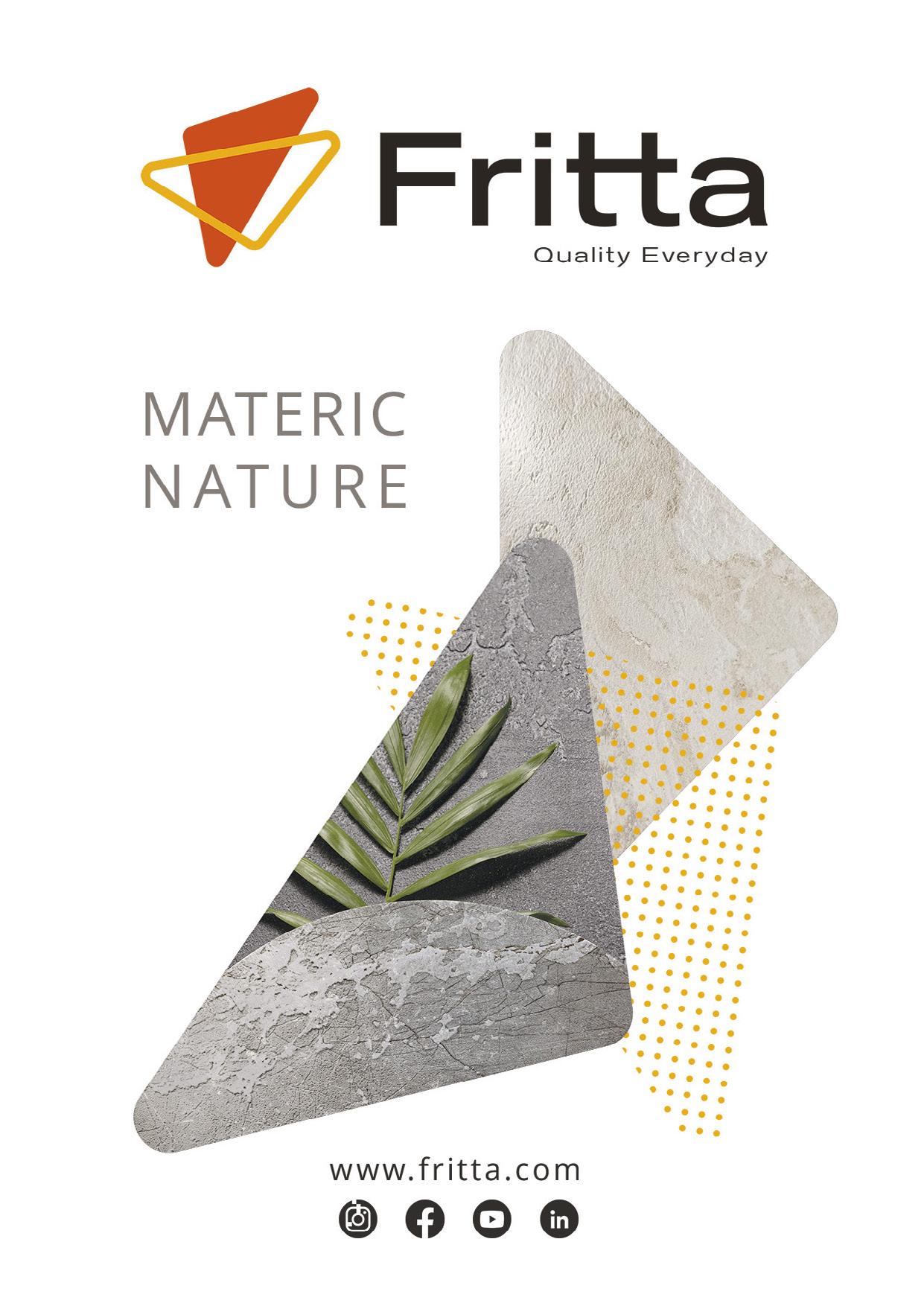
heat the combustion air to a temperature of 400°C. When operating at full capacity, this reduces consumption to just 810 kcal/kg of product net and ensures a uniform temperature distribution.
In addition to the tunnel kiln, Sacmi also supplied a shuttle kiln, an 18-metre Pulse Firing HWS equipped with 12+12 cars to handle a total of 720 pieces/cycle with the standard mix of pieces (equivalent to approximately 20 tons of product).
In this case too, maximum attention was devoted to the reduction of energy consumption to 1380 kcal/kg of product net at full capacity during second firing.

One of the special features of the Sacmi-Riedhammer HWS is the “double door” configuration, which facilitates loading and unloading operations and increases the amount of time the kiln is available for firing. The solution is also equipped with all the latest technology for automation of handling operations from loading and unloading the pieces in the cars to control of the handling system.
Finally, in order to respond to VitrA’s need to meet stringent emission reduction requirements, the combustion systems of both the tunnel and shuttle kilns are already set up for the use of hydrogen. This seals VitrA’s reputation as an environmentally conscious company which can rely on Sacmi as its ideal partner. ◼
The EBP-Bathroom Sustainability Report 2022
Under the slogan “We are building a healthy future together”, Eczacıbaşı Building Products- Bathroom (EBPB) has released its Sustainability Report for 2022. The report summarises the company’s strategies and progress, most notably the use of 90% energy from renewable sources and the reduction of carbon emissions by 38.5% compared to 2021. In 2022, the group reduced all electricity-related carbon emissions to zero by transitioning to renewable sources and installing a 4 MW photovoltaic plant on the roof of the Bozüyük facility.
EBPB also achieved an 87% production waste recycle rate, resulting in savings of 2% of annual energy consumption, equivalent to a total of 8,700 MWh.
It has also adopted numerous social sustainability initiatives, such as increasing the proportion of women in the workforce: 50% of new hires, 38% of employees and 40% of top management are women.
la temperatura di 400 °C, riducendo i consumi a pieno carico a sole 810 kcal/kg di prodotto netto, insieme alla massima uniformità nella distribuzione delle temperature. Oltre al tunnel, Sacmi ha fornito un forno intermittente –HWS Pulse Firing da 18 metri – equipaggiato con 12+12 carri per un totale di 720 pezzi/ciclo nel mix standard, pari a circa 20 tonnellate. Anche in questo caso, massi-
ma attenzione alla riduzione dei consumi, pari ad 1,380 kcal/kg di prodotto netto a pieno carico in seconda cottura. Tra le peculiarità del forno Sacmi-Riedhammer, la configurazione a “doppia porta”, per agevolare le sequenze di carico e scarico, aumentando la disponibilità del forno.
La soluzione è dotata di tutti gli accorgimenti per l’automazione del trasporto, dall’inserimento-estrazione degli articoli sino alla gestione delle movimentazioni.
Infine, in accordo con la richiesta di VitrA di rispondere alle pressanti esigenze di contenimento delle emissioni in atmosfera, il sistema di combustione di entrambi i forni, a tunnel e intermittente, è già predisposto per l’idrogeno. Si conferma quindi la connotazione fortemente green del Gruppo VitrA che trova in Sacmi il partner ideale. ◼
Il Bilancio di Sostenibilità 2022 di EBP-Bathroom
All’insegna dello slogan “We are building a healthy future together”, Eczacıbaşı Building Products- Bathroom (EBPB) ha pubblicato il suo Bilancio di Sostenibilità 2022, formalizzando le strategie e i progressi raggiunti, in primis l’utilizzo del 90% di energia proveniente da fonti rinnovabili e la riduzione delle emissioni di carbonio del 38,5% rispetto al 2021. Nel 2022 il gruppo ha ridotto a zero tutte le emissioni di carbonio legate all’energia elettrica, acquistandola da fonti rinnovabili e installando un impianto fotovoltaico da 4 MW sul tetto dello stabilimento di Bozüyük.
In tema di riciclo dei rifiuti di produzione, EBPB ha raggiunto un tasso dell’87%, con un risparmio pari al 2% del consumo energetico annuale, per un totale di 8.700 MWh.
Numerose le iniziative rivolte alla sostenibilità sociale, come l’incremento delle quote rosa nell’organico: il 50% delle nuove assunzioni, il 38% dei dipendenti e il 40% delle figure apicali è composto da donne.
84 CWR 154/2023 sanitaryware FOCUS ON
Shuttle kiln - Forno intermittente
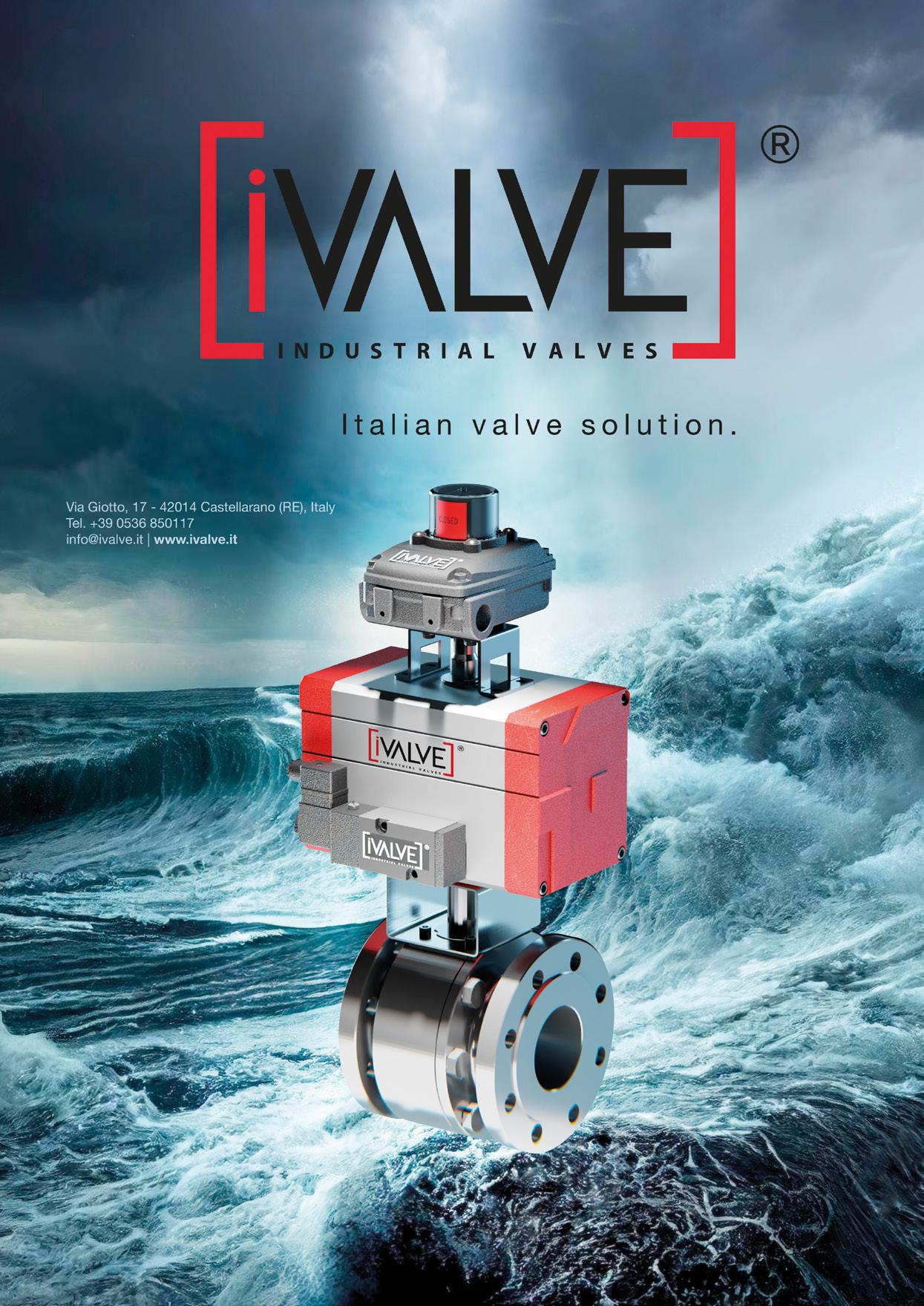
Isvea: Making the difference through Italian design
Isvea, il design italiano che fa la differenza
Silvia Lepore (s.lepore@kairosmediagroup.it)
Founded in 1962 in Sant’Eusanio Del Sangro (Chieti, Italy), Isvea was acquired in 2013 by the Turkish group Ece Holding and today carries out all its production activities in five modern facilities in Corum, Turkey. Despite its relocation, the company maintains strong ties with Italy with the aim of continuing to deliver the renowned elegance of Italian taste, aesthetics and lifestyle. As Erdem Cenesiz, Chairman of Ece Group and Isvea, tells us, “Italy is the first country that comes to mind when we think of fashion and design”.
All Isvea collections are a combination of the high technical quality achieved in the Corum factories and the research and design work carried out by Italian designers and design firms such as Simone Valsecchi, Sabrina Selli, Ettore Giordano, Wau Architetti, Nativita Design House, OMC2 Design Studio, Art.Lab and Genesis Research&Design. These collaborations have garnered prestigious international recognitions in recent years, including the Red Dot Award, IF Design Award, Plus X Award, EDIDA Elle Deco International Design Award, A’ Design Award and Xone Design Award.
We met Erdem Cenesiz to find out more about the world of Isvea.
CWR: What is Isvea’s current production?
ERDEM CENESIZ: Isvea produces vitreous china sanitaryware, fireclay shower trays and kitchen sinks, bathroom furniture, concealed cisterns and toilet seat covers. Annual production capacity in the ceramic segment stands at 1.95 million vitreous china pieces and 450,000 fireclay pieces. We have a multi-brand positioning strategy with the Isvea brand for the premium and high segment and the ECE Banyo brand for the mid and basic segment.
All our production activities are concentrated in Corum, while our sales and marketing operations are more strategically located in Istanbul, from where we handle domestic sales and exports to 65 foreign countries.
CWR: What are your key strengths?
E. CENESIZ: We try to excel in every area of our business. We have state-of-the-art production facilities that guarantee the highest standards of quality and efficiency as well as a high production capacity. Our marketing and customer support strategies are also aimed at achieving excellence and maximum customer satisfaction. We have a diversified product range, extensive inventory availability and the ability to
Fondata nel 1962 a Sant’Eusanio Del Sangro (Chieti, Italia), Isvea fu acquisita nel 2013 dal gruppo turco Ece Holding e oggi realizza la sua produzione in cinque moderni impianti tutti situati a Corum in Turchia. Il legame con l’Italia non si è mai reciso. Al contrario: l’obiettivo di Isvea è proprio continuare a portare sul mercato il gusto raffinato, l’estetica e il lifestyle italiani, perché, come ci dice il presidente di Ece Group e Isvea, Erdem Cenesiz, “l’Italia è il primo paese a cui pensiamo quando parliamo di moda e design”.
Per questo, tutte le collezioni Isvea combinano l’alta qualità tecnica raggiunta negli stabilimenti di Corum con la ricerca e lo sviluppo sul design realizzato da designer e studi italiani, come Simone Valsecchi, Sabrina Selli, Ettore Giordano, Wau Architetti, Nativita Design House, OMC2 Design Studio, Art.Lab, Genesis Research&Design. Collaborazioni che sono valse negli ultimi anni importanti premi internazionali, quali gli Award di Red Dot, IF Design, Plus X, EDIDA Elle Deco International Design, A Design, e Xone Design.
Incontriamo Erdem Cenesiz per conoscere più da vicino il mondo Isvea.
CWR: Qual è la produzione attuale di Isvea?
ERDEM CENESIZ: Isvea
produce sanitari in vitreous china, piatti doccia e lavelli da cucina in fireclay, mobili da bagno, cassette e coprivasi. La capacità produttiva annuale nel comparto ceramico è di 1,95 milioni di pezzi in vitreous china e di 450mila pezzi in fireclay. Sul mercato siamo presenti con due brand: il marchio Isvea per i prodotti di fascia alta ed ECE Banyo per la fascia media e bassa.
Tutte le produzioni sono concentrate a Corum, mentre le strutture commerciali e marketing sono più strategicamente ubicate a Istanbul da dove gestiamo l’attività di vendita sul mercato domestico e nei 65 Paesi esteri nei quali esportiamo i nostri prodotti.
CWR: Quali sono i vostri punti di forza?
E. CENESIZ: Cerchiamo di distinguerci in ogni aspetto dell’attività. Sul fronte produttivo possiamo contare su impianti all’avanguardia che garantiscono i più elevati standard di qualità ed efficienza e una capacità produttiva elevata. Per quanto riguarda il nostro approccio al mercato e il customer service, anch’essi sono orientati all’eccellenza e alla massima soddisfazione del cliente, a cui offriamo una gamma di prodotti diversificata, grandi disponibilità dei magazzini, ma anche la capacità di rispondere prontamente a richieste e dinamiche di mercato che mutano con grande rapidità.
86 CWR 154/2023
respond promptly to rapidly changing market demands and trends.
We also maintain a strong focus on design, which is perhaps the most distinctive element of our business. It is no coincidence that the slogan “Making the difference through design” features on all Isvea’s communication. We aim to stay true to the ethos that has defined the brand’s entire history, drawing inspiration from the ideals of uniqueness and sophistication rooted in Italian culture and history. At the same time, we strive to achieve a perfect balance between aesthetics, functionality and sustainability. In other words, each of our products must be aesthetically pleasing, but it must also simplify our daily lives and be durable.
CWR: What were your most important initiatives in 2023?
E. CENESIZ: This year we have completed a series of investments on our fireclay shower tray and sink production lines and at our concealed cistern production facility. These improvements will enable us to respond more effectively to market demand. We have also laid the foundations for expanding our market presence through the latest product in-
E poi c’è la grandissima attenzione al design, forse l’elemento più distintivo della nostra attività. Non a caso campeggia nello slogan “Making the difference through design” che accompagna la comunicazione Isvea. In questo ambito abbiamo voluto rimanere fedeli all’approccio che ha caratterizzato tutta la storia di questo brand, ispirata ai concetti di unicità e raffinatezza che rimandano alla cultura e alla storia italiana. A questi elementi abbiamo aggiunto la ricerca continua del perfetto equilibrio tra estetica, funzionalità e sostenibilità: vale a dire, ognuno dei nostri prodotti deve esse-

re bello, ma deve anche semplificare la nostra vita quotidiana e durare nel tempo.
CWR: Quali sono state le iniziative più importanti nel 2023? E. CENESIZ: Quest’anno abbiamo concluso un programma di investimenti nello stabilimento dove produciamo piatti doccia e lavelli in fireclay e cassette; i miglioramenti apportati ci permettono ora di rispondere meglio alla domanda del mercato. Abbiamo anche posto le basi per aumentare la nostra quota di mercato relativamente alle ultime novità di prodotto lanciate in questi mesi e presentate a Unicera in novembre.
 Talking to...
Erdem Cenesiz
Talking to...
Erdem Cenesiz
87 CWR 154/2023
FOCUS ON sanitaryware
novations which we introduced in recent months and presented at Unicera in November. Examples include the new Tornado WC and Waterfall, one of the most innovative WCs with Ultimate Flush technology. At the same time, we plan to strengthen our presence in the premium segment with the latest Colorisvea collections, now available with new designs and in the two new colours terracotta and stone grey, and with the Fluido and Vea series which we have added to our artisan product segment.
CWR: Are you satisfied with your participation in Unicera?

E. CENESIZ: Very much. Unicera is not only our domestic trade fair, but is also one of the most important global events in our industry. This year we chose a booth concept inspired by our Italian roots, featuring new colours, designs and textures reminiscent of Mediterranean atmospheres. The concept was greatly admired by our customers.
CWR: Where are your main markets?
E. CENESIZ: We have a presence at more than 500 points of sale across 65 countries, but the USA, South America, France, Germany, the UK and the Pacific region are among the areas where we aim to expand our trade volume in 2024.
CWR: What is the state of health of the building industry in Turkey?
E. CENESIZ: The presence of Ece Holding across multiple manufacturing sectors gives us a more comprehensive view of the Turkish building industry and a better understanding of the dynamics at play. The building industry in Turkey currently appears to be navigating through a landscape that presents both challenges and opportunities. On the one hand, we observe a steady demand for construction activities driven by urbanisation, infrastructure development and housing
CWR: Siete soddisfatti della partecipazione a Unicera?
E. CENESIZ: Molto. Unicera non è solo la nostra fiera domestica, ma è anche uno degli eventi internazionali più importanti del nostro settore. Quest’anno abbiamo scelto un allestimento ispirato all’eredità che proviene dalle nostre radici italiane, presentando nuovi colori, design e texture che richiamano le atmosfere del Mediterraneo. Un concept molto apprezzato dai nostri clienti.
CWR: Quali sono i vostri mercati target?
Parlo ad esempio del nuovo WC “Tornado” e di “Waterfall”, un WC tra i più innovativi, dotato di tecnologia Ultimate Flush. Allo stesso tempo, contiamo di rafforzare la nostra presenza nel segmento premium, sia con le ultime collezioni “Colorisvea”, arricchite con nuovi design e i due nuovi colori terracotta e grigio, sia con le serie Fluido e Vea che abbiamo aggiunto alla gamma prodotti ispirati all’artigianalità.
E. CENESIZ: Siamo presenti in oltre 500 punti vendita in 65 Paesi, ma nel 2024 puntiamo a crescere soprattutto negli Stati Uniti, in America Latina, in Francia, Germania e Inghilterra, oltre all’area del Pacifico.
CWR: Qual è l’andamento del settore costruzioni in Turchia?

E. CENESIZ: La presenza di Ece Holding in più settori manifatturieri ci consente di avere una visione più completa dell’industria turca delle costruzioni e quindi una comprensione migliore delle dinamiche in gioco. Al momento, l’edilizia in Turchia sembra navigare tra sfide e opportunità. Da un lato, osserviamo un livello di attività del settore costruzioni piuttosto costante, trainato dall’urbanizzazione, dallo sviluppo delle infrastrutture e dalle esigenze abitative. Dall’altro, la fluttuazione dei costi dei materiali, i cambiamenti normativi e la concorrenza sul mercato contribuiscono a rendere il contesto più complesso per chi vi opera.
88 CWR 154/2023 sanitaryware FOCUS ON



needs. On the other hand, fluctuations in material costs, regulatory changes and market competition create a more complex operating environment.
In the medium term, we anticipate continued growth in the construction sector, supported by government initiatives and ongoing development projects.
CWR: How have you dealt with the challenges of 2023 and how do you expect to close the current financial year?
E. CENESIZ: We have obviously seen a decline in demand across almost all markets, together with an increase in production costs, including labour. We have responded to this new environment with a two-pronged approach: on the one hand by accelerating the development of new products, and on the other by implementing measures aimed at increasing savings by optimising our operational efficiency. Our primary goal for 2023 was to conclude the year without a downturn with respect to 2022, regardless of the economic contraction. This means that all our efforts have been directed towards improving our resilience in a market scenario characterised by increased uncertainty, and laying the foundations for long-term sustainable growth. I believe we have succeeded in this aim, and even in the event of a potential contraction in the first quarter of 2024 I am confident that we will be able to rapidly capitalise on the subsequent upswing. By focusing on innovation, operational excellence, strategic partnerships and rapid adaptation to market dynamics, we are steadfast in our commitment to sustainably expand our business in 2023 and beyond. ◼

Guardando al medio termine, prevediamo che il settore continuerà a crescere, sostenuto dalle iniziative governative e dai progetti di sviluppo in corso.
CWR: Come avete gestito le sfide del 2023 e come prevedete di chiudere l’esercizio?
E. CENESIZ: Abbiamo ovviamente osservato un calo della domanda su quasi tutti i mercati, unitamente ad un incremento dei costi di produzione, incluso il costo del lavoro.
Abbiamo affrontato questo
nuovo contesto agendo su due fronti, da un lato accelerando sullo sviluppo di nuovi prodotti, dall’altro implementando misure mirate ad incrementare i risparmi attraverso l’ottimizzazione dell’efficienza operativa. Il nostro obiettivo per quest’anno era riuscire a chiudere l’esercizio senza flessioni rispetto al 2022, indipendentemente dalla contrazione economica.
Tutti i nostri sforzi sono stati quindi orientati ad aumentare la nostra resilienza in uno scenario di mercato caratterizzato da maggiore incertezza, e a porre le basi per una crescita sostenibile di lungo periodo. Ritengo ci siamo riusciti e anche qualora dovessimo affrontare una contrazione di mercato nel primo trimestre del 2024, sono fiducioso che sapremo cogliere rapidamente la successiva ripresa.
Concentrandoci sull’innovazione, sull’eccellenza operativa, su partnership strategiche e sul rapido adattamento alle dinamiche del mercato, siamo decisamente orientati ad uno sviluppo sostenibile della nostra attività nel 2023 e oltre. ◼
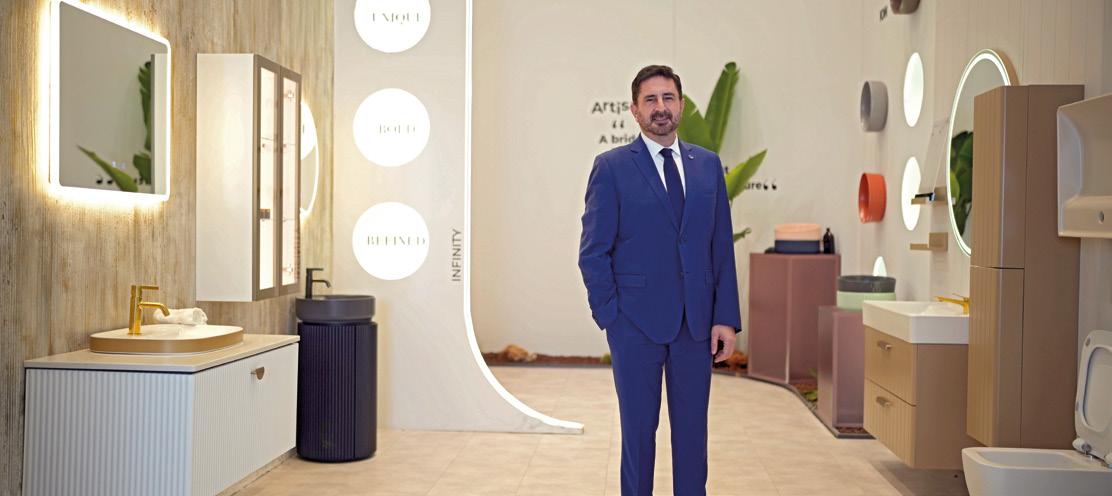
90 CWR 154/2023 sanitaryware FOCUS ON
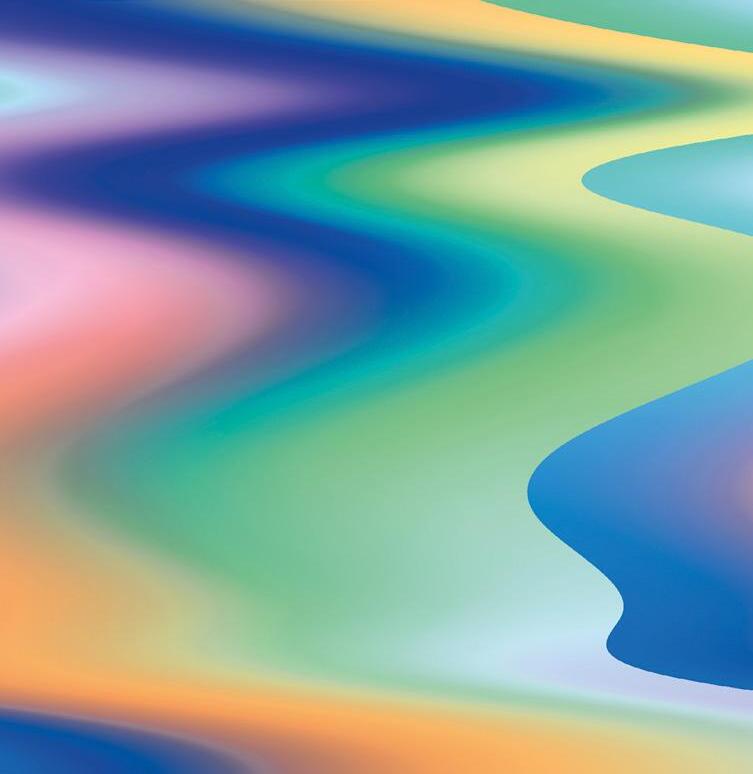

#savethedate 26 Feb - 1 Mar 2024 València - Spain cevisama.com #Cevisama24
Increasingly sustainable solutions for sanitaryware production
Soluzioni sempre più sostenibili nella produzione di sanitari
Imerys (Paris, France)
As governments and consumers become increasingly preoccupied with sustainability issues, the role of industry in developing sustainable solutions has never been more critical. World-leading mineral specialties supplier Imerys has made a firm commitment to integrating sustainability into every aspect of its business. This includes supporting its customers’ own transition to a low-carbon economy through a growing portfolio of market-driven solutions which combine innovation with sustainability. This commitment is exemplified by the recent innovations the company has developed for sanitaryware, which include solutions that mitigate waste and losses, reduce energy and water consumption, lower CO2 emissions and extend the lifespan of the end product.
One example is the company’s tried-and-tested ShrinkSan® kiln furniture system. This patented solution is a sustainable alternative to disposable ceramic plates used to control shrinkage during the firing of sanitaryware products such as toilet bowls. ShrinkSan® can be used more than 800 times , avoiding an estimated three tonnes of waste (equivalent to 1,000 toilets) being sent to landfill.
A full life-cycle analysis (LCA) of ShrinkSan® conducted in 2021 by PWC concludes that the total impact of using ShrinkSan® is four times lower than that of disposable plates and that the system reduces the overall CO2 footprint of toilet production by 6%.
Further Imerys kiln furniture developments aim to reduce

In un contesto nel quale governi e consumatori sono sempre più sensibili e preoccupati per lo stato di salute dell’ambiente, il ruolo dell’industria nello sviluppo di soluzioni sostenibili è oggi quanto mai strategico. Con questa consapevolezza, Imerys, leader mondiale nella fornitura di materie prime e minerali, si è impegnato a integrare la sostenibilità in ogni aspetto dell’attività. Questo include il supporto ai clienti nella loro transizione verso un’economia a basse emissioni di carbonio, attraverso una gamma di soluzioni che combinano innovazione e basso impatto ambientale. Questo impegno è esemplificato dalle recenti innovazioni sviluppate per l’industria dei sanitari, in grado sia di ridurre sprechi, perdite, consumi energetici e idrici ed emissioni di CO2, sia di prolungare la vita del prodotto finale.
Un esempio è l’ormai collauda-
to sistema di supporteria per forni ShrinkSan®. Questa soluzione brevettata rappresenta l’alternativa sostenibile alle piastre di ceramica monouso utilizzate durante il ciclo di cottura per controllare il ritiro di prodotti sanitari (ad es. i vasi). ShrinkSan®, infatti, può essere utilizzato oltre 800 volte, che equivale ad evitare l’invio in discarica di circa tre tonnellate di rifiuti (valore stimato su 1.000 vasi prodotti).
Una completa Life Cycle Analysis (LCA) condotta nel 2021 da PWC ha confermato che l’impatto totale dell’utilizzo di ShrinkSan® è quattro volte inferiore a quello delle piastre monouso e che questo sistema riduce del 6% l’impronta complessiva di CO2 della produzione di vasi.
Restando nel campo della supporteria refrattaria per forni dedicati alla cottura di sanitari, Imerys ha sviluppato ulteriori soluzioni che mirano a ridurre il consumo energetico e le emissioni.
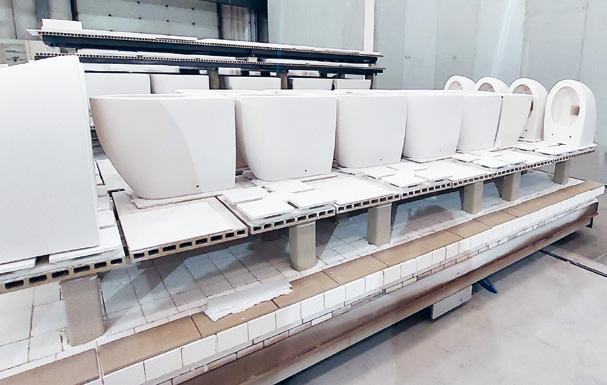
92 CWR 154/2023
The ShrinkSan® system at FA Ceramica - Il sistema ShrinkSan® presso FA Ceramica
energy consumption and emissions in sanitaryware production. The optimised design of Imerys’ new lightweight extruded cordierite batts allows manufacturers to lower overall firing batch weight without compromising performance. This new solution supports the same number of pieces but weighs 17% less than a standard batt system. Imerys’ lightweight designs absorb less energy during firing, resulting in energy savings and a reduction in CO2 emissions.
Some of Imerys’ mineral-based specialties also offer sustainable benefits in sanitaryware production.
Maxicast® fluid kaolin , for example, optimises the performance of high-density slurries used in high-pressure casting whilst reducing reject rates and using less process water. Used in combination with Imerys’ fluid clays, Maxicast® enables manufacturers to produce high-density casts with high wet and dry strength, whilst improving production yield and generating fewer losses during casting and handling.
Used as a replacement for calcium carbonate and silica in sanitaryware glazes, Nyad® M200 and M325 wollastonite grades confer an enhanced surface finish, whilst enabling producers to reduce vitrification temperatures and CO2 emissions.
To guarantee that solutions like these meet sustainability criteria in an objective manner, Imerys has rolled out a science-based life-cycle analysis method aligned with international standards which measures the cradle-to-grave impact and benefits of its portfolio.
Tra queste, le nuove piastre estruse alleggerite, in cordierite e dal design ottimizzato, che consentono ai produttori di ridurre il peso complessivo del lotto in cottura senza compromettere le prestazioni. Questa nuova soluzione supporta lo stesso numero di pezzi ma pesa il 17% in meno rispetto ai sistemi di supporto standard. Assorbendo quindi meno energia durante la cottura, permettono il risparmio energetico e la riduzione delle emissioni di CO2.
Anche alcuni minerali speciali di Imerys offrono vantaggi in termini di sostenibilità nella produzione di sanitari.
Il caolino fluido Maxicast®, ad esempio, ottimizza le prestazioni delle slurry (o barbottine) ad alta densità usate nel colaggio ad alta pressione, riducendo al contempo i tassi di scarto e utilizzando meno acqua di processo. Impiegato in combinazione con le argille flu-
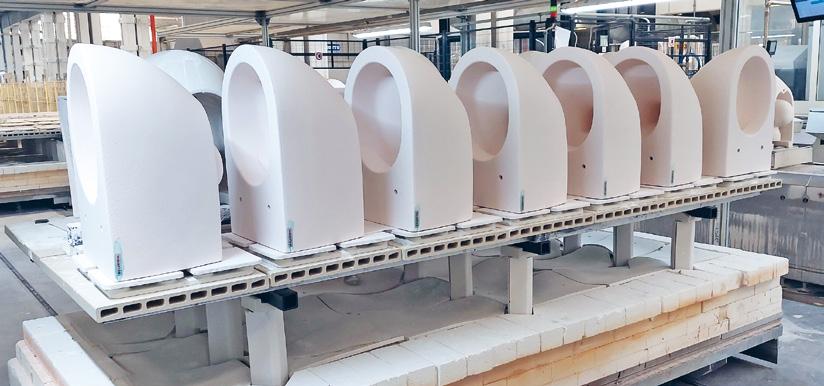
ide di Imerys, Maxicast® consente di realizzare colate ad alta densità con un’elevata resistenza a umido e a secco, migliorando al contempo la resa produttiva e generando meno perdite durante il colaggio e la movimentazione.
Infine, le due tipologie di wollastonite Nyad® M200 e M325: utilizzate in sostituzione del carbonato di calcio e della silice negli smalti per sanitari, conferiscono una migliore finitura superficiale, consentendo ai produttori di ridurre le temperature di vetrificazione e le emissioni di CO2.
Per garantire che soluzioni come queste soddisfino i criteri di sostenibilità in modo oggettivo, Imerys ha implementato un metodo scientifico di analisi del ciclo di vita, in linea con gli standard internazionali, che misura l’impatto e i benefici del suo portafoglio prodotti « from cradle to grave », « dalla culla alla tomba ».
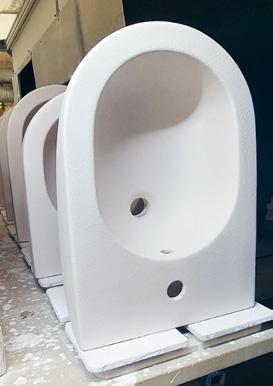
93 CWR 154/2023
FOCUS ON sanitaryware
The ShrinkSan® system at Ceramica Flaminia - IIl sistema ShrinkSan® presso Ceramica Flaminia
These SustainAgility™ Solutions Assessments allow customers to make informed choices based on reliable data when selecting the raw materials they source, and to reduce their own carbon footprint linked to Scope 3 emissions accordingly. To date 55% of the company’s portfolio in terms of value, including 100% of Imerys’ UK kaolin and ball clay-based solutions for sanitaryware, have been the subject of an external LCA assessment. The results of the latter are available on request. Imerys’ technical support teams across Europe, the Middle East, North Africa and Asia are also available to help customers reformulate their recipes and adapt their processes to reduce energy and water consumption and generate less waste. As a responsible mining company, Imerys uses a systematic approach to ensure that sustainable thinking permeates all aspects of its business, from the way it rehabilitates the land to its manufacturing processes and how it manages its supplier chain. Under the aegis of its internal SustainAgility™ programme, Imerys has mapped out a clear roadmap to reduce Scope 1 and 2 greenhouse gas (GHG) emissions by 42% (tCO2/M€) by 2030. At the same time, it will continue to accompany its customers on their own decarbonisation journey by investing in innovative technologies and partnerships that contribute to tackling the most pressing issues the ceramics industry is facing. ◼

Queste valutazioni, denominate “SustainAgility™ Solutions Assessments”, consentono ai clienti di fare scelte informate, basate su dati affidabili, nella selezione delle materie prime da acquistare e di ridurre di conseguenza la propria impronta di carbonio legata alle emissioni Scope 3. Ad oggi, il 55% del portafoglio prodotti di Imerys (in valore) - incluso il 100% delle soluzioni a base di caolino e ball clay per i sanitari prodotte da Imerys nel Regno Unito - è stato oggetto di una valutazione LCA esterna. I risultati sono disponibili su richiesta. I team di supporto tecnico di Imerys in Europa, Medio Oriente, Nord Africa e Asia sono disponibili per aiutare i produttori a riformulare le proprie ricette e adat-
tare i processi per ridurre il consumo di energia e acqua e generare meno rifiuti. In qualità di azienda mineraria responsabile, Imerys utilizza un approccio sistematico per garantire che il pensiero sostenibile permei tutti gli aspetti della propria attività, dal ripristino ambientale delle cave, ai processi di produzione, alla gestione della catena di fornitori. Sotto l’egida del programma interno SustainAgility™, l’azienda ha tracciato una chiara tabella di marcia per ridurre le emissioni di gas serra (GHG) Scope 1 e 2 del 42% (tCO2/M€) entro il 2030. Allo stesso tempo, continuerà ad accompagnare i propri clienti nel loro percorso di decarbonizzazione investendo in tecnologie innovative e partnership che contribuiscano ad affrontare le problematiche più urgenti che l’industria ceramica è chiamata ad affrontare. ◼
Scan the QR code and watch the ShrinkSan® video - Scansiona il QR Code e guarda il video dedicato a ShrinkSan®
ShrinkSan®: what users are saying
Stefano Angelelli, Owner and Production Manager, FA Ceramica (Civita Castellana, Italy).
“ShrinkSan® is practical, easy to use and offers several advantages. Our operators can save time since they no longer need to remove the plates and dispose of them after firing. The waste from the old plates generated a lot of alumina dust when they were thrown away, forcing operators to wear masks; this isn’t a problem with the new system. We also no longer have to worry about ordering the plates in advance, which simplifies procurements. Plus, Imerys’ sales manager was on hand to monitor our progress every step of the way, helping us match the size of the plates to the body shrinkage and supporting us whenever we had any questions.”
Marco Pasquetti, Plant and Production Manager, Ceramica Flaminia (Civita Castellana, Italy).
“The main advantage of ShrinkSan® is definitely environmental. It is a circular solution with a much lower impact than the sacrificial sub-plates which have limited use and take up new raw materials to produce. Our operators are also happy that they no longer have to remove the plates continuously as this allows them to save time. As with all new systems, they were nervous about handling these premium plates to begin with, but they feel more comfortable now. It’s still early days since we’ve only just started testing ShrinkSan®, but I don’t doubt this is a good system.”
ShrinkSan®: il giudizio degli utilizzatori
Stefano Angelelli, Proprietario e Direttore di Produzione di FA Ceramica (Civita Castellana, Italia).
“ShrinkSan® è pratico, facile da usare e offre diversi vantaggi. Innanzitutto, il risparmio di tempo dei nostri operatori che non devono più rimuovere le tradizionali piastre monouso e smaltirle dopo il ciclo di cottura. Durante lo smaltimento, fra l’altro, quei rifiuti generavano molta polvere di allumina, costringendo gli addetti a indossare mascherine. Con il nuovo sistema, questo non è più un problema. Un ulteriore vantaggio riguarda la semplificazione degli approvvigionamenti, poiché non dobbiamo più preoccuparci di ordinare le piastre in anticipo. Inoltre, abbiamo potuto contare su un costante affiancamento del responsabile commerciale di Imerys, che ha monitorato i nostri progressi in ogni fase del processo, fornendo risposte ai nostri quesiti e aiutandoci ad abbinare correttamente le dimensioni delle piastre ShrinkSan® al ritiro dell’impasto”.
Marco Pasquetti, Plant and Production Manager, Ceramica Flaminia (Civita Castellana, Italia)
“Il vantaggio principale di ShrinkSan® riguarda certamente la maggiore tutela dell’ambiente. Si tratta di una soluzione circolare con un impatto molto inferiore rispetto alle sottopiastre che, avendo un uso limitato, implicano un maggior consumo di nuove materie prime e risorse per la loro produzione. I nostri operatori, all’inizio nervosi all’idea di maneggiare questi nuovi supporti « premium », ora giudicano con soddisfazione il risparmio di tempo derivante dal non dover più rimuovere le piastre ogni volta. È ancora presto, dato che abbiamo appena iniziato a testare ShrinkSan®, ma non dubito che questo sia un buon sistema.”
94 CWR 154/2023 sanitaryware FOCUS ON
Discover shrinksan®
Eco-friendly kiln furniture for Sanitaryware
Product description
• Patented kiln furniture with a long lifespan: can be used more than 800 times
Key technical benefits
• Absorbs more than 75% of firing shrinkage vs 55–65% for single-use solutions, generating fewer defected pieces
• Maintains the planarity of the pieces – < 0.5mm gauge on wall face
• Easy to set, install and maintain
Key sustainability benefits
• Waste reduction: avoiding about 3 tons of waste for 1,000 toilets pieces fired
• Full LCA conducted in June 2021 by PwC:
• All indicators examined give ShrinkSan ® impacts at least 4 times lower compared to the disposable plates
• Using ShrinkSan ® reduces the Carbon footprint of toilet production by -6%
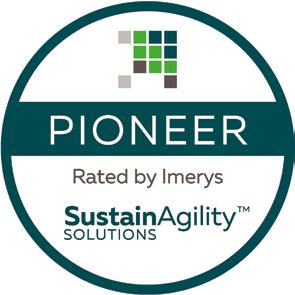
1 Life Cycle Assessment.
2 Product Environmental Footprint

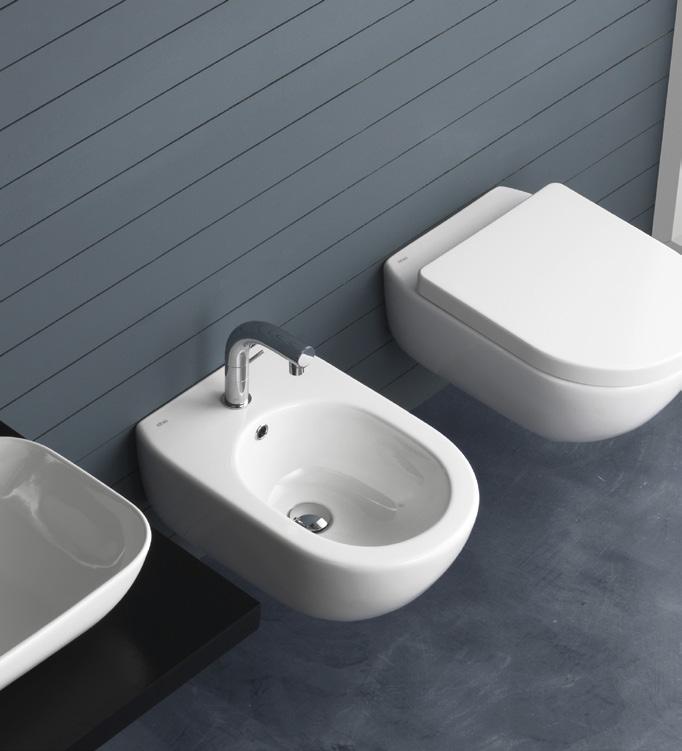
Highest sustainability rating
Imerys launched the SustainAgilityTM Solutions initiative to measure the sustainability profile of its products, combining:
• LCA1 based on PEF2 criteria
• Market signals assessment
Aligned with WBCSD3 framework for PSA4
Validated by a third party (Arthur D Little)
3 World Business Council for Sustainable Development
4 Portfolio Sustainability Assessment
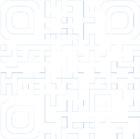
Watch the video
Green Deal actions in sanitaryware production
Le Green Deal Action nella produzione di sanitari
Sacmi Sanitaryware (Imola, Italy)
Completely circular management of fired production waste, maximum recovery of raw materials, water and energy and reduced levels of consumption are the hallmarks of rECOvery solutions from Sacmi Sanitaryware. Developed in synergy with Sacmi Forni & Filter’s Energy and Environment Division, they provide sustainability-focused systems as part of the We ARE Environment range.
Developed in the laboratory based on real-world scenarios (an “average” sanitaryware factory producing a diversified mix of 750,000 pieces a year), rECOvery solutions involve indepth analysis to determine the type and quantity of recoverable material and the technologies necessary to provide immediate, measurable economic and environmental benefits for the customer.
SCRAP RECOVERY
Unlike unfired or dried scrap which is reprocessed as a raw material, fired scrap is normally treated as waste but can in fact be considered a secondary raw material capable of replacing both the hard body components (quartz and feldspar) and the chamotte required for the production of fine fireclay. Sacmi believes that machines must be designed with this principle in mind. This applies, for example, to the grinding lines (an area in which Sacmi has been the world leader for forty years), which can be equipped with multiple stages to obtain a product with the required particle size. The result is zero waste and near-total recyclability of fired scrap , resulting in a more than 10% reduction in virgin raw material consumption
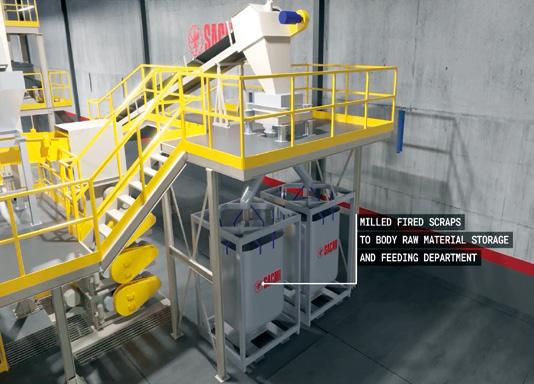
Circolarità totale degli scarti cotti di produzione, massimo recupero di materie prime, acqua, energia, riduzione dei consumi. Questi i caratteri distintivi delle rECOvery solutions della B.U. Sacmi Sanitaryware, una proposta sviluppata in sinergia con la Divisione Energia e Ambiente di Sacmi Forni & Filter dedicata alle soluzioni di trattamento e recupero per la sostenibilità nel solco dell’offerta «We ARE Environment». Messa a punto in Laboratorio prendendo a riferimento un caso reale – una fabbrica “media” di sanitari da 750mila pezzi l’anno e un mix produttivo diversificato –, l’analisi sviluppa e quantifica quantità e tipologia di recuperi applicabili, con relative tecnologie.
L’obiettivo è renderne i vantaggi economici e ambientali immediati e misurabili per il cliente.
RECUPERO SCARTI COTTI
Di solito trattato come rifiuto –a differenza dello scarto crudo o essiccato, ritrattato come materia prima – lo scarto cotto può a sua volta essere considerato una “materia prima secondaria”, in sostituzione sia della quota dei “duri in impasto” (quarzo e feldspati) sia della chamotte necessaria per la produzione di Fine Fire Clay. Secondo Sacmi, è la stessa progettazione delle macchine a dover essere governata a partire da questo principio. È il caso delle linee di macinazione (sulle quali Sacmi è leader mondiale da quarant’anni), equipaggiabili con più stadi per ottenere il prodotto nel range dimensionale richiesto. Risultato, sfridi zero e quasi totale riciclabilità dello scarto cotto con riduzione del consumo di materie prime vergini superiore al 10%.
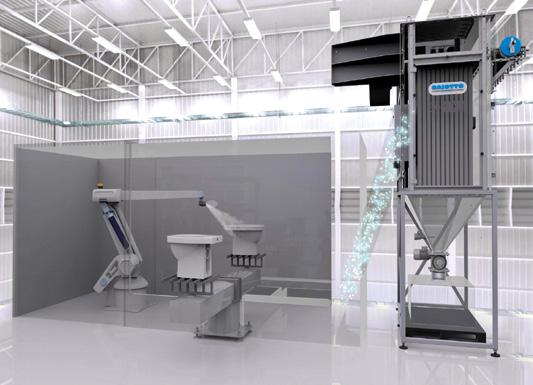
96 CWR 154/2023
Fired scrap recovery - Recupero scarti cotti
Glazing booth - Cabina di smaltatura
DUST RECOVERY AND TREATMENT
Maintaining a dust-free environment is essential for optimising both machinery performance and the well-being of workers. Accumulation of dust can lead to mechanical part malfunctions or reduced reliability, while ensuring a healthy workplace is crucial for employee welfare. Within Europe’s stringent regulatory framework, ceramic sanitaryware factories must adhere to suitable dust abatement measures, necessitating the installation of effective dust removal systems
Through Forni & Filter’s Energy and Environment Division, Sacmi provides a new generation of dry bag filters . Already a tried-and-tested solution in the raw material batching and preparation departments, they are now used for treatment and recovery during the finishing and glazing operations. Once again, this solution brings two benefits: a healthier workplace and waste reduction. For example, in the glazing department these filters allow for 100% overspray recovery
WATER SAVINGS AND SOLIDS TREATMENT
Minimising water consumption and recycling wastewater in order to reduce dependence on water extracted from wells and aquifers form the core principles of a smart manufacturing approach. To recycle wastewater, it needs to be treated so as to recover the solid particles present in the form of suspended precipitate.

RECUPERO E TRATTAMENTO POLVERI
In assenza di polveri in ambiente, macchine e operatori lavorano meglio: le prime, per i problemi che il deposito di polveri può causare al funzionamento e affidabilità delle parti meccaniche; i secondi, soprattutto, devono poter contare su un ambiente di lavoro salubre. Oggetto, in Europa, di un quadro normativo-regolatorio stringente, l’abbattimento delle polveri nelle fabbriche di ceramica sanitaria impone di dotarsi di appositi impianti di depolverazione
Attraverso la Divisione Energia e Ambiente di Forni & Filter, Sacmi propone una nuova generazione di filtri a secco a maniche, applicazione oramai consolidata per i reparti dosaggio e preparazione materie prime, quindi nel trattamento e recupero durante le operazioni di finitura e smaltatura.
Anche in questo caso il risultato è duplice: salubrità dell’ambiente di lavoro e riduzione degli sprechi, con la possibilità, ad esempio in smaltatura, di recuperare il 100% dell’overspray
RISPARMIO IDRICO E TRATTAMENTO SOLIDI
Consumare meno acqua possibile, riducendo il prelievo da pozzi e falde, è al centro dell’approccio smart manufacturing. Acqua che necessita poi di essere trattata, recuperando le particelle solide in essa contenute (il precipitato dei solidi sospesi presenti nei reflui).
Due in questo caso i processi proposti. Il primo è il trattamento chimico-fisico di tipo
“Euroblock”, un’applicazione consolidata da anni, che consente di recuperare le acque e di riutilizzarle in fabbrica per alcuni utilizzi.
La seconda, brevettata da Sac-

97 CWR 154/2023
sanitaryware
FOCUS ON
Water saving solutions - Soluzioni per il risparmio idrico
Water saving by means of tangential flow filtration Risparmio idrico tramite filtrazione tangenziale
Two different processes are used to do this. The first is the Euroblock type chemical/physical treatment, a well-established technique that has been in use for years and allows water to be recovered and reused elsewhere in the factory for certain applications.
The second process, patented by Sacmi, maximises the quantity of recoverable water and raw materials, thereby minimising the volume of water requiring disposal. Known as tangential flow filtration , this process operates without chemical additives , ensuring that the outgoing water is free from impurities. It can consequently be reused for high-value applications such as the preparation of bodies, glazes and plaster moulds or for washing resin moulds. Additionally, the recovered solids can be converted from waste into a reusable resource and fed back into the body preparation system.
Another cutting-edge solution is a membrane ultrafiltration system that allows for 100% recovery of the raw materials dispersed in the mould washing water and glazing lines, thereby reducing water consumption and wastewater discharge by up to 80%
ENERGY RECOVERY AND EMISSIONS REDUCTION
Developed jointly by Sacmi and Riedhammer, the group company specialising in industrial firing for sanitaryware, tableware and special ceramics, the energy-saving and emissions-reduction solutions adopted on kilns are chosen together with customers based on an analysis of the factory’s energy balance
There are two potential solutions: first, the new EMS (energy management system) incorporated into the tunnel kiln range, which allows for partial or total heat recovery; second, self-recovery burners used on shuttle kilns. The flue gases can also be fully recovered by means of heat exchangers and used as an energy source in other areas of the facility. Other possibilities include creating drying systems with minimal energy consumption by harnessing waste energy originating from the kiln and supplying heat to other areas of the plant such as maturing rooms or systems for heating slip or the water used in the body preparation department.
An optimised Riedhammer kiln equipped with a suitable recovery system can improve the factory’s energy balance by as much as 25% , without taking account of the self-generated energy originating from Sacmi’s integrated cogeneration, trigeneration and photovoltaic panel solutions.
All of these solutions can be evaluated and customised on a caseby-case basis according to the specific production context and the customer’s requirements, providing an accurate assessment of the achievable savings and projected payback time. ◼
mi, massimizza recuperi di fluido e materie prime, minimizzando l’acqua che deve essere avviata a smaltimento. In questo caso, il sistema adottato è quello della filtrazione tangenziale, un processo che non richiede l’aggiunta di additivi chimici, con il risultato che l’acqua in uscita non presenta impurità particolari e può quindi essere riutilizzata per scopi più “nobili” come la preparazione impasti, smalti e stampi in gesso e per il lavaggio degli stampi in resina. Anche i solidi recuperati possono essere trasformati da scarto a risorsa, riutilizzandoli nella preparazione impasti. Ultima frontiera è anche il sistema di ultrafiltrazione a membrane che consente di recuperare il 100% delle materie prime disperse nelle acque di lavaggio stampi e nelle linee di smaltatura, riducendo consumi idrici e reflui anche sino all’80%.
RECUPERO ENERGETICO E RIDUZIONE DELLE EMISSIONI
Sviluppate in sinergia tra Sacmi e Riedhammer, l’azienda del gruppo specializzata nella cottura industriale per sanitario, stoviglie e ceramici speciali, le soluzioni energy saving e riduzione delle emissioni sui forni sono definite insieme al cliente a partire da un’analisi del bilancio energetico della fabbrica
Due le opportunità: da un lato, il nuovo sistema EMS (energy management system) per il recupero parziale o totale del calore, integrato nella gamma di forni a tunnel; dall’altro, i bruciatori autorecuperanti nei forni intermittenti. Anche i fumi a camino sono totalmente recuperabili attraverso gli scambiatori di calore, per utilizzarli come fonte di energia in altre aree dell’impianto.
Tra le possibilità, quella di realizzare sistemi di essiccazione a minimo consumo energetico –grazie ai cascami energetici derivanti dal forno – e di alimentare altre zone dell’impianto come le sale di maturazione, i sistemi di riscaldamento barbottina o l’acqua utilizzata nel reparto preparazione impasto.
In cifre, un forno Riedhammer ottimizzato ed equipaggiato con gli opportuni recuperi può consentire un miglioramento del bilancio energetico della fabbrica anche del 25%. Senza considerare la possibilità di aumentare la quota di energia autoprodotta attraverso le soluzioni integrate SACMI di cogenerazione, trigenerazione e installazione di pannelli fotovoltaici.
Tutte le soluzioni sono valutabili e personalizzabili caso per caso, in base al contesto produttivo ed alle esigenze, con una puntuale valutazione dei risparmi conseguibili e dei tempi di ritorno dell’investimento. ◼
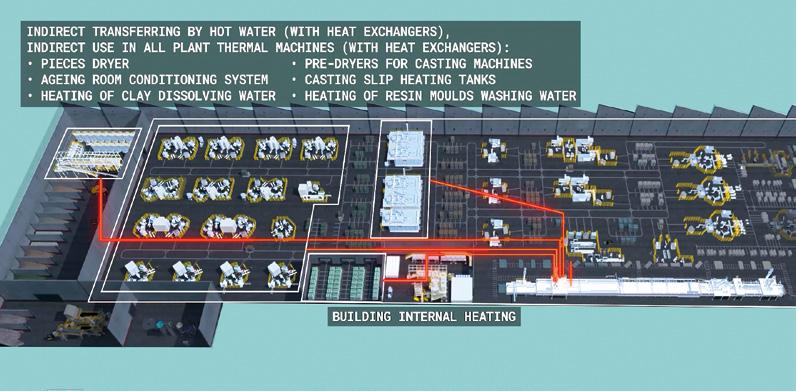
98 CWR 154/2023 sanitaryware FOCUS ON
Energy recovery solutions - Soluzioni di recupero energetico
Brazilian exhibition of coverings, sanitary ware, faucets and finishing materials
Lixil invests in sanitaryware pre-drying
Lixil investe nella pre-essiccazione dei sanitari
Paolo Marcheluzzo, Marcheluzzo (Caldogno, Italy)
Drying is one of the most critical stages of the sanitaryware production process due to its complexity and lengthy duration. It requires considerable space, manpower for loading, unloading and handling the dryer cars, as well as buffer zones. Manufacturers are increasingly seeking methods to reduce process times, minimise consumption levels, recover heat energy and eliminate production losses.
To achieve this, it is more important to focus on pre-drying than on actual drying. This is because the drying process begins immediately after demoulding, then continues in the standing areas in the casting hall and ends on exiting the dryer.
LIXIL CHOOSES MARCHELUZZO
Lixil, one of the world’s leading sanitaryware manufacturers, has once again chosen Marcheluzzo to supply special pre-drying chambers for its factories in Mexico. Accurate control of this specific phase results in significant waste reduction, space optimisation and better management of the final drying process.
The most critical stage of contraction begins immediately after demoulding, and it is here that the material is most vulnerable to temperature changes, air flows and handling. In some cases, after the pieces have been demoulded onto a polyurethane support, they need to be removed for intermediate processing, but this can only be done after they have reached a certain degree of hardening.
HOW THE MARCHELUZZO PRE-DRYER WORKS
The pre-dryer is a chamber with controlled temperature and humidity and low-speed, uniform (one or two-way) air flow over the pieces to handle the material shrinkage phase effectively.
The pieces enter the chamber after demoulding with all their initial moisture content, so the function of the cell is to ensure that the contraction process is completed in a controlled manner.
The air flow is laminar from one side of the cell to the other.
The working temperature usually ranges from 32°C to 42°C, while the relative humidity varies from 80% to 70%. The cycle can have a flat profile (the same values are maintained for the entire standing time) or a curve in which temperature rises over time and the humidity decreases.
The temperature can be monitored by an air handling unit (one for several cells) or by individual hot water heat exchange coils.
The humidity is maintained by a fog pump or steam generator system.
Nel processo produttivo dei sanitari, l’essiccazione è una delle fasi più complesse da gestire sia per le varie criticità che presenta, sia per la quantità di tempo di cui necessita. Per effettuarla servono spazi ragguardevoli, manodopera per il carico, lo scarico e la movimentazione dei carri, buffer di stazionamento. Sempre più produttori richiedono di accorciarne la durata, ridurre i consumi, recuperare l’energia termica e azzerare le perdite in produzione. A tal fine, più che sull’essicazione in sé, diventa fondamentale agire sulla pre-essiccazione in quanto, va specificato, il processo di asciugatura inizia già dopo la sformatura dallo stampo, continua poi nelle aree di sosta in sala colaggio e termina all’uscita dall’essiccatoio.
LIXIL SCEGLIE MARCHELUZZO
Tra i più importanti produttori al mondo di sanitari, Lixil si è affidata ancora una volta a Marcheluzzo per la realizzazione di speciali camere di pre-essiccazione per i suoi stabilimenti in Messico. Il controllo accurato di questa specifica fase comporta una sensibile riduzione degli scarti, un’ottimizzazione degli spazi e una gestione migliore dell’essiccazione finale.
Appena dopo la sformatura dallo stampo, inizia il momento più critico, ovvero quello della contrazione, dove il materia-
le è maggiormente vulnerabile a sbalzi termici, flussi d’aria e movimentazioni.
Vi sono anche casi in cui i pezzi, sformati inizialmente su un supporto in poliuretano, per subire una lavorazione intermedia devono essere rimossi solo dopo aver raggiunto un certo grado di indurimento.
COME FUNZIONA IL PRE-ESSICCATOIO TARGATO MARCHELUZZO
Si tratta di una camera a temperatura e umidità controllate, con basso impatto della velocità dell’aria sui pezzi, flusso uniforme (uni o bidirezionale) per gestire la fase del ritiro del materiale in modo accurato.
I pezzi entrano in camera dopo la sformatura con tutta la loro umidità iniziale: compito della cella è far completare il ritiro in modo controllato.
Il flusso d’aria è laminare, da un lato al lato opposto della cella: la temperatura di lavoro va solitamente da 32 a 42°C, mentre l’umidità relativa varia da 80 a 70%. Il ciclo può essere a profilo piatto (stessi valori per l’intero tempo di stazionamento) oppure con una curva in cui la temperatura sale nel tempo e l’umidità si abbassa.
La temperatura può venire monitorata da una unità di trattamento aria (unica per più celle) o da singole batterie di scambio termico ad acqua calda. L’umidità, invece, viene mantenuta da un sistema a fog pump o con
100 CWR 154/2023

In applications carried out by Marcheluzzo, the cycle time is the same as that of the dryers, usually due to production flow requirements. The size of the cells, positioned in front of the entrance door, is proportionate to that of the dryers.
CLEAR AND QUANTIFIABLE BENEFITS
The Marcheluzzo pre-dryer offers Lixil the following advantages:
• It avoids the need to leave pieces to stand in areas without temperature and humidity control, which would expose the dryer cars to harmful air currents and excessively low humidity values and the potential risk of cracking. Car movements inside the factory are reduced, and if they are parked in the casting room, the loss of humidity must be promptly rectified by the air conditioning system to avoid the formation of cooler and wetter areas.
• The initial piece stabilisation and contraction phases are controlled by a suitable choice of parameters.
• Dryers with high air speeds can be used without causing breakages due to different rates of internal shrinkage or strong localised airflows.
• Finishing can be performed midway through the drying process and any supports not suitable for high temperatures can be removed.
A good pre-dryer can therefore overcome a number of critical issues during production and should be taken into consideration when the product has to undergo a specific treatment before being introduced into the final dryer. ◼
generatore di vapore. Nelle applicazioni realizzate da Marcheluzzo, il tempo ciclo, solitamente per necessità di flusso produttivo, uguaglia quello degli essiccatoi; la stessa dimensione delle celle, posizionate di fronte alla porta di ingresso, rispecchia quella degli essiccatoi.
VANTAGGI EVIDENTI E QUANTIFICABILI
Il pre-essiccatoio Marcheluzzo ha permesso a Lixil di:
• Evitare lo stazionamento dei pezzi in aree non gestite termo igrometricamente, che esporrebbero i carri a dan-

nose correnti d’aria e a valori di umidità troppo bassi, possibile causa di crepe. La movimentazione dei carri stessi all’interno della fabbrica viene ridotta e, qualora dovessero stazionare in sala colaggio, la perdita di umidità deve essere prontamente gestita dal sistema di climatizzazione, per evitare la formazione di zone fredde e più umide.
• Controllare con un’opportuna gestione dei parametri le fasi di stabilizzazione e contrazione del pezzo.
• Utilizzare essiccatoi con elevate velocità dell’aria senza incorrere in problemi di rotture dovute a differenti contrazioni interne o forte flusso d’aria localizzato.
• Eseguire la finitura a metà essiccazione, o togliere un eventuale supporto speciale non idoneo per alte temperature
Un buon pre-essiccatoio sopperisce così ad alcune criticità non di poco conto in fase produttiva ed è una soluzione da prendere in considerazione quando il prodotto ha bisogno di un trattamento dedicato prima di entrare nell’essiccatoio finale. ◼
101 CWR 154/2023 FOCUS ON sanitaryware
SINCE 1977
CERAMICS
CuCColini – Virto CeramiCs & inter ser
■■■

With a leadership position in the production and distribution of vibrating sieves and iron removers for the ceramic industry dating back to 1989, Cuccolini is an established presence in the industry.
With more than 20,000 units installed in tile and sanitaryware facilities worldwide, Cuccolini’s vibrating sieves continue to operate even after more than two decades and stand out for their ease of maintenance, low cost, quality and reliability.
Owned by the Virto Group since 2008, Cuccolini operates in the ceramic industry under the Virto Ceramics brand. The company offers a complete range of vibrating sieves for slips, glazes, spray-dried products and powders/granules deriving from raw materials. It also supplies dedicated iron removers for slips and glazes, guaranteeing the quality and precision for which the brand is renowned within the industry.
In sanitaryware production, the most popular sieve is the VLB 1200, a single-motor-driven device for the filtration of high-fluidity liquids. It is installed downstream of mills and mixers with the aim of obtaining a uniform slip free of lumps and non-standard sized granules.
Originally conceived by Cuccolini more than 50 years ago, the VLB sieve has undergone numerous technical upgrades over the decades. In recent years, it has been improved with a robust and durable design housed in a lightweight structure that allows for optimal transmission of vibrations to the sieving surface. Customers appreciate its superior performance, with a capacity between 15% and 30% higher than similar products, as well as a high
degree of efficiency and versatility even with different mesh sizes. In addition, the VLB can be configured with one or two sieving levels depending on separation requirements.
Currently, Cuccolini can supply the VLB in sizes 1200 and 1500, equipped with a lifting system integrated into the upper lid structure and an internal washing system. This makes maintenance and cleaning extremely simple and safe for operators.
The characteristics of the lid lifting system on the 1200 version include:
• Lid made entirely of AISI 304 stainless steel with internal central diffuser and washing system housing;
• Flanged pipe for stable connection to the inlet;
• 2 pneumatic cylinders with ceiling attachment flange for raising the lid together with the upper sieving section by means of a coupling system. Under the Virto Ceramics brand name, Cuccolini supplies spare parts for all machinery produced over the decades, thereby ensuring operational continuity of the original equipment. Cuccolini’s Aftermarket Division and worldwide distributor network provide the necessary support to minimise production downtime.
Con una storia di leadership sin dal 1989 nella produzione e commercializzazione di vibrovagli e deferrizzatori per l’industria ceramica, Cuccolini è una presenza consolidata nel settore.
Con oltre 20.000 unità installate in tutto il mondo, in impianti per produzione di piastrelle e di sanitari, i vibrovagli Cuccolini continuano a funzionare anche dopo oltre due decenni e si caratterizzano per la manutenzione semplice, i costi contenuti, la qualità e l’affidabilità. Dal 2008, Cuccolini è diventata parte di Virto Group e opera nell’industria ceramica con il marchio Virto Ceramics. In questa veste, l’azienda offre una gamma completa di vibrovagli per la lavorazione di barbottina, smalti, atomizzati e polveri/granuli derivati da materie prime. Inoltre, fornisce deferrizzatori specifici per barbottina e smalti, garantendo la qualità e la precisione che hanno reso il marchio rinomato nel settore.
Nella produzione di sanitari, il setaccio più richiesto è il VLB 1200 Si tratta di un dispositivo per la filtrazione di liquidi fluidi, alimentato da un singolo motore. Viene installato dopo mulini e mescolatori, e il suo scopo è ottenere una barbottina uniforme, priva di grumi o granuli di dimensioni non standard. Originariamente concepito da Cuc-

colini oltre 50 anni fa, il setaccio VLB ha subito numerosi progressi tecnici nel corso del tempo. Negli ultimi anni, è stato perfezionato in un design robusto e duraturo, pur inserito in una struttura leggera, che consente una trasmissione ottimale delle vibrazioni alla superficie di setacciatura. È per questo che viene preferito dai clienti, grazie alle sue prestazioni superiori che garantiscono una portata maggiore, con un incremento che varia dal 15% al 30% rispetto a prodotti simili, oltre a una notevole efficienza e versatilità di utilizzo anche con diversa luce maglia. Inoltre, il VLB può essere configurato con uno o due livelli di setacciatura, in base alle esigenze di separazione. Attualmente, Cuccolini può fornire il VLB in dimensioni 1200 e 1500, dotate di un sistema di sollevamento integrato nella struttura superiore del coperchio, e di un sistema di lavaggio interno. Questo rende la manutenzione e la pulizia estremamente agevoli e sicure per gli operatori. Le caratteristiche del sistema di sollevamento per il coperchio nella versione da 1200 includono:
• Coperchio interamente realizzato in acciaio inox Aisi 304 con diffusore centrale interno e alloggiamento sistema di lavaggio;
• Tubo flangiato per un collegamento stabile alla bocca di carico;
• 2 cilindri pneumatici con flangia di attacco a soffitto per sollevare il coperchio insieme alla fascia superiore di setacciatura tramite sistema di aggancio.
Con il marchio Virto Ceramics, Cuccolini mette a disposizione ricambi per tutti i macchinari prodotti nei decenni, assicurando così la continuità operativa delle apparecchiature originali. La Divisione Aftermarket di Cuccolini e la rete di distributori in tutto il mondo garantiscono il supporto necessario a minimizzare i fermi produzione.
102 CWR 154/2023

In sanitaryware production, a suitable choice of additives brings benefits in terms of process optimisation, production efficiency and sustainability at every stage of the process.
As clearly shown in the figure, the use of Demolam during the preparation phase facilitates and speeds up detachment of the moulds from the mother mould.
Reotan® allows for good fluidity and high working density of the body slips and glazes, ensuring a high level of productivity.
Tenagreen WW increases the plasticity of the bodies, which significantly reduces cracks and other defects.
The subsequent casting phase
is optimised by the use of Reolam , which accelerates thickness formation of each individual piece.
Carbocel® and Tixolam are binders that guarantee suitable rheological behaviour for spray application of glazes even on inclined surfaces.
They meet the typical production requirements of the whiteware industry, especially in terms of bonding strength and drying time.
Ecolighter is a non-flammable, non-malodorous and environmentally friendly additive for the parts inspection stage.
Finally, Ecofix New is an intermediate that allows any type of decal (decoration, logo, barcode, etc.) to be applied to the glaze surface prior to firing.
Sanitaryware Process
■■■
Nel processo di produzione dei sanitari, la scelta adeguata degli additivi apporta benefici in termini di ottimizzazione del processo, efficienza produttiva e sostenibilità e ciò avviene in ogni fase del processo.
Come ben schematizzato in figura, nella fase di preparazione, l’impiego di Demolam facilita e velocizza la fase di distacco degli stampi dallo stampo madre, mentre Reotan® permette di mantenere buona fluiditià ed elevata densità di lavoro di barbottine di impasto e smalti, garantendo un’elevata resa produttiva. Tenagreen WW aumenta invece la plasticità degli impasti e questo significa ridurre sensibilmente crepe e altri difetti. La successiva fase di colaggio viene ottimizzata dall’impiego di
sanitaryware





Reolam che accelera la formazione dello spessore di ogni singolo pezzo.
Carbocel® e Tixolam sono leganti che garantiscono un comportamento reologico adatto agli smalti da applicare a spruzzo anche su superfici inclinate; vengono incontro alle esigenze produttive tipiche del settore whiteware soprattutto per quanto attiene potere legante e tempi di asciugamento.
Caratterizzato da un impatto sull’ambiente decisamente basso, Ecolighter è un additivo non infiammabile e non maleodorante nella fase di ispezione dei pezzi. Infine, Ecofix New intermedio consente di applicare alla superficie di smalto crudo ogni tipo di decalcomania (decorazione, logo, bar code etc).
lamberti
103 CWR 154/2023
PREPARATION STAGE Demolam WW Moulds Body Glaze Casting Drying Inspection Ecolighter Ecofix New Firing Decal Application Glazing PRODUCTION STAGE FIRING STAGE
ON
LATEST TECHNOLOGIES
FELDSPARS FOR GLAZED PORCELAIN TILE PRODUCTION
FELDSPATI PER GRÈS PORCELLANATO SMALTATO
Minerali Industriali (Novara, Italy)
Minerali Industriali is a leading Italian company specialising in the extraction, processing and marketing of raw materials for numerous industrial applications, including ceramics. With 27 production units located in several countries around the world (12 in Italy, 4 elsewhere in Europe, 1 in Asia, 3 in North Africa and 7 in Central and South America), in 2022 it sold more than 3.5 million tons of raw materials, including a wide range of sodium, sodium-magnesium, sodium-potassium and potassium-sodium feldspars suitable for the production of glazed porcelain tiles.
Minerali Industriali caters for the needs of the Italian ceramic industry through its operations at three main sites in Piedmont: Boca (Novara), Verbania and Brusnengo (Biella).
The Boca mine produces Rhyolite S1, a natural potassium feldspar that is processed directly in the adjacent crushing and screening plant. Thanks to its high potassium oxide content and complete absence of carbonates, sulphur and oxidisable substances, Rhyolite S1 is an ideal choice for glazed porcelain stoneware formulations, especially for extra-thick sizes (>20 mm). Precise geological mapping and constant on-site blending ensure the consistency of the characteristics and quality of the finished product.
The recent introduction of RIO-SF30, a new product deriving from the synergy between the two production sites in Verbania and Boca, testifies to Minerali Industriali’s longstanding commitment to innovation. Due to its high fusibility, RIO-SF30 is particularly suitable for rapid firing cycles in the production of glazed porcelain tiles.
The production unit in Verbania epitomises Minerali Industriali’s commitment to the circular economy. Adopting a mineral treatment process that begins with waste originating from the processing of Montorfano white granite and Baveno pink granite, the group has been producing F60-30 potassium-sodium feldspar at this site for 30 years, making it the first pioneering example of mining waste recovery. Obtained by crushing, grinding, drying and magnetic separation of granite from Lake
Minerali Industriali è un’azienda italiana leader nell’estrazione, trattamento e commercializzazione di materie prime per molte applicazioni industriali tra cui la ceramica. Presente in vari Paesi del mondo con 27 unità produttive (di cui 12 in Italia, 4 in Europa, 1 in Asia, 3 in Nord Africa e 7 in Centro e Sud America), nel 2022 ha venduto oltre 3,5 milioni di tonnellate di materie prime, tra cui una vasta gamma di feldspati sodici, sodici-magnesiaci, sodici-potassici e potassici-sodici idonei alla produzione di grès porcellanato smaltato. Sono tre i luoghi principali in cui avviene l’attività estrattiva di Minerali Industriali in Piemonte per soddisfare le esigenze dell’industria ceramica italiana: Boca (Novara), Verbania e Brusnengo (Biella).
Nella miniera di Boca si produce la Riolite S1, un feldspato potassico naturale che viene trattato direttamente nell’annesso impianto di fran-
tumazione e vagliatura. Grazie all’elevato contenuto di ossido di potassio e alla completa assenza di carbonati, zolfo e sostanze ossidabili, la Riolite S1 è una scelta ideale per le formulazioni di grès porcellanato smaltato, specialmente per formati spessorati (>20 mm). La mappatura geologica accurata e la costante attività di miscelazione in impianto assicurano la coerenza delle caratteristiche e la qualità del prodotto finito. La recente introduzione del RIO-SF30, nuovo prodotto nato dalla sinergia dei due siti produttivi di Verbania e Boca, testimonia la vocazione all’innovazione che da sempre caratterizza Minerali Industriali. RIO-SF30, in virtù della sua alta fusibilità, si distingue negli impianti destinati ai cicli di cottura rapidi per grès porcellanato smaltato.
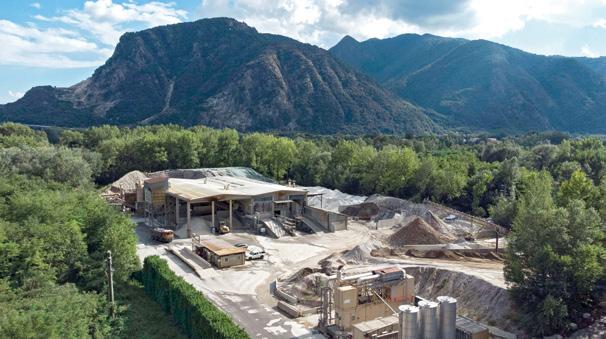
L’unità produttiva di Verbania è un baluardo dell’impegno di Minerali Industriali verso l’economia circolare. Qui, attraverso un processo di trattamento minerario che parte dagli “sfridi” della lavorazione di granito bianco Montorfano e rosa Baveno, il Gruppo produce da trent’anni il feldspato potassico-sodico F60-30, che rappresenta il primo esempio pionieristico di valorizzazione dei rifiuti estrattivi. Ottenuto dalla frantumazione, macinazione, essiccazione e separazione magnetica del granito del
104 CWR 154/2023
Factory in Verbania - Stabilimento di Verbania
Maggiore, it is an ideal feldspar for glazed tiles with light-coloured bodies due to the presence of alkalis with a low chromophore content.
Minerali Industriali’s activities also extend to Brusnengo in the eastern area of the province of Biella, where the Group’s wholly-owned subsidiary Sasil operates. Sasil is a leading player in the field of industrial waste recovery and specialises in the processing of glass scrap. It also has feldspathic sand quarries in the municipalities of Curino and Masserano (province of Biella) from which quartz and feldspar for the glass, ceramics and sanitaryware industries are obtained. Sasil produces Feldspar LC, an extremely pure potassium feldspar free of carbonates, sulphur and oxidisable substances, by carefully washing the feldspathic sands to reduce the chromophore content.
In addition to its longstanding operations of extracting, processing and selling domestic raw materials, Minerali Industriali has also invested over the years in geological and mining research outside Italy to identify the best raw materials available for ceramics, while at the same time starting a major trading business to offer
Lago Maggiore, si tratta di un feldspato ideale per piastrelle smaltate con supporti chiari grazie all’apporto di alcali a basso contenuto di cromofori.
L’attività di Minerali Industriali si estende anche nel Biellese Orientale, a Brusnengo, dove opera Sasil, società interamente controllata dal Gruppo. Sasil è una realtà all’avanguardia nel recupero degli scarti industriali ed è specializzata nella lavorazione di rottami di vetro; ha inoltre miniere di sabbie feldspatiche nei Comuni di Curino e Masserano (Biella) dalle quali vengono ottenuti quarzi e feldspati per l’industria del vetro, della ceramica
e dei sanitari. In Sasil viene prodotto il Feldspato LC, feldspato potassico estremamente puro e privo di carbonati, zolfo e sostanze ossidabili, attraverso un accurato lavaggio delle sabbie feldspatiche che riduce il contenuto di cromofori.
A fianco della storica attività di estrazione, trattamento e vendita di materie prime nazionali, Minerali Industriali ha investito, negli anni, in ricerca geologica e mineraria per individuare le migliori materie prime per ceramica disponibili all’estero, avviando al contempo un’importante attività di trading per offrire al mercato italiano una più ampia gamma di prodotti.
raw materials
105 CWR 154/2023
Feldspar F60-30 (Verbania)
Feldspar LC (Brusnengo, BI)
Feldspar B1001 (Turkey)
Rhyolite S1 (Boca, NO)
RIO-SF30 (Boca, NO)
Analysis / Analisi Chimica SiO2 77.1% 87.5% 66.3% 76.5% 74.8% Al2O3 13.0% 6.2% 19.5% 13.0% 13.7% Fe2O3 0.3% 0.3% 0.2% 0.9% 1.4% TiO2 0.02% 0.05% 0.35% 0.09% 0.13% CaO 1.1% 0.1% 0.5% 0.1% 0.52% MgO 0.1% 0.05% 0.1% 0.1% 0.13% Na2O 3.4% 0.2% 8.0% 0.5% 1.4% K2O 4.7% 4.9% 4.0% 7.0% 6.5% LoI / P.F. 0.3% 0.6% 0.7% 1.75% 1.5% Average grain size distribution Analisi granulometrica media 0-1.25 mm 0-3 mm 0-6 mm 0-6 mm 0-6 mm Moisture / Umidità 4% 8% 5% 7% 7% Average mineralogical analysis / Analisi mineralogica media Quartz / Quarzo 36% 66% 4% 50% 41% Sodium Feldspar / Feldspato sodico 34% 2% 70% - 11% Potassium Feldspar / Feldspato potassico 29% 29% 22% 30% 29% Kaolinite / Caolinite - - - 12% 9% Other / Altro 1% 3% 4% 8% 10%
Chemical
raw materials
the Italian market a wider range of products.
Following its investments in analysis laboratories in Turkey, for several years now the company has been importing high-quality sodium-potassium feldspars such as feldspar B1001, guaranteeing the high quality standards required for the finest Italian ceramic tile production.
Through its research efforts and investments in innovation, the company has cemented its position as a leading supplier of raw materials for the production of high-quality technical and glazed porcelain stoneware, while at the same time striving to reduce its environmental impact and improve the circularity of its production processes. ◼

Investendo in analisi e laboratori in Turchia, è stata avviata da alcuni anni un’attività di importazione di feldspato sodico-potassico di elevata qualità, come il feldspato B1001, garantendone gli standard qualitativi necessari alle più pregiate produzioni ceramiche italiane.
Grazie dunque alla ricerca e agli investimenti in innovazio-
ne, l’azienda si è consolidata come fornitore primario di materie prime per la produzione di grès porcellanato tecnico e smaltato di alta qualità, cercando al contempo di contribuire in maniera significativa, nella gestione dei propri processi, al contenimento degli impatti ambientali e alla circolarità delle proprie produzioni. ◼

MINERALI INDUSTRIALI ENGINEERING

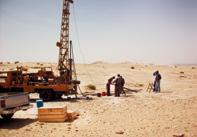















Customer care PHASE 7 Minerals Treatment Center PHASE 3 Industrial test PHASE 4 PHASE 6 Dedicated turn-key solutions PHASE 5 Layout definition & engineering PHASE 2 Laboratory test PHASE 1 Geological survey Dedicated turn key solutions for the treatment of raw materials & non-hazardous industrial waste & recovery solutions for waste materials Reject Recycle Reuse MINERALI INDUSTRIALI ENGINEERING IS A COMPANY OF THE GROUP MINERALI INDUSTRIALI
Rhyolite S1 deposit - Deposito di Riolite S1
RIO-SF30 and SF deposit - Deposito di RIO-SF30 e SF
ADVERTISING
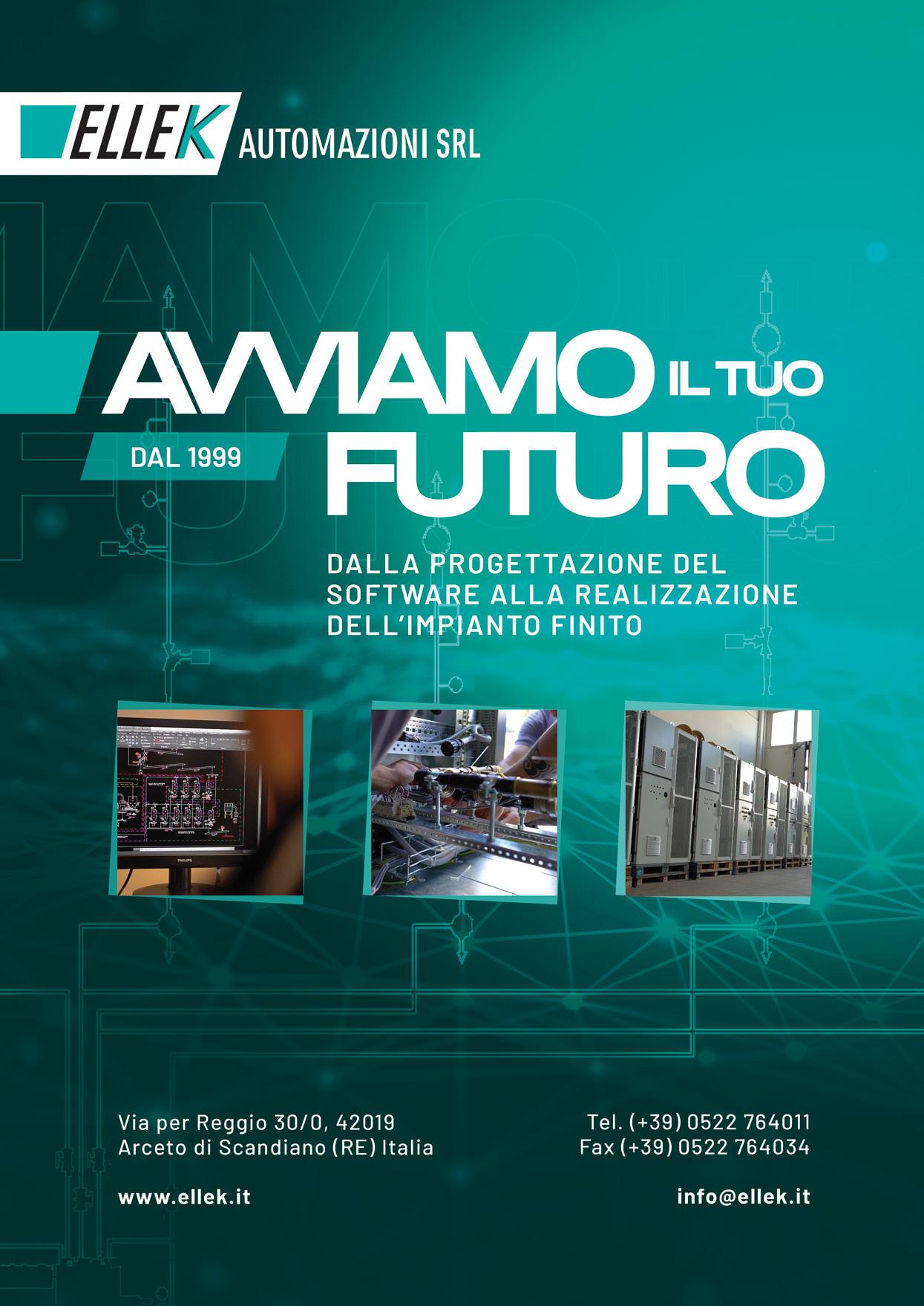
BBM IndustrIal MaIntenance

BBM Industrial Maintenance, a GMM Group member company and a leading provider of condition monitoring services for the ceramic industry, has long been conducting research into sophisticated new technologies capable of reducing production line maintenance costs and service times in the event of plant malfunctions. Continuous monitoring of the state of health of critical plants is a strategic tool for identifying and recording malfunctions at an early stage, avoiding the time wastage and cost associated with unplanned machine stoppages. To support the technological and digital transformation of production processes in the ceramic industry as part of the Industry 4.0 transition plan, BBM proposes the adoption of proprietary on-line Condition Monitoring systems, developed and produced within the group and designated Master BBM
Thanks to BBM’s extensive presence in the maintenance market and the reliability of the technology and solutions adopted, it offers companies advantages such as continuous monitoring of the state of health of mills used in the powder preparation process. The technical solution proposed by BBM also provides information on the plant’s condition in real time along with a detailed evaluation of bearing wear (even at very low operating speeds), the state of gears, the main mechanical faults (unbalance, misalignment, slackness, resonances, etc.) and electrical faults (inverter faults, stator and rotor asymmetry, defects on the bars and on the power supply). Alarm management is immediate and can be shared via smartphone, tablet or email.
Available solutions include the use of on-line condition monitoring systems in either the Easy version, which involves the use of control units that collect data via wi-fi sensors, or in the Advanced version, which adopts control units with 8 asynchronous channels and 6 additional channels. These are programmed to use wired sensors to monitor vibrations, temperature, speed, oil quality status and operating parameters of the mill’s entire drive train. The data obtained with both of the above solutions are easily accessible via the dedicated data management and display platform, which is always available to customers.
Thanks to the technical expertise of BBM’s experts, customers can access a periodic reporting system on the state of health of the plants, as well as receive technical support and consultancy services. This is essential to plan in advance the maintenance activities that need to be carried out in order to avoid plant downtimes and extend the service life of the mill’s mechanical systems. In addition, BBM’s rapid supply of reliable and technically high-quality components allows customers to avoid tying up cap-
ital in the purchase and storage of spare parts that are at risk of deteriorating or becoming obsolete. The GMM Group’s goal is to deliver increasingly integrated, high added-value solutions that perfectly match the needs of production departments, thereby maximising production and economic efficiency.
■■■
BBM Industrial Maintenance, azienda del Gruppo GMM e leader nella fornitura di servizi di Condition Monitoring per l’industria ceramica, è da sempre impegnata nella ricerca di nuove e sofisticate tecnologie volte alla diminuzione dei costi di manutenzione delle linee produttive e dei tempi di intervento in caso di malfunzionamento degli impianti. È in quest’ottica che il monitoraggio continuo dello stato di salute di impianti critici rappresenta uno strumento strategico in grado di identificare e registrare le anomalie già dallo stadio iniziale, prevenire fermo macchina non programmati e le conseguenti flessioni economiche. Per sostenere la trasformazione tecnologica e digitale dei processi produttivi nell’industria ceramica, in sinergia con il piano di transizione 4.0, BBM propone l’adozione di sistemi di Condition
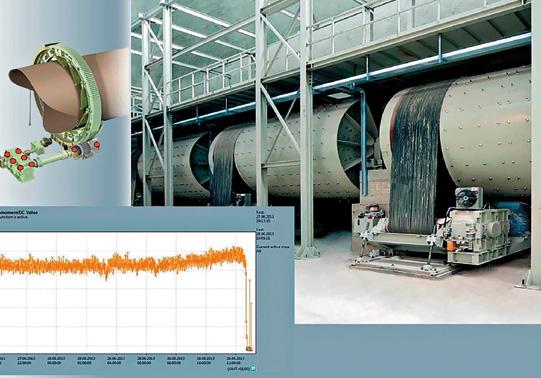
Monitoring on-line proprietari, sviluppati e prodotti a livello di gruppo e denominati “Master BBM”. Grazie alla capillare presenza sul mercato delle manutenzioni da parte di BBM e all’affidabilità della tecnologia e delle soluzioni utilizzate, sarà possibile beneficiare ad esempio di un monitoraggio continuo dello stato di salute dei mulini impiegati nel processo di preparazione delle polveri. La soluzione tecnica proposta da BBM fornisce altresì informazioni sulle condizioni dell’impianto in tempo reale e valuta in dettaglio l’usura sui cuscinetti (anche a bassissime velocità di funzionamento), lo stato dell’ingranamento, le principali anomalie meccaniche (sbilanciamento, disallineamento, allentamenti, risonanze, ecc.) ed elettriche (anomalie dell’inverter, asimmetria statorica e rotorica, difetti sulle barre e sull’ alimentazione). La gestione degli allarmi è immediata e condivisibile anche tramite smartphone o tablet, nonché via e-mail. Le soluzioni disponibili comprendono l’utilizzo di sistemi di condition monitoring on-line nella versione “Easy”, che prevede l’utilizzo di centraline che raccolgono i dati tramite di sensori wi-fi, o nella versione “Advanced”, che adotta centraline a 8 canali asincroni e 6 canali aggiuntivi, programmati per l’utilizzo di sensori cablati atti al monitoraggio delle vibrazioni, della temperatura, della velocità, dello stato di qualità dell’olio e dei parametri operativi della catena cinematica dell’intero mulino. I dati ottenuti con entrambe le soluzioni sopra indicate sono facilmente accessibili tramite la dedicata piattaforma di gestione e visualizzazione degli stessi, sempre disponibile per i clienti.
Grazie alla competenza tecnica degli esperti BBM, il cliente potrà usufruire di un sistema di reportistica
108 CWR 154/2023
periodico sullo stato di salute degli impianti, così come di un’assistenza tecnica e consulenziale fondamentale per definire con anticipo le attività manutentive da porre in essere al fine di evitare fermi

In recent years, technological progress has led to the development of ever larger tile and slab sizes. At the same time, growing environmental awareness is prompting ceramic manufacturers to make a concerted effort to improve their products without sacrificing their overall sustainability.
The current geopolitical situation in Ukraine has also had a significant impact on ceramic production. The clays most commonly used as plastic components in ceramic bodies have effectively become unavailable, forcing Italian ceramic producers to drastically reformulate their bodies, often using unfamiliar materials.
In this context, one of the most interesting classes of additives is that of temporary body binders These are a valuable means of improving the mechanical characteristics of ceramic bodies, thereby reducing waste, reducing the use of water and allowing for the production of thinner tiles. This represents a benefit in terms of production continuity, yields and sustainability of the process despite the radical changes involved.
The use of these products increases the modulus of rupture and flexibility of unfired tiles, thereby facilitating handling and reducing the risk of damage despite the multiple stresses experienced on the production line. Although present in small per-
impianti ed allungare la “vita utile” della meccanica del mulino.
Inoltre, la pronta fornitura da parte di BBM di componenti affidabili e di alta qualità tecnica permette al cliente lo smobilizzo di capita-
LATEST TECHNOLOGIES
raw materials
centages, body binders can have a considerable influence on the behaviour of tiles during firing. Their formulation must be tailored to the characteristics of each body, with particular attention to calibre, porosity and unfired and fired density, all of which determine the properties and appearance of the finished product.
When defining the ideal product, it is also essential to clearly identify the goals and take account of various aspects: the main objective (higher green and dried strength, plasticising action, body reformulation); the dosage method (addition during grinding, addition to the slips in the tank or in-vein prior to the spray dryer); the occurrence and management of any faults (black core, pinholes, degassing, etc.) and the impact on emissions (total organic carbon, sulphur content, etc.). For these reasons, despite offering the extensive Smaltoten range of body binders, Smaltochimica prefers to adopt a tailor-made approach to cater most effectively to each manufacturer’s individual requirements.
■■■
Negli ultimi anni il progresso tecnologico ha portato all’affermazione di formati di piastrelle e lastre sempre più grandi. Di pari passo, la crescente sensibilità ambientale si va codificando come valore irrinunciabile e impegna i produttori di ceramica in un percorso virtuoso teso
li impegnati nell’acquisto e detenzione di parti di ricambio con il rischio che questi si usurino o diventino obsoleti.
L’obiettivo del Gruppo Gmm è sempre più volto a garantire solunea produttiva.
al miglioramento del prodotto senza rinunciare alla sua sostenibilità globale.
Recentemente, inoltre, la particolare situazione geopolitica in Ucraina ha notevolmente complicato le produzioni ceramiche rendendo di fatto indisponibili le argille maggiormente impiegate come componente plastica degli impasti e costringendo i ceramisti italiani a drastiche riformulazioni, spesso impiegando materiali sconosciuti. In questo particolare contesto, una delle classi di additivi più interessanti si rivela essere quella dei tenacizzanti temporanei, che rappresentano un valido ausilio per migliorare le caratteristiche meccaniche del corpo ceramico riducendo gli sfridi, contenendo l’utilizzo di risorse idriche e diminuendo gli spessori dei pezzi. Ciò rappresenta un beneficio per la continuità produttiva, le rese, la sostenibilità del processo nonostante i radicali cambiamenti affrontati. L’utilizzo di questi prodotti aumenta il modulo di rottura e la flessibilità delle piastrelle in crudo facilitandone la movimentazione e favorendone l’integrità nonostante le molteplici sollecitazioni subite sulla li-
zioni integrate ad alto valore aggiunto che si coniughino perfettamente con le esigenze degli svariati reparti produttivi con una logica di massimizzazione dell’efficienza produttiva ed economica.
Pur inseriti in percentuali contenute, i tenacizzanti possono avere un impatto considerevole sul comportamento delle piastrelle in cottura; nella loro formulazione, che deve essere modellata sulle caratteristiche di ogni impasto, occorre prestare particolare attenzione a calibri, porosità, densità in crudo e in cotto che determinano proprietà ed aspetto del manufatto finale.
Nella definizione del prodotto ideale occorre inoltre identificare con chiarezza gli obiettivi tenendo conto di svariati aspetti quali: l’esigenza perseguita (incremento in verde, in essiccato, azione plastificante, riformulazione impasto); la modalità di dosaggio (aggiunta in macinazione, aggiunta alla barbottina in vasca o in vena prima dell’atomizzatore); l’insorgenza e la gestione di eventuali difettologie (cuore nero, spillature, degasazioni…) e l’impatto sulle emissioni (carbonio organico totale, contenuto in zolfo…). Per queste ragioni, pur disponendo dell’ampia gamma di tenacizzanti Smaltoten, Smaltochimica predilige un approccio taylor-made per soddisfare al meglio le richieste di ciascun produttore.

109 CWR 154/2023
sMaltochIMIca ON
certech

Based on years of research and consultation with technical, production and laboratory managers at ceramic companies, Certech has developed a unique wet grinding plant for raw materials This solution offers a number of improvements compared to other solutions on the market and features a number of technological innovations covered by Italian and international patents.
First of all, the plant ensures a higher production yield for the same capacity. The first module operates in the same way as a normal continuous mill, with the grinding charge level with the intake auger. The various modules are completely independent. A pre-screening system is inserted between the second and third modules for the purpose of removing hard, unground material with a high grain size from the second module and sending only material ready to be refined to the third refining module. The hard material is instead sent back to the entrance of the first module where it is ground by the larger grinding bodies. By having double diaphragms at both the entrance and exit, in the second and third modules it is possible to raise the level of the grinding media to 55% of the volume. This significantly increases the quantity of grinding media and consequently the number of points of contact, which in turn leads to an increase in production.
A further advantage of this system is the significant energy savings achieved during operation. In particular, it is possible
to reduce energy consumption in the second and third modules by raising the level of the grinding media and consequently the slip. This is achieved by means of a forced slip pumping system in the modules and a dedicated pipe at the mill exit. It has been technically proven that having the grinding media at 55% of the volume instead of 40% (as is the case in traditional continuous modular mills) helps to significantly reduce energy consumption.
The system also stands out for the absence of plant engineering constraints given that the Certech modular mills are uncoupled from each other thanks to the use of centrifugal pumps to feed the second and third modules. This makes it possible to create a totally different grinding plant layout compared to other solutions on the market, while maintaining the same levels of performance.
The mills can be installed either longitudinally or transversely while maintaining the same grinding characteristics, and in some cases Certech has installed a series of separate modular mills located in two different buildings.
Certech’s modular continuous mills are covered by a number of patents to protect their unique technological innovations.
■■■
Anni di ricerca e confronto con responsabili tecnici, di produzione e di laboratorio di aziende ceramiche hanno consentito a Certech di mettere a punto un impianto di macinazione ad umido di materie prime unico nel suo genere. Questa soluzione si differenzia infatti dalle altre tecnologie sul mercato per una serie di migliorie ottenute grazie ad una pluralità di innovazioni tecnologiche coperte da brevetti italiani ed internazionali.
Innanzitutto, l’impianto assicura una maggiore resa produttiva a parità di capacità. Il primo modulo lavora come ogni normale mulino continuo, con la carica macinante al livello della coclea di ingresso del materiale. I moduli sono completamente indipendenti l’uno dall’altro. Tra il secondo ed il terzo modulo è interposta una prevagliatura che ha lo scopo di togliere dal secondo modulo il materiale duro di granulometria elevata non macinato ed inviare al terzo modulo raffinatore solamente il materiale pronto da raffinare; il materiale duro viene invece rimandato all’ingresso del primo modulo dove sarà macinato dai corpi macinanti più grandi. Nel secondo e terzo modulo, avendo doppio diaframma sia in entrata che in uscita, è possibile alzare il livello dei corpi macinanti fino al 55% del volume, aumen-
tando notevolmente i Kg di carica macinante e di conseguenza i punti di contatto tra i corpi macinanti che provocano un aumento produttivo.
Un ulteriore vantaggio di questo impianto consiste nel notevole risparmio energetico durante la fase di lavoro. In particolare, è possibile ridurre il consumo energetico nel secondo e terzo modulo grazie all’innalzamento dei corpi macinanti e, di conseguenza, della barbottina; questo avviene attraverso un sistema di pompaggio forzato della barbottina stessa nei moduli e grazie ad una tubazione particolare in uscita al mulino.
È tecnicamente provato, infatti, che avere i corpi macinanti al 55% del volume, anziché 40% (come accade nei mulini modulari continui tradizionali), aiuta a diminuire notevolmente il consumo energetico.
L’impianto si distingue anche per l’assenza di vincoli impiantistici, dovuta al fatto che i mulini modulari Certech sono svincolati tra loro grazie all’utilizzo delle pompe centrifughe per l’alimentazione del secondo e terzo modulo. Questo permette di creare un layout dell’impianto di macinazione totalmente differente rispetto ad altre soluzioni sul mercato, pur mantenendo le medesime performance.

I mulini, infatti, possono essere installati longitudinalmente o trasversalmente mantenendo le stesse caratteristiche di macinazione e, in qualche caso, Certech ha installato una batteria di mulini modulari divisa tra due diversi fabbricati.
I mulini continui modulari Certech sono coperti da diversi brevetti per garantire le innovazioni tecnologiche che li distinguono.
raw materials LATEST TECHNOLOGIES ON
110 CWR 154/2023
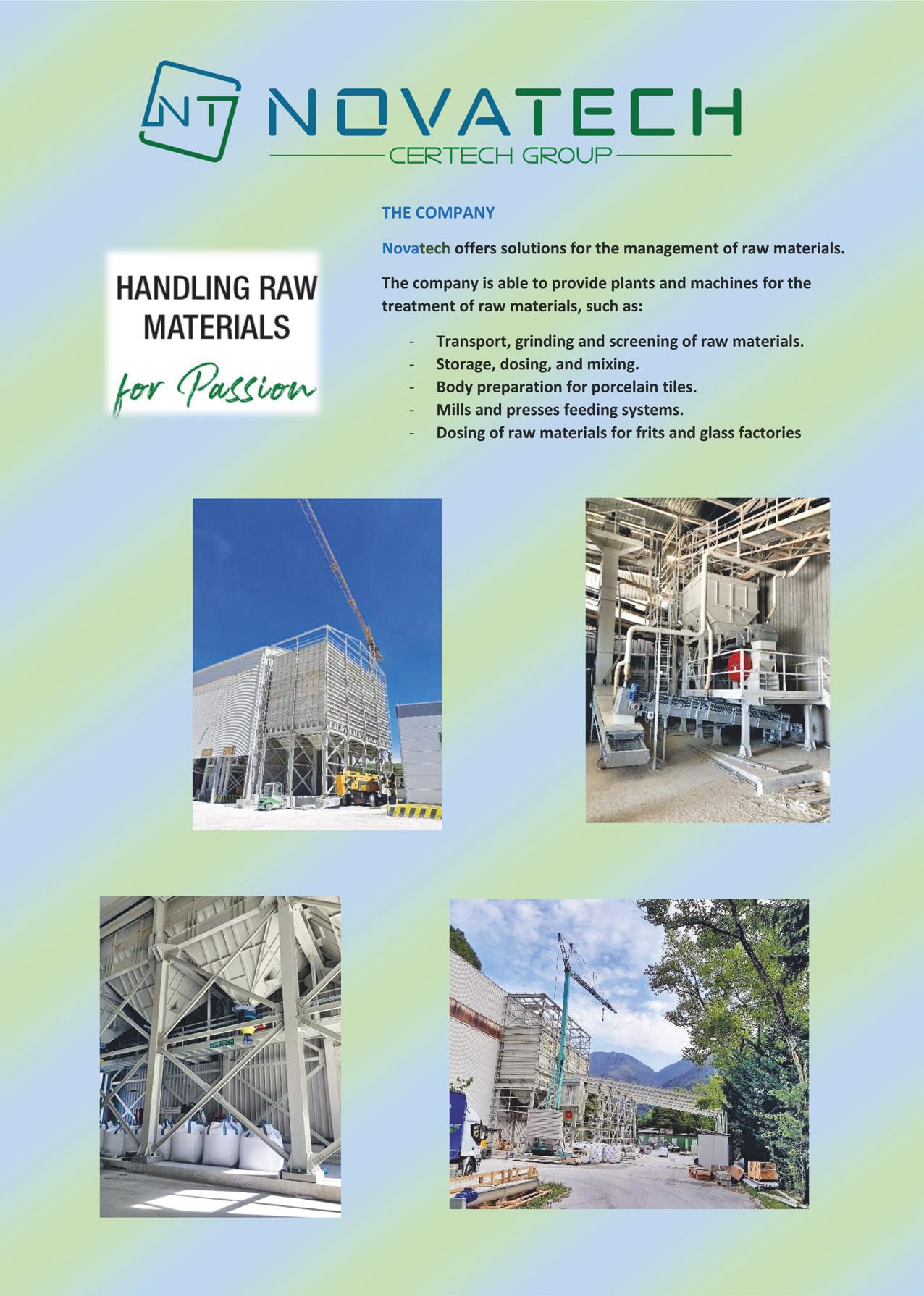
esan

Esan, a prominent producer of industrial minerals, supplies high-quality raw materials to ceramic manufacturers worldwide. In addition to feldspar, which is essential for the ceramic industry, the Turkish company has also been producing refined clay, quartz, bentonite, kaolin and halloysite for decades.
Esan has been highly committed to sustainability for years, and in every area of its operations strives to maintain a delicate equilibrium between people, the environment, society and the continuity of its business.
Feldspar is sourced from Esan’s proprietary quarries and provided in different forms, including crushed, floated and ground, and is tailored to meet the specific demands of the industry.
The feldspar is separated from impurities by means of a multi-stage flotation method. At the conclusion of this process, it is referred to as “Floated Feldspar” due to the reduced presence of contaminants, such as a lower content of Fe2O3 and TiO2
Table 1 shows the typical chemical analysis of the final products (NGG and GGA) formed at the end of the flotation process.
As shown in the chart, the mineralogical analysis conducted in Esan’s accredited laboratory on the product NGG revealed that the dominant phase is albite (approximately 85%), along with the presence of quartz phase.
Owing to the high alkali ratio, floated feldspars contribute to a reduction in sintering temperature by forming a liquid phase at high temperatures. These pure products also enable ceramic manufacturers to achieve optimal fusibility and increased whiteness. Table 2 shows the firing colour results (45 mins. at 1200°C).
The current annual produc-
tion capacity of floated feldspar products is 600,000 tons, generated from two different locations in the Milas region. Thanks to the company’s ongoing investments, these volumes are expected to reach 800,000 tons by the first quarter of 2024 and 1,000,000 tons by the first quarter of 2025.
■■■
Esan, tra i più noti produttori di minerali industriali, fornisce materie prime di alta qualità per la produzione di ceramica in tutto il mondo. Oltre alla produzione di feldspato, essenziale in questo comparto, l’azienda turca produce da decenni anche argilla raffinata, quarzo, bentonite, caolino e halloysite.
Fortemente impegnata da anni sul tema della sostenibilità, Esan opera lungo tutto il processo produttivo mantenendo un corretto equilibrio tra persone, ambiente, società e sviluppo dell’attività.
Il feldspato proviene dalle cave di proprietà di Esan e viene fornito in diverse forme (frantumato, macinato o flottato), su misura per soddisfare le esigenze specifiche del settore. Il feldspato viene separato dalle impurità attraverso un metodo di flottazione a più stadi. Al termine di questo processo, è definito “Feldspato Flottato” e
ha una ridotta presenza di contaminanti come Fe2O3 e TiO2. La tabella 1 riporta l’’analisi chimica tipica dei prodotti (NGG e GGA) alla fine del processo di flottazione. L’analisi mineralogica sul prodotto NGG, condotta nel laboratorio accreditato di Esan, ha determinato che la fase dominante è l’albite (circa l’85%), insieme alla presenza di fase quarzo, come mostrato nel grafico. Grazie all’elevato rapporto alcalino, questi feldspati contribuiscono a ridurre la temperatura di sinterizzazione formando una fase liquida ad alte
temperature. Questi prodotti puri consentono inoltre ai produttori di ceramica di ottenere una fusibilità ottimale e un maggiore grado di bianco. In tabella 2 si riportano i risultati del colore di cottura (a 1200 °C, 45 min).
L’attuale capacità produttiva di feldspato raggiunge le 600.000 tonnellate, prodotte in due diversi siti nella regione di Milas. Grazie ai costanti investimenti dell’azienda, tali volumi sono attesi crescere a 800.000 ton entro il primo trimestre del 2024 e a 1.000.000 ton entro il primo trimestre del 2025.
Spectrophotometer (Konica Minolta CM 3610D)
These values are given as guidance, based on typical lab product analysis; product supply to be made according to Esan’s technical data sheets.

raw materials LATEST TECHNOLOGIES ON
112 CWR 154/2023 Table 2 L a b NGG 87.68 -0.57 3.4 GGA 87.35 -0.65 4.42
1 - Oxide Analysis NGG GGA SiO2 68.14 69.84 Al2O3 19.79 18.86 Fe2O3 0.027 0.042 TiO2 0.029 0.045 CaO 1.09 0.71 MgO 0.05 0.06 Na2O 10.49 10.01 K2O 0.26 0.31 LOI 0.11 0.12
Table

Inco

In 2023 Inco has launched a number of new products designed to improve ceramic tile production, testifying to the longstanding Pavullo-based ceramic manufacturer’s commitment to innovation and sustainability.
One of these is the new ceramic structuring ink, which allows true digital structures to be obtained as a result of the precise, sharp and clean opening of the engobe applied subsequent to the ink. This new ink is subject to zero defects in both thin and thick applications. This digital application allows for perfect alignment with the subsequently printed design, allowing for unlimited aesthetic potential, extremely natural-looking results and unique and personalised decorative effects while using extremely small quantities of product.
Another major innovation from Inco is the new high-performance black ceramic ink for lapped ceramic surfaces. Its main characteristic is its ability to prevent the formation of micro-pinholes, thereby improving the technical and aesthetic quality of the ceramic surface and maintaining its beauty over time. This new black ceramic ink is formulated with a new black pigment and a new solvent phase from the low-emission High Solid series, which entirely eliminates the production
of micro-gases during firing and consequently avoids the formation of micro-pinholes. This results in a smooth and glossy ceramic surface that is aesthetically pleasing as well as highly durable and easy to clean.
Finally, Inco has launched a new range of pigments for engobe and vitrified engobe which stand out for their high colour intensity and bright tones. These new pigments reduce ink consumption, minimise printing problems and give a greater sense of depth and naturalness to the ceramic tile.
These innovations, together with the continuous improvements to the High-Solid Series inks, are the result of Inco’s constant investments in R&D. The company has always been committed to offering innovative yet sustainable products that meet the needs of the ceramic market and care for the environment.
■■■
Nel corso del 2023 Inco ha lanciato diverse novità studiate per migliorare le produzioni ceramiche e che testimoniano l’impegno dello storico colorificio ceramico di Pavullo verso l’innovazione e la sostenibilità.
Tra queste, il nuovo inchiostro ceramico strutturante, che permette di ottenere delle vere strutture digitali grazie all’apertura precisa, netta e pulita dell’engobbio applicato successivamente all’inchiostro stesso. Nessuna difettologia, sia per applicazioni sottili che per applicazioni ampie. Questa applicazione digitale permette un sincronismo perfetto con la grafica stampata successivamente e perciò infinite possibilità estetiche e realizzazioni estremamente naturali. Inoltre, consente di creare effetti decorativi unici e personalizzati con quantità estremamente contenute di prodotto.
Tra le più importanti novità proposte da Inco c’è anche il nuovo in-
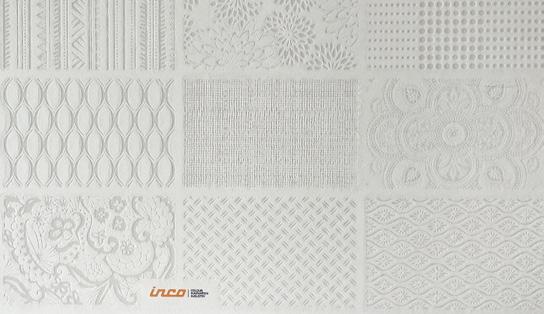

chiostro nero, estremamente performante, per superfici ceramiche lappate. La sua peculiarità consiste nella capacità di evitare il difetto della micro-spillatura, migliorando la qualità e l’aspetto estetico della superficie ceramica e mantenendone la bellezza nel tempo. Questo inchiostro ceramico nero è stato formulato con un nuovo pigmento nero ed una nuova fase solvente – della serie Alto Solido, a basse emissioni - che evitano completamente la formazione di micro-gas in fase di cottura e, di conseguenza, prevengono la formazione di micro-spillatura. La superficie ceramica risulterà così liscia e brillante, bella esteticamente ma anche più resistente e facile da pulire. Infine, la nuova gamma di pigmenti da engobbio e smaltobbio, che si caratterizza per l’elevata resa colorimetrica e i toni brillanti. Questi nuovi pigmenti consentono di ridurre il consumo di inchiostri, minimizzare le problematiche di stampa e conferire maggiore profondità e naturalezza al pezzo ceramico. Queste novità, assieme al continuo miglioramento degli inchiostri della serie Alto Solido, sono il risultato del costante investimento di Inco in R&S. L’azienda è infatti da sempre impegnata a offrire prodotti innovativi ma allo stesso tempo sostenibili, in linea con le esigenze del mercato ceramico e con le sfide ambientali del nostro tempo.

raw materials LATEST TECHNOLOGIES
ON
114 CWR 154/2023
ENEA green
Original Air-Oil cooler fo
ENEAgreen is the first cooling system for presses oil in ceramic industry t use the variable ventilation technology.







WIND OF CHANGE.
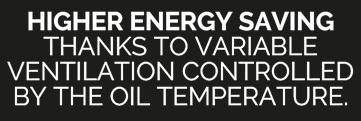









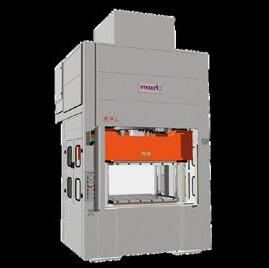

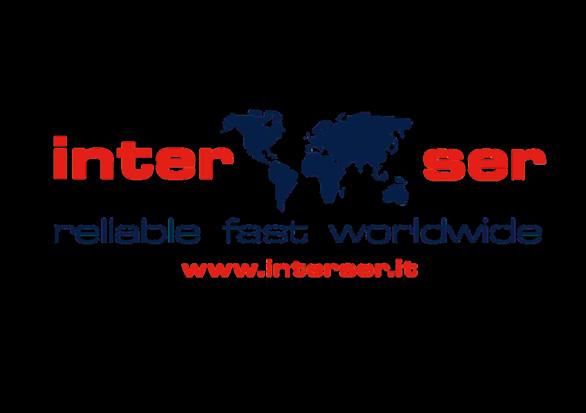



GMM Group

One of the key objectives of GMM Group, Global Industrial Partner for the ceramic industry, is to constantly search for technical solutions capable of ensuring maximum production efficiency while promoting responsible and sustainable use of resources. For this purpose, GMM partners with SKF (the world’s leading manufacturer of rolling elements, for which GMM has been an authorised dealer since 1981) to offer its customers an innovative reconditioning programme for large bearings, such as those used in raw material mills. The aim is to significantly reduce (by up to 90%) the carbon emissions associated with the resources and energy necessary to produce a new component, while guaranteeing 100% of the reconditioned component’s integrity and reliability.
Signing up to SKF’s certified reconditioning programme enables customers to reduce the total cost of ownership of their plant by reducing the cost of bearings. Most importantly, however, they benefit from the valuable information that the analysed bearings can provide on the machine’s condition. This information can suggest improvements that can be made to extend the machine’s service life, thereby triggering a virtuous cycle of improvement. Based on SKF’s experience, this approach is more cost-effective than the widely adopted “run-to-failure” maintenance policy.
SKF’s many years of experience and high level of expertise in the field of bearing reconditioning guarantee that reconditioned components will deliver the same levels of reliability and performance as new ones.
The procedure involves cleaning, degreasing and dismantling the bearings, followed by a thorough inspection. Based on the results of this inspection, a detailed bearing analysis report is drawn up. If the bearings are not irreparably damaged, they are restored to an efficient condition by means of procedures such as polishing, grinding and replacement of components. Any bearing with more than 30% calculated residual life is a perfect candidate for reconditioning, a process that brings substantial cost savings. SKF also uses an advanced system to uniquely mark each item during reconditioning, allowing for full traceability of the bearing throughout its future life cycle. Bearings can also be reconditioned to new or higher specifications provided directly by customers. These can include, for example, mounting sensors, adding integrated lubrication, coating, sealing or re-machining to different specifications.
■■■
GMM Group, Global Industrial Partner per il settore ceramico, ha fra i suoi obiettivi la costante ricerca di soluzioni tecniche che
possano garantire la massima efficienza produttiva, promuovendo al contempo un utilizzo delle risorse responsabile e sostenibile. In quest’ottica, in partnership con SKF, leader mondiale nella produzione di corpi volventi, di cui Gmm è concessionario autorizzato dal 1981, il gruppo propone ai propri clienti l’innovativo programma di ricondizionamento di cuscinetti di grandi dimensioni, come quelli utilizzati nei mulini di macinazione delle materie prime. L’obiettivo è abbattere significativamente le emissioni di carbonio (fino al 90%), generate dall’utilizzo di risorse ed energia necessarie per produrne uno nuovo, garantendo al 100% l’integrità e l’affidabilità del componente rigenerato. Aderire al programma di ricondizionamento certificato SKF consente al cliente di ridurre il costo totale di esercizio del proprio impianto riducendo il costo dei cuscinetti ma, soprattutto, sfruttando le preziose informazioni che i cuscinetti analizzati sono in grado di fornire sullo stato di funzionamento della macchina. Tali informazioni possono dare indicazione per miglioramenti che incidono sulla durata in esercizio della macchina innescando un ciclo
virtuoso di miglioramento. Una gestione che, in base alle esperienze maturate da SKF, si rivela competitiva rispetto alla diffusa politica manutentiva “run-to-failure”.
L’esperienza pluriennale maturata da SKF in ambito di ricondizionamento dei cuscinetti, così come le specifiche e rigorose attività eseguite, certificano l’affidabilità e garantiscono le performance dei componenti rigenerati, al pari di quelli nuovi.
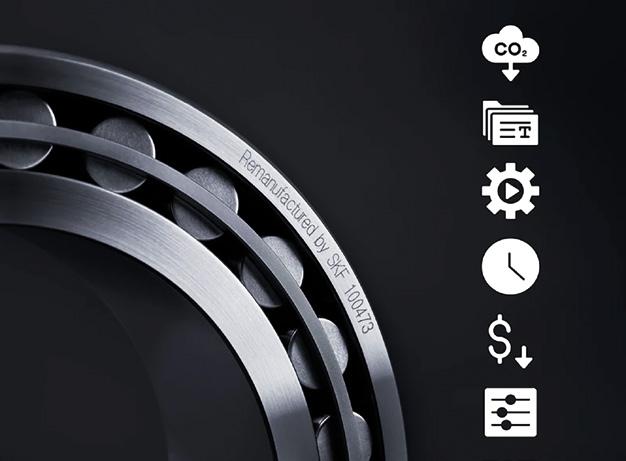
Le procedure prevedono la pulizia, lo sgrassaggio e lo smontaggio dei cuscinetti, per poi passare ad una completa ispezione degli stessi. In base ai risultati di detto controllo, viene preparato un report dettagliato sull’analisi dei cuscinetti. Se questi non presentano danneggiamenti irreparabili, vengono quindi riportati in condizioni di efficienza attraverso procedure adeguate, tra cui lucidatura, rettifica e sostituzione dei componenti. Qualsiasi cuscinetto con oltre il 30% di vita residua calcolata può rivelarsi un perfetto candidato per il ricondizionamento. Questo significa che i risparmi sui costi ottenibili attraverso il ricondizionamento sono sostanziali. SKF utilizza inoltre un sistema di gestione avanzato per contrassegnare ogni risorsa in modo univoco durante il ricondizionamento, consentendo la piena tracciabilità del cuscinetto durante il suo ciclo di vita futuro. Inoltre, è possibile eseguire ricondizionamenti dei cuscinetti anche secondo specifiche nuove o superiori direttamente fornite dai clienti. Queste possono includere, ad esempio, il montaggio di sensori, l’aggiunta di lubrificazione integrata, il rivestimento, soluzioni di tenuta o la rilavorazione in base a specifiche diverse.
raw materials LATEST TECHNOLOGIES ON
116 CWR 154/2023

GeoMIx

Geomix is an Italian company which processes and distributes raw materials for the glass, ceramic, sanitaryware and refractory materials industries. Based in the heart of the Sassuolo ceramic district, in just a few years it has established itself as a market leader thanks to the characteristics of its raw materials and its continuous efforts to develop new products and blends capable of meeting customers’ needs in step with the technological advances of the market.
The company represents historical German clay companies such as Goerg & Schneider, Maroton and Weiss and sells their products in the Italian market.
Added to these are a series of emerging European companies for which Geomix holds exclusive distribution rights for the Italian market, such as the Portuguese company Corbario with its wide range of clays and kaolins and the Turkish companies Erven and Errenk, which also produce a variety of plastic clay products that are essential for the production of ceramic bodies.
The Geomix product portfolio also includes high-quality French kaolins from SOKA, as well as a variety of other raw materials such as bentonites, Turkish feldspars and hydrated and calcined aluminas.
Along with this wide range of individual raw materials, Geomix can also blend different components to meet specific technical requirements of the ceramic industry and deliver the ideal solution in terms of technical characteristics and cost.
Geomix has a technological laboratory called GeomixLAB equipped with the latest instrumentation for technological analysis of raw materials and ceramic bodies and cutting-edge instruments and technologies for chemical analysis of any product.
Along with the search for new raw materials, GeomixLab performs constant checks on all marketed products, with regular inspections of materials arriving at port terminals, intermodal terminals or directly at the ceramic factories. At the same time the company guarantees a punctual, competent and personalised service for its customers.
The table shows the technical characteristics of some of the clay products marketed by Geomix, which have been on the market for several years and are sourced in the most important European mining areas.
Geomix è un’azienda italiana che opera nel settore della lavorazione e distribuzione di materie prime per l’industria della ceramica, dei sanitari e materiali refrattari. Con sede nel cuore del distretto ceramico sassolese, si è affermata in pochi anni come azienda leader per la peculiarità delle proprie materie prime e per l’orientamento continuo verso lo sviluppo di nuovi prodotti e miscele che possano soddisfare le continue esigenze dei clienti, sempre volte alla ricerca di nuove soluzioni per seguire le continue evoluzioni tecnologiche ed impiantistiche.
La società rappresenta e commercializza direttamente per il mercato italiano storiche aziende di argille tedesche come Goerg & Schneider, Maroton e Weiss
A queste si aggiungono nuove realtà emergenti europee, di cui Geomix detiene l’esclusiva per il mercato italiano, come la portoghese Corbario con la sua ampia gamma di ar-
gille e caolini, e le società turche Erven e Errenk, anch’esse con vari prodotti plastici argillosi assolutamente necessari alla produzione di impasti ceramici. Completano il pacchetto prodotti offerto da Geomix i pregiati caolini francesi SOKA, oltre a varie altre materie prime, come bentoniti, feldspati turchi e allumine idrate e calcinate.
Questa ampia varietà di materie prime per l’industria offre altresì la possibilità di miscelare tra loro diversi componenti, andando incontro alle diverse esigenze tecniche dell’industria ceramica, con l’obiettivo di fornire la soluzione tecnico-economica più ottimale. Geomix è dotata di un laboratorio tecnologico, il GeomixLAB, equipaggiato con i più moderni strumenti per la caratterizzazione tec-
nologica di materie prime e impasti ceramici, oltre a strumentazione e tecnologie all’avanguardia per analisi chimiche su qualsiasi prodotto. All’attività di ricerca di nuove materie prime, GeomixLab affianca il controllo costante su tutti i prodotti commercializzati, con verifiche regolari sui materiali in arrivo ai terminal portuali o agli scali intermodali e direttamente presso le aziende ceramiche. Tutto questo, garantendo un servizio puntuale, competente e personalizzato a supporto della clientela.
In tabella si riportano le caratteristiche tecniche di alcuni prodotti argillosi commercializzati da Geomix, già presenti sul mercato da diversi anni e provenienti dai più importanti bacini minerari europei.
raw materials LATEST TECHNOLOGIES ON
■■■
118 CWR 154/2023 Germany Germany Portugal Turkey France Clay AT-711 2313/B CR-2203 GE-50 CS-21 Chemical Analysis SiO2 63,00 64,00 61,70 63,00 69,50 Al2O3 21,00 23,50 24,00 22,50 21,00 Fe2O3 2,00 1,25 2,50 2,60 0,70 TiO2 2,10 1,30 0,60 1,10 0,30 CaO 0,70 0,20 0,30 0,40 0,15 MgO 0,80 0,30 0,30 0,60 0,20 Na2O 0,50 0,25 0,30 0,50 0,25 K2O 2,30 2,30 2,10 2,00 1,10 LOI 7,60 6,90 8,20 7,30 6,80 Mineralogical analysis Illite 18 16 12 22 10 Kaolinite 37 39 47 39 45 Quartz 34 42 37 36 0 Other minerals 11 3 4 3 45 Mechanical Characteristics Modulus of rupture (N/mm2) 9,1 6,5 6,2 8,0 4,5 Specific surface area (m2/g) 150 80 65 130 20 Shrinkage (%) 7,8 7,4 7,5 8,6 1,0 Water Absorption (%) 1,0 2,0 2,5 0,1 15,0 Firing colour L 61,0 76,4 67,0 60,5 90,0 a 4,2 2,7 8,0 1,6 0,5 b 25,7 10,3 17,0 17,2 4,5

Jld MInerals

Founded in 1973 in Bikaner (Rajasthan), in the heart of India’s ceramic industry, JLD Minerals (Jaichand Lal Daga Group) is a family-owned company with a strong focus on innovation and the pursuit of excellence.
Over a period of 50 years, it has grown into a mining industry giant. It operates more than 30 mining sites, possesses stateof-the-art facilities for the production of feldspar, quartz, silica sand and granite, and has a portfolio of more than 50 varieties of clays for a wide range of applications, including tiles, sanitaryware, tableware, refractories and bricks.
This diversification has not only strengthened the group’s position in the industry but has also made it a one-stop shop for ceramic manufacturers seeking a wide range of high-quality raw materials.
Behind JLD Minerals’ success lies a tale of relentless innovation. Its team of highly skilled technicians and a world-class laboratory spearhead the development of the company’s engineered clays portfolio. At the start of 2023, the company inaugurated a state-of-theart clay blending and processing plant. This facility is not only the largest in India but also one of the biggest in the world, testifying to the group’s relentless pursuit of technological progress. JLD Minerals’ impact extends far beyond its product offerings. The company has played a pivotal role in reducing India’s reliance on imported clay products, fostering stability and competitiveness within the domestic ceramic industry. This was much in evidence at the beginning of the war between Russia and Ukraine. JLD Minerals had successfully begun replacing Ukrainian clays
in its customers’ body formulations well before February 2022, as a result of which India’s clay imports from Ukraine had been reduced to almost zero even before the onset of the crisis. This enabled the Indian ceramic industry to continue operating as usual without being affected by the disruption of supplies.
JLD Minerals has also developed a similar high-grade clay portfolio for the sanitaryware and tableware industries. Today, JLD Minerals stands as a beacon of innovation, offering a range of customised and tailored products designed to meet its customers’ specific production challenges. JLD’s team of experts works closely with customers to understand their unique challenges and develop bespoke clay formulations that optimise production processes and improve product quality.
JLD Minerals currently exports to more than 25 countries worldwide, collaborating with leading industry players and helping them improve the quality and stability of raw materials.
■■■
Fondata nel 1973 a Bikaner (Rajasthan), nel cuore dell’industria ceramica indiana, JLD Minerals (Jaichand Lal Daga Group) è un’azienda a conduzione familiare fortemente orientata all’innovazione e alla ricerca dell’eccellenza. In 50 anni di attività, si è trasformata in un colosso del settore estrattivo in India: gestisce più di 30 siti minerari, dispone di impianti all’avanguardia per la produzione di feldspato, quarzo, sabbia silicea e granito, e vanta un portafoglio di oltre 50 varietà di argille per una vasta gamma di applicazioni, tra cui piastrelle, sanitari, stoviglie, refrattari e mattoni in laterizio. Questa diversificazione non solo ha rafforzato la posizione del gruppo nel settore, ma lo ha anche reso un punto di riferimento per i produttori di ceramica alla ricerca di un’ampia gamma di materie prime di alta qualità. Al centro del successo di JLD Minerals c’è una storia di innovazione incessante. La ricerca e lo sviluppo delle nuove argille è condotta da un team di tecnici qualificati e un laboratorio di altissimo livello. Inoltre, all’inizio del 2023
l’azienda ha inaugurato un impianto di miscelazione e lavorazione dell’argilla all’avanguardia. Questa struttura, non solo la più grande dell’India ma anche una delle più grandi al mondo, è una testimonianza della costante ricerca del gruppo verso il progresso tecnologico. L’impatto di JLD Minerals va ben oltre la sua offerta di prodotti. L’azienda ha infatti svolto un ruolo fondamentale nel ridurre la dipendenza dell’India dalle importazioni di argilla, promuovendo la stabilità e la competitività dell’industria ceramica nazionale. Un vantaggio che si è manifestato in tutta la sua portata con lo scoppio del conflitto tra Russia e Ucraina. JLD Minerals, infatti, aveva iniziato a sostituire con successo le argille ucraine nelle formulazioni di impasto dei suoi clienti ben prima del febbraio 2022, tanto che le importazioni indiane di argilla dall’Ucraina si erano ridotte quasi a zero prima ancora dell’inizio della crisi; questo ha consentito all’industria ceramica indiana di proseguire normalmente l’attività senza subire gli effetti dell’interruzione delle forniture. JLD Minerals ha sviluppato un’ampia gamma di argille di alta qualità anche per l’industria dei sanitari e della stoviglieria. Oggi, l’azienda si pone come un punto di riferimento in termini di innovazione, offrendo una gamma di prodotti personalizzati, progettati per affrontare le specifiche sfide produttive dei suoi clienti. Il team di esperti di JLD lavora a stretto contatto con i produttori per comprenderne le esigenze e sviluppare formulazioni su misura che ottimizzano i processi di produzione e migliorano la qualità del prodotto.
Attualmente, JLD Minerals esporta in oltre 25 paesi in tutto il mondo, collaborando con i maggiori player del settore e aiutandoli a migliorare la qualità e la stabilità delle materie prime.
raw materials LATEST TECHNOLOGIES ON
120 CWR 154/2023
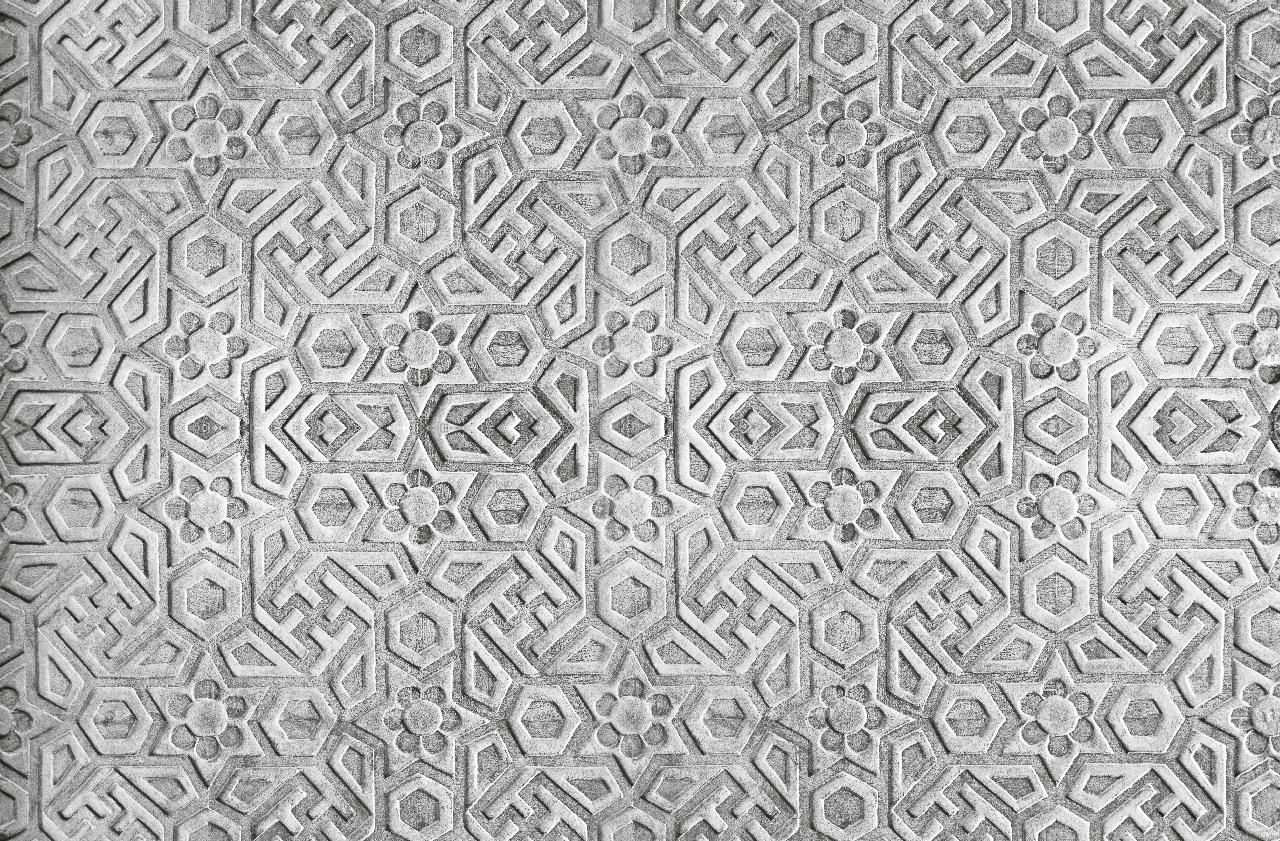




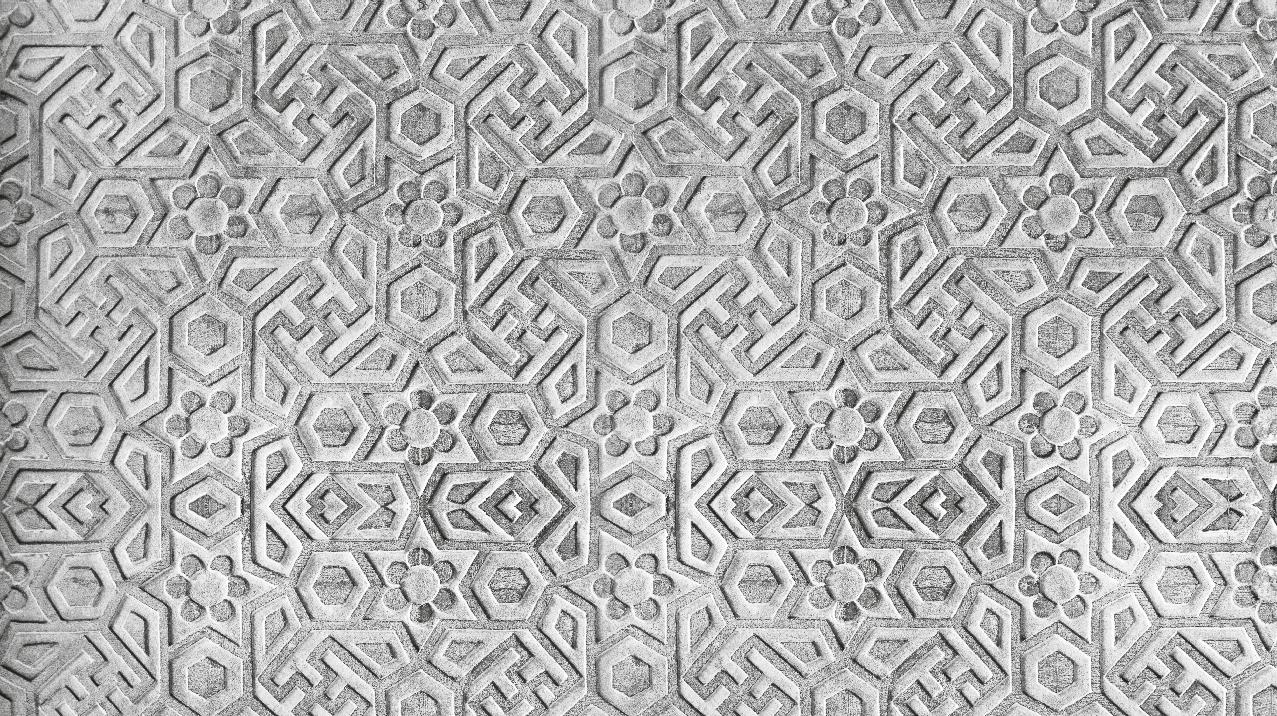

elettroMeccanIca MalaGutI

Raw materials preparation is one of the most important steps in the ceramic production process in terms of overall production efficiency and finished product quality. In this phase, the most critical processes are those associated with powder milling, an operation performed using powerful barrel mills which in turn are driven by power transmission systems that always include the presence of an electric motor and a large gearbox. As a global industrial partner specialising in the ceramic industry, the GMM Group is able to provide ceramic manufacturers with support and specific advice on the replacement and supply of spare parts such as bearings and mill motors, as well as the much appreciated service of regenerating and rebuilding large gearboxes
Within the Group, this service is provided by the subsidiary and SKF Certified Partner Elettromeccanica Malaguti with the support of the specialised technical know-how of the partner SKF, which through its Performance Engineering Centre is able to recondition mill gearboxes following a series of checks. After careful disassembly and cleaning, the first essential stage is inspection, which involves thorough structural analysis of internal parts by means of NDT (magnetoscopic and ultrasonic) testing, dimensional tolerance checks and Root Cause Failure Analysis, which provides information on the causes of failure. Once the feasibility of the repair has been determined, a detailed quote of the
cost of reconditioning is provided together with a technical report before proceeding to the final repair stage.
The main repair activities include replacing bearings with original SKF components capable of guaranteeing maximum operating reliability; non-destructive testing of shafts and gear teeth with potential regrinding or replacement of one or more wheels and re-engineering of those that cannot be supplied; and finally an optional step of repainting the inner and outer casing prior to the final no-load test. Thanks to the combined activities of the GMM Group and its technical partners, E. Malaguti is also able to perform an initial vibration check of the installed gearbox in order to certify its perfect service condition after repair.
This important activity is part of the GMM Group’s programme of sustainability-oriented services, in this case promoting the reuse of valuable industrial resources according to the principles of the circular economy.
■■■
Tra i processi produttivi ceramici, la fase dedicata alla preparazio-
ne delle materie prime ricopre un ruolo di primaria importanza sia per l’efficienza produttiva globale che per la qualità del prodotto finito.
In questa fase i processi più critici sono quelli legati alla macinazione delle polveri, realizzata tramite possenti mulini a botte, a loro volta azionati da imponenti sistemi di trasmissione della potenza che comprendono sempre la presenza di un motore elettrico e un riduttore di dimensioni importanti.
Come Global industrial partner specializzato nel settore ceramico, Gmm Group è in grado di supportare i produttori ceramici e fornire consulenze specifiche non solo per quanto concerne la sostituzione e la fornitura di parti di ricambio quali cuscinetti e motori da mulino, ma anche per l’apprezzato servizio di rigenerazione e ricostruzione di riduttori di grossa taglia Tale servizio all’interno del Gruppo è gestito dalla consociata Elettromeccanica Malaguti, SKF Certified Partner, coadiuvata dal know-how tecnico specializzato del partner SKF, che tramite il Performance Engineering Center, è in grado di effettuare la rigenerazione di riduttori da mulino a

seguito dell’espletamento di una serie di controlli. La prima fondamentale fase riguarda l’ispezione, che prevede accurate analisi di tipo strutturale dei particolari interni (da effettuarsi previo il loro corretto smontaggio e pulizia), quali controlli NDT (magnetoscopico e ultrasuoni), controlli dimensionali delle tolleranze, fino alla Root Cause Failure Analysis che fornisce informazioni circa le cause del guasto. Una volta eseguita con esito positivo l’analisi di fattibilità della riparazione, viene fornita una dettagliata offerta accompagnata da report tecnico per valutare l’investimento necessario per la rigenerazione, quindi si dà l’avvio all’ultima fase, ovvero la riparazione. Le principali attività di riparazione prevedono la sostituzione dei cuscinetti con componenti originali SKF in grado di garantire la massima affidabilità di esercizio, il controllo non distruttivo di alberi e dentature con eventuale ripassatura o sostituzione di una o più ruote e la possibilità di reingegnerizzazione di quelle non fornibili, ed infine la riverniciatura opzionale del corpo carcassa interno ed esterno che precede il collaudo a vuoto conclusivo. Grazie al lavoro sinergico del Gruppo Gmm e dei propri partner tecnici, E. Malaguti è inoltre in grado di eseguire un primo controllo vibrazionale del riduttore installato al fine di attestarne la perfetta condizione di servizio post riparazione.
Questa importante attività si inserisce in un piano di fornitura, da parte del Gruppo Gmm, di servizi orientati alla sostenibilità che promuovono in questo caso il riutilizzo di preziose risorse industriali secondo i dettami dell’economia circolare.
raw
LATEST TECHNOLOGIES ON
materials
122 CWR 154/2023

Secure your ticket now! ceramitec.com/tickets April 9–12, 2024 . Messe München ceramitec.com
CYBERSECURITY: ARE WE READY TO PROTECT OUR DATA?
CYBERSECURITY:
SIAMO PRONTI A DIFENDERE I DATI?
Matteo Marconi, A.C.&E. (Verona, Italy)
…. Network and information systems and electronic communications networks and services play a vital role in society and have become the backbone of economic growth. Information and communications technology (ICT) underpins the complex systems which support everyday societal activities, keep our economies running in key sectors such as health, energy, finance and transport, and, in particular, support the functioning of the internal market.
The use of network and information systems by citizens, organisations and businesses across the Union is now pervasive. Digitisation and connectivity are becoming core features in an ever growing number of products and services and with the advent of the Internet of Things (IoT) an extremely high number of connected digital devices are expected to be deployed across the Union during the next decade. While an increasing number of devices is connected to the internet, security and resilience are not sufficiently built in by design, leading to insufficient cybersecurity.
This is an excerpt from Regulation (EU) 2019/881 on ENISA, the European Union Agency for Cybersecurity, and Cybersecurity Certification for Information and Communications Technologies.
A NEW EU DIRECTIVE ON CYBERSECURITY OF MACHINERY AND INDUSTRIAL PROCESSES
The advent of IoT and Industry 4.0 has significantly enhanced the level of machine connectivity to the internet. But were these machines ready to be connected? Are the existing remote assistance systems and software suitable? These questions open up new scenarios regarding the critical issue of cybersecurity.
Information security has traditionally been managed at an IT level, involving servers, firewalls, VPNs, complex passwords and two-factor authentication: terminologies and procedures that have become commonplace in offices and in the worlds of infrastructure and finance.
However, machinery and industrial processes are already lagging behind. It is only now that Directive (EU) 2022/2555 (NIS2), due to come into force by 17 October 2024 and aimed at increasing the level of cybersecurity within the Union, has broadened its scope to machinery manufacturers while introducing the new multi-risk requirement that extends to the ser-
…. Le reti e i sistemi informativi e le reti e i servizi di comunicazione elettronica svolgono un ruolo essenziale nella società e sono diventati i pilastri della crescita economica. Le tecnologie dell’informazione e della comunicazione (TIC) sono alla base dei sistemi complessi su cui poggiano le attività quotidiane della società, fanno funzionare le nostre economie in settori essenziali quali la sanità, l’energia, la finanza e i trasporti e, in particolare, contribuiscono al funzionamento del mercato interno.
L’uso delle reti e dei sistemi informativi da parte di cittadini, organizzazioni e imprese di tutta l’Unione è attualmente molto diffuso. La digitalizzazione e la connettività stanno diventando caratteristiche fondamentali di un numero di prodotti e servizi in costante aumento, e con l’avvento dell’Internet degli oggetti (Internet of Things — IoT) nel prossimo decennio dovrebbero essere disponibile in tutta l’Unione un numero estremamente elevato di dispositivi digitali connessi. Sebbene un numero crescente di dispositivi sia connesso a Internet, la sicurezza e la resilienza non sono sufficientemente integrate nella progettazione, il che rende inadeguata la cibersicurezza….
Tratto dal regolamento (UE) 2019/881 relativo all’ENISA, l’Agenzia dell’Unione europea per la cybersicurezza, e al-
la certificazione della cybersicurezza per le tecnologie dell’informazione e della comunicazione.
MACCHINE E PROCESSI INDUSTRIALI: INTERVIENE UNA DIRETTIVA UE
IoT e Industry 4.0 hanno dato una spinta decisiva ai fini della connessione delle macchine ad Internet. Ma le macchine erano pronte ad essere connesse alla rete? I sistemi e i software di assistenza remota in uso sono idonei? Le domande aprono ad un nuovo scenario sul delicato tema della cybersicurezza.
La sicurezza informatica è sempre stata gestita a livello IT, quindi con server, gestionali firewall, VPN, password complesse e autentificazione a due fattori: termini e procedure diventati di uso comune negli uffici, nella sfera infrastrutturale e finanziaria. Per quanto riguarda le macchine e i processi industriali, invece, siamo già in ritardo. Solo ora la Direttiva (UE) 2022/2555 (la NIS2), prevista in vigore entro il 17 Ottobre 2024 e orientata a implementare il livello di cybersicurezza nell’Unione, ha allagato il campo di applicazione ai fabbricanti di macchinari e inserisce il nuovo requisito di multirischio che coinvolge anche i fornitori di servizi collegati ai costruttori. Si tratta quindi di individuare quali caratteristiche devono rispettare gli impianti e le macchine industriali per garantire un livello adeguato di cybersicurezza e qual è il grado di obbligatorietà.
124 CWR 154/2023
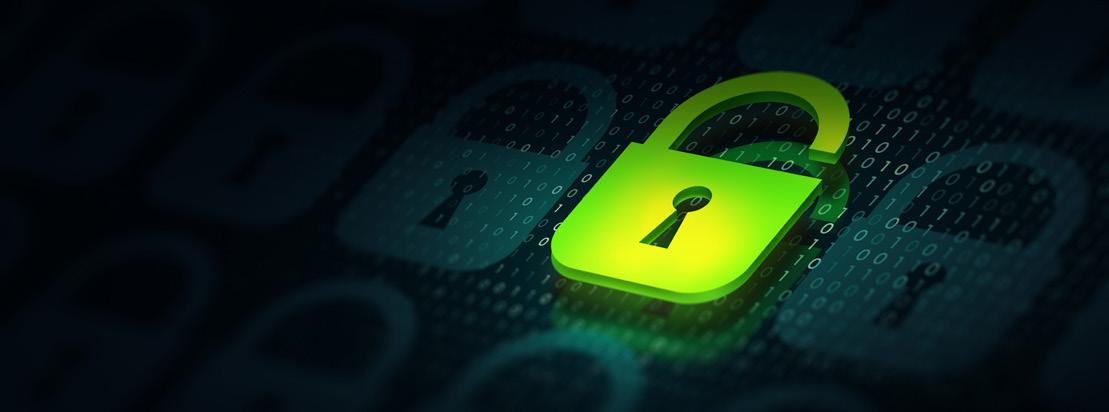
vice providers connected to the manufacturers’ networks. It is therefore crucial to identify the characteristics that industrial plant and machinery must adhere to in order to ensure an adequate level of cybersecurity and ascertain the degree of mandatory compliance.
SECURE AUTHORISATION MANAGEMENT
Cybersecurity or ICT (Information and Communications Technology) security is not explicitly addressed by the Machinery Directive 2006/42/EC as it involves the issue of “security” rather than that of “safety”. Nonetheless, there is a degree of overlap, as in the standards ISO 13849-1, EN 415-10, ISO 61511 and ISO 10218-1, which essentially emphasise two key principles:
1) the remote connection must be authorised locally (using a key selector, password, code or some other identification and authorisation system);
2) it must not be possible to modify safety parameters remotely without local authorisation.
So to protect our machinery from potential external threats, we must take action regarding both safety and security.
When a machine is connected to the corporate network, it is essential to ask the following questions: Who is able to access my network? Are they authorised or not? When and how do they access my network? And what resources do they have access to?
These considerations highlight the need to control crucial services like teleassistance and remote machine connections as they can provide gateways to corporate networks. Machines are normally connected to the corporate network via unmanaged routers or switches, without rules or filters, or via remote assistance software, which in the absence of clearly defined rules allows machine suppliers to connect whenever necessary. If access is not adequately restricted or protected, this inadvertently allows entry to even relatively inexperienced hackers, granting access to sensitive data on production lines.
THE FLOURISHING CYBERCRIME MARKET
Unlike traditional ransomware, corporate cybercrimes specifically involve encrypting data and then demanding a ransom. This may include theft of PLC or CNC programs, machine “recipes”, or even worse, sabotage of the production process. According to a 2022 study by the European Union Agency for
GESTIRE LE AUTORIZZAZIONI IN MODO SICURO
La cybersicurezza o “ICT security” (Information and Communication Technology) non è un aspetto trattato dalla Direttiva Macchine 2006/42/CE in quanto principio di “security” e non di Safety.
Tuttavia, ci sono delle commistioni come nelle norme ISO 13849-1, EN 415-10, ISO 61511, ISO10218-1, che riportano di fatto due principi cardine:
1) la connessione da remoto deve essere autorizzata da locale (con un selettore a chiave, una password, un codice o altro sistema di identificazione e autorizzazione);
2) non deve essere possibile modificare da remoto i parametri di safety senza che questi siano validati in locale. Se ne deduce che i nostri impianti sono più sicuri e, di conseguenza, è necessario iniziare ad agire in un’ottica di safety e security per proteggere le nostre macchine da possibili minacce esterne.
Quando una macchina è collegata in rete è opportuno chiedersi: Chi può accedere alla mia rete? È autorizzato oppure no? Quando e come accede alla mia rete? E a quali risorse?
Da questi assunti risulta evidente la necessità di governare alcuni servizi importanti come la teleassistenza e la connessione remota delle macchine, che rappresentano delle vere e proprie autostrade di accesso alle reti aziendali. Le macchine sono di norma collegate alla rete aziendale attraverso router o switch non gestiti, senza regole o filtri, o con software di teleassistenza che permettono al fornitore della macchina di collegarsi, in mancanza di regole definite, ogni qualvolta serva. Di fatto, così facendo, si permette anche l’ingresso, se non adeguatamente limitato o circoscritto, anche a hacker poco esperti che possono così accedere ai dati sensibili delle linee di produzione.
IL FIORENTE MERCATO DEL CYBERCRIMINE
Rispetto al classico ransomware, i cybercrimini aziendali hanno lo scopo specifico di crittografare i dati per poi chiederne il riscatto. Si pensi ai vari furti dei programmi PLC e CNC, delle “ricette” in macchina o, ancor peggio, al sabotaggio della produzione stessa.
Come riportato da una ricerca effettuata nel 2022 dall’Agenzia dell’Unione Europea per la cybersicurezza (ENISA), tra le prime dieci minacce si classificano gli attacchi alla catena di approvvigionamento che
topics
125 CWR 154/2023
Cybersecurity (ENISA), one of the top ten threats consists of supply chain attacks targeting the relationship between companies and suppliers. Organisations are becoming more vulnerable due to the adoption of increasingly complex systems and a supply chain that is difficult to control.
So while we are clearly facing new forms of corporate cybercrime, this exponential increase in cyber-attacks must also be tackled from an industrial perspective, focusing not just on IT but also on the OT (operational technology) sector.
IT AND OT OPERATORS AND TECHNICIANS MUST COLLABORATE
Some 94% of attacks on IT systems (the office world) have also caused disruptions in OT systems (the industrial world), leading to production stoppages and consequently halting entire production lines. Unauthorised access from the OT network to which all machines are now interconnected may result in infiltration of the IT network. This issue is a subject of extensive discussion, particularly concerning the new requirements of the Machinery Regulation (EU) 2023/1230 (Directive NIS2), within the IEC 62443 family of standards.
DATA PROTECTION TOOLS
To protect their data, companies require analysis and control tools and technical solutions to regulate access and fully reap the benefits of Industry 4.0. An important guideline for machine protection is contained in the standard IEC TS 63074 Safety of machinery - Security aspects related to functional safety of safety-related control systems, which introduces the concept of Risk Security Analysis and cites the IEC 62443 family of standards, especially IEC 62443-2-1 and IEC 62443-3-2. The regulatory framework is now ready in preparation for the Machinery Regulation (EU) 2023/1230, due to come into effect on 20 January 2027, which with the new RES 1.1.9 “Protection against corruption”, introduces the essential requirement for cybersecurity and a new principle of legitimate or illegitimate intervention on the machine.
In the United States, with the NEC 2023 for industrial machinery which came into effect last January, the requirement is already mandatory in 12 states, setting a concrete precedent. Likewise, Europe is poised to implement this requirement by way of NIS 2 in 2024 and the Machinery Regulation (EU) 2023/1230 in 2027, requiring specific cybersecurity action on machines, plants and service providers as early as the coming months. Below is an excerpt from the NEC 2023 document, where the fundamental requirement is compliance with the ANSI/ISA 62443 family of standards. ◼
prendono di mira la relazione tra aziende e fornitori. Le organizzazioni, infatti, stanno diventando più vulnerabili a causa di sistemi sempre più complessi e di una catena di fornitori piuttosto difficile da controllare.
È ormai palese che ci si trova di fronte a nuove forme di attacco alle aziende, tuttavia, dobbiamo interpretare questo incremento esponenziale degli attacchi informatici anche sotto un’altra prospettiva: quella industriale, che coinvolge non solo il settore IT, ma anche quello OT.
GLI OPERATORI E I TECNICI IT E OT DEVONO COLLABORARE
Il 94% degli attacchi a sistemi IT (mondo office) ha causato anche blocchi nei sistemi OT (mondo industriale), provocando interruzioni di produzione e di conseguenza l’arresto di intere linee. Un accesso non autorizzato dalla rete OT delle macchine, ormai tutte interconnesse, può infatti portare a un’invasione del mondo IT.
Il tema è oggetto di ampie discussioni, in particolare con i nuovi requisiti del Regolamento Macchine (UE) 2023/1230 (Direttiva NIS2), all’interno nelle norme della famiglia IEC 62443.
GLI STRUMENTI A DIFESA DEI DATI
Per difendere i propri dati, le imprese hanno dunque bisogno di strumenti di analisi, di controllo e di soluzioni tecni-
che per regolamentare gli accessi e mantenere appieno tutti i benefici dell’Industry 4.0. Un’importante linea guida per la protezione delle macchine è contenuta nella norma IEC
TS 63074 Safety of machinery - Security aspects related to functional safety of safety related control systems, che introduce il concetto di Securty Analisi Dei Rischi e cita come riferimento le norme della famiglia IEC 62443, in particolare la IEC 62443-2-1 e la IEC 62443-3-2.
Il palinsesto normativo è ormai pronto e precursore del Regolamento Macchine (UE) 2023/1230 in vigore a partire dal 20 gennaio 2027 che, con il nuovo RES 1.1.9 “Protezione dall’alterazione”, introduce il requisito essenziale per la cybersicurezza e un nuovo principio di intervento legittimo o illegittimo sulla macchina.
Negli USA con il NEC 2023 inerente alle macchine industriali, entrato in vigore lo scorso gennaio, il requisito è di fatto già mandatorio in 12 stati. Si tratta di una realtà concreta che ha anticipato i tempi. Anche l’Europa, infatti, vedrà concretizzato questo regolamento con la NIS 2 nel 2024 e nel 2027 con il regolamento macchine (EU) 2023/1230, rendendo necessarie delle attività specifiche sulle macchine, impianti e fornitori di servizi, in termini di cybersicurezza, già dai prossimi mesi.
Si riporta di seguito un estratto del documento NEC 2023, dove il requisito fondamentale è la conformità alle famiglie delle norme ANSI/ ISA 62443. ◼
Informational Note No. 3: See the ANSI/ISA 62443 series of standards for industrial automation and control systems, the UL 2900 series of standards for software cybersecurity for network-connectable products, and UL 5500, Standard for Remote Software Updates, which are standards that provide frameworks to mitigate current and future security cybersecurity vulnerabilities and address software integrity in systems of electrical equipment.
126 CWR 154/2023 technology
(8) Cybersecurity for network-connected life safety equipment to address its ability to withstand unauthorized updates and malicious attacks while continuing to perform its intended safety functionality.











EPBA GENERAL MANAGEMENT NELLA FILIERA DEI BENI STRUMENTALI Executive Program IN COLLABORAZIONE CON IN PARTNERSHIP CON 2024 MANAGEMENT ACADEMY SBS+ MANAGEMENT ACADEMY Via Fossa Buracchione, 84 41126 Baggiovara (MO) T. 39 059 472 6320 formazione@scuolabenistrumentali.it www.scuolabenistrumentali.it
WORLD OF FINISHES
YOUR FINISHES DESIGNER
IDEAS OVER TOOLS
a revolutionary system, an unexplored path where technology and leading design take concrete form in tailor-made finishing solutions.





WWW.SURFACES-GROUP.IT




INTO
THE FUTURE
Data flows, technology remains
www.bmr.it

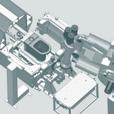

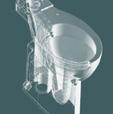



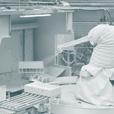
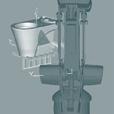


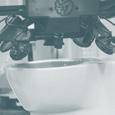
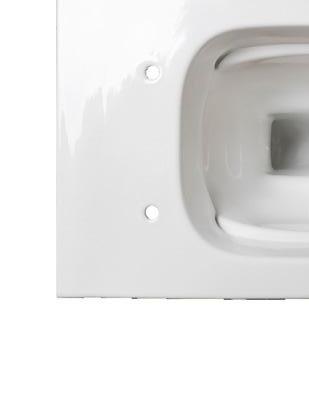



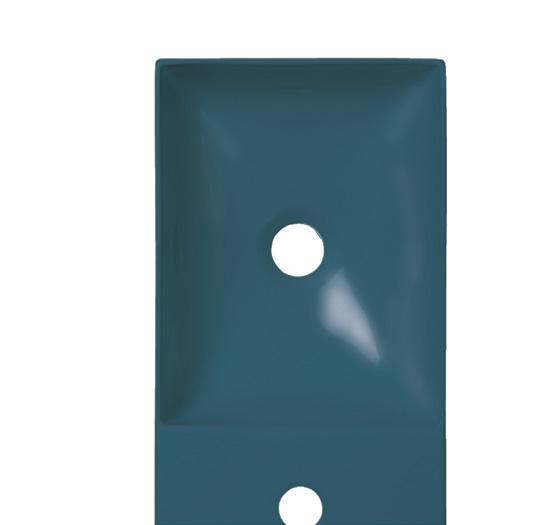



ENDLESS INNOVATION SINCE 1919
Firing Technology
Sorting
Sanitaryware [ AUTOMATION ] [ RESEARCH ] momic
.
.
We A R E









































































































































 by STEPHAN SCHMIDT
by STEPHAN SCHMIDT






















 rivare ad Hypermate, il software di
rivare ad Hypermate, il software di






















































































































































































 Talking to...
Erdem Cenesiz
Talking to...
Erdem Cenesiz
























































































































